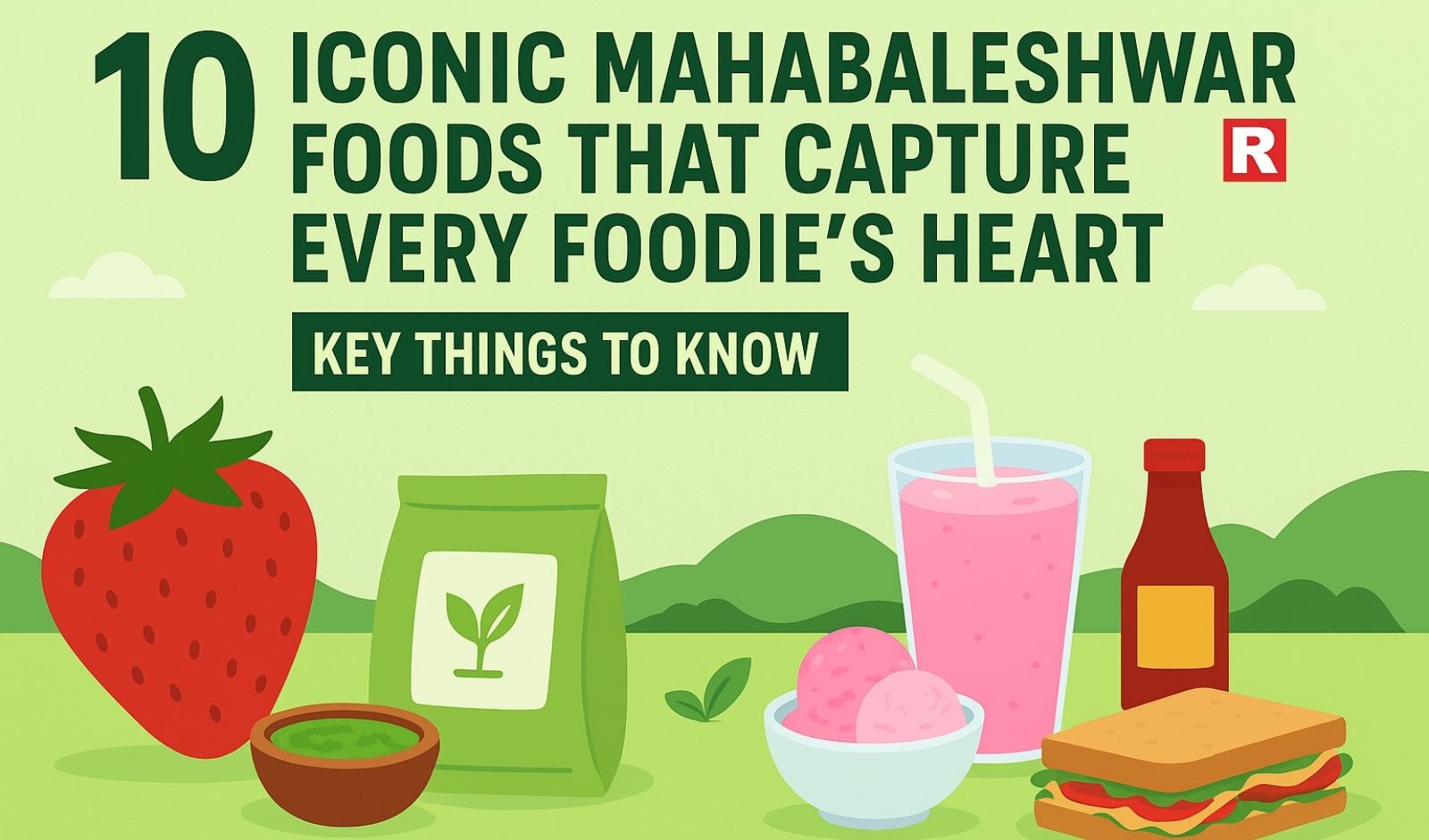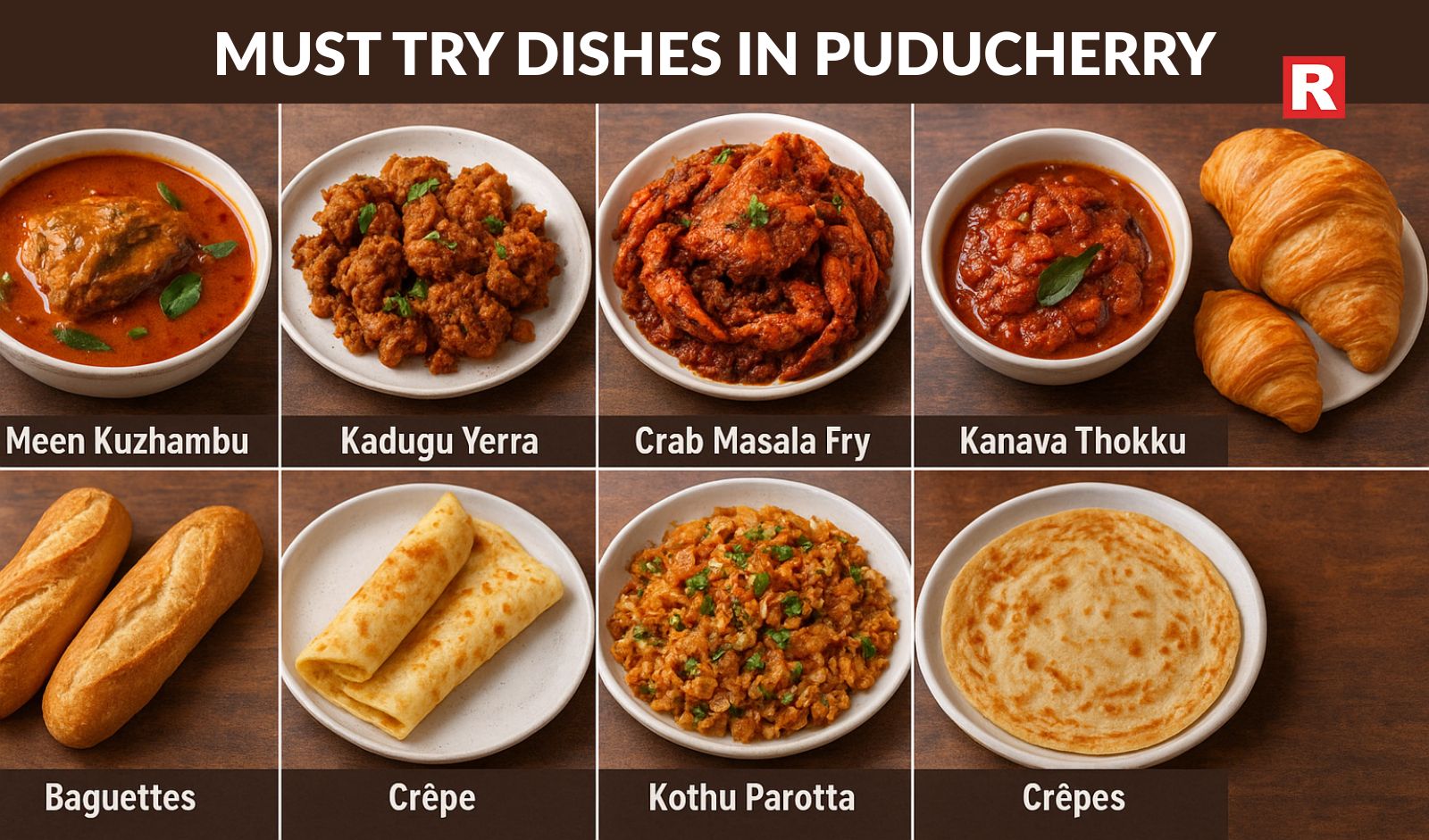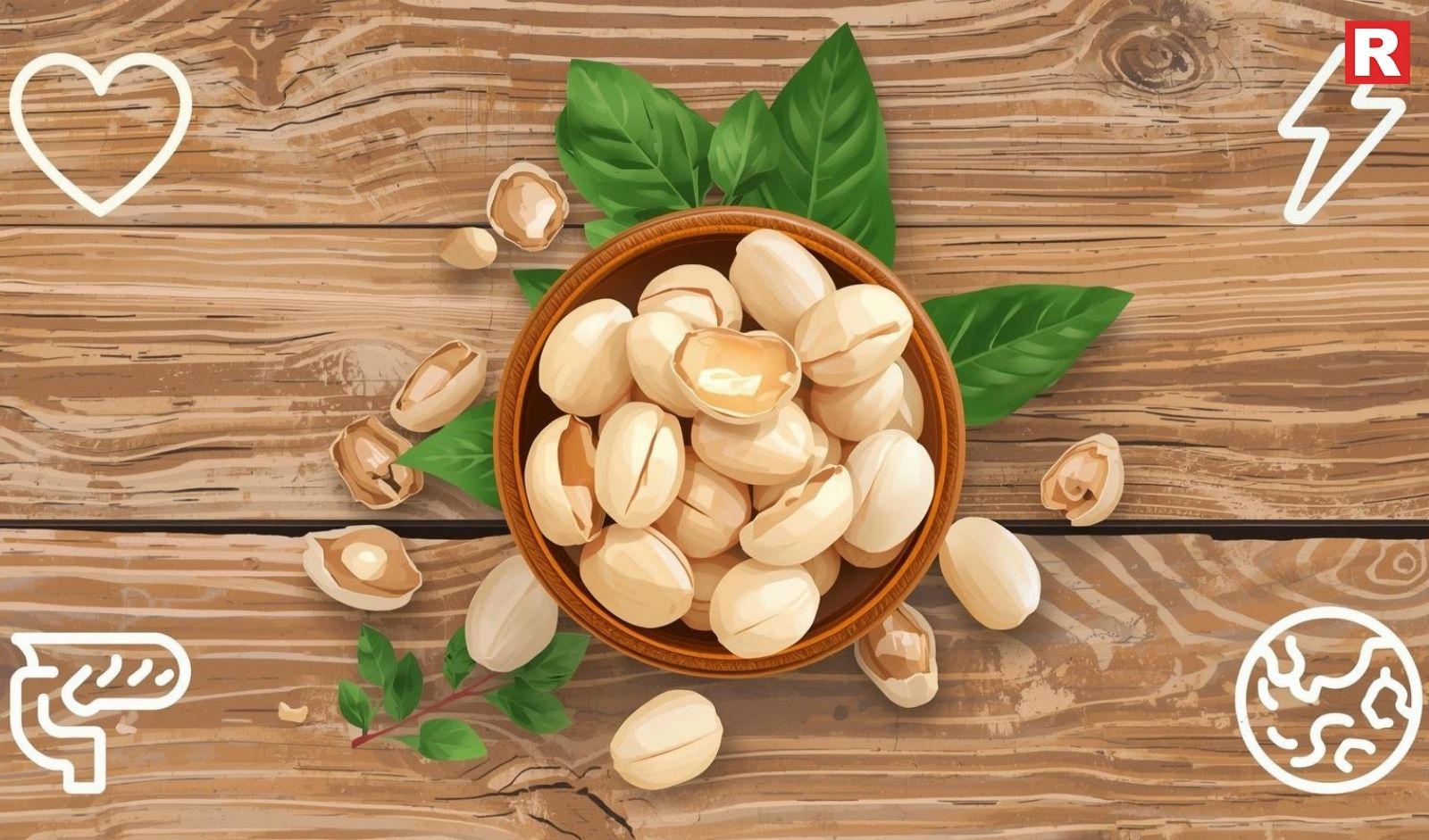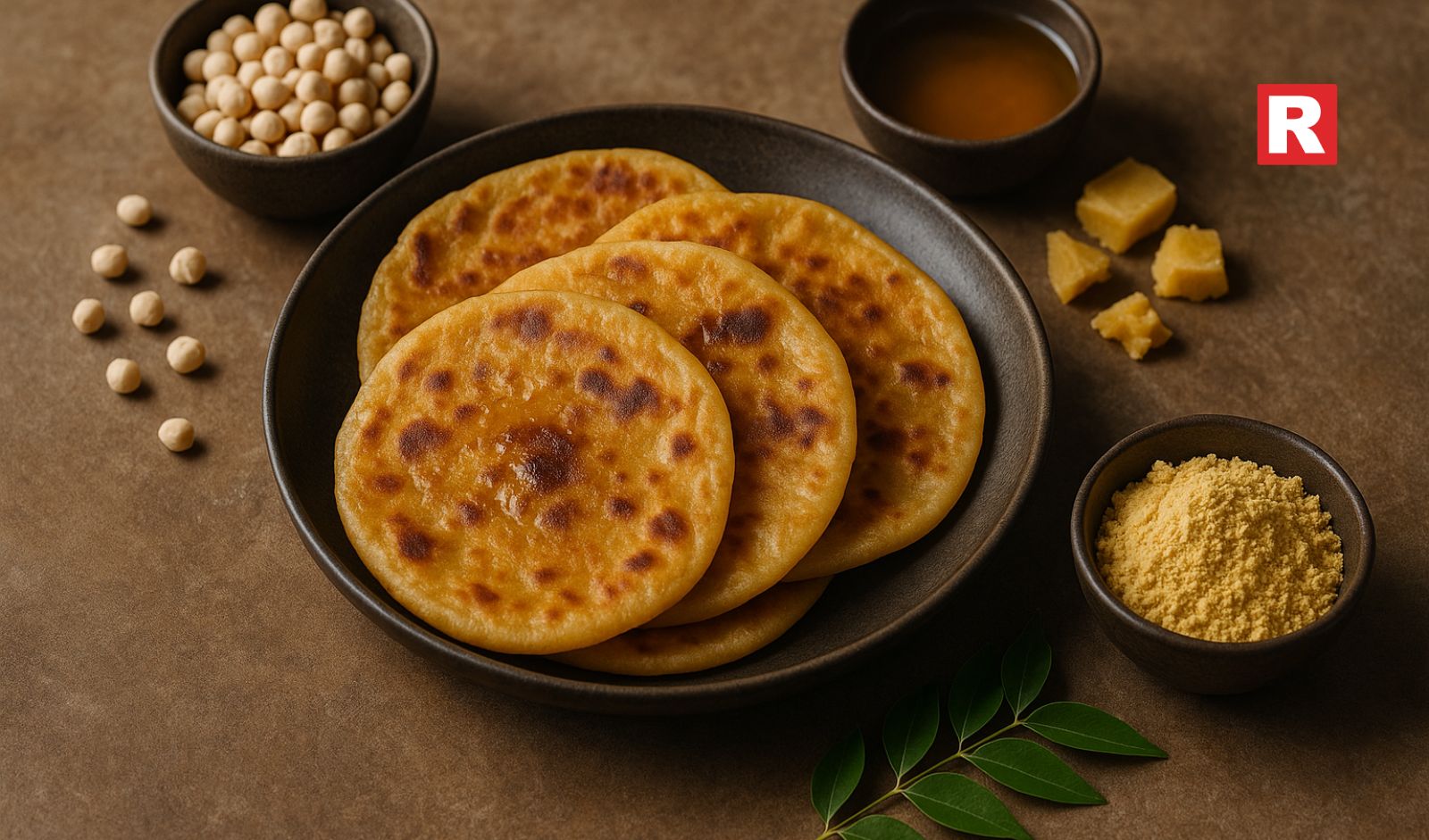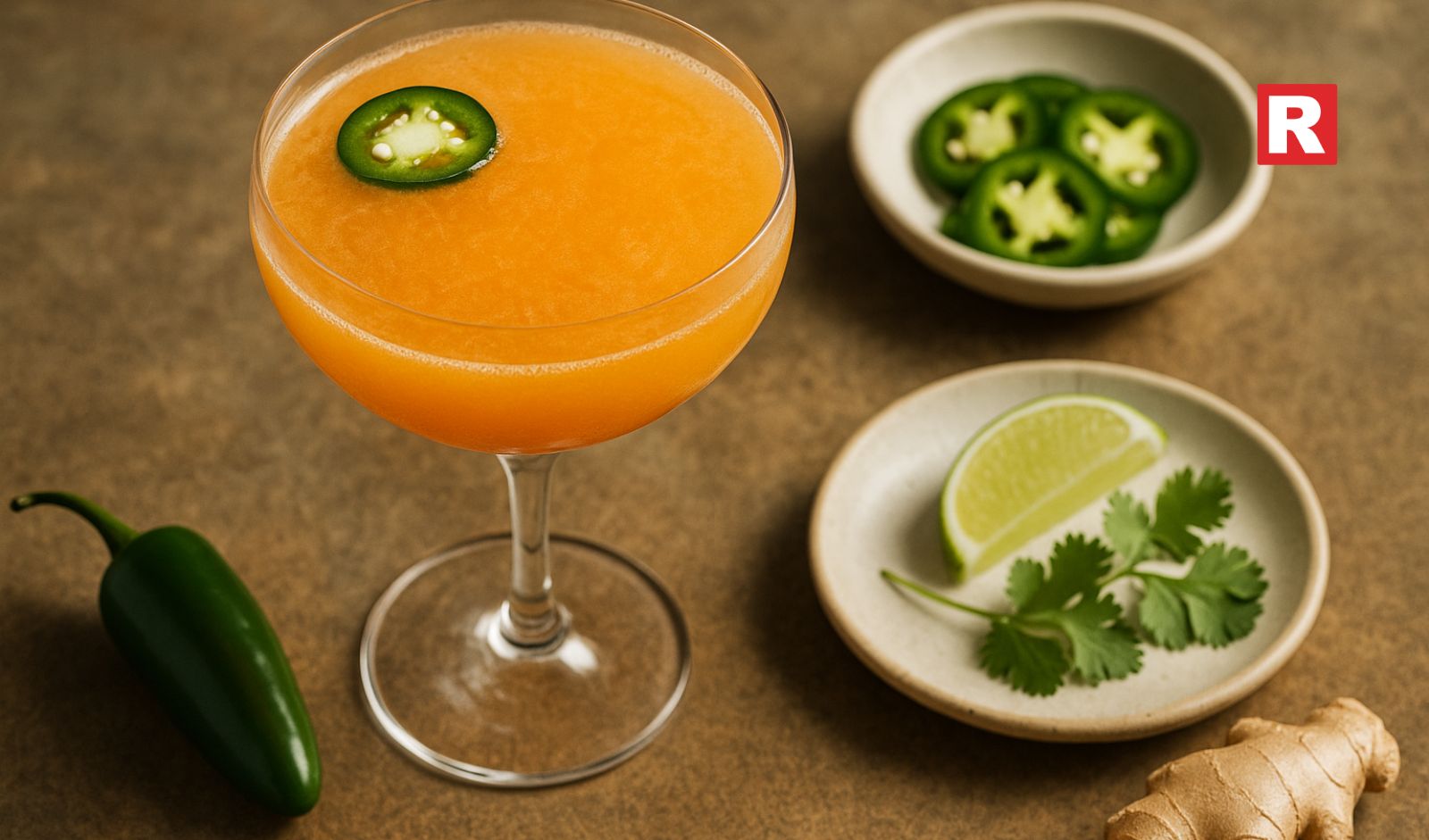
India is traditionally known as a tea-loving country, but coffee has made its own strong place, especially in the southern regions. In fact, India ranks among the top 10 coffee-producing countries in the world. What makes Indian coffee stand out is its shade-grown cultivation, a method where coffee plants are grown under the canopy of trees, enhancing both flavour and sustainability. This technique results in a distinct aroma and smooth taste that appeals to both domestic and international coffee lovers. Most of India’s coffee is grown in the hilly regions of the Western and Eastern Ghats, where the climate and soil are ideal for cultivation. But the question arises—which Indian state is the largest producer of coffee? Among all states, one clearly dominates in terms of quantity, quality, and heritage. From traditional filter coffee to modern artisanal blends, let’s explore the coffee heartland of India and find out where your favourite brew begins.
Read more: 6 Benefits of Drinking Black Coffee
Karnataka – The Coffee King of India
Karnataka is the highest producer of coffee in India. This southern state produces over 70% of India’s total coffee. The top coffee-growing districts in Karnataka are Chikkamagaluru, Kodagu (Coorg), and Hassan. These regions have the perfect weather and soil for coffee plants. According to the Coffee Board of India, Karnataka produced nearly 2.3 lakh metric tonnes of coffee in 2023-24. Both Arabica and Robusta coffee varieties are grown here.
Karnataka’s geography plays a big role. The state is part of the Western Ghats, a mountain range that offers the perfect altitude, rainfall, and soil for coffee plants. The coffee here is grown under natural shade, which protects the beans from harsh sunlight.The region also gets good monsoon rains. This helps in the natural washing and drying of beans, giving them a rich and earthy flavor. Also, coffee in Karnataka is mostly grown on small farms, often passed down through generations. These farmers take great care in maintaining quality.
Know more: 11 Best Commercial Coffee Machine Brands for Café: Top Picks & Buying Guide
Arabica vs Robusta – What’s Grown in Karnataka?
Karnataka grows both types of coffee:
Arabica is mild, aromatic, and has low caffeine. It grows at higher altitudes.
Robusta is stronger and more bitter, with higher caffeine. It grows at lower heights.
Arabica is considered premium, and a large part of it is exported to Europe and the U.S. Robusta, on the other hand, is used in instant coffee and filter blends in India.
State-Wise Coffee Production in India
Here is a quick look at India’s top coffee-producing states (2023-24 data from Coffee Board of India):
| State | Production (Metric Tonnes) | Share in Total |
| Karnataka | 2,30,000+ | 70%+ |
| Kerala | 70,000+ | 20% |
| Tamil Nadu | 15,000+ | 5% |
| Andhra Pradesh | 6,000+ | 2% |
| Odisha | 3,000+ | 1% |
| Others (incl. Northeast) | 1,500+ | <1% |
Karnataka clearly leads by a wide margin.
Also check: 5 Best Coffee Beans in the World: Sips of Heaven You Can’t Miss
Best Instant Coffee Brands in India for Office-Goers
The Rise of Coffee in Northeast India
States like Nagaland, Meghalaya, and Arunachal Pradesh are now growing coffee too. These areas are still small players, but the government is supporting coffee farming here to give tribal communities more income. The taste of Northeast coffee is different, with fruity and floral notes. If you’ve ever had a cup of hot filter coffee in a steel tumbler in Bengaluru or Mysuru, you’ve experienced Karnataka’s coffee culture. Known as "filter kaapi," this drink is strong, aromatic, and a daily ritual for many.
Coffee in Karnataka is more than a drink. It is a part of the lifestyle. Many families still brew coffee at home the traditional way, using a filter and fresh decoction. Even local cafes and eateries serve coffee with pride.
From Farms to Brands – Karnataka Coffee Goes Global
Many well-known Indian coffee brands source their beans from Karnataka. These include:
Blue Tokai
SLAY Coffee
Tata Coffee
Third Wave Coffee Roasters
These brands have helped promote Indian coffee in both Indian and international markets. The demand for single-origin and premium coffee is growing fast.
Also read: 5 Bestselling Coffee Brands in India to Try Right Now
Coffee Tourism in Karnataka – A New Experience
Today, many people visit Chikkamagaluru and Coorg not just for sightseeing, but also for coffee estate stays. Tourists can walk through plantations, learn how beans are picked and processed, and enjoy fresh cups right at the source.
Estate owners offer plantation walks, tastings, and even coffee-making workshops. These trips help people connect with the farming process and support local businesses. Coffee has even made its way into South Indian films. Several Kannada, Tamil, and Malayalam movies show scenes where families gather over coffee. In urban settings like Bengaluru and Chennai, modern coffee shops have become common shooting locations. The blend of tradition and modernity is clear in how coffee is portrayed on screen.
Lesser-Known Facts About Indian Coffee
India is one of the few countries that grows shade-grown coffee.
The famous Monsoon Malabar coffee is made by exposing beans to monsoon winds for weeks, giving them a bold flavor.
Indian coffee is mostly hand-picked, not machine-harvested.
Karnataka exports coffee to over 45 countries including Italy, Germany, Russia, and Belgium.
Sustainability and Women in Coffee
Many plantations in Karnataka now focus on eco-friendly farming. Coffee is grown without cutting trees. In fact, it helps preserve forest cover. Also, several plantations employ local women and tribal communities, giving them a steady income.
Groups like Women in Coffee India are helping train and promote women entrepreneurs in the sector. This is making coffee production not just about business, but also about empowerment.
Final Thoughts
Karnataka is truly the coffee capital of India. With its ideal climate, fertile soil, and long-standing tradition of coffee cultivation, it produces over 70% of the country’s total coffee. Regions like Chikkamagaluru, Coorg, and Hassan are at the heart of this production, offering a perfect mix of altitude, rainfall, and shade-grown methods that enhance both the quality and flavour of the beans. Whether you're enjoying a strong cup of filter coffee at a local café in Bengaluru or walking through lush estates in Coorg, Karnataka offers a complete coffee experience. It blends heritage with innovation, tradition with technology, making it a key player in India's coffee story—one that continues to grow and inspire coffee lovers across the world.

Safe drinking water is essential in India. Water quality is not the same everywhere. Some cities have clean pipelines, while others face pollution issues. Old and damaged pipelines can make tap water unsafe. For many families, this is a concern. Because of this, branded mineral and packaged drinking water have become a common choice. People rely on it at home, in offices, and while travelling. Restaurants, hotels, and airlines also serve bottled water to ensure safety. It provides peace of mind and convenience.
Mineral water is not the same as ordinary bottled water. It comes from natural sources or is purified and enriched with minerals. Minerals like calcium, magnesium, and potassium make it healthy and tasty. Indians prefer trusted brands because of quality checks and safety standards. Established brands follow strict processes to remove impurities. They maintain consistent taste and mineral content. Choosing the right mineral water depends on the source, mineral content, and packaging. Labels and certifications, like FSSAI approval, help consumers make the right choice. With rising awareness about health and hygiene, safe mineral water has become an everyday essential for Indian households and travellers alike.
What Is Mineral Water?
Mineral water is water that contains naturally occurring minerals. These minerals include calcium, magnesium, potassium, and bicarbonates. Some mineral waters come from protected underground sources. Others are enriched with minerals after purification.
In India, mineral water must follow strict rules. The Food Safety and Standards Authority of India (FSSAI) sets quality standards. These include limits on microbial content, chemical safety, and mineral composition. Every licensed brand must meet these norms before selling to consumers. Many products sold in the market are technically “packaged drinking water.” True natural mineral water is less common and usually priced higher. However, both categories focus on safety and consistency.
Best Mineral Water Brands in India
1. Bisleri

Bisleri is one of the most recognised water brands in India. It has been serving consumers for many decades. People in both cities and towns trust the brand for safe drinking water. Bisleri sources its water locally. It goes through several filtration and purification steps to ensure safety. Minerals are added to maintain a balanced taste. The brand operates multiple plants across India. This helps keep the water fresh and widely available. The company offers bottles in different sizes. Small travel packs are convenient for on-the-go use. Large 20-litre jars cater to homes, offices, and events. Bisleri is also a common choice in hotels and restaurants. What sets Bisleri apart is its strict quality control and extensive distribution network. Its reliability and consistency make it a favourite choice for millions of Indians every day.
Read more: Top Fruit Juice Brands in India Loved by Health-Conscious Consumers
5 Famous Soft Drinks in India, and Are They Safe for You?
2. Kinley

Kinley is a popular water brand owned by The Coca-Cola Company. It is among the fastest-growing bottled water brands in India. The water goes through a strict purification process. This includes reverse osmosis, sand filtration, and disinfection. Minerals are added to maintain a consistent and pleasant taste.
Kinley is widely used in offices, restaurants, and on airlines. Consumers trust it for its clean taste and safe packaging. The brand ensures high quality and follows all Indian safety standards. Its bottles are available in different sizes, making it convenient for daily use at home or on the go. Kinley has a strong presence across major cities and smaller towns. This wide availability makes it easy for consumers to access safe drinking water anytime. Reliability, quality, and taste have made Kinley a trusted choice for millions of Indians.
3. Aquafina

Aquafina is the packaged water brand of PepsiCo. It is known for its strong global reputation and consistent quality. The water is purified through a multi-step process. This includes reverse osmosis and ultraviolet treatment. These steps remove impurities and ensure the water is safe to drink. The result is water that is light, fresh, and smooth in taste.
Aquafina is popular among young consumers. It is often found in cinemas, airports, and quick service restaurants. Its clean taste and safe packaging make it a reliable choice for daily use and travel. The brand follows strict international quality standards. It maintains the same taste and safety across different regions in India. This consistency has made Aquafina a trusted and widely chosen water brand among Indian consumers.
4. Bailley

Bailley Water is an emerging Indian bottled water brand. It has gained strong visibility in recent years. The brand focuses on providing safe water at an affordable price. Bailley follows all FSSAI guidelines. It uses advanced purification methods to ensure the water is clean and safe to drink. The brand maintains quality while keeping costs low.
It offers a variety of packaging options. Small bottles are convenient for daily use, while large jars are ideal for home and office delivery. This flexibility makes it suitable for different needs. Bailley is becoming popular in tier 2 and tier 3 cities. Its competitive pricing and expanding distribution network allow it to reach more consumers. The brand is now seen as a reliable alternative to older, established water brands in India.
Know more: Top Soup Brands in India That Make Comfort Food Quick, Warm, and Delicious
5. Himalayan Natural Mineral Water

Himalayan is a premium natural mineral water brand. It is sourced directly from the Himalayan mountain range. The water flows through natural aquifers and is bottled at the source. This process helps retain essential minerals such as calcium and magnesium. The water is known for its smooth taste and high purity. It does not go through heavy processing, keeping its natural composition intact. This makes it a preferred choice for consumers who value natural mineral water over treated options.
Himalayan water is often served in luxury hotels, fine-dining restaurants, and on international flights. Its premium quality and natural taste make it suitable for special occasions as well as everyday consumption. The brand combines purity, mineral content, and a refreshing taste, establishing itself as a trusted choice for those seeking high-quality mineral water in India.
6. Tata Copper+

Tata Copper+ is a recent addition to the Indian bottled water market from the Tata Group. The brand combines purified water with the benefits of copper. Copper has traditionally been used in Indian homes for storing water, as it is believed to have health benefits. Tata Copper+ provides a measured amount of copper in each bottle while ensuring the water remains safe to drink. The production process is carefully controlled to prevent excess copper intake. This makes it suitable for daily consumption.
The brand is aimed at health-conscious consumers who appreciate a balance between traditional practices and modern science. It is packaged in convenient bottles for home, office, and on-the-go use. With the trusted Tata name behind it, Tata Copper+ has quickly gained credibility and is seen as a safe and beneficial choice for Indian consumers.
What Makes a Good Mineral Water Brand?
A good water brand focuses on more than just packaging.
- Source transparency is important. Consumers should know where the water comes from.
- Purification technology also matters. Advanced filtration ensures safety and consistency.
- Mineral balance affects taste and suitability for daily use. Too many minerals can change taste. Too few can feel flat.
- Certifications and FSSAI licensing are non-negotiable. Packaging quality also matters to avoid contamination.
Also read: Top Bread Brands in India That Define Freshness and Taste
Top Flavour Coffee Brands in India That Every Coffee Lover Must Try
6 Benefits of Drinking Black Coffee
Mineral Water vs Packaged Drinking Water
Many people confuse these two terms.
- Mineral water usually contains natural minerals. It may come from underground sources.
- Packaged drinking water is treated water. Minerals may be added after purification.
- Mineral water is often priced higher. Packaged water is more common for daily use.
Both types must meet Indian safety standards.
Healthy Sip
Choosing the right mineral water brand is a simple but important decision in India. Water quality varies across cities and towns, so safety cannot be overlooked. Many households prefer bottled water to ensure clean and healthy hydration. Brands like Bisleri, Kinley, Aquafina, Bailley, Himalayan, and Tata Copper+ have earned consumer trust over the years. They focus on safety, consistent quality, and wide availability. Each brand caters to different needs. Some are ideal for everyday use at home or office. Others, like Himalayan or Tata Copper+, target premium users looking for natural minerals or added health benefits. Availability, taste, packaging, and mineral content are key factors when selecting a brand. Reliable brands follow strict purification methods and safety standards. Choosing safe mineral water not only protects health but also provides peace of mind. Trusted brands make it easy for consumers to stay hydrated, ensuring every sip is clean, safe, and refreshing.

India’s fruit juice market has grown fast in the past few years. People want healthy, quick, and natural drink options. Busy schedules, rising awareness about nutrition, and the shift towards cleaner labels have made packaged fruit juice a daily choice for many families. From classic cartons to new-age cold-pressed bottles, the country now offers a wide mix of juices that suit every taste and lifestyle.
For someone who prefers natural drinks over fizzy beverages, choosing the right fruit juice brand becomes important. With so many claims like 100% juice, no sugar added, organic, and cold-pressed, it helps to know what each brand brings to the table. Here is a detailed guide to the top fruit juice brands in India, along with the features that make them unique.
India’s Fruit Juice Market Value and Growth
Recent industry reports show that India’s fruit juice market is much larger than the earlier USD 2.5–3 billion estimate. According to IMARC Group, the market was valued at USD 5,216.7 million (~USD 5.2 billion) in 2024, and it is expected to grow strongly, reaching around USD 14,355.1 million by 2033, with a CAGR of 11.90%.
Meanwhile, the packaged juice market in India alone is projected to be worth USD 5.26 billion in 2024, per data-bridge research. This growth is being driven by rising health awareness, increasing demand for natural and nutrient-rich beverages, and expanding modern retail and online distribution channels
What to Look for Before Buying Fruit Juice
Choosing the right juice depends on personal needs. A few important points to check include:
- Ingredients: The best juices have real fruit content and minimal additives.
- Sugar Level: Many brands offer low-sugar and no-added-sugar options.
- Preservatives: Cold-pressed and some organic brands avoid preservatives.
- Packaging: Airtight cartons or glass bottles keep the juice fresh.
- Extraction Process: Cold-pressed extraction keeps vitamins and minerals intact.
- Certifications: FSSAI approval, organic labels, and quality checks matter.
A careful look at the label helps people understand what they are drinking.
Top Fruit Juice Brands in India
1. Real Fruit Power (Dabur)

Real Fruit Power is one of the most trusted fruit juice brands in India. Many families choose it because it offers real fruit pulp and a steady taste. The brand has been around for years, and it continues to be a common choice in Indian homes. It offers many flavours. These include orange, mango, pineapple, litchi, guava, and mixed fruit. Each flavour has a clean and familiar taste. The juice is easy to find in stores across cities and towns. People prefer it because it feels safe, simple, and reliable. Real Fruit Power also offers good value for money, which makes it popular among regular buyers. It stays a top pick for anyone who enjoys everyday fruit juice.
Why it is popular:
- Known for consistent taste
- Wide availability across India
- Affordable price range
- Trusted parent company
Read more: 8 Famous Vegetarian Dishes of Uttar Pradesh and Their Timeless Legacy
Best Exotic Fruits to Enjoy This Winter for Taste, Health and Glow
2. Tropicana
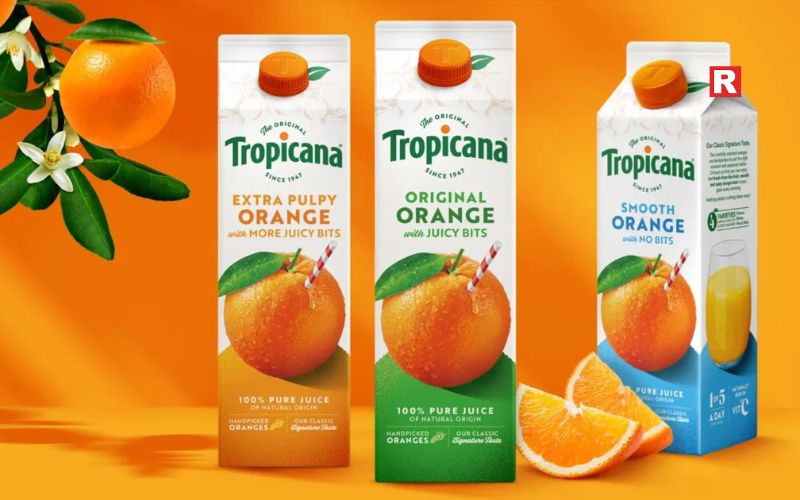
Tropicana is a well-known global juice brand with a strong presence in India. It is trusted for its focus on freshness and high fruit content. Many people pick it because the taste is clean, simple, and close to natural fruit. Tropicana 100% is popular among those who want juice with no added sugar. Tropicana Essentials is chosen by people who want extra nutrients in their daily drink. The brand offers classic flavours like orange, apple, and mixed fruit. It is easy to find in homes, offices, hotels, and cafés. Consumers like it because it feels pure, consistent, and safe for everyday use. Tropicana continues to be a top choice for health-minded buyers across the country.
What sets it apart:
- No added sugar in the 100% range
- Smooth, natural taste
- Good for daily consumption
- Popular in homes, offices, and hotels
3. Paper Boat
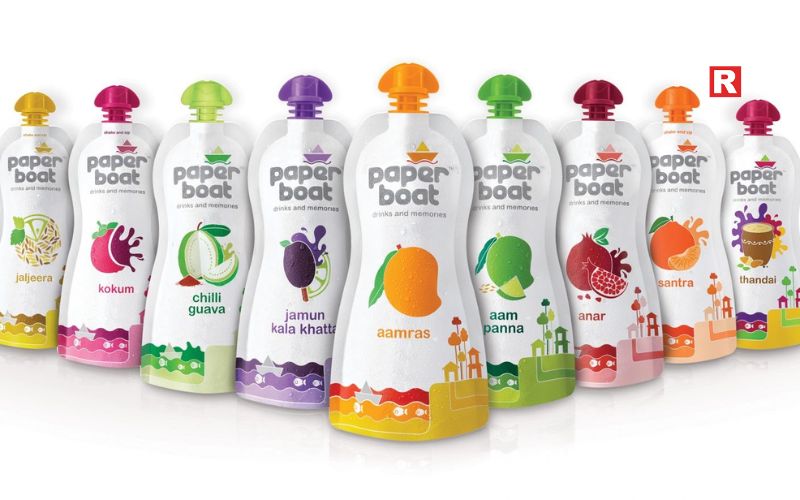
Paper Boat is a popular brand known for its refreshing drinks and Indian-inspired flavours. It brings back familiar tastes from childhood, which makes it special for many people. While it is famous for nostalgic drinks like Aam Panna and Jaljeera, it also offers a range of fruit-based beverages. These drinks are light, simple, and easy to enjoy at any time of the day. The brand focuses on gentle sweetness and clean ingredients. Its packs are travel-friendly and easy to carry. Many consumers prefer Paper Boat because it offers something different from regular packaged juices. It blends tradition with modern convenience. This mix of taste, memory, and ease makes Paper Boat a favourite choice across India.
Unique features:
- Indian flavours with modern packaging
- No artificial colours
- Gentle sweetness
- Travel-friendly packs
Know more: 5 Famous Soft Drinks in India, and Are They Safe for You?
4. B Natural (ITC)

B Natural is a well-known juice brand that focuses on using fruits grown by Indian farmers. This gives the brand a strong local touch and makes it appealing to people who want to support Indian produce. B Natural also highlights its “No Concentrate” promise in many of its products. This means the juice is made from real fruit pulp and not from processed concentrate. The brand offers many flavours that suit everyday use. Its packaging looks premium and feels safe for families. Many consumers choose B Natural because it gives them a sense of freshness and trust. It also stands out for its clean ingredient list. This makes it a strong choice for those who want natural and reliable fruit juice.
Highlights:
- Made from Indian fruits
- Many variants have no added preservatives
- Wide range of flavours
- Premium packaging
5. Raw Pressery
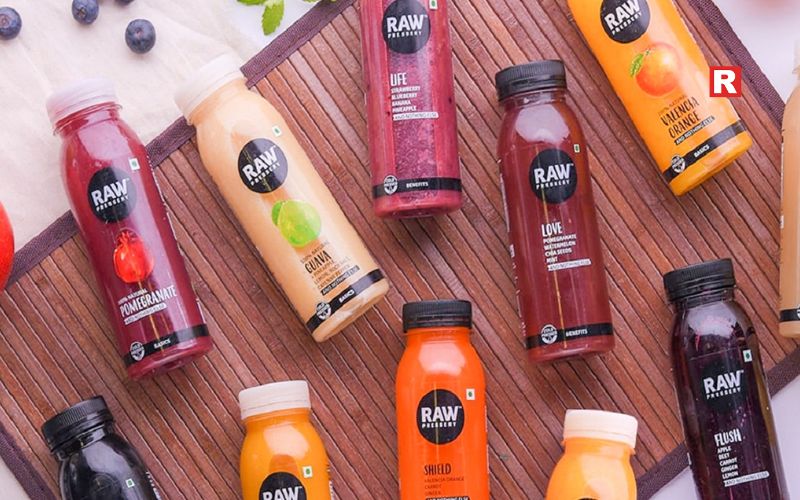
Raw Pressery is a leading cold-pressed juice brand in India. It is known for its clean-label drinks and fresh ingredients. The brand makes juices that are rich in natural nutrients. It uses high-pressure processing, which helps keep the juices fresh without adding preservatives. This process also keeps the flavour close to real fruit. Raw Pressery offers many blends, including orange, apple, coconut water, and mixed vegetable juices. Each drink feels light and pure. Many health-focused consumers pick this brand because it offers simple and honest products. It is also popular among people with busy lifestyles who want a quick source of vitamins. Raw Pressery continues to stand out for its quality and fresh taste.
Why people prefer it:
- Cold-pressed ingredients
- No sugar added
- No preservatives
- Rich in vitamins
6. 24 Mantra Organic
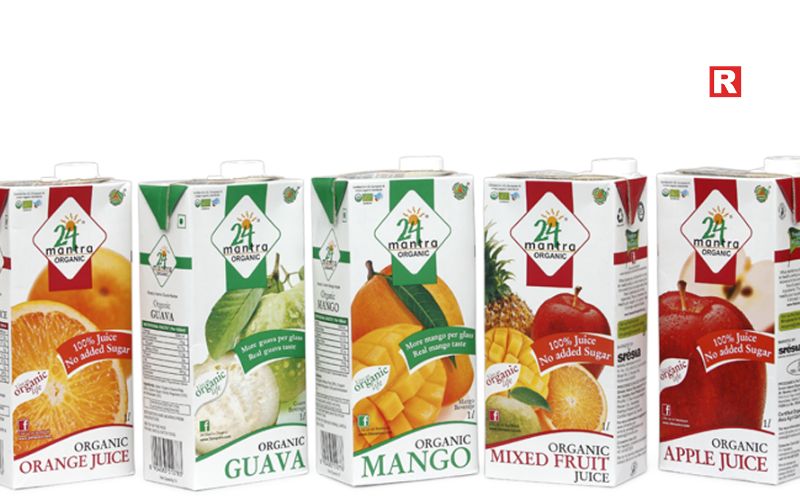
24 Mantra Organic is a trusted brand known for its organic fruit juices. It uses fruits that are grown without pesticides, which makes the juices safer for daily use. The brand focuses on clean and natural ingredients. Its juices have a mild and honest taste because they are made from real organic produce. Many families choose 24 Mantra Organic when they want chemical-free options. The brand also follows strict quality checks to keep its products safe and pure. It offers classic flavours that suit both adults and children. People who prefer a natural lifestyle often pick this brand for its simplicity and reliability. 24 Mantra Organic continues to stay popular among health-conscious consumers.
Why it stands out:
- Certified organic
- Natural taste
- Great for families aiming for chemical-free diets
Check more: What is Kimchi? Top Veg Kimchi You Can Try at Home
Top 10 Vegan Street Foods in India Every Indian Loves
Cold-Pressed Juices vs Packaged Juices
Cold-pressed juices are known for keeping more nutrients intact. This is why many fitness lovers prefer them. These juices are made with gentle pressure, which helps preserve vitamins and natural flavours. They usually contain no preservatives and offer a fresh, clean taste. On the other hand, packaged juices like Tropicana or Real are convenient and easy to store. They cost less and have a longer shelf life, which makes them suitable for regular family use. People who want a simple, everyday option often choose packaged juices. Those who focus on nutrition and freshness usually pick cold-pressed drinks.
Here are the key differences:
- Cold-pressed juices keep more nutrients.
- Packaged juices last longer.
- Cold-pressed juices offer fresh taste with no preservatives.
- Packaged juices are more affordable and easier to buy.
- Cold-pressed juices suit fitness-focused consumers.
- Packaged juices suit daily home use.
Fruity Sip
India’s fruit juice market offers many choices for different tastes and needs. There are traditional fruit drinks that remind people of familiar flavours. There are organic juices made from clean and chemical-free fruits. There are also cold-pressed juices that keep more nutrients intact. Each type serves a different purpose. Some people prefer a thick mango drink they enjoyed while growing up. Others look for organic juice because they want safer, pesticide-free options. Many health-focused buyers choose cold-pressed blends for vitamins and natural freshness. With so many brands and styles available, it has become easier for everyone to find something that suits their lifestyle. By checking labels and learning what each brand provides, buyers can make better choices. This helps them pick the right juice for daily health, taste, and convenience.

Few food combinations are as beloved as cheese and wine. Together, they provide a lavish tasting experience with a balance of textures and flavors that will delight any palate. Wine adds to the richness of the cheese, while the cheese softens and complements the acidity and tannins of the wine. This pairing has been popular and celebrated over many centuries, across many cultures in Europe and around the globe.
However, proper pairing is everything. When the wine and cheese pair together properly, the flavors of both of them are enhanced, creating a better-tasting experience that is enjoyable and remembered.
In this article, we will introduce you to 10 classic wine and cheese pairings. Each pairing will encourage you to find your favorite flavors and also give tips on tasting, serving, and enjoying this everlasting, noble partnership.
Read more: Top Vegetarian Foods You Can Include in Your Next Picnic
A Brief History of Wine and Cheese Pairings
Wine and cheese pairing has its roots in rural Europe generations ago, when local farmers would naturally pair what they most commonly produced: fresh cheese with the young regional wines, and aged wheels with bolder vintages. In France, Italy, and Spain, farm-to-table traditions resulted in such intuitive combinations as Brie and Champagne or Pecorino and Chianti. The focus of these pairings was not on extravagance, but rather that the flavors being combined came from the same soil. As trade and the sophistication of craft developed, generational practices that included cheese and wine parings became a culinary art, and wine and cheese pairing is now celebrated as a high-end experience at the world's finest dining establishments.
The 10 Luxurious Cheese and Wine Pairings
1. Brie & Champagne

Brie is most commonly known as the “Queen of Cheeses” and has a creamy and buttery smooth texture, featuring earthy flavors and a slight hint of mushrooms. The Champagne provides a crisp, fruity tasting experience and delicate bubbles that lift the palate. The pairing is a masterclass in balance: the fizz removes and lightens the richness of the Brie while also highlighting subtle flavors. Brie should be served at room temperature, and the Champagne chilled in a flute glass, accompanied by some fresh figs or almonds for a more elegant presentation. The result is a luxurious, airy-tasting experience designed for celebrations.
Know more: Top 10 Irish Whiskey Brands in India
2. Aged Cheddar & Cabernet Sauvignon

The aged cheddar has a firm, nutty, and tangy profile that pairs wonderfully with the bold, structured tannins and dark berry notes of Cabernet Sauvignon. The pairing can balance the intensity between both flavors while also allowing them both to shine. The cheddar should be served in small wedges, with a full glass of Cabernet in a Bordeaux glass, allowing the richness to shine through. This is a wonderful pairing for refined evenings, with a mouthwatering interaction of sharp and savory cheese with a full-bodied red wine.
3. Goat Cheese & Sauvignon Blanc

Fresh goat cheese is tangy, creamy, and slightly citrusy. It is an ideal match with Sauvignon Blanc, a zesty and herb-filled white wine. The bright acidity of the wine works well to balance the richness of the cheese for a refreshing and lively experience. You can serve crumbled goat cheese over a baguette or in a salad with a chilled glass of Sauvignon Blanc, to enjoy a light and classy feel. Either way, this pairing and cheese is perfect for lunch or casual snack times.
4. Gouda & Merlot

Aged Gouda offers beautiful caramel-like sweetness and nutty notes, which go nicely with the smooth, medium-bodied Merlot. The slight plum and chocolate notes of the Merlot complement the nuttiness of the cheese without overshadowing its earthiness. You might also serve slices of Gouda with Merlot in a Bordeaux glass, perhaps even dried apricots or walnuts, for a comforting tasting experience. This pairing is a wonderfully sweet and savory option that is perfect for cozy evenings.
5. Gruyère & Chardonnay

Gruyère is a firm, slightly sweet, and nutty cheese that pairs perfectly with a lightly oaked, buttery Chardonnay. The wine’s smoothness helps to amplify the caramel undertones in the cheese while providing an acidity that balances the creamy texture. Gruyère can be enjoyed alone, thinly sliced, or melted in a fondue, ideally with a glass of chilled Chardonnay for a classic Alpine-inspired experience. This pairing offers a rich combination of smoothness and flavour in a way that is elegant, but still comforting.
6. Blue Cheese & Port

Intensely flavoured blue cheeses, like Stilton or Roquefort, have saltiness, tang, and pungency. They are perfect with sweet, rich Port. The honey note with its fruitiness provides balance against the sharpness of the cheese, whisking you away to a melt-in-your-mouth experience. Serve crumbles of blue cheese with a small glass of Port, and optionally throw in walnuts or dried figs to enhance complexity. This pairing creates a luxurious, sweet, and salty contrast, perfect for after dinner.
What's new: 12 Foods Like Avocado That Are Creamy, Healthy, and Tasty
7. Parmigiano-Reggiano & Chianti

Parmigiano-Reggiano, with its granular, nutty, and slightly salty flavor, pairs well with a medium-bodied Chianti. The cherry-forward, earthy notes of the wine harmonize nicely with the cheese's umami richness, resulting in a caliber of flavor that is well-balanced and enjoyable. Break apart the Parmigiano into shards and serve alongside a glass of Chianti. This tasting experience is totally Italian-inspired and elegant. If you want to take it up a notch for a more gourmet experience, you can add a handful of olives or pieces of dried fruit that will complement the flavors of this classic pairing.
8. Camembert & Pinot Noir

Camembert is soft, creamy, and earthy and has light mushroom aromas, making it a delightful partner for a light-bodied, red fruited wine, such as a supple Pinot Noir. The wine's bright acidity helps to balance the creaminess of Camembert, while the cheese, in turn, brings out the wine's delicate berry flavors. Serve a slightly warmed Camembert alongside a glass of Pinot Noir, adding sliced pears or crusty bread to complete the experience. This pairing is a winner for cozy evenings or informal, elegant gatherings.
9. Manchego & Rioja

Manchego cheese, made from sheep's milk, is slightly nutty, creamy, buttery, and firm. Young Rioja, with its medium-bodied fruitiness and touch of oak, is the perfect wine to serve with this delicious cheese. You can thinly slice the cheese, pour yourself a glass of Rioja, and enjoy it simply with the cheese, or try adding some quince paste or almonds for a luxurious Spanish-inspired experience. These cheeses and wine harmonize so well together that they are both approachable and refined and sophisticated enough for an impressive aperitif or wine night.
10. Roquefort & Sauternes

Roquefort is an ideal French blue cheese that is salty, tangy, and creamy. It pairs well with a good, especially sweet, Sauternes wine. The luscious sweetness of the wine counterbalances the cheese's tangy sharpness and gives it a lasting, luxurious flavor. The cheese pairs beautifully when crumbled on a plate along with a chilled glass of Sauternes, with or without figs and walnuts. This decadent pairing is a celebratory experience of contrast, offering a scrumptiously enjoyable and memorable experience for any important occasion or celebratory event.
Check out: Top 5 Strong Beer Brands in India: Bold Brews for the Bold Drinker
12 Delicious Foods Like Dumplings From Asia You Must Try
Build a Luxury Wine & Cheese Board
- Choose a Statement Board: If you want a quality, restaurant-like presentation, select marble, slate, or Acacia Wood.
- Aim for a Balanced Selection: To create depth and variation, include at least one soft, one semi-soft, one hard, and one strong cheese.
- Create Visual Contrast: Use different shapes, such as wedges, cubes, slices, and whole rounds, to incorporate visual interest into your cheese board.
- Add High-End Accents: Fine quality truffle honey, fig jam, dehydrated orange slices, buds of Marcona almonds, and artistic charcuterie create instant elegance and appeal to luxury.
- Include Texture Enhancers: Crackers, soft baguette slices, seeded lavash, and crispbread ensure that every pairing feels satisfying.
- Use Fresh, Edible Garnishes: Rosemary sprigs, microgreens, edible flowers, and fresh berries offer aromatics and visual flair.
- Label Everything: Include small handwritten tags to personalize the cheese board and help guests feel comfortable with their pairings.
- Finish with Perfect Positioning: Set wines behind their corresponding cheese pairings to guide your guests through the tasting experience.
Serving & Presentation Tips
- In order for cheese to have the best flavour and aroma, it should be served at room temperature, and wines should be served either chilled for light whites or moderately chilled for heavier whites and reds.
- Cut cheese into bite-sized pieces, as they are easier to eat and present better on a wooden board.
- In addition to cheese, include nuts, dried or fresh fruit, charcuterie, and honey to your pairing.
- Use the appropriate glassware for wine tasting: flutes for sparkling wines, tulip glasses for whites, and wider-bowled glasses for reds.
Learn more: 7 Korean Alcohols That Prove There’s More to Korea Than Just Soju
The Joy of Pairing
Classic pairings of wine and cheese have remained timeless because they celebrate taste, texture, and tradition. These ten classic pairings will transport you on a sensory journey that transforms any occasion into a sophisticated, elegant tasting experience. By pairing wine and cheese thoughtfully, savouring the moment slowly, and exploring harmonious flavours, you can enjoy the indulgence and elegance of wine and cheese, whether as part of a dinner party, a romantic evening, or a solo reward. These pairings represent the luxury and artistry of gastronomy.

India’s relationship with coffee has changed over the years. Once famous as a tea-loving nation, it is now embracing coffee with great enthusiasm. Across the country, people are swapping their tea cups for coffee mugs. From small cafés in Bengaluru to high-end roasteries in Mumbai and Delhi, coffee has become part of everyday life. The Indian coffee market is no longer limited to plain instant coffee. It now offers a wide range of flavoured blends, single-origin beans, and specialty roasts. Brands are experimenting with chocolate, hazelnut, vanilla, and caramel notes to suit different palates. Young consumers, in particular, are driving this trend. They prefer trying new flavours, brewing methods, and café experiences.
According to market reports, India’s coffee industry was valued at about USD 20.2 billion in 2024 and is expected to touch nearly USD 30 billion by 2035. This growth shows a clear shift in taste and lifestyle. With increasing exposure to global coffee culture, Indians are discovering that coffee is not just a drink. It’s an experience filled with aroma, creativity, and comfort in every cup.
The Importance of Flavour in Coffee
Flavour is what makes coffee more than just a morning drink. It defines personality, mood, and preference. Some like it bold and bitter; others prefer smooth and chocolatey notes. Today, coffee lovers in India have access to a wide range of choices—from nutty and caramel to fruity and floral.
The rise of specialty coffee, cold brews, and ready-to-drink options has made flavour a key purchase factor. Consumers now look for single-origin beans, unique roasting profiles, and ethical sourcing. Whether it’s the strong filter coffee from South India or a creamy cappuccino made with Arabica beans, flavour is what sets each cup apart.
Explore Top Flavour Coffee Brands in India
1. Nescafé – The Classic Choice

Nescafé remains India’s most trusted coffee brand. Known for its consistent taste and accessibility, it has been a household name for decades. The brand offers a range of flavoured variants like Nescafé Gold, Nescafé Classic, and Nescafé Hazelnut. Its instant soluble coffee is crafted for convenience while maintaining balance and smoothness. Nescafé’s flavoured mixes, such as mocha and cappuccino sachets, make café-style coffee at home effortless. It’s perfect for people who prefer a quick, rich, and familiar cup every morning.
Read more: 8 Famous Vegetarian Dishes of Uttar Pradesh and Their Timeless Legacy
6 Benefits of Drinking Black Coffee
Top Tea & Coffee Brewer Brands in India These Days
2. Bru – The Homegrown Favourite

Bru is one of India’s oldest and most loved domestic coffee brands. Owned by Hindustan Unilever, it has built deep roots across Indian homes. The brand’s flagship blend, Bru Instant, combines coffee and chicory for a strong, full-bodied flavour. For those who love bold notes, Bru Gold offers 100% pure coffee with a more intense aroma. Its earthy, robust flavour caters perfectly to the Indian palate. Bru represents comfort, nostalgia, and everyday satisfaction.
3. Tata Coffee – The Estate Expert

Tata Coffee brings premium taste straight from India’s finest plantations. It is one of the largest integrated coffee companies in the world, with estates in Coorg and Chikmagalur. Tata Coffee’s single-origin and estate roasts reflect craftsmanship and sustainability. Its flavoured varieties, such as Tata Coffee Grand and Eight O’Clock, offer rich texture and freshness. Each roast is carefully curated, ensuring balanced acidity and aroma. If you enjoy smooth, refined coffee with a hint of sophistication, Tata Coffee is a must-try.
4. Blue Tokai Coffee Roasters – For the True Connoisseur

Blue Tokai has transformed India’s perception of coffee. Known for small-batch roasting and single-origin sourcing, it delivers freshness and complexity in every cup. Its flavour profiles range from chocolate and caramel to fruity and floral. Blue Tokai sources directly from Indian farms, ensuring transparency and quality. Each roast is unique, highlighting the natural flavours of the region. Popular blends like Attikan Estate and Thogarihunkal Estate are favourites among coffee enthusiasts who enjoy discovering new tastes. If you value aroma, freshness, and artisan craftsmanship, Blue Tokai is the perfect brand for you.
Know more: 11 Best Commercial Coffee Machine Brands for Café: Top Picks & Buying Guide
5. Davidoff Coffee – The Premium Indulgence

Davidoff is the luxury name in India’s instant coffee space. Imported from Europe, it delivers a smooth, sophisticated experience. Known for its 100% Arabica beans, Davidoff offers variants such as Rich Aroma, Fine Aroma, and Espresso 57. The coffee is balanced, aromatic, and designed for those who enjoy an elegant, café-like flavour at home. Every sip feels indulgent—ideal for people who view coffee as a daily luxury.
6. Hatti Kaapi – The Taste of Tradition

Hatti Kaapi celebrates the heritage of South Indian filter coffee. Based in Bengaluru, it has grown into a beloved brand across India. The brand’s signature blends capture the essence of authentic filter coffee—bold, aromatic, and deeply satisfying. Hatti Kaapi uses a blend of Arabica and Robusta beans roasted to perfection. The addition of chicory gives the coffee its signature thickness and richness. Served in traditional steel tumblers, it’s the taste of nostalgia in every cup.
7. Araku Coffee – From Farm to Cup

Araku Coffee is an organic, single-origin brand grown in the Araku Valley of Andhra Pradesh. Managed by a cooperative of tribal farmers, it’s India’s answer to sustainable, premium coffee. The beans are shade-grown and handpicked, resulting in a smooth, fruity, and balanced cup. Araku’s flavour range includes chocolatey, nutty, and caramel tones, depending on the roast level. It’s a brand that brings together quality, sustainability, and authentic Indian origin. Perfect for conscious consumers who love both flavour and purpose.
Also check: Top 5 Barbecue Sauces for Marinades or Dipping: Smoky, Sweet & Absolutely
10 Famous Fast Food Brands in India That Everyone Loves
Coffee Flavour and Roasting Explained
Flavour depends heavily on bean type and roast level. Arabica beans offer a smoother, fruitier taste, while Robusta beans are stronger and more caffeinated. Light roasts bring out bright, acidic flavours. Medium roasts highlight sweetness and balance. Dark roasts provide a deep, chocolatey taste.
Indian coffee, especially Monsooned Malabar, is famous for its mellow, earthy tones. The monsooning process exposes beans to moist winds, giving them a soft, distinctive flavour found nowhere else in the world.
How to Choose Your Perfect Flavour
Choosing your flavour depends on what you enjoy most.
- If you like mild and creamy, go for Nescafé Gold or Davidoff Fine Aroma.
- If you prefer strong and bold, try Bru Gold or Hatti Kaapi.
- For fruity or chocolatey notes, explore Blue Tokai or Araku Coffee.
- If you want a balanced, everyday cup, Tata Coffee Grand is ideal.
Always check the roast date and bean type. Freshly roasted beans have richer flavours and better aroma. Experiment with brewing methods—filter, espresso, or cold brew—to find your perfect taste.
Final Sip
Flavour gives coffee its character. It turns an ordinary drink into a personal experience. Every blend, roast, and aroma speaks of where the beans come from and how they are crafted. Whether it’s a quick instant mix or a carefully brewed single-origin roast, each cup holds a unique story. Across India, coffee lovers are learning to appreciate these small details. They notice how aroma, texture, and aftertaste change with every brand and brewing style. The country’s top flavour coffee brands are creating more than just caffeine fixes. They are building experiences that connect people to taste, place, and tradition. Each sip now reflects India’s evolving coffee culture—bold, creative, and deeply personal. The next time someone pours a cup, it’s not just coffee they’re enjoying. It’s a moment that captures the journey of flavour, craft, and passion growing across the nation.

Herbal teas have moved way past being just another health trend. These days, they’re woven into the everyday life of people, from busy Mumbai cafes to quiet cottages up in Himachal. People are ditching their usual coffee or chai for these calming, fragrant infusions. And here’s something a lot of people don’t realize: herbal teas aren’t actually “tea” at all. There are no tea leaves involved, just herbs, flowers, spices, and roots. Every blend has its own story, its own scent, and a little magic.
So, whether you need a morning sobering drink, something to help you unwind, or just want a detox that actually tastes good, these twelve herbal teas have you covered. They’ll lift your mood, settle your mind, and do your body some good.
Read more: Top 10 Tea Brands in India That Every Chai Lover Swears By
What Makes Herbal Tea So Special?
Herbal teas bring comfort and health together in every cup. Most are naturally caffeine-free, so anyone can enjoy them, any time of day. Regular tea sometimes leaves you jittery or thirsty, but herbal infusions hydrate and refresh you.
It’s not just about taste. Herbal teas can:
- Boost your immune system and help with digestion.
- Ease stress and anxiety.
- Improve your skin and hair.
- Help your body detox
- Support better sleep
Basically, it’s like having a cup of nature’s medicine, but minus the side effects and the hassle.
How to Brew Herbal Tea (Without Ruining It)
The trick to a perfect cup of herbal tea is: Don’t boil the herbs to death. Here’s how to do it right:
- Use fresh, filtered water.
- Bring it to a gentle boil, then toss in your herbs or a tea bag.
- Let it steep for 5 to 10 minutes, depending on what you’re brewing.
- Don’t let it sit forever; overdoing it makes it bitter.
- Add honey, jaggery, or a squeeze of lemon if you want something sweet.
- For iced tea, chill and pour over ice.
Tip: Keep your loose herbs in a glass jar with a tight lid. That way, their flavor and punch are preserved for a long time.
12 Herbal Tea Blends to Try Right Now
Each of these tea blends has its own vibe. Some calm you down, some wake you up, and a few just make you feel better from the inside out.
1. Tulsi (Holy Basil) Tea

Tulsi is called the “Queen of Herbs” in Ayurveda, and that is for good reason. It’s got a warm, slightly spicy flavor and builds your immunity. People drink it to fight off colds, clear up their lungs, and handle stress. Have it in the morning, or when you feel an upcoming cold. Tulsi keeps you steady and fresh.
Know more: The Secret Health Benefits of Matcha Tea You Probably Didn’t Know
2. Lemongrass & Ginger Tea

If you need a sharp and refreshing drink, then Lemongrass and ginger tea is the best choice. Lemongrass brings that citrus zing, while ginger adds a bit of heat. Together, they’re great for digestion, beat the bloat, and soothe sore throats. After a heavy meal or on a rainy evening, this blend brings pure comfort to the soul.
3. Chamomile Tea

Chamomile is the classic bedtime tea. It smells a bit like apples, and drinking it feels like wrapping yourself in a blanket. It helps you sleep, eases cramps, calms nerves, and even fights inflammation. No wonder it’s a favorite all over the world.
4. Hibiscus Tea

Bright red, tart, and packed with vitamin C, hibiscus tea looks as good as it tastes. It’s great for your heart, helps keep blood pressure in check, and makes your skin glow. Drink it hot in winter or iced in summer. It’s refreshing either way. Add honey or cinnamon for a twist in flavor.
5. Peppermint Tea

If you need to clear your head, go for peppermint. It cools you down, lifts your mood, and helps with headaches or stuffy noses. Plus, it settles your stomach. The crisp, minty taste wakes you up, even though there’s no caffeine. Perfect after a meal or during a work break.
What's new: Top Tea Brand options to consider for Restaurateurs in India
6. Turmeric & Black Pepper Tea

This golden brew is a powerhouse. Turmeric brings curcumin, a strong anti-inflammatory, and black pepper helps your body use it. Together, they support your liver, boost your immunity, and ease joint pain. Drink it warm with a little honey. The earthy, spicy taste is pure comfort, especially on cold days.
7. Rose Petal Tea

Rose petal tea sounds like luxury in a cup. It’s made from dried rose petals, so every sip brings a soft floral sweetness and a hint of tartness. Beyond the beautiful aroma, this tea is loaded with antioxidants that brighten up your skin, ease stress, and help with digestion. It helps with hydration too, making it a perfect pick for cozy self-care nights.
8. Lavender & Chamomile Blend

Mix lavender and chamomile, and the blend you get is the epitome of pure relaxation. This tea calms anxiety, balances your mood, and helps you drift off into deep, restful sleep. Sometimes the scent alone is enough to ease a tense mind. It’s the kind of drink you want before bed or on days when you’re dealing with a lot of stress.
9. Ashwagandha Tea

Ashwagandha, or “Indian ginseng,” is famous for helping you handle stress. The tea tastes earthy and a little bitter, but it really works. It helps with cutting down fatigue, lifting energy, and keeping your hormones in check. If you’re juggling deadlines or coursework, ashwagandha tea brings you calm and focus, all without any caffeine crash.
10. Mint & Tulsi Detox Tea

Do you need a fresh start in the morning? Mint & Tulsi Detox Tea is the perfect blend for that. Cool mint and cleansing tulsi work together to clear out toxins, support your digestion, and even help your breathing. Sip it first thing in the day and you’ll feel clean, alert, and ready for whatever comes next.
11. Cinnamon & Cardamom Tea
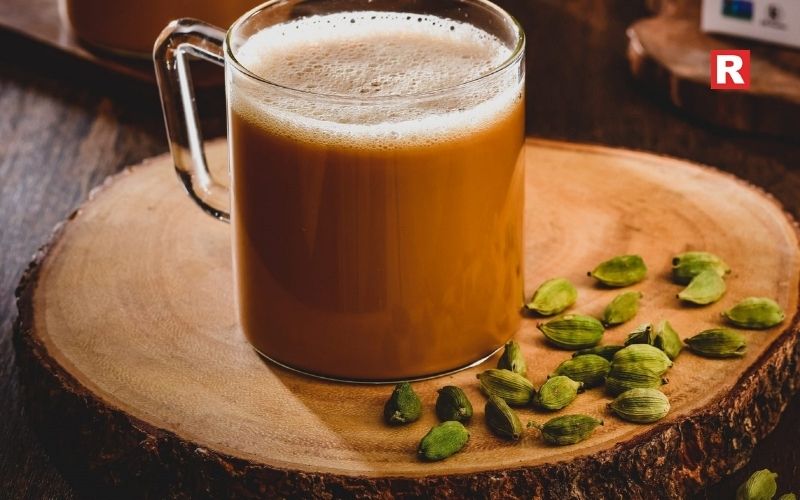
This blend is pure comfort. It is warm, spicy, and straight from the heart of Indian kitchens. Cinnamon helps keep blood sugar steady, while cardamom is great for digestion. Together, they make an ideal after-meal tea, especially when it’s chilly outside. The taste lingers, spicy and sweet, leaving you with a sense of warmth and energy.
Check out: Top Tea & Coffee Brewer Brands in India These Days
10 Best Coffee Bean Brands in India
12. Moringa Tea
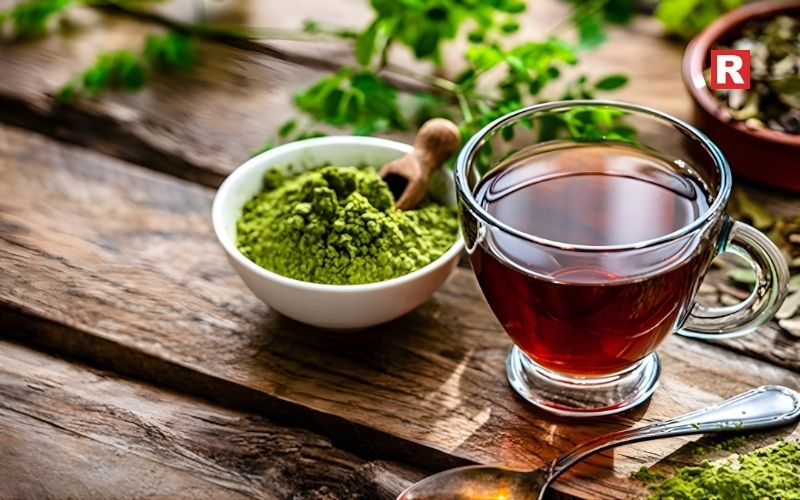
Moringa has earned its nickname, “Miracle Tree,” for a reason. The tea is packed with vitamins, minerals, and antioxidants. It helps manage weight, lowers cholesterol, and boosts energy naturally. The flavor is mild, a bit earthy, and won’t give you the jitters like regular green tea. If you’re looking to swap out your usual cup for something healthier, moringa tea is a smart choice.
Health Benefits of Drinking Herbal Teas Regularly
People who drink herbal teas regularly often notice real changes, both in mind and body. The antioxidants help fight off free radicals, leading to
- Better digestion, faster metabolism,
- Clearer skin and deeper hydration.
- Less stressed and anxious,
- Immunity boost and Liver function
- Sleep cycle settles into a healthier rhythm.
- Steady energy without relying on caffeine.
Swapping out sugary drinks or milk tea for herbal blends means cutting down on empty calories.
Herbal Tea Trends in India and Around the World
Herbal tea is having a major moment right now. The market’s booming, growing fast as more people want wellness and plant-based options. In India, brands are experimenting with local favorites like lemongrass, tulsi, and moringa, turning old Ayurvedic recipes into easy modern blends.
What’s trending?
- Iced herbal teas are popular with younger people.
- Organic and Ayurvedic blends are getting popular for those who want holistic health.
- Brands are using eco-friendly packaging.
- Custom blends or DIY tea kits are trending, which is perfect for gifts.
These days, whether you like small-batch teas or quick infusers, the choices just keep growing. And honestly, they’re healthier than ever.
Create Your Own Herbal Tea Blend
Once you get the hang of herbs, blending your own tea is a fun experiment.
- Start simple: mix flavors that go well together, like mint and tulsi or rose and hibiscus.
- Toss in warming spices like clove, cinnamon, and fennel.
- Try lemon slices or dried fruit for a fresh kick.
- Balance strong herbs with lighter ones so your tea tastes smooth, not overpowering.
- Store your blends in glass jars and keep them away from sunlight to lock in the freshness.
Learn more: 10 Dairy Brands Known for Their Quality in India
Warmth in a cup
Herbal teas aren’t just drinks; they’ve transformed into a daily dose of comfort and care. Every blend has a story, linking nature, taste, and tradition. Whether you need energy, calmness, a detox, or just a quiet moment, there’s a herbal tea out there made just for your needs.
So, instead of having caffeine, give a try to these herbal blends and let go of your worries. Pour yourself a cup full of color, calm, and natural goodness, and let each soothing sip take you somewhere better.

In India, milk isn’t just something you drink; it’s an integral part of your daily life. Think about it: morning chai, buttery parathas, those rich sweets at every festival, they all need milk to exist. Dairy is right at the center of Indian food and tradition. India leads the world in both producing and consuming milk, and the dairy industry here is massive. The dairy industry is valued at over ₹15 lakh crore, growing at around 6 to 8% CAGR each year.
As the market has grown bigger, so have the competitors in the market. Some are so famous that the dairy industry is not complete without them. They are known for their taste and brand value in the market. Many parameters define which brand is the best, especially in terms of its quality. As it’s not enough for milk to just taste good. People want it pure, safe, and sourced the right way. Some brands have really stepped up, whether they’re big cooperatives or fresh new labels, building trust with their focus on quality and honesty.
Here are 10 Indian dairy brands that are known for their quality and purity.
Read more: Top Indian Sweets Made with Milk You Need to Try—A Dairy Lover’s Paradise
1. Amul

If you want to see India's dairy revolution in one brand, it is Amul. Established as a farmer-powered cooperative in 1946 in Anand, Gujarat, Amul has challenged and redefined India's perceptions of milk. It has come to bring together more than 3.6 million farmers, and is in essence part of the Indian household. It is a name that universally signifies purity and trust.
Amul stands apart in its value of never compromising on quality. Each product, whether it is milk, butter, paneer, cheese, curd, ice cream, or chocolate, is subject to intense quality tests to ensure freshness and safety. Amul operates one of the largest cold-chain networks, ensuring nothing ever spoils, distributing products to millions every day. Amul ensures affordability, purity, and the essence of Indian dairy.
2. Mother Dairy

Mother Dairy was established in 1974 by the National Dairy Development Board, created as a part of the White Revolution, which aimed at delivering safe and hygienic milk to urban markets. Based in Delhi, Mother Dairy has garnered trust and respect for providing quality and dependable products throughout the years.
Mother Dairy employs innovative and state-of-the-art technologies for pasteurizing and homogenizing, ensuring that nutrients and taste are always preserved. Mother Dairy products are fresh and wholesome as a result of both the company and farmers working together to ensure that milk suppliers are paid a fair price. Furthermore, all products, including milk, curd, paneer, ghee, and ice cream, undergo strict tests to comply with FSSAI and ISO parameters. Their tagline goes beyond a marketing slogan; they assure every drop is pure and hygienic.
Know more: 10 Easy Air Fryer Snacks You Can Make at Home
3. Nandini
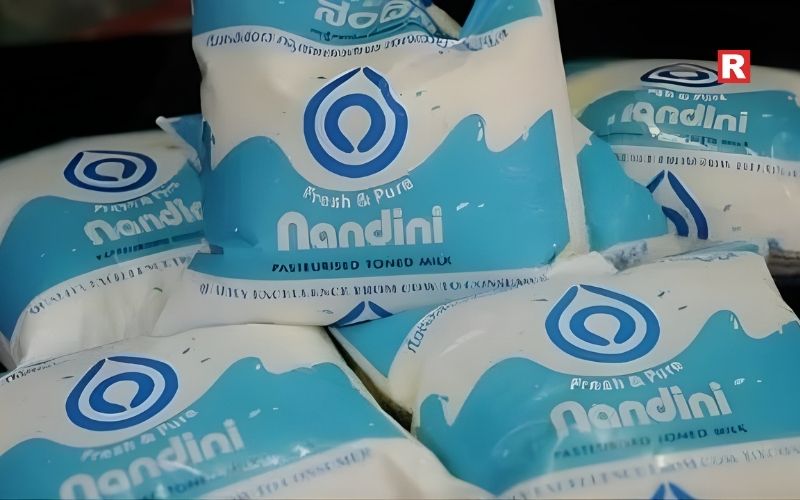
Nandini, a brand operated by the Karnataka Milk Federation, is not only a local brand but it is also the pride of South India in relation to dairy products. People consume Nandini because of the distinct, rich, and creamy taste, coupled with the impression of tradition you get from each packet. Eventually, Nandini gained acceptance not just within Karnataka, but also by people outside the state.
All of their milk comes from local farmers, which keeps their supply chain fresh and ethical. Nandini is a nice combination of modern production techniques and traditions, and they have a variety of offerings in their lineup: milk, curd, butter, ghee, flavored milk, sweets, etc. Nandini provides a great combination of taste, quality of product, and low prices, hence the regional acceptance of Nandini as a trustworthy brand.
4. Aavin

Aavin has been a staple for dairy lovers in Tamil Nadu since 1958. Under the confines of the state's Co-operative Milk Producers' Federation, Aavin is an operation with a mission to empower rural farmers while maintaining consistency, safety, traceability, and quality with its milk products.
All Aavin milk and curd are batch tested for quality by the FSSAI, so buying Aavin is buying quality and not taking risks. Aavin's range of products includes everything from butter, ghee, ice cream, and flavored milks to suit local tastes. Through environmentally friendly packaging and a focus on community service, Aavin promises to keep prices affordable and accessible, with a mission to keep everyone happy with good-quality dairy, produced by rural farmers.
5. Milky Mist

Launched in Erode, Tamil Nadu, in 1992, Milky Mist Fast-moving dairy brand is one of India’s fastest-growing dairy brands. The brand encompasses the modern side of dairy, offering milk products like cheese, paneer, yogurt, dips, and even some of those not found in traditional dairy.
The collection, processing, and packaging of all products that Milky Mist produces takes place in its production facilities, allowing the brand to keep a close watch on quality from start to finish. Using European technology to produce foods without preservatives, the company also produces specialty products such as Greek yogurt and mozzarella. The urban customer enjoys the balance of convenience and real dairy flavor, making Milky Mist a progressive brand for modern dairy products.
6. Gokul

In Maharashtra, Gokul Dairy is more than a brand; it’s part of people’s lives from childhood. Gokul is operated by the Kolhapur Zilla Sahakari Dudh Utpadak Sangh, and has been doing so for several decades, well-known for its values of purity and consistency of flavor.
Gokul sources milk daily from over 300,000 farmers, and uses sensor-quality equipment to process milk, all done under strict hygiene conditions. Their products, which offer milk, ghee, shrikhand, butter, and buttermilk, are popular due to their rich and fresh elements. Gokul is more than just a product; however, they have impacted the development of rural livelihoods and given dairy farmers a reliable source of income.
What's new: Top Sugar-Free Ice Cream Brands in India: Enjoy Every Scoop, Guilt Free!
7. Heritage Foods
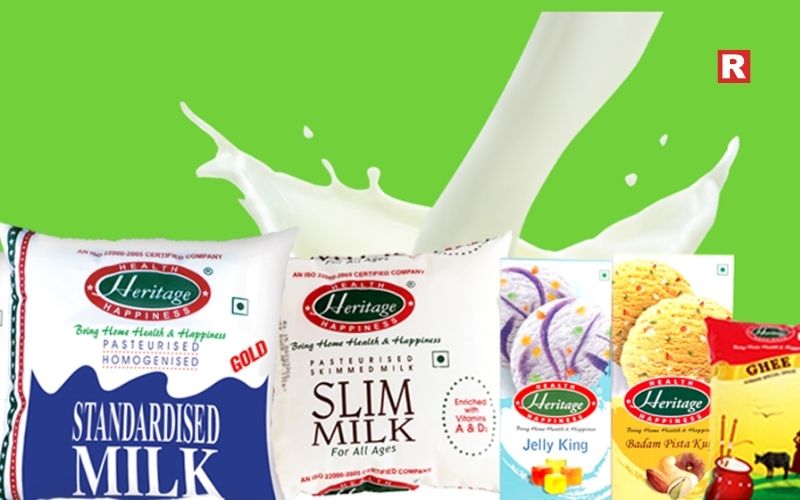
Launched in 1992 by N. Chandrababu Naidu, Heritage Foods stands today as one of the most modern and progressive dairy enterprises in India. Their operations span across 11 states; however, the distinguishing factor in their business is their diligence in providing freshness and quality while enhancing the livelihoods of the farmers.
Heritage remains a business with very little human involvement in production; their extensive chilling facilities protect food freshness and prevent bacteria growth through their state-of-the-art equipment. Heritage products, whether curd, paneer, ice cream, or flavored milk, are consistently associated with taste, safety, and hygiene standards. It is a business committed to sustainability and renewable energy to influence the Indian dairy market for a better future.
8. Parag Milk Foods

Parag Milk Foods, the company behind the brands Gowardhan, Go, and Pride of Cow, stands out in the landscape of Indian dairy products. Since launching in 1992, Parag has partnered with traditional dairy principles and modern technology to create a special lineup.
Gowardhan, for example, has brand loyalty amongst those who love the traditional ghee and butter line. Go speaks to today's influencer crowd through cheese, milkshakes, and other modern-day dairy treats. Pride of Cows is Parag's premium offering of fresh A2 milk delivered straight from the dairy farm, raw and unprocessed by human hands. Parag has world-class hygienic standards and the best processing standards the A2 milk industry offers, and has created a significant mark by combining innovation, quality, and a little something special into everything they produce. It really is incredible what they offer.
9. Nestlé Dairy

Nestlé is a key player in the global FMCG arena, and it has a stronghold on the dairy market in India through brand names like Milkmaid and Everyday Dairy Whitener. Nestlé is not your common cow's milk supplier, but, when it comes to processed dairy products, no one touches the quality of Nestlé.
Nestlé ensures that all of their product requirements meet strict international safety standards and employs an extensive R&D program to maximize nutrition and shelf life. Milkmaid has been a staple for Indian desserts and baking for ages, thanks to its rich, creamy sweetness. Every day is a convenient whitener for tea and coffee drinkers, consistently blending perfectly every time. Nestlé is committed to fortifying nutrition and sustainability, continually raising the quality bar for Indian households.
10. Epigamia and Country Delight

Recently, brands such as Epigamia and Country Delight have drastically redefined the way dairy is viewed by Indian consumers.
Epigamia, which debuted in 2015, is credited with bringing Greek yogurt and high-protein smoothies to India. The company’s products are made with real fruit, free of preservatives, and full of protein, ideal for urban health-conscious consumers looking for quick, healthy snacks.
Country Delight has transformed milk delivery with its subscription service. They deliver fresh milk, paneer, and ghee, straight from the farm to your doorstep within 36 hours of milking. You can also track your milk through their app, so you know exactly what you’re getting. In both cases, they illustrate how today’s consumer wants clean, safe, nutritious dairy on their own terms.
Check out: 10 Famous Indian Spices That Transformed Global Trade
10 Indo-Japanese Fusion Foods You Must Taste
Rising Demand for Quality & Transparency
With the stories about milk being adulterated, especially in the past couple of years, checking the quality of milk is a serious selling point for brands. Brands that can offer traceability, certification for organic and ethical farming practices, and so on are growing in popularity.
In cities, communities are looking for A2 milk, lactose-free milk, and probiotic products. This consumer interest prompts modern dairy brands to manufacture products that provide the market exactly what it demands.
Challenges in the Indian Dairy Sector
Despite the success, there are issues with dairy in India:
- Maintaining the cold chain, particularly in rural settings.
- Ensuring product purity and traceability in a still largely unorganized market.
- Volatile milk prices can destabilize farmer income.
- Managing the balance between high volume production and sustainability and animal welfare.
However, newer technologies, such as automated milking and blockchain tracking, are helping improve quality and efficiency.
The Future of Dairy in India
Indian dairy is making fast moves. Look to the next decade for:
- A major move toward value-added products like cheese, probiotics, and flavored milk.
- Private companies are jumping in with ideas.
- More exports to the world market with products like ghee, milk powder, and cheese.
- A significant emphasis on ecological, sustainable dairy production.
- The market is projected to continue to grow at a stable 6–7% CAGR annually, through 2030. Indian dairy is on a path to greater accomplishments, fueled by trust and innovation.
Learn more: 5 Tasty Coconut Dishes You Can Try at Home
A Dairy Delight
From big cooperatives like Amul and Mother Dairy to disruptors like Country Delight and Epigamia, the Indian dairy market is a combination of belief, economics, and trust. These 10 brands are providing quality while supporting millions of Indian dairy farmers and setting standards, while providing dairy that is safe for consumers. And with India's position as the dairy capital of the world, one thing will never change that is pure, high-quality milk in its every form is loved by Indians.

India’s beer market is undergoing rapid change. The days of one-size-fits-all lagers are slowly fading, especially in big cities like Bengaluru, Pune, Goa, and Mumbai. Drinkers now want something with personality like beer that feels fresh, tells a story, and maybe even uses local ingredients. Craft breweries know this. They’re experimenting with wild recipes, rolling out small batches, and setting up taprooms where you can visit and actually taste the difference. In this world, “craft beer” is all about creativity and character, and there's a feeling of community since you know who made your glass. If you’re open to exploring, you’ll find a growing list of Indian craft beers that really stand out. Whether you are a seasoned beer fan or someone just getting curious, knowing about the ten best craft beer brands below is worth a try.
What Makes Craft Beer Different?
Firstly, craft brewers intentionally remain small. They get to have fun, try new things, and skip the factory-line feel. They use better ingredients like fresh hops, good malt, local spices, or botanicals. You’ll see all kinds of styles too: IPAs, wheat beers, stouts, and even lagers with an Indian twist. Freshness is a big deal; most craft beers are brewed nearby and meant to be drunk soon, not stored for ages. And here’s the best part: the brewer’s personality, their story, even their quirks, all end up in your glass. So, you’re not just drinking a beer, you’re tasting someone’s vision.
Big, mainstream beer brands are all about pumping out the same beer, year after year, as cheaply as possible. Craft brewers care more about flavor, creativity, and the whole experience.
Read more: 10 Best Ginger Beer Brands in India
Top 10 Indian Craft Beer Brands You Shouldn’t Miss
1. Bira 91

Bira 91 kicked off in 2015 and really helped launch the craft trend in India. People know it for beers like Bira 91 White (a wheat beer with a citrusy, coriander twist) and Bira 91 Blonde (a crisp lager). Bira’s main customer base is the city drinkers looking for something tastier and more fun than the standard mass-market stuff. The creative branding and easy availability make Bira a great starting point if you’re new to craft beer.
What to know: Urban vibe, easy to find, a good intro to craft.
2. White Rhino
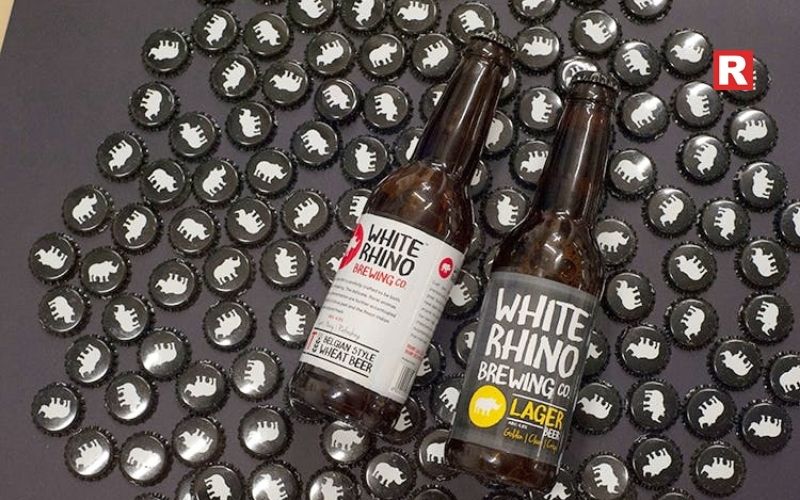
White Rhino started up near Gwalior in 2016 and claims to be India’s first true microbrewery that bottles its own beer. Their lineup covers Lager, Belgian Witbier, and IPA, all brewed with a focus on real-deal ingredients and quality, not just flooding the market.
What to know: Small-batch feel, not everywhere yet, perfect if you want something different.
3. BeeYoung

Launched by Kimaya Himalayan Beverages in 2018, BeeYoung calls itself a “premium craft beer,” and it actually lives up to it, especially for strong beer lovers. It’s one of the first strong craft beers around and has scored some big international awards for its smooth, citrusy taste.
What to know: Stronger kick, goes for a premium feel, great for folks who want more punch.
Know more: Top Draft Beer Dispenser Brands in India for the Perfect Pour
4. MAKA di
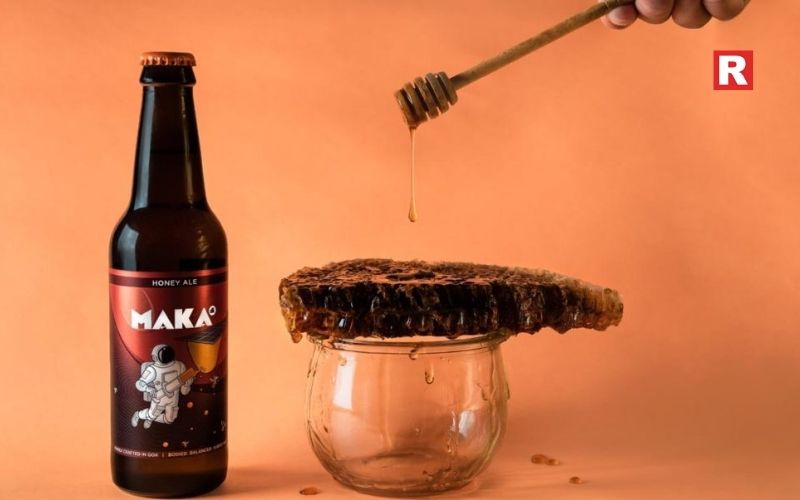
MAKA di is a fresh face out of Goa, and they’re not afraid to get weird when brewing, in a good way. Brewing in small batches, Belgian Tripel collabs, and flavors that bring in Indian ingredients like coriander or local hops are their most famous traits.
What to know: Creative flavors, big on local ingredients, great pick for adventurous drinkers.
5. Kati Patang

Based in Delhi, Kati Patang mixes classic brewing styles with bold Indian flavors like Saffron Lager or a wheat beer spiced up with turmeric, ginger, and peppercorn. They’ve even won some international gold medals.
What to know: Unique Indian twist, feels a bit upscale, definitely for those who want something different.
6. Simba

Simba is a homegrown brand that’s gaining popularity overseas too, by recently winning silver and bronze at the World Beer Awards. Their Belgian-style witbier and stout both pack serious flavor.
What to know: Indian roots with a global reputation, offers both easygoing and bolder styles.
What's new: Top Beers to Try on This International Beer Day
7. White Owl

White Owl was one of Mumbai’s early craft brewers. Their range covers everything from Spark (Belgian Wit) to Diablo (Irish Red Ale), plus an apple cider and a strong wheat beer. They stick to small batches, use imported ingredients, and keep things interesting.
What to know: Lots of choices, pretty easy to find in metro bars, good for anyone who likes to have variety.
8. Bad Monkey

Bad Monkey, from Sinq Beverages, introduces itself as “finely crafted beer,” using barley and hops from Europe/North America and Himalayan water. It’s not totally known as craft in the strict sense, but it’s aiming for that premium, strong beer spot.
What to know: Strong and premium, but maybe not as easy to find as some bigger brands.
9. Hoegaarden

Hoegaarden isn’t actually Indian; it’s Belgian, but it’s a big name among beer lovers in India. People here often treat it as the gold standard for wheat beers, so it’s a handy reference point when comparing local brews.
What to know: Imported, premium, and useful for comparing Indian wheat beers with a global favorite.
10. Budweiser

Budweiser’s everywhere. It’s mainstream, mass-market, and always available. In India, it’s pretty much the go-to for “regular” lager. Using it as a baseline makes it easier to spot what sets craft beers apart.
What to know: Classic mainstream lager. Compare other beers to this one to see what’s different.
Check out: 9 Facts You Should Know About Beer
How to Pair Beer with Indian Food: A Desi Guide to Perfect Pints
Why These Brands Matter
- Local craft brands (Bira 91, White Rhino, Kati Patang) focus on small batches, local ingredients, and experimenting with flavors.
- Premium and strong brands (BeeYoung, MAKA di, Bad Monkey) push boundaries and give higher ABV, new ingredients, and bold styles.
- White Owl blends craft with easy drinking and good distribution.
- Imports (like Hoegaarden and Budweiser) help you see how Indian beers stack up in taste, price, and style.
If you’re just getting started, try more common craft beers first, then work with one niche when you know what you like.
How Indian Craft Breweries Stand Out
Indian craft breweries have found their own groove:
- Using local ingredients: They use local stuff like Indian citrus, native hops, spices, and even Himalayan water.
- Innovative styles & limited editions: Seasonal brews, festival specials, collaborations with breweries from abroad.
- Packaging & branding: Eye-catching cans and bottles. The branding is bright and made for urban crowds.
- Sustainability: Local sourcing, lower carbon footprints, green brewing practices.
- Taprooms experience: Emphasize live music, great food, and events for the local crowd.
Tips for Exploring
- Try before you buy: Visit a brewpub or taproom if you can. Lots of places offer beer flights or samples.
- Mind your style: Wheat beers (like White Owl Spark or Hoegaarden) are usually smooth and light. IPAs or strong lagers (BeeYoung, Kati Patang) lean bitter or pack a punch.
- Freshness matters: Freshness is a big deal. Craft beer doesn’t always travel well, so check the packaging and expiry dates.
- Availability will vary: Availability depends on where you live. Indian states have different liquor laws, so some brands might be tough to find.
- Pricing: Craft beers cost more than mainstream lagers. You’re paying for originality and quality.
Where to Find Good Craft Beer
- Cities like Bengaluru (Koramangala, Indiranagar), Pune (Koregaon Park), Goa (Anjuna, Panjim), Mumbai, and Gurugram are craft beer hotspots.
- Many states sell cans and bottles in shops, and online delivery is picking up where the law allows.
- Beer festivals like The Great Indian Beer Festival are a great way to sample different styles.
- Restaurants and brewpubs now build full craft beer menus. Don’t be shy and ask the staff for a tasting flight.
Tips for First-Time Craft Beer Drinkers
- Pick your style: Wheat beers (like Bira White) are a totally different vibe from IPAs or stouts. Decide if you want something sweet, bitter, light, or heavy.
- Check the ABV (alcohol level) and IBU (bitterness rating) before you buy.
- Pairings:
- Wheat beers go well with spicy snacks or seafood.
- IPAs are great with grilled meats or rich curries.
- Stouts work with desserts, especially chocolate.
- Start with something lighter or lower in alcohol if you’re new to craft, then reach out to hoppier or stronger stuff.
- Freshness really matters. Drink craft beer as fresh as possible. Look for the bottling or canning date.
Learn more: Is Beer Good for Your Health? Here's the Truth You Should Know
The Future of Craft Beer in India
India’s craft beer scene isn’t just some passing trend. It’s live, buzzing with flavor and stories, and it’s all about local pride. You’ve got big names like Bira 91 and Simba, but then there are the smaller players like MAKA di, White Rhino, each one bringing something fresh to the table. Brewers here aren’t afraid to experiment or put their own spin on things. So if you love beer, or even if you’re just a little curious, go check out these brands. Drop by a brewpub, sample a few styles, just get to know the people behind the bar. Supporting local breweries isn’t just about the beer; it’s about finding new favorites, sharing a laugh, and feeling like you’re a part of something bigger.

Mahabaleshwar isn’t just another hill station tucked away in the Sahyadri mountains. It’s a place that wakes up all your senses. The cool air, the strawberry fields that stretch out in every direction, and those old colonial-era buildings give the whole place a charming, almost nostalgic vibe. People sure come here for the views, but once they arrive and try the food, they see the true beauty of this place.
Walk around Mahabaleshwar and you’ll notice the food culture is a mashup of Maharashtrian, Parsi, and Konkani flavors. That means bold spices, super-fresh veggies, and the kind of home-cooked comfort that just feels right. Whether you’re wandering the crowded main market or just grabbing a bite at a little café on the hillside, you’ll catch the scent of roasted corn, strawberries with thick cream, or some bubbling, heartwarming curry. It’s everywhere. The place almost smells like a giant kitchen.
If you’re into food, Mahabaleshwar is a straight-up paradise. Every meal tells a story, whether it is about the land, the people, or a real love for honest, flavorful cooking. You’ll spot roadside stalls selling corn pattice and mulberry ice cream, or maybe find yourself at Mapro Garden, devouring their famous strawberry treats. Eating here feels as refreshing as the mountain breeze.
Read more: 10 Indian Traditional Cuisines Every Food Lover Must Try Once in a Lifetime
The Legacy of Mahabaleshwar’s Food Culture
Mahabaleshwar used to be a summer getaway for the British, but now, it’s become a hotspot for food lovers. People come for the lakes and the views, but they stick around for the cafés, food stalls, and all those farm-fresh meals. The Strawberry Festival, which happens every year from February to April, turns the whole town into a celebration. You’ll find desserts, milkshakes, and baskets of just-picked berries everywhere you look.
Even with all the new cafés and trendy bites, the old-school charm hasn’t gone anywhere. You’ll still find proper Maharashtrian thalis, spicy Pithla Bhakri, and hearty gavran chicken curry on the menu, right next to strawberry-topped pizzas and frankies. Somehow, Mahabaleshwar pulls off this mix of tradition and new ideas, making its food culture stand out from anywhere else in India.
10 Iconic Foods of Mahabaleshwar
1. Fresh Strawberries with Cream

If you had to pick one dish that sums up Mahabaleshwar, this is it. Freshly picked strawberries smothered in thick whipped cream. It’s just pure happiness in a bowl. The sweet berries and rich cream balance each other perfectly. The best spots to eat this? Mapro Garden, Bagicha Corner, and Strawberry Den. They churn the cream fresh, and the strawberries get picked that morning.
Know more: 8 Famous Marathi Dishes to Try on Your Next Visit
2. Strawberry Milkshake
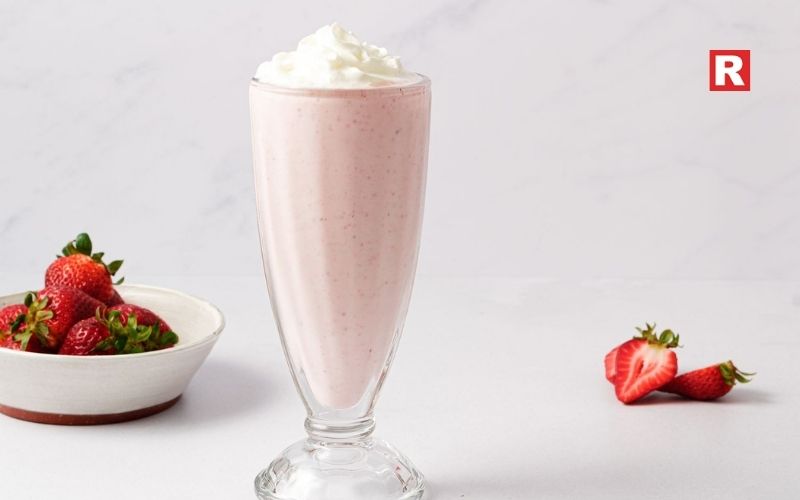
Imagine that you’re sitting on a porch, mist is rolling over the hills, and you have a glass of strawberry milkshake in your hand. That’s Mahabaleshwar in a sip. They make it with just-picked berries, creamy milk, barely any sugar, and sometimes a scoop of homemade ice cream for good measure. Elsie’s Dairy and Mapro Food Park are the best places to drink this.
3. Corn Pattice (Bhutta Pattice)

When the monsoon rolls in, nothing beats biting into a hot, crispy corn pattice. They mash sweet corn with green chilies and spices, shape it into patties, then fry it up golden. Dip it in mint or tamarind chutney and you’ll see why locals love it, especially near Venna Lake. So grab a cup of strong chai and watch the rain.
4. Mulberry Ice Cream

Mahabaleshwar’s mulberries hold their own fort next to its strawberries. Try the local mulberry ice cream. It’s tangy, sweet, and a little different from anything you’ll get elsewhere. Elsie’s and Mapro Garden have the best mulberry ice cream. It’s all you need on a warm afternoon.
5. Chikki (Strawberry, Walnut, or Peanut)

Chikki is everywhere in Maharashtra, but here, they make it with a twist by adding strawberries and walnuts. The Laxmi Chikki Center in the main market is famous for this reason, offering everything from sesame to dry-fruit chikkis. They’re crunchy, sweet, and make for perfect souvenirs to take home.
What's new: 6 Odisha Cuisine: Where Simplicity Meets Soulful Flavour
6. Gavran Chicken Curry (Local Country Chicken)

Gavran chicken curry is all about hearty and rustic flavors. It is fiery and straight from the villages of Maharashtra. They use desi chicken, grind their spices by hand, and let everything simmer into a thick, fragrant gravy. If you want the real deal, stop by a roadside dhaba or a tiny restaurant along Panchgani Road. The curry comes out bold and brimming with local flavor, perfect to eat with some bhakri or just plain steamed rice.
7. Pithla Bhakri (Traditional Maharashtrian Meal)

Pithla bhakri is a dish that just feels like home. It’s simple, filling, and the kind of food locals actually eat every day. The pithla, which is a humble curry made from gram flour, gets its flavors from garlic, chili, and turmeric. It is paired up with millet flatbread and a spicy thecha chutney. This dish will make you taste the slow life of the hills in every bite. What are the best places to eat this? Hirkani Garden Restaurant or those cozy, family-run joints near Lingmala Waterfall.
8. Corn Frankie / Corn Pakora

Sweet corn is everywhere in Mahabaleshwar, and locals turn it into some pretty addictive snacks. You’ll spot vendors near the market or at Mapro Garden, frying up spicy corn pakoras or rolling corn frankies stuffed with onions, tangy chutney, and a little cheese. Grab one with a cup of chai as evening sets in.
9. Homemade Strawberry & Mulberry Jams
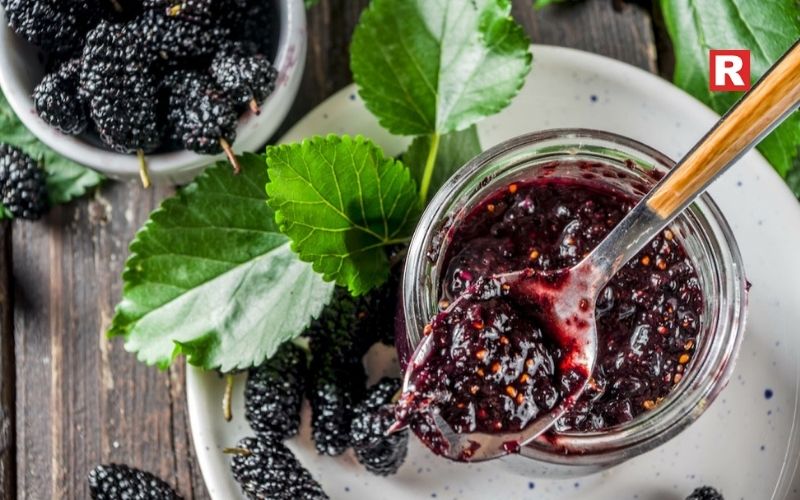
You can’t leave Mahabaleshwar without a jar or two of homemade jam. These are made from handpicked berries, sweetened with jaggery, and totally free of weird preservatives. The taste? Pure and bursting with fruit. Try Mapro, Pureberry, or those tucked-away family shops near Bhillar Village for jams, syrups, and crushes that store up the sweetness of the hills.
10. Strawberry Pizza & Strawberry Sandwiches

Mahabaleshwar has a quirky side too, just look at their strawberry pizzas and sandwiches. The pizza comes on a thin crust with cream, cheese, and fresh berries. It shouldn’t work, but it does! It is sweet, savory, and a little creamy. The strawberry sandwich keeps it simple: soft bread, clouds of whipped cream, slices of fresh fruit. If you want a taste, then head over to The Grapevine or Mapro Food Park for these fun twists.
Check out: Best Dishes in North East Indian Cuisine
A Close Look at Goa's Diverse Cuisine
What Makes Mahabaleshwar’s Food Unique
The food here is all about freshness and a home-cooked feeling. Almost everything you eat comes straight from local farms, especially the berries and corn. The cooks don’t skimp on Maharashtrian jaggery, pure ghee, or those bold, traditional spices, so every dish smells and tastes homey and real.
What’s cool is how old and new flavors mix. You’ll find classic plates like pithla bhakri right next to wild creations like strawberry pizza. Locals love making things from scratch, whether it’s jam, syrup, or their own spice blends. That’s what keeps the food here authentic and unforgettable.
Tips for Foodies Visiting Mahabaleshwar
- Best Time to Visit: If you want strawberries and other fresh fruit, visit between December and May. The Strawberry Festival (February to April) is the time to go for tastings and farm tours.
- Where to Eat: Check out Mapro Garden, Bagicha Corner, Elsie’s Dairy, or the food stalls by Venna Lake for the best bites.
- Where to Buy Local Products: Don’t skip the Mahabaleshwar Market, shops along Lingmala Road, or the little stalls in Bhillar Village. It’s the perfect spot for jams, chikkis, syrups, and spices.
- Try Local Cafés: Places like The Grapevine, Hirkani Garden, and Strawberry Den serve both the comfort food you crave and creative new dishes.
Learn more: 6 Common Ingredients Used in South Indian Cuisines
A Flavor Trail to Remember
Mahabaleshwar isn’t just a place, it’s a whole adventure for your taste buds. You get creamy strawberries with fresh cream, spicy gavran chicken, and everything in between. What really sets Mahabaleshwar apart is the way it slows you down. You find yourself sitting under strawberry vines, sipping a milkshake, or munching on a warm corn pattice as the mist rolls in. It’s simple, but it sticks with you.
So whether you’re a foodie, just passing through for the weekend, or always searching for something new, Mahabaleshwar’s flavors will follow you home, which are sweet, spicy, and impossible to forget.

Ginger beer is having a real moment to shine in India. It’s not just used for cocktails anymore; people are actually reaching for it as a refreshing drink on its own. Compared to ginger ale, ginger beer packs a punch of flavors. It’s spicier, bolder, and made with actual ginger, so you get that unmistakable kick. With craft beverages on the rise, more folks mixing drinks at home, and a shift toward premium, less sugary options, Indian drinkers are welcoming ginger beer with open arms.
We know that there are a lot of brands to choose from. Some local brands are playing around with Himalayan ginger, while big international names have popped up online. Whether you want something fiery and intense or prefer a mellow, sweeter sip, there’s a ginger beer out there for you. Here’s a look at the 10 best ginger beer brands available in India, where we break down what each tastes like, how to use it, and where you can actually find it. Basically, it’s your roadmap to finding the perfect ginger beer for your next cold drink or cocktail.
Read more: 9 Facts You Should Know About Beer
How to choose a ginger beer (quick buying checklist)
- Heat level: Some are seriously spicy (like Fentimans or Le Tribute), while others go easier (think Old Jamaica).
- Sweetness and sugar: Cane sugar, date sugar, and low-calorie stuff all change the taste balance.
- Fizz: More bubbles are great for cocktails. Softer fizz is better if you’re sipping it straight.
- Ingredients: Look for “real ginger” or “botanically brewed” on the label if you want the real deal.
1. Fever-Tree

Fever-Tree Premium Ginger Beer isn’t just thrown together. They use three different types of ginger (including Cochin ginger from India) for a deep, layered flavor. Bartenders love it for Moscow Mules and Dark ’n’ Stormys because it’s not too sweet and always delivers. It has a clean, spicy heat from the ginger, just a bit of sweetness, and a finish that sticks around. It's good for mixing cocktails or just drinking cold.
2. Fentimans

Fentimans uses botanical brewing, doing things the traditional way. It is a kind of fermentation process that brings out a strong, true ginger flavor. If you love a real ginger bite, this one’s for you. It is intense and warming, with floral and spicy notes and a hint of yeasty character. You can add it to cocktails that need some muscle or just pour it over ice.
3. Old Jamaica

Old Jamaica’s been around forever and is one of the most common ginger beers you can get in India. It’s reliable, full-flavored, and easy to find. It is great for people who just want a solid, spicy ginger beer. You can taste the bright ginger aroma. It has a medium level of heat and nicely balanced sweetness. Use it for everyday mixing or drinking straight from the fridge.
Know more: Top Draft Beer Dispenser Brands in India for the Perfect Pour
4. Barritts.
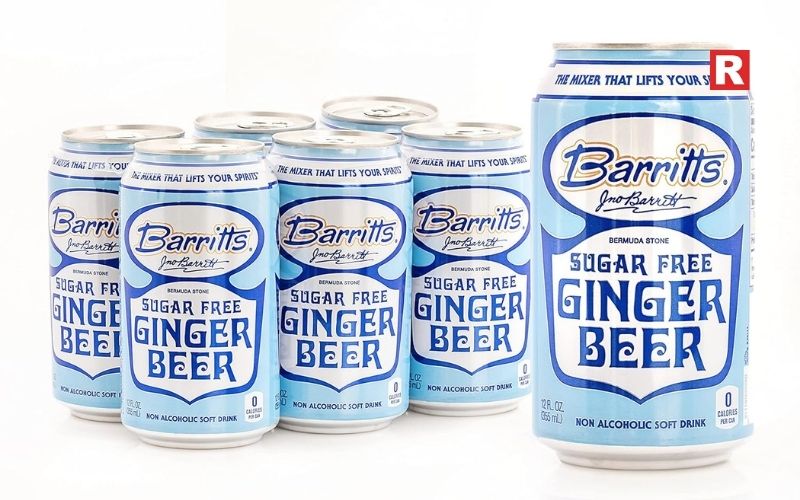
Barritts comes straight from Bermuda and has a long history as the go-to mixer for Dark ’n’ Stormy. You can get it in India through importers and online shops. It’s a bit sweeter with good fizz. Just the classic stuff. It is zesty ginger, rounded in the middle, and ends with a refreshing finish. Rum cocktails and classic Mule recipes can make good use of this brand.
5. Q Mixers
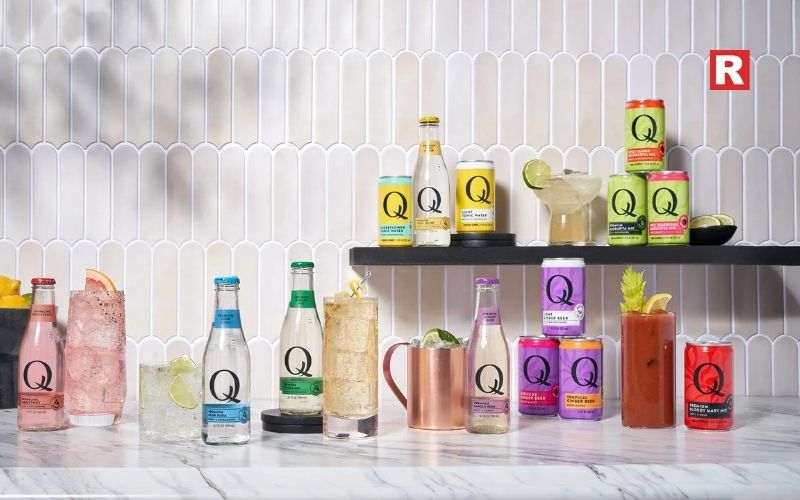
Q Mixers is all about letting the spirit shine, which means less sugar, high carbonation, and a spicy profile that’s built for cocktails. It’s not a sugary soda; it’s a mixer. It has a focused ginger spice, sharp bubbles, and is not syrupy at all. Use it for premium cocktails where you want the ginger to play nice with your liquor, not take over.
6. Maine Root

Maine Root’s Ginger Brew is famous for its “wicked” spicy kick, all thanks to organic cane sugar and loads of ginger. If you want a drink where the ginger’s taste is unmistakable, this brand is the best for it. It has a strong ginger heat, is sweet from organic sugar, and is fully satisfying. Best for when you want to get some spicy cocktails or just a sip when you want something with serious character.
What's new: Top 20 Trendy Whiskeys You Must Try Once
7. Gunsberg

Gunsberg is one of the few ginger beers you’ll spot on everyday grocery apps like BigBasket, Zepto, and Swiggy Instamart. It’s affordable, ready to drink, and packs just enough of a ginger kick. If you’re mixing at home or just want something simple, this is a good choice. You can taste a tangy ginger flavor, a bit of heat, and a nice, approachable sweetness. Try whipping up a quick Moscow Mule at home or pairing it with spicy snacks. You can get a great drink by mixing at home.
8. Sepoy & Co (Sepoy Drinks)

Sepoy & Co. is an Indian mixer brand that markets its Himalayan water and natural ginger. They aim for a craft vibe, using local ingredients. If you want a ginger mixer that’s made in India and designed for cocktails, this is the one to try. It has a clean, fresh ginger flavor with less sugar. Think of it as a premium Indian mixer for your gin or vodka mules, or for mocktails.
9. Top Note

Top Notes’ ginger beer uses date sugar and dark sugar, giving it a richer, almost molasses-like taste. Bartenders like it for its complexity. So it is not your average soda. It is also a good choice when you want your drink to stand out. It has deep, sweet flavors from date and cane, layered with bold ginger spice. Mix it with dark spirits, specialty mocktails, or anytime you want a mixer with real depth.
10. Le Tribute

Le Tribute is a European brand, but they use Indian ginger and process it with a cold technique for extra punch. If you like your ginger beer fiery and full of character, grab this one. It is spicy, zesty ginger with a big, bold root flavor and a hint of lemon. Anyone chasing that super-spicy, true ginger kick can truly appreciate the beauty of this brand.
Check out: What’s The Difference Between Single Malt, Whiskey, And Scotch?
The Spirit of Cocktails: What’s Trending in Vodka Biz
Mixing tips & food pairings
- Moscow Mule: For a classic Moscow Mule: vodka, lime, loads of ice, and ginger beer. If you want it punchy, go for spicier brands like Fentimans or Fever-Tree.
- Dark ’n’ Stormy: Just dark rum and ginger beer—Barritt’s or Old Jamaica works great.
- Non-alcoholic: Going non-alcoholic? Add soda, mint, and citrus to ginger beer for a refreshing mocktail. Milder ginger beers like Gunsberg are perfect here.
- Food pairing: The best pairing with ginger beer is grilled seafood, tandoori, and spicy street food. It cuts through the oil and lets flavors shine.
Final notes on buying in India (availability & pricing)
Most grocery apps (BigBasket, Zepto, Blinkit, Swiggy Instamart) carry value and mid-range ginger beers like Gunsberg and Old Jamaica. For the fancy imports like Fever-Tree, Fentimans, Q, or Maine Root, try Amazon, Ubuy, Desertcart, or cocktail specialty shops. Imported stuff will cost more, thanks to import charges.
Label tips: If you want real ginger, check for phrases like “made with real ginger,” “botanically brewed,” or “contains real ginger juice/root extract.” There are also more low-sugar and naturally sweetened options now, so peek at the nutrition info if that’s important to you.
Learn more: World's 10 Most Expensive Alcohols — And Why Billionaires Love Them
Where To Start
Ginger beer in India isn’t what it used to be. What started off as a few imported brands has exploded into a mix of local craft bottles, global favorites, and something for every taste. Whether you’re looking up a Moscow Mule, pouring a mocktail, or just drinking it ice-cold straight from the bottle, ginger beer adds a real kick to your taste buds.
It’s easy to get your hands on a few bottles online these days, and people are really starting to appreciate drinks with natural spice and character. Ginger beer isn’t just another drink; it has carved out its own spot in India’s ever-growing beverage lineup. Sweet or sharp, smooth or fiery, there’s something for everyone. So go ahead, try a few. You might just find your new favorite pick.

Stretching over 7,500 kilometers, India's coastline serves up a crazy range of flavors that are as diverse as the seas themselves. From Goa's sun-kissed beaches to Kerala's ethereal backwaters and right up to Bengal's congested river deltas, there's a dish for every fish lover. Every beach location adds its own twist to the ocean's food: creamy coconut milk curries, flavorful gravies spiced up with mustard or tamarind, or fish grilled until it's smoky and fragrant.
For people living along these shores, seafood isn’t just dinner, it’s woven into their daily life. Centuries-old fishing traditions, influences from the spice trade, and whatever the land yields all shape how people cook and eat. Whether you’re biting into spicy Andhra prawns or savoring the gentle creaminess of Odisha’s malai curry, every mouthful tells a bit of the local story: about the weather, the people, and their craft.
Ready to take a coastal food tour? Here are 10 must-try dishes for anyone obsessed with seafood.
Read more: A Seafood Lover’s Delight: The Best Squid Dishes to Try
A Quick Look at India’s Coastal Flavor Map
Before we dig into the actual dishes, let’s get our bearings. Here’s how these different coastal flavors break down:
West Coast (Maharashtra, Goa, Karnataka, Kerala):
People here love their coconut gravies, bold spices, and a hit of sourness from kokum. The curries here tend to be rich and tangy, and you’ll usually find them with steamed rice or neer dosa.
East Coast (Odisha, Andhra, Tamil Nadu, West Bengal):
Mustard oil, curry leaves, and tamarind rule the food scene here. Dishes strike a balance between their flavors, there’s tang, heat, and always freshness. Mustard or coconut milk gravies pop up a lot in their food.
Islands (Andaman & Nicobar, Lakshadweep):
Think of tropical seafood like grilled lobster, fresh fish, and spice mixes that borrow flavor from both South and Southeast Asia. Put all these together, and you get a wild range of seafood flavors, from full-blast fiery to elegantly sweet, rustic to royal.
Know more: Seafood: 5 Crab Dishes You Must Try
10 Iconic Seafoods of Coastal Areas
1. Goan Prawn Curry
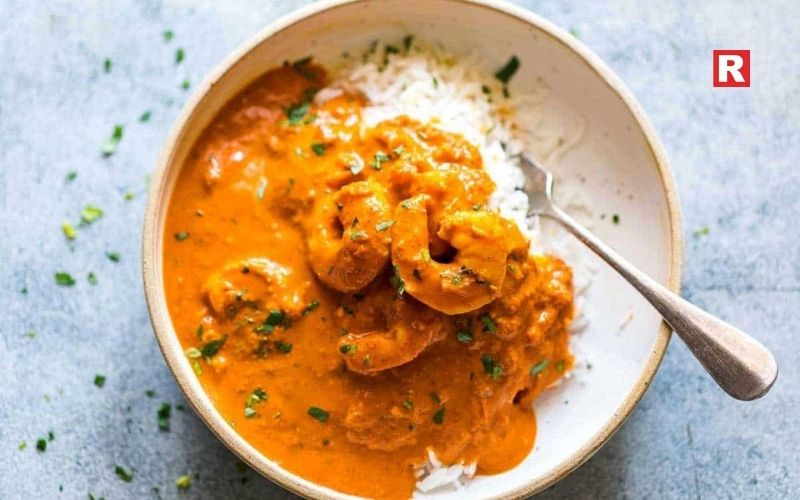
Ambotik or prawn curry is a dish that defines Goa. It’s made from coconut milk, kokum for a punch of tang, and a ground masala loaded with red chilies, garlic, coriander, and turmeric. The result is a creamy, spicy curry with just the right amount of sour.
People usually eat it with steamed rice or fluffy sannas (soft rice cakes). The scent of coconut and spice, all mixed, takes you straight to a Goan kitchen. The coconut milk perfectly balances the heat, and the choice of kokum rather than tamarind gives it a uniquely coastal flavor.
Signature vibe: Comforting, creamy, a little spicy, and bright with tang.
2. Kerala Meen Curry

Kerala’s Meen Curry (sometimes called Red Fish Curry) doesn’t hold back on spice. It’s fiery, packed with flavor, and totally comforting. Traditionally, they cook it in an earthen pot, letting chunks of fish like seer or sardine simmer away in a blend of red chili, turmeric, tamarind, and fresh curry leaves.
Coconut oil gives its signature aroma, and the clay pot gives it a rustic, earthy depth. Every family has their own twist that adds to the dish. Some roast the spices, others smooth things out with coconut milk.
Best with: Steamed rice or pillowy appams.
How it tastes: Spicy, earthy, and tangy, all at once.
3. Mangalorean Fish Gassi

Head north up the coast and you’ll find Karnataka’s Mangalorean Fish Gassi, a dish that creates the balance between spice and creaminess. The curry gets its body from grated coconut, roasted red chilies, coriander seeds, garlic, and tamarind, all mashed into a thick, fragrant paste.
They usually use fish like mackerel or pomfret, letting the fish simmer in the masala until it soaks up every bit of flavor. It’s vibrant, spicy, and it will give you a taste of the ocean.
Why it’s a classic: It’s just like coastal Karnataka on a plate, loaded with masala magic.
Best with: Neer dosa or red rice.
4. Bengali Fish Paturi
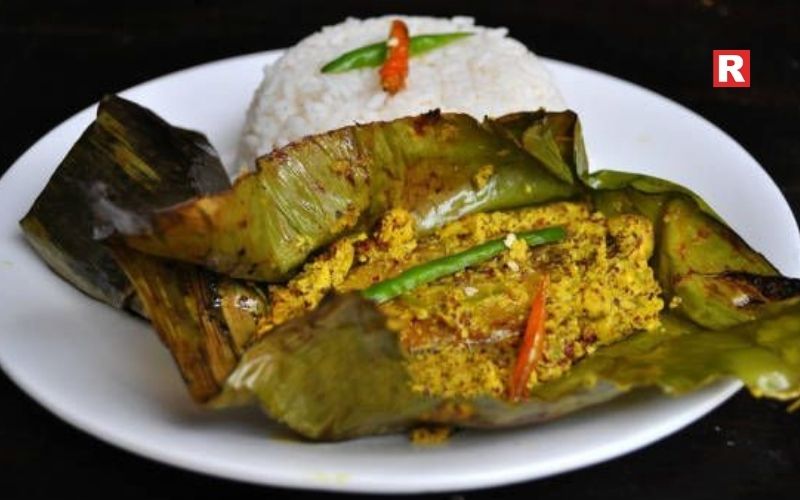
Welcome to Bengal, where fish isn’t just food, it’s an obsession. Bhetki or Hilsa Paturi is a classic among them, transforming humble ingredients into something special. Fish fillets get slathered with a sharp mustard, green chili, and turmeric paste, then wrapped up in banana leaves and steamed or pan-grilled.
The banana leaf adds a subtle smokiness and keeps the fish juicy. Every bite is soft and delicate with a bold mustard kick to it.
Texture: Silky, fish that melts in your mouth with a punch of mustard spice.
Best with: Plain white rice and a squeeze of lime.
5. Andhra Royyala Iguru (Prawn Masala)

Andhra’s coastline is famous for heat, and Royyala Iguru proves it. This thick prawn curry is made with onions, tomatoes, garlic, and a special Andhra spice mix that makes the dish hot but still lets the sweetness of the prawns shine.
Keep in mind that it’s not a watery curry. This is more chunky and semi-dry, perfect alongside ghee rice or flaky parottas.
Why it’s a classic: Spicy, aromatic, and just hits the spot.
Ideal for: Anyone who can handle the spicy heat and craves bold flavors.
What's new: 8 Bengali Vegetarian Dishes You Won’t Believe Are This Flavorful
6. Malvani Fish Curry

If you ever find yourself on Maharashtra’s Konkan coast, you’ll see why locals recommend Malvani Fish Curry. This dish is full of flavors, thanks to the region’s signature Malvani masala, which is a bold mix of dry coconut, coriander, cumin, red chili, and a splash of kokum for a tangy kick.
And the type of fish? Take your pick: pomfret, surmai (kingfish), or bangda (mackerel), they all work wonderfully in the curry. What you end up with is a spicy, tangy curry that just asks for steamed rice or a soft bhakri on the side.
Distinctive flavor: Mild coconut sweetness balanced by kokum tang.
Try it at: Malvan, Sindhudurg, or any Konkan seaside eatery.
7. Chettinad Crab Masala

Chettinad cuisine from Tamil Nadu doesn’t hold back on flavor and spice. Black pepper, fennel, and curry leaves, these people know their spices. Chettinad Crab Masala is a total showstopper. Fresh crab, onions, tomatoes, and a heap of freshly ground spices come together in one fiery, aromatic dish.
You’ll smell it before you see it, and your mouth will start watering. The black pepper and garlic bring the spicy heat, but it’s never just spicy for the sake of it. There’s balance here, and every bite tells a story of Tamil Nadu’s spice-loving roots.
Taste profile: It’s bold, peppery, and loaded with aroma.
Ideal with: Grab some hot rice or flaky parotta and dig in.
8. Odisha’s Chingudi Malai Curry
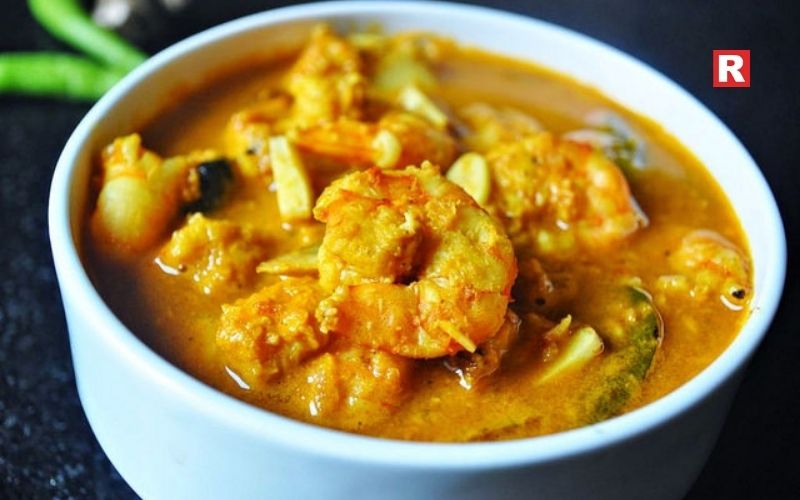
Some dishes just feel like a warm hug, and Chingudi Malai Curry from Odisha and Bengal is one of them. “Chingudi” means prawns, “malai” is coconut milk, and together, they make a curry that’s silky, creamy, and rich.
Here, prawns simmer in a sauce of onion, ginger, garlic, and garam masala. And the result is a gentle spice, lots of fragrance, and a flavor that’s more about comfort than heat.
Why it stands out: The perfect harmony of creaminess and spice.
Ideal with: Steamed basmati rice.
9. Konkani Bangda Curry

In the Konkan, bangda (mackerel) is king. Konkani Bangda Curry is simple to make. Just use ingredients like fresh coconut, red chilies, tamarind, and a touch of methi (fenugreek). But the game-changer is those roasted spices, which add a smoky depth you can’t miss.
This curry shows up the Konkani way of making food: keep it simple, let the flavors do the heavy lifting. Each bite hits with spice, but the coconut smooths it out. It’s spicy, tangy, and full of character.
Flavor profile: Spicy, tangy, and fragrant.
Ideal with: Boiled rice or solkadhi (kokum drink).
10. Andaman Grilled Lobster

Don’t forget to visit the Andaman Islands, where the seafood is as fresh as the sea breeze. The Grilled Lobster here is pure and simple pleasure. Lobster IS brushed with buttery garlic and local herbs, then grilled over charcoal until it’s smoky and juicy.
This dish doesn’t need much. The lobster’s sweetness shines naturally, with just a squeeze of lemon and maybe a dab of coconut chutney on the side.
Why it stands out: Showcases pure seafood flavor with minimal seasoning.
Best enjoyed: At seaside cafés overlooking the turquoise waters.
Check out: How to Train Your Staff to Spot Bad Seafood in Five Easy Steps
Why Fish Kobiraji Is a Must-Try for Every Food Lover in Kolkata
Key Ingredients That Define Coastal Indian Seafood
- Coconut: It adds creaminess to most seafood curries in the West and South.
- Mustard and poppy seeds: They are essential for Bengali and Odia recipes.
- Kokum and tamarind: They add that punchy tang you’ll find along the Konkan and down south.
- Curry leaves and black pepper: This turns up the aroma and spice of the food.
- Seafood Staples: As for the seafood itself, pomfret, kingfish, prawns, crabs, sardines, and hilsa are the stars of the coast.
All these ingredients come together because of India’s long, fertile shorelines and spicy, tropical heart.
Cooking Styles & Traditions Along the Coast
Coastal kitchens have their own tricks. Steaming fish in banana leaves (like Paturi) keeps things moist and fragrant. Earthen pots, especially in Kerala and the Konkan, add an earthy flavor you can’t get anywhere else. Coconut-based gravies are thick, rich, and everywhere. And island cooks love their charcoal grills for that perfect smoky finish.
And don’t forget homemade masalas. Every family guards its own blend. This is the secret behind those unforgettable flavors.
Tips for Seafood Lovers in India
Where should you eat? In Goa, hit the beach shacks at Baga or Anjuna. Kerala’s houseboats in Alleppey serve up the freshest catch. Bengal has its “pice hotels” for real-deal fish thalis. If you’re on the Konkan coast, Malvan and Ratnagiri are known for homestyle curries.
When buying seafood, look for clear eyes and firm flesh. If it smells fishy, walk away. For the sake of the oceans and the folks who rely on them, choose local, seasonal fish. It’s better for everyone.
Learn more: Fish Thali in Panjim: Goa’s Most Beloved Plate of Culture and Business
A Feast by the Sea
Every different part of India’s coastline brings something different to the plate. Chettinad showers you with black pepper heat, while Odisha goes gentle with coconut. All together, these dishes are more than just food, they’re pieces of India’s coastal soul, shaped by geography, tradition, and generations of home cooks. If you love seafood, or even if you’re just curious, trying these coastal classics is the best way to taste the heart of India.

From minimum effort instant sachets to super hit organic bean culture, India’s relationship with coffee has evolved through the ages. These days, Indian homes are well-stocked with coffee — Arabicas sourced from estates, specialty beans, and locally roasted tiny micro-lots. Plantations in Karnataka, Tamil Nadu, Andhra Pradesh, and other states that create robust beans have brought a variety of flavors and ethical sourcing choices to the Indian coffee lover.
This article features 10 of the best coffee beans in India in 2025, and information about their flavors, brewing methods, and other traits that set these brands apart.
Why Choosing the Right Coffee Bean Matters
What makes a cup of coffee stand out? There are a few things that come into play.
- Origin & Altitude: First, where and how the beans grow matters a lot. Beans from higher altitudes usually pack more interesting flavors. In India, types like Kent, Agaro, and CxR really shine for their unique taste.
- Bean Species: Arabica gives you a smooth, fragrant cup with lots of layers, while robusta has a harder, bolder flavor and more caffeine.
- Processing & Roast: Washed, natural, or honey processing each brings out different flavors, and the roast—light, medium, or dark—shapes the body, acidity, and intensity of your coffee.
- Freshness: Coffee tastes best when the beans are freshly roasted. Wait too long, and you lose that burst of flavor and aroma.
- Ethics and Sustainability: How the beans are sourced matters a lot. Fair pay for farmers, direct trade, backing small farms, and sustainable methods—these all matter to a lot of Indian roasters right now.
So, when you pick good beans, you’re not just getting a better cup. You’re also helping push coffee growing in the right direction.
Read more: India’s Coffee Rise: Brewing a Global Identity
Key Factors to Consider Before Buying
Before you start checking out brands, keep a few things in mind.
- Roast Level: Dark roasts pack a punch. They’re bold, a little chocolaty, sometimes smoky—great for espresso or anything with milk. Medium roasts? They find that sweet spot between flavor and body. Light roasts really let the bean shine, so you get those fruity or floral notes coming through.
- Grind Size & Brewing Method: Match your grind to your gear. Go coarse if you’re using a French press or making South Indian filter coffee. Medium works for pour-overs. For espresso, you want it fine. And yeah, the roast you pick changes what brew method will work best.
- Whole Coffee vs. Ground: Grind your beans right before you brew. It really makes a difference in taste and smell. Whole beans also stay fresh longer than pre-ground.
- Indian Origin Regions: If you’re curious about origins, check out beans from Araku Valley, Wayanad, Chikmagalur, or Coorg. Each place brings its own character to the coffee.
- Single-Origin vs. Blends: Single-origin beans show off what’s special about one estate. Blends, on the other hand, balance things out and make the flavor more consistent.
So, keeping all this in mind helps you pick coffee that actually fits what you like.
The 10 Best Coffee Bean Brands Of India
1. Blue Tokai Coffee Roasters

Blue Tokai helped kick off India’s specialty coffee market. Based in New Delhi, they get their beans straight from reliable estates in Chikmagalur, Coorg, and Shevaroy Hills. That way, you know every roast is fresh and traceable. Their lineup covers everything, from fruity light roasts to bold dark ones, you name it. Espresso, pour-over, French press; whatever your style, they’ve got something. The flavor really depends on which estate the beans come from and how they’re processed. Sometimes you get hints of chocolate, sometimes almonds or citrus. Each cup stands out in its own way. A 250 g box is priced between ₹450 to ₹750. If you care about ethical sourcing and craft roasting in India, Blue Tokai is the standard.
Know more: Sip Like a Pro: 8 Coffees Every True Coffee Lover Must Try
2. Third Wave Coffee Roasters

Third Wave Coffee Roasters, based in Bengaluru, stands out in India’s specialty coffee scene. They’ve become a real symbol of the country’s new wave of coffee culture. What sets them apart? They source micro-lots from local estates in Chikmagalur and roast the beans in small batches, so every bag keeps its own unique flavor. Their coffee’s known for a clean finish, bright fruity acidity, and a touch of caramel sweetness. Everything feels nicely balanced. If you’re into espresso, they offer some heavier roasts. Prefer pour-over or AeroPress? Their medium-light roasts hit the spot. Prices for their fresh beans usually fall between ₹450 and ₹700 for a 250g pack, depending on the blend.
3. Araku Coffee

Araku Coffee comes from the green hills of the Araku Valley in Andhra Pradesh, where tribal farmers grow their beans using organic and biodynamic methods. They’re part of the SAMTFMACS cooperative, which backs over 11,000 farmers and makes sure everyone’s treated fairly. Araku has built its name on sustainability and fair trade, not just good coffee. You’ll usually find their beans lightly roasted, which brings out these gentle hints of fruit, flowers, and chocolate. Perfect for a drip or filter brew. The coffee itself is smooth and balanced, with a nice, lively acidity that works for both new tasters and die-hard coffee lovers. A 250-gram pack is priced between ₹550 and ₹800, depending on the blend and where you buy it. While most of their beans are light roasts, you’ll spot some medium and dark options too. Araku Coffee is all about doing things right, ethically and with a lot of care.
4. Black Baza Coffee Co.

Black Baza Coffee isn’t just another brand—it’s a whole movement. They team up with small farmers and forest folks in Karnataka, pushing for farming that’s good for wildlife and the planet. The beans grow in the shade of local trees, so you get these earthy, cocoa, and nutty vibes in every cup. It works great in a South Indian filter or a French press. They roast their beans medium to dark, so you taste that rich comfort without much bitterness. At ₹400–₹650 for 250 grams, Black Baza is for those who value sustainability as much as flavor.
5. KC Roasters by Koinonia

KC Roasters is a boutique coffee roaster tucked away in Mumbai, but their coffee packs a serious punch. They go out of their way to find top-notch beans from places like Chikmagalur and Kerehaklu down south, and you can taste the difference. These folks know how to roast their beans. They’re aiming for those bold, chocolatey notes, with a little almond, cocoa, and caramel thrown in for good measure. If you’re into espresso, moka pot, or French press, their medium and dark roasts really shine. KC Roasters keeps things fresh by roasting in small batches every day and sealing the beans up in biodegradable bags. For a 340g pack, you’ll pay between ₹550 to ₹900, depending on the blend. The whole mood is about careful sourcing, excellent roasting, and sustainable practices — all to provide you with café-level coffee at home, whether you're a die-hard coffee fan or just want a good cup to start your day.
6. The Flying Squirrel
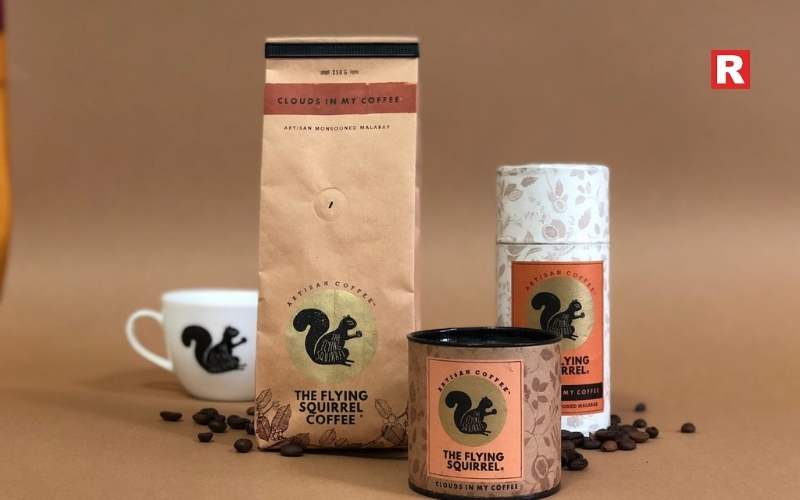
The Flying Squirrel stands out as one of India’s most iconic estate-based coffee brands, and it comes straight from Coorg. Each blend has its own personality. Take “Sattva”—it’s clean, fresh, and light. Then there’s “Deep Bliss,” which goes bold and dark for people who love a strong espresso. They grow their coffee under shade and let the beans dry naturally, which really cranks up the flavor. Depending on the blend you pick, you’ll catch hints of cocoa, earthy undertones, and a bit of smokiness. For ₹450 to ₹700 per 250g pack, The Flying Squirrel really nails what Indian specialty coffee is all about.
What's new: Top 10 Tea Brands in India That Every Chai Lover Swears By
7. Halli Berri
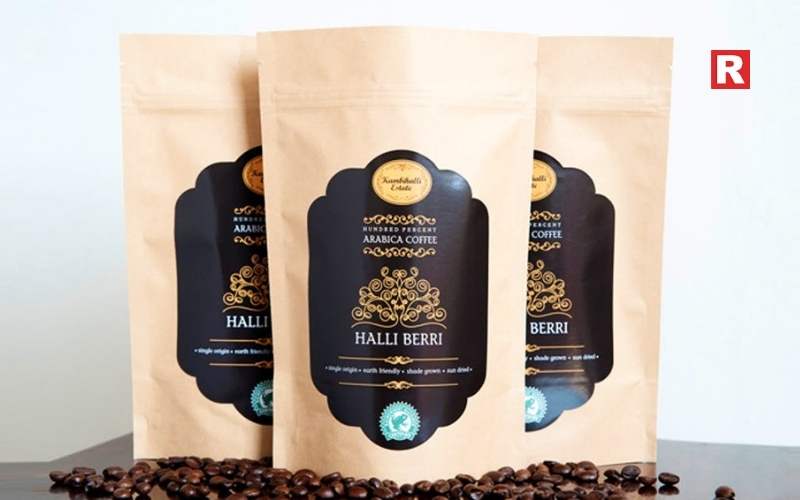
Halli Berri, a women-led brand from Chikmagalur that’s all about sustainable farming and keeping things transparent, from their estate right to your cup. Their family-run plantations produce beans that are naturally sweet and medium-bodied, with nutty, chocolatey flavors and just a little acidity. Their medium roast beans work great for both filter and drip brewing—what you get is a cozy, smooth cup every time. Halli Berri isn’t just about good coffee; they put real effort into supporting women in the industry and protecting the land. You’ll usually find their beans priced between ₹500 and ₹700 for 250g.
8. Subko Specialty Coffee Roasters
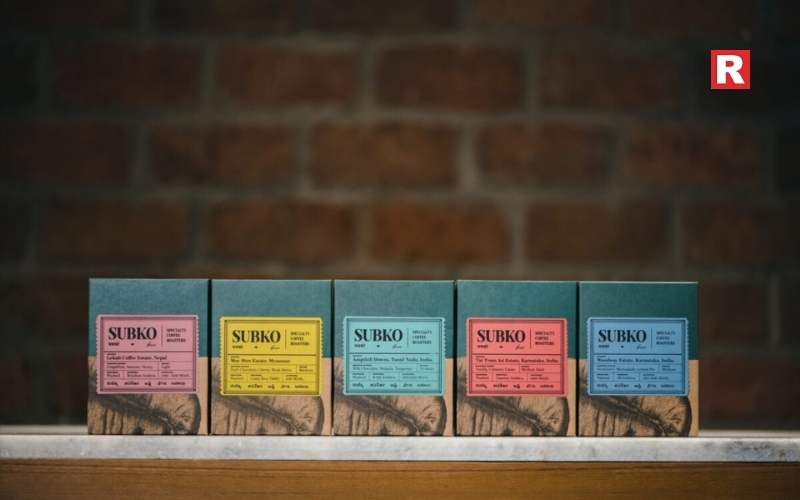
Subko, straight out of Mumbai, is leading the charge in India’s new coffee scene. They hunt down beans from tiny Indian estates, and sometimes team up with growers abroad, all to bring out flavors you don’t usually find here. Think berries, citrus, that bright, zippy kind of taste, but there’s always a bit of cocoa underneath to keep things smooth. They stick to light and medium roasts, which suit pour-overs and drip coffee perfectly. Yes, Subko’s coffees cost a bit more (₹600–₹1,000 for 250 g), but fans swear by their attention to detail and the layered flavors in every cup.
9. Sleepy Owl Coffee

Sleepy Owl set out to make good coffee easy for everyone. They get their Arabica beans from Chikmagalur and are famous for those ready-to-brew cold brew packs and ground coffee. If you’re into manual brewing, they’ve got fresh beans for that too. Their medium roast is naturally smooth, chocolatey, and doesn’t have that sharp acidity—so you can drink it black, no need for milk or sugar. It’s a great pick if you’re just moving on from instant coffee. Sleepy Owl nails both quality and convenience, and their prices (₹400 to ₹600 for 200 g) make it easy to try.
10. Tata Coffee (Grand Premium Beans)

Tata Coffee is a classic name in India, but they’ve updated their vibe with the Grand Premium Bean range. These beans mostly come from Coorg and Chikmagalur, roasted just right to bring out earthy, nutty flavors with a hint of spice. Tata’s deep roots in estate management mean you get the same reliable taste and freshness, cup after cup. If you love filter coffee, this is a safe bet—affordable too, at ₹350–₹500 for a 200 g pack. No wonder so many Indian homes stick with Tata.
Check out: Top Tea & Coffee Brewer Brands in India These Days
The Secret Health Benefits of Matcha Tea You Probably Didn’t Know
Recommended Coffee for Different Preferences
Here’s how to choose a coffee according to your preferences, depending on what you’re into:
- For beginners: If you’re new to coffee, start with a medium roast. You’ll get a nice, smooth balance; something like TEACURRY or a medium roast from Blue Tokai works well.
- For espresso machine users: Got an espresso machine at home? Go for a dark roast with some punch. Seven Beans does a solid Italian-style one, or try a Vienna roast from Blue Tokai.
- For filter or French press: Single-origin and light-to-medium roasts from places like Third Wave or Araku really let the flavors shine through.
- For cold brew lovers: If cold brew is your thing, look for beans with a fuller body and less acidity. Dark roasts or chocolatey microlots (think Subko or some specialty Blue Tokai releases) are a good call.
- For ethical/sustainable focus: Subko, Black Baza, and Araku all focus on direct trade and working with local communities.
Honestly, the best way to figure out what you love is to experiment across these brands. Try different styles, and you’ll start to get a feel for what suits you.
The Rise of Indian Specialty Coffee
India isn’t just drinking more coffee; it’s growing some great beans too. The Coffee Board of India points out varietals like Kent, Agaro, and CxR, which have a lot of natural quality going for them. Roasters here are teaming up with farmers, keeping a close eye on the supply chain, roasting fresh, and sharing the stories behind each bean. Blue Tokai, for example, works with over 80 farms. Thanks to all this, Indian coffee can hold its own on the world stage. Plus, more people are brewing at home, cafes are popping up everywhere, and local farmers are getting a real boost.
Where to Buy & Store the Beans
- Where to buy: You can usually grab these brands online, and some show up on delivery apps or at your neighborhood café. Blue Tokai, for example, lets you subscribe and delivers straight to your door.
- Storage tips: After you open the bag, toss your beans into an airtight container and keep them away from light, heat, and moisture. Grind them right before you brew for the best flavor.
- Freshness: Look for bags with the roast date on them. Fresh beans taste better, and their flavor fades if they sit around too long.
- Brewing gear: Choose the right setup, French press, pour-over, or espresso machine, and match your grind size and roast to your method. That’s how you get the best cup.
Learn more: 10 Tibetan Dishes That Will Warm Your Soul
Your Next Great Cup Awaits
India’s coffee game has come a long way. It’s not just about filter coffee anymore—now you’ll find roasters pushing boundaries with specialty beans, wild flavors, and a ton of options. Maybe you’re new to all this and just want a solid medium roast. Or maybe you’re deep into the world of microlots and funky processing methods. Either way, you’ll find something worth sipping.
So go ahead, try one of these brands, play around with your brewing style, and see what you like. Who knows, your new favorite cup might be right around the corner.

One of the most geographically and climatically challenging regions of the world, Tibet, is a place with food that will warm your heart completely. Often called “Roof of the World,” the Tibetan people survive in a high-altitude environment. This has led to the creation of a cuisine that is simple, sustainable, and still heartwarming. So, forget any fleeting flavors, Tibetan food is designed to be adaptable.
Tibetan cuisine is not something with exotic spices or complex preparations, but it surely has the top three elements of its homeland: barley, yak meat, and dairy. Every dish here has a more important purpose than just fulfilling your taste buds. The food here is made to fuel your body against the bone-chilling cold and to offer a deep comfort that can truly warm your soul.
If you want to visit Tibet and gain a deep understanding of its culture, then you definitely need to try its authentic cuisine. This article serves as a guide, introducing 10 Tibetan dishes that can be found here. So, prepare to go on a journey where every bite you take will give you a taste of Tibet.
Read more: 10 Authentic French Cuisine Dishes You Must Try
Main Ingredients of Tibetan Cuisine
Tibetan cuisine stands out because of the ingredients' ability to withstand the harsh, high-altitude climate of the plateau. There are three key ingredients used heavily in Tibetan cuisine:
- Highland Barley (Yarlung Tsampa): The ultimate staple of Tibetan Cuisine is Highland Barley (Yarlung Tsampa). It is the foundation of the diet, roasted and ground into a flour known as Tsampa, which provides long-lasting energy and is frequently consumed with butter tea.
- Yak and Mutton: Meat is a crucial source of calories and protein because agriculture is limited. The most popular meat is yak meat (which is chewy and lean). It is also used in stews, soups (Thukpa), and dumplings (Momos).
- Dairy (Yak Cheese and Butter): The female yak (dri) is an essential source of milk products. Dried curds (chhurpi) serve as a tough, durable protein source, and yak butter is added to the classic salty Po Cha (Butter Tea) for warmth and vitality.
The 10 Tibetan Dishes You Need to Try
1. Thukpa

The foundational term for Tibetan noodle soup is Thukpa. It is the highest state of comfort and can be found in every home, teahouse, and monastery.
What Makes Thukpa Soul-Warming: The dish is known for its flavorful, light, slow-cooked bone broth, which is typically made from yak or mutton. It contains shredded meat and simple, high-altitude vegetables like radish, cabbage, and occasionally spinach.
Cultural Significance: It represents the region's warmth and nourishment since it is a full meal in a single bowl. It serves as a vital barrier against the cold and is frequently the first and last meal of the day.
2. Thenthuk
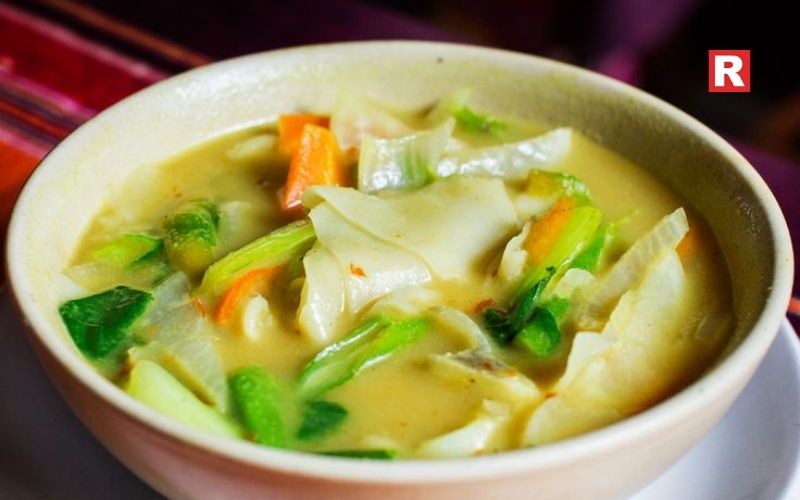
Thenthuk is a noodle soup made with hand-pulled noodles, unlike Thupka, where the noodles are pre-made.
What Makes it Unique: The noodles steal the show. Thenthuk uses flat, hand-pulled or hand-ripped pieces of dough that are dropped straight into the simmering broth, as opposed to the round, expanded noodles of basic Thukpa. As a result, the noodles have a deliciously chewy, uneven texture.
The Experience: Creating Thenthuk is frequently a group activity that strengthens ties within the family. Because it provides a heavier, more filling meal during the bitterest winter months, its thick broth and chewy texture make it especially popular.
Know more: A Close Look at Goa's Diverse Cuisine
3. Mokthuk

Momos and thukpa, the two most popular dishes in the area, are skillfully combined to create mokthuk.
What Makes It a Fusion: This dish consists of smaller momos (dumplings), also known as tsi-tsi momos, that are immersed in a flavorful, transparent soup broth.
Best for the Soul: It combines the warming, rehydrating properties of the broth with the rich, meaty satisfaction of momos. It's a great, well-balanced lunch or dinner because it's lighter than consuming an entire plate of steamed momos.
4. Momo
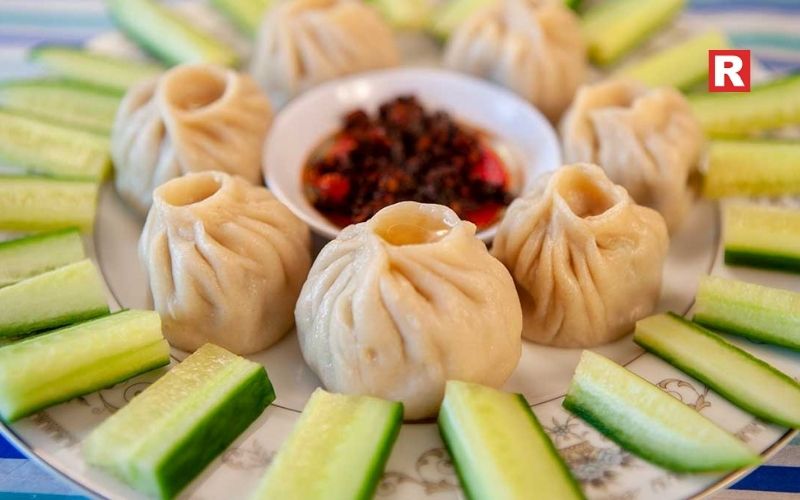
Momo is the most well-known Tibetan export and a genuine representation of Himalayan cuisine.
The Perfect Filling: While seasoned yak or mutton is the traditional filling, modern versions frequently use beef, chicken, or a strong vegetable mixture (such as cilantro, onion, and cabbage). The main feature of these momo is the meat juice that is released during the steaming process.
Serving and Sauce: Although steamed momo are the most popular, fried (Kothey or C-Momo), and souped (Mokthuk) varieties are also well-liked. Sepen, a spicy, vibrant red tomato-chili dipping sauce, is always served with them.
Cultural Connection: Families get together to fold hundreds of dumplings for feasts and festivities, which makes preparing momo a social occasion.
5. Sha Phaley (Shabhaley)

Sha Phaley is a tasty fried pastry which directly translates to "meat bread".
The Comfort Factor: A round or semi-circular dough pocket is filled with a savory, minced meat filling (typically beef or mutton combined with onions and cabbage) and deep-fried or pan-fried until crispy and golden brown.
Why It Warms the Soul: It offers a satisfying balance between a hot, juicy, and savory interior and a crispy, slightly chewy exterior. Often served for lunch, it is a perfect portable snack or meal.
What's new: 10 Famous Non-Vegetarian Dishes of Lucknow That Define Royal Awadhi Cuisine
6. Tsampa
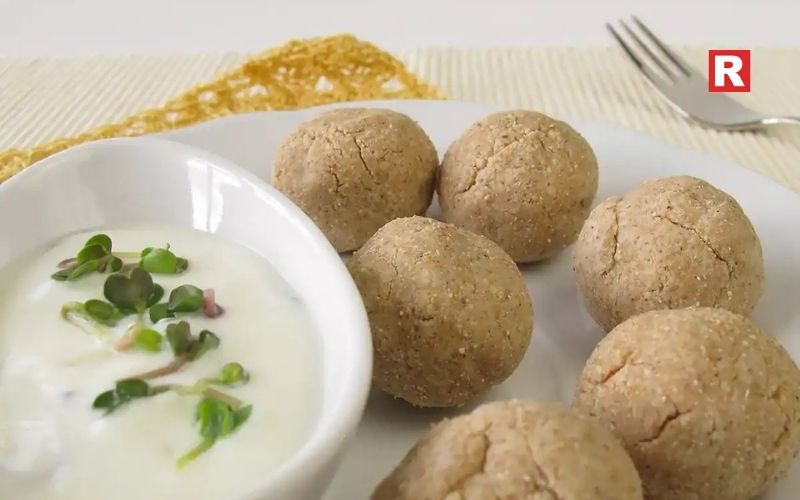
Perhaps the most important dish in the Tibetan diet is Tsampa, which represents their close connection to the land and tenacity.
Tsampa: It is a type of flour made from roasted highland barley. It is the most convenient food for travelers and nomads because it doesn't need to be cooked, since it has already been roasted.
How to Eat It: Traditionally, a wooden bowl is used to manually combine a pinch of tsampa, a few spoonfuls of butter tea, and crumbled dry cheese (Chhurpi). The dough ball, known as Pa, is created by kneading the mixture and is later consumed. A filling, high-energy, and incredibly portable meal can be made with this easy preparation method.
Cultural Connection: Tsampa has great importance in Buddhism and is frequently thrown into the air as a good-luck gesture during Buddhist ceremonies and rituals.
7. Butter Tea (Po Cha)
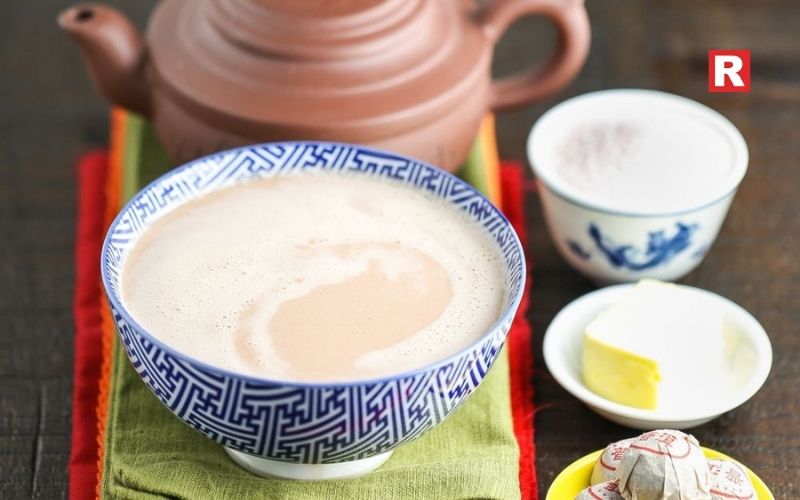
Po Cha is more than just a drink; it's a vital source of nutrients for survival in high-altitude areas.
The Unique Blend: It is a unique blend of salt, yak butter, and brick tea (boiled for hours to produce a powerful extract called chaku), all of which are churned in a wooden churn called chandong. In modern times, a food processor can be used for the churning process.
Why it's a Soul Warmer: Yak butter gives the body a huge boost in calories and fat, which is essential for insulation and long-lasting energy. In the severe weather of the area, the fat also helps avoid dry lips and cracked lips. It is a regular, calming companion that is always served hot.
Customs of Hospitality: When a guest is served Po Cha, the host regularly refills the bowl after each sip to guarantee the guest's cup is never empty as a custom of hospitality.
8. Shabta
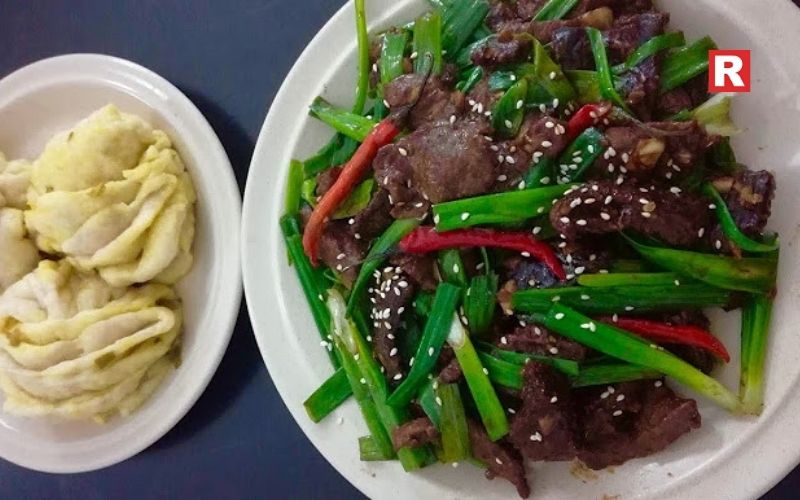
Shabta is a tasty and vibrant stir-fry that serves as a refreshing substitute for soup.
The Flavor Profile: It consists of thin marinated meat slices (yak or mutton) stir-fried with tomatoes, bell peppers, onions, and a lot of fresh green chilies.
Pairing: Tingmo's (steamed bread) bland, fluffy texture is the ideal match for Shabta's richness and spice. It's a simple yet powerful dish that showcases the Tibetan use of flavorings like garlic and ginger.
9. Tingmo
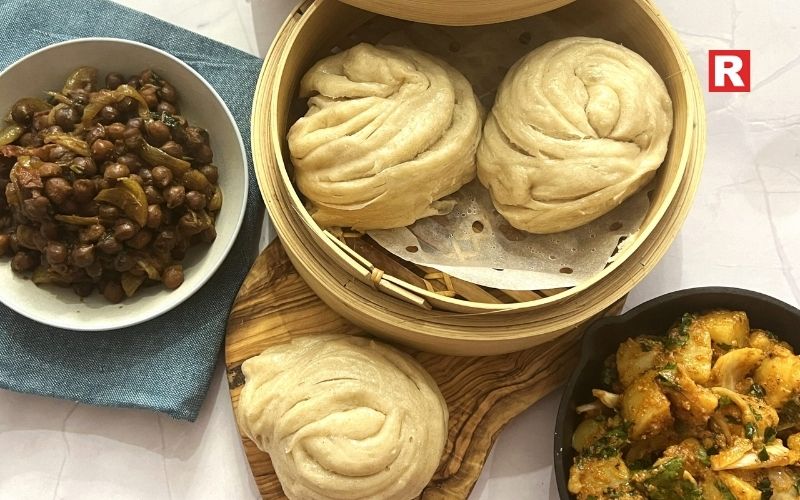
Almost all meat and curry dishes are served with Tingmo, the traditional Tibetan steamed bread.
Simplicity and Function: These are simple, yeast-based steamed buns that have been twisted into beautiful, folded shapes. They are very light and airy and have a hint of sweetness.
How It Warms the Soul: They are intended to be consumed hot, right out of the steamer. To ensure that no flavor is wasted, their fluffy texture is ideal for soaking up the leftover sauces and broths from curries, stews, and Shabta.
Check out: The 7 FSSAI-Approved Food Colors for Indian Restaurants & Caterers
Thai Food: 8 Thai Cuisine Dishes You Shouldn’t Miss
10. Khapse

Traditionally made for celebrating the Tibetan New Year (Losar), Khapse are exquisite, elaborate cookies.
Look and Feel: Made of flour, butter, sugar, and eggs, these biscuits are twisted, ribbon-like, and deep-fried. They vary from basic ribbon twists to enormous, complicated geometric formations called Bungug (donkey ears).
Symbolism: Despite being a sugary treat, their presence represents wealth and good fortune for the upcoming year. They symbolize a time of happiness and community well-being and are widely distributed among family and friends throughout the multi-day Losar celebrations.
The Warmth of Tibetan Cuisine
The warmth found in Tibetan food, which is provided by both heat and vital nutrients, is a survival tactic against the Himalayan cold. This focus on deep, lasting warmth is reflected in its key characteristics:
- Calorie-Dense Staples: The primary food sources are made to provide long-lasting energy. In Po Cha (Butter Tea), yak butter supplies essential fats for insulation and instant warmth.
- Thick Broths: Slow-simmered bone broths (mutton or yak) are served hot in soups like Thukpa and Thenthuk, which hydrate and thaw the body from the inside out.
- Roasted barley (Tsampa): When eaten as a firm dough (Pa), this grain is easily digested and serves as a slow-burning fuel source that maintains a high level of energy in an environment with low oxygen levels.
- Steamed Dough: Steaming preserves moisture and heat in foods like tingmo and momos. They provide hearty, satisfying nourishment and are served hot and fresh.
- Simple Spice Heat: The dishes use warming aromatics like ginger, garlic, and onions in meat dishes and stews to create internal warmth, but the flavor isn't very spicy.
Learn more: 10 Best Street Foods of Mumbai, Maharashtra: Where Every Bite Tells a Story
A Taste of the Pleatues
The extensive dishes of Tibet show that it is more than just a menu; it is a philosophy of the people. It shows how food dishes can be resourceful and nutritious in a place where food is scarce. Every dish, whether it is Po Cha, Tsampa, or Shabta, is engineered to nourish and fill the people.
The plateaus, mountains, and lives of people, along with this extensive menu, will give you a taste of life that you can never find in the busy life of cities. So next time you are tired of your busy city life and want an experience to fulfill your soul, then visit Tibet. Or you can also try making these dishes in the comfort of your home. Whichever it is, you’ll definitely feel warmth from the food.

If you are new to the world of wine, then it can seem a bit vast and intimidating. But fundamentally speaking, the whole range of wine can be reduced to five basic types. And if you want to confidently order wine at a restaurant, choose the ideal bottle to pair with your dish, or just enjoy what's in your glass, it is important to first understand the primary types of wine.
Understanding the basics of the wine world gives you a chance to explore your tastes and preferences. This guide is your chance to do just that. We will provide you with the essential information on the five main wine varieties (Red, White, Rosé, Sparkling, and Fortified). We’ll discuss the grapes used, the typical alcohol content, the distinctive acidity, and the distinctive flavor profile.
By the end of this article, you will end up not just knowing the names of these categories, but also understanding the fundamental science and their distinct flavor profiles. This will transform you from a total novice to a connoisseur in this field.
Read more: 5 Main Types of French Wine You Must Know
Key Differences Between Wine and Other Alcohols
Source Material:
- Wine: Although fruit wines use other fruits, wine is made almost entirely from fermented grapes. The final flavor is mainly determined by the particular grape variety.
- Other Alcohols (Beer & Spirits): Fermented cereal grains, such as barley or wheat, are used to make beer. A fermented source (grains, potatoes, or sugarcane) is distilled to create spirits (such as whiskey, vodka, or rum).
Production Process:
- Wine: Fermentation is the only natural process used in wine. Grape sugars are directly converted to alcohol by the yeasts.
- Beer: Contains hops for flavor and preservation and involves malting (sprouting grains) before fermentation.
- Spirits: Need a further process known as distillation, in which the alcohol is vaporized and then condensed to produce a highly concentrated ethanol.
Alcohol Content (ABV):
- Wine: Generally has a lower ABV, ranging from about 8% to 15% (excluding fortified wines).
- Beer: Typically, the lowest, usually between 3% and 10%.
- Spirits: The highest, rarely dipping below 40%ABV due to the concentration achieved through distillation.
Know more: World's 10 Most Expensive Alcohols — And Why Billionaires Love Them
Five Main Varieties of Wine
Still wine
The most common and basic type of wine in the world is still wine. Any wine that is not sparkling (bubbly) at standard atmospheric pressure is the most basic description of still wine. These are the main aspects that define a still wine:
- Lack of Bubbles: Unlike sparkling wine, still wine ferments by allowing the natural byproduct carbon dioxide (CO²) to escape, resulting in a product that lacks a noticeable bubbly appearance.
- Categories: All Red, White, and Rosé wines are included in this group, which includes the majority of wines.
- Production: A clean, non-carbonated end product is the main objective.
- Alcohol Content: The average still wine has an alcohol by volume (ABV) of 8% to 15%.
1. Red Wine

Red wine is a still (non-bubbly) wine that gets its look and taste from dark-skinned grapes. The secret to making red wine is in its fermenting process, which is called maceration, where the grape juice is left with the skins. The skins pass on their pigments (for color) and tannins, which are what cause that dry, puckering feeling in your mouth. Tannins also help the wine get better as it ages. Red wines usually taste like dark fruits (like cherry, plum, or blackberry) and are fairly strong, typically having an alcohol content between 12.5% and 15.5%(ABV).
Grapes used: Cabernet Sauvignon, Merlo, Pinot Noir
2. White Wine

White wine, which lacks tannins and red color, is a type of still wine produced by fermenting grape juice without the skins. While green grapes can be used to make it, dark grapes can also be used, as long as the skins are removed right away. White wine stands out by its high acidity, which makes it taste crisp, zesty, and refreshing. It has the common flavor of citrus, green apple, pear, and occasionally tropical fruit. White wines typically have an alcohol by volume (ABV) of 11%to 14%, making them lighter than red wines.
Grapes used: Chardonnay, Sauvignon Blanc, Riesling, Pinot Meunier (Used in Champagne/Sparkling, but is a dark-skinned grape), Glera (Used for Prosecco/Sparkling)
What's new: Top 10 Non-alcoholic Drink Ideas for Your Restaurant
3. Rose Wine

Rosé wine is a still wine produced by soaking dark-skinned grapes for a very short time with their skins. This skin contact, in contrast to red wine, usually lasts only a few hours, which is sufficient to extract a light pink color but insufficient to bring out the deep color or strong tannins. This short process produces a crisp, refreshing wine that is similar to white wine but frequently has subtle red fruit flavors like melon, strawberry, or raspberry. Rosé is generally intended to be drunk chilled and young, bridging the flavor gap between white and red wines.
Grapes used: Grenachem, Cinsault, Mourvèdre, Sangiovese (Also used for red wine), Tempranillo (Also used for red wine)
4. Sparkling Wine

Sparkling wine, which is easily identified by its delightful bubbling, also known as bubbles, is a symbol of celebration. Carbon dioxide (CO²) gas is trapped in the liquid by a secondary fermentation that takes place in a sealed environment, such as a bottle or a large tank, and is the reason for these tiny, dancing pearls.
- Flavor Profile: Look for hints of citrus zest, green apple, and pear, as well as sometimes brioche, toast, or nutty depth (particularly in wines aged on yeast lees).
- Color Source: Usually, a combination of red and white grapes is used to make them. The majority of sparkling wines are white, but they can also be rosé or even red.
- Alcohol Content (ABV): Usually between 11% and 12.5%, which is in the medium to low range. Their refreshing quality is a result of their lower alcohol content.
- Acidity: Sparkling wine is characterized by extremely high acidity. In fact, the bubbles intensify the sense of acidity, giving the wine a crisper, more vibrant flavor. In order to counteract any sweetness and preserve freshness, this high acidity is essential.
- Grapes used: Chardonnay (Also used for white), Pinot Noir (Also used for red and rosé), Pinot Meunier, Glera, Macabeo, Parellada, Xarel·lo
5. Fortified Wine

Fortified wines are in a league of their own. They are made by incorporating brandy, a neutral distilled grape spirit, into the wine at some stage of fermentation. Depending on when the spirit is added, this "fortification" significantly changes the sweetness of the wine and greatly increases its alcohol content.
- Color Source: Due to oxidation and prolonged aging in wooden barrels, it can range from pale gold to deep amber or even dark brown.
- Alcohol Content (ABV): Extremely high, usually between 17% and 22%. This is the basic feature that sets them apart.
- Acidity: Depending on the style, acidity levels can vary significantly. Some can be very tart, but their concentrated flavors or high sugar content usually provide a wonderful balance. To keep them from tasting unpleasant, high acidity is essential.
- Flavor Profile: Notes of dried figs, raisins, prunes, nuts (almond, walnut, hazelnut), caramel, toffee, chocolate, coffee, and savory herbs.
- Grapes used: Touriga Nacional, Touriga Franca, Palomino, Pedro Ximénez
Check out: How to Store Opened Wine—Keep the Magic Alive Beyond the First Pour
Best Wine Chiller Brands for Restaurants
Master the Art of Serving
Knowing about the five varieties of wine is only the first step; proper serving is necessary to fully appreciate them. Temperature is the most crucial element. Even a great bottle of wine can taste bad if it is served too warm or too cold because these temperatures can flatten the flavors or increase the acidity.
- Red wine: It should be served just below room temperature, preferably between 15℃ and 18℃ (59 to 64). While keeping powerful reds too warm causes them to taste flabby and alcoholic, chilling light reds (like Pinot Noir) temporarily increases their fruitiness.
- White and Rosé Wines: To highlight their sharp acidity, these wines need to be chilled well. Serve them cold, usually between 10℃ and 13℃ (50℉ to 55℉).
- Sparkling wine: They should be served cold, ideally between 6℃ and 10℃ (43℉ to 50℉). This keeps the wine refreshing and also preserves the tiny bubbles.
- Decanting: Decanting, which involves pouring the wine into a different container, gets rid of sediment from older, complex red wines. It lets the wine breathe, which softens the tannins and makes the flavors more approachable for younger, more robust red wines. Make use of the proper glassware, like larger bowls for red wine help collect scents, which improves the sensory experience.
Learn more: 10 Wine Brands That Indian Restaurants Prefer for Pairing Menus
Serve and Enjoy
Now you know the what and how of wine. So next time, don't request "just a white wine" the next time you're shown a wine list. Instead, specify a "high-acid, zesty white" or a "medium-bodied red with balanced tannins." This clarity ensures a more satisfying experience and enables you to express your preferences. And remember, this is just the beginning of your tasting journey. Each bottle invites exploration. Your task is simple. Explore the five types of wine by tasting them. Now you can bravely investigate the regions, vintages, and complexities that contribute to wine being the most fascinating beverage in the world. Taste and Enjoy!

You must be familiar with that 3 PM feeling when your brain turns to fog, your eyelids get heavy, and you’d sell your soul for a nap? For many, the solution is the same: a strong coffee and something sugary. Well, it does work like a charm, but for only about twenty minutes. Then the crash would hit, leaving you even more drained and scattered than before.
This happens because you’re treating the symptom, not the cause. The real secret to staying sharp isn't another shot of caffeine; it's deeply related to what you put on your plate. Your brain is a high-performance engine, and it needs the right kind of fuel to run smoothly all day long.
The best way to get the right fuel for your body is to eat what’s good for your body. And as adults, your energy levels go down quickly. You need to eat something healthy, which also helps you gain energy and concentration. So, here are ten food items for natural, sustained energy and focus.
Read more: 10 Simple Rice Bowl Recipes For a Quick and Healthy Lunch
Nutrients That Fight Fatigue
- Iron: Essential for transporting oxygen through the blood. Low levels can result in low oxygen supply. This results in more fatigue.
- Magnesium: Directly linked to many processes related to energy levels. Low magnesium levels can disrupt sleep and create daytime fatigue.
- Vitamin B12: Supports the creation of energy from the food eaten. Lack of Vitamin B12 can lead to weakness, fatigue, and mood swings. Mostly found in animal products like meat and dairy.
- Omega-3 Fatty Acids: Protect heart health, fight inflammation, and ensure healthy brain function.
- Vitamin D: Essential for immune strength, mood regulation, and bone strength. Lack of Vitamin D results in fatigue, muscle pain, and even depression. It can be found directly through sunlight.
1. Bananas – The Natural Energy Bar

Bananas are full of natural sugars like glucose, fructose, and sucrose, which ensure a gradual release of energy to prevent fatigue. They have high potassium content, Vitamin B6, and fiber. Potassium supports muscle function and nerve communication. Vitamin B6 helps to convert food into usable energy. Fibers make sure the gut health remains good. They are easily digestible and perfect for a pre-workout snack. Best eaten in the morning during breakfast. You can make a smoothie, fruit salad, or mix them up with oats or yogurt to make the energy last longer. Do not add any processed sugars for maximum benefit.
Know more: Smart Eating After 60: What Research Says About Food, Mood, and Mobility
2. Oats – Steady Fuel for the Brain
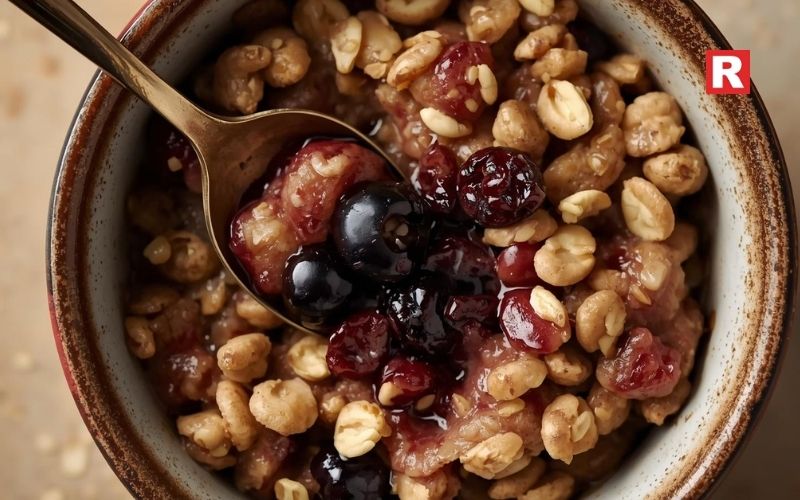
The most balanced sources of carbohydrates and soluble fiber. They digest slowly and release glucose steadily into your bloodstream. This keeps you energized and focused for hours. Oats have Beta-glucan, which is a key component in helping regulate blood sugar levels by slow carbohydrate absorption and promoting stable insulin responses. Oats are also naturally rich in B vitamins, which play essential roles in converting food into usable energy and supporting healthy brain and nerve function. So, a simple bowl of oatmeal in the morning is one of the smartest things you can do to fight off brain fog and stay focused all morning. It’s the ultimate no-hassle breakfast for a clear head throughout the day.
3. Eggs – Protein-Packed Powerhouses

The combination of protein and healthy fats in eggs provides a steady release of energy, helping blood sugar levels to be stable and preventing energy crashes midday. One of the eggs’ nutrients is chlorine, which supports brain function, enhances memory, and improves concentration. The best time to eat is in the morning because they are so nutrient-dense. You can make them boiled, scrambled, or cooked into an omelet, or eat them with a salad.
4. Greek Yogurt – Creamy Energy and Focus Booster

Greek Yogurt is packed with high-quality proteins, which help regulate blood sugar levels by slowing down the absorption of natural sugars, preventing sudden energy crashes. Its protein content is high, which helps you stay energized and focused for longer periods. Additionally, Greek yogurt has beneficial probiotics that support gut health. It is also a good source of calcium and magnesium, both of which are essential minerals that help in muscle performance and nerve function. Best eaten during breakfast or lunch. Eat it plain, or add berries and fruits with or without honey.
5. Dark Chocolate – Instant Focus and Energy

Dark chocolate contains a small amount of caffeine and theobromine, which sharpen your alertness without the side effects of coffee. It helps improve blood flow to your brain, making you feel mentally clearer. The antioxidants in dark chocolate help you fight fatigue and oxidative stress. Endorphins a chemicals that are released after eating chocolate, can greatly improve mood. For the best effect, just a square or two of a bar with at least 70% cocoa is all you need to feel refreshed and ready to power through your day.
What's new: 10 Healthy 20-Gram Protein Breakfast Recipes
6. Nuts and Seeds – Compact Sources of Sustained Energy
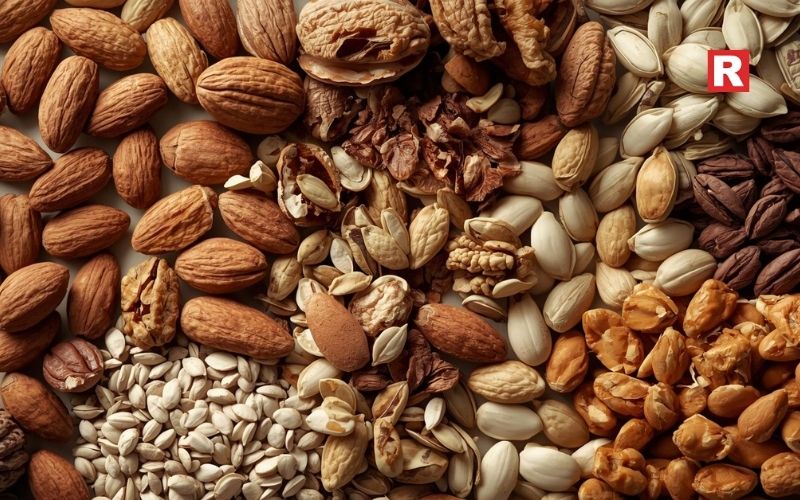
Almonds, walnuts, and cashews, along with chia, flax, pumpkin seeds, and other nuts and seeds, are all loaded with nutrients and healthy fats that give you a slow, steady stream of energy, instead of a quick burst that also fades fast. They're also loaded with magnesium, omega-3s, and tryptophan. They are beneficial for your brain, helping to sharpen your focus and regulate your mood. You can eat them anytime throughout the day, but in a moderate quantity. Sprinkle them on yogurt, add to your smoothie, or just eat them as it is.
7. Apples – Quick Energy with Long Lasting Focus
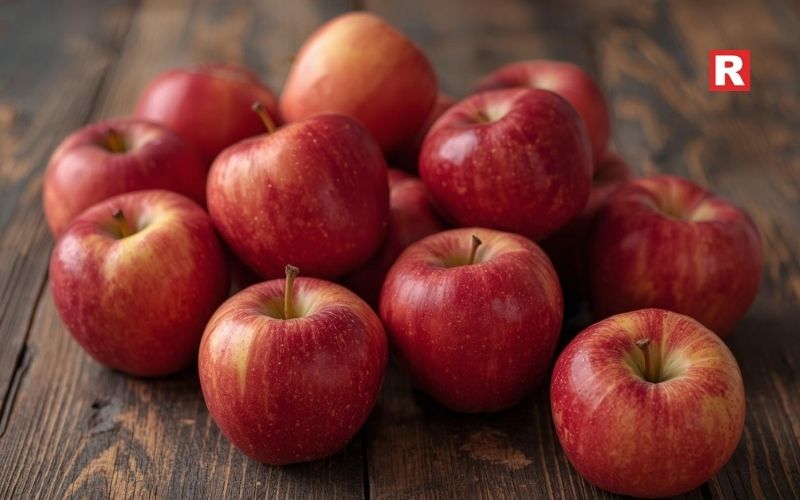
An apple a day keeps fatigue away. Apples are naturally rich in fructose, a type of sugar that provides a quick burst of energy when you need it the most. Also, they have a high fiber content, which slows down the absorption of sugar and keeps your blood glucose levels steady. They have antioxidants that prevent oxidative stress and fatigue. And fiber helps to maintain blood sugar levels. Apples are a much better alternative to coffee. You can eat an apple anytime, but it is recommended to eat from morning to late afternoon. Enjoy it in your salad, make apple juice, or just eat it raw. You can eat it however you want.
Check out: How to Make a Healthy Dessert With Just 5 Ingredients
10 vegetarian foods that are healthy and suitable for Fasting
8. Avocados – The Ultimate Brain Fuel

Avocados are rich in Omega-3 and Omega-6 fatty acids. It is also nutrient-dense, and these two factors help the brain to get a stable energy source. They also improve blood flow and provide the brain with the oxygen it needs. It also has potassium and magnesium for nerve and muscle functions. They also have the added benefit of stabilizing blood sugar levels, which helps to avoid energy slumps during the day. There is no best time for eating avocados. However, making a healthy breakfast like avocado toast, salad, or avocado pasta for lunch is a great way to eat it.
9. Dates – Nature’s Instant Energy Snack

Dates are a naturally sweet and energizing snack that are ideal for a pre-workout boost or an afternoon recharge because they are loaded with natural sugars like fructose and glucose, which the body can readily convert into instant energy. Dates have a low glycemic index, which means that they provide energy without significantly raising or lowering blood sugar levels. Magnesium and potassium, two vital minerals that promote regular activity in the muscles and nerves, are also high in them. Additionally, the fiber they contain slows down the absorption of sugar, making them a more balanced and long-lasting source of energy.
You can eat dates as cravings substitute for sweet things. Either soak them overnight in water, or eat a few during the day in moderation.
10. Green Smoothies – Quick Absorption, Long-Lasting Clarity
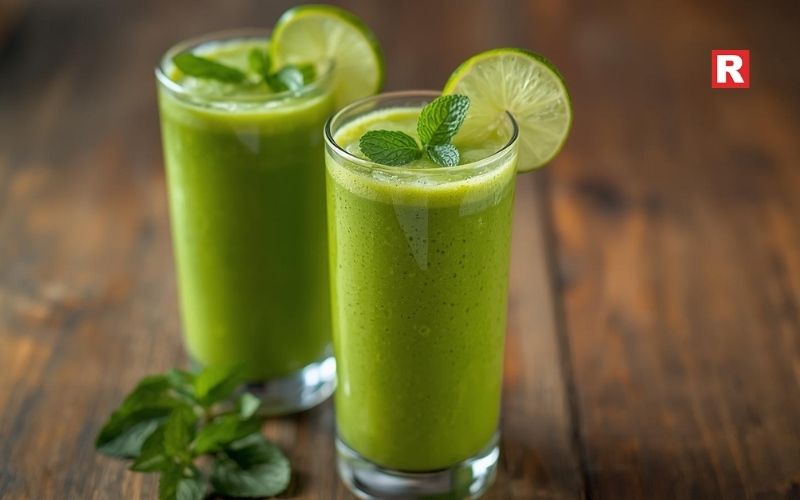
Boost your energy levels with a green smoothie with leafy greens, fresh fruits, and a healthy protein source like nut butter or Greek yogurt. The fruits' natural sugars give you a quick boost, and the protein and fiber combine to provide you with continuous energy for hours. Essential nutrients like magnesium and vitamins B and C, which are important for metabolism and energy production, are also abundant in these smoothies. Additionally, they aid in maintaining your hydration, which is important because even mild dehydration can cause sluggishness and fatigue. The antioxidants and amino acids found in fruits and greens promote brain health by enhancing mental clarity and focus. Smoothie idea: Blend spinach, banana, Greek yogurt, and a spoonful of flaxseed for an energizing drink that boosts both focus and stamina.
Tips for People with Allergies
- Egg allergies: Replace eggs with tofu scrambles or chickpea flour omelets for a protein-rich energy boost.
- Nut or seed allergies: Swap nuts and seeds for roasted chickpeas, edamame, or sunflower seed butter.
- Dairy allergies or lactose intolerance: Substitute Greek yogurt with soy, almond, or coconut-based yogurts for protein and probiotics.
- Banana allergies: Use apples, pears, or papayas for natural sugars and fiber to maintain steady energy.
- Avocado allergies: Choose hummus or olive oil-based dips as sources of healthy fats and brain-supporting nutrients.
- Oat or gluten sensitivity: Replace oats with quinoa flakes or brown rice porridge for sustained energy without discomfort.
Tip: Always read ingredient labels carefully and introduce substitutes slowly to ensure they’re safe and suitable for your body.
Learn more: Best Foods for Glowing Skin & Healthy Hair
Conclusion
When you're just surviving through the afternoon, it's tempting to grab a candy bar or another cup of coffee. But that quick fix always comes with a crash. And the good news is, you have better options right in your kitchen. So from now on, think about reaching for a banana instead of an energy drink, or some avocado toast over a sugary pastry. These real foods, like eggs, nuts, and even a square of dark chocolate, give you long-lasting energy that actually helps you concentrate, without the midday crash. So next time you feel your energy draining, try one of these natural options. Your body (and your focus) will thank you for ditching the quick fixes and choosing something that truly helps you.

Wraps are among the most popular foods across the globe. They are quick to eat, easy to carry, and packed with flavour. Every country has its own version, shaped by local ingredients and traditions. From Mexico to the Middle East, wraps tell stories of culture and travel. In Mexico, the burrito is a staple. It is filled with beans, rice, meat, and fresh vegetables. In the Middle East, the shawarma is a favourite. Thin slices of meat, creamy sauces, and spices make it irresistible. Greece offers the gyro, wrapped with fresh salad and tzatziki sauce. In Turkey, the dürüm brings soft flatbread together with seasoned meats and vegetables.
India also has its own iconic wrap — the Kathi Roll from Kolkata. Recently, it made global headlines by being ranked the 6th best wrap in the world. The roll features spicy, marinated fillings wrapped in soft parathas. It stands out for its bold flavours and street food charm. From the creamy shawarma to the spicy Kathi Roll, wraps provide more than a meal. They offer a journey through flavours, cultures, and stories. This global tour of wraps proves that great food truly knows no borders.
Read more: 8 Famous Vegetarian Dishes of Uttar Pradesh and Their Timeless Legacy
10 Awadhi Cuisine Classics You Must Try at Least Once
1. Lebanon: The Classic Shawarma

The journey begins in Lebanon with the ever-popular shawarma. This wrap is a masterpiece of slow cooking. Thin slices of chicken, beef, or lamb are roasted on a vertical spit, sliced off, and wrapped in pita bread. The magic lies in the combination — garlic sauce, pickles, and tahini give shawarma its smoky and tangy balance. It’s one of the most travelled wraps in the world, influencing dishes like the Turkish doner kebab and the Greek gyro. From the streets of Beirut to the food stalls of Mumbai, shawarma is a universal favourite.
2. Mexico: The Mighty Burrito

Next on the list is Mexico’s burrito, a true global comfort food. A soft flour tortilla wraps around a hearty mix of rice, beans, meat, salsa, and cheese. Originating from Northern Mexico, burritos became internationally famous in the United States. The name “burrito” means little donkey in Spanish — believed to represent how much it carries inside. Though the burrito remains iconic, it was recently outranked by India’s Kathi Roll in the TasteAtlas world wrap rankings, proving that street food from Kolkata can rival global favourites.
Know more: 5 Cities That Serve the Best Non-Vegetarian Street Food
3. Turkey: The Doner Kebab

Turkey’s doner kebab is one of the oldest and most influential wraps in culinary history. It’s made with marinated meat — usually lamb or beef — slowly roasted and served in lavash or pita bread. Topped with onions, tomatoes, and yoghurt-based sauces, this wrap offers a perfect blend of spice and freshness. Its name “doner” means “to rotate,” reflecting the traditional method of cooking meat on a vertical spit. The doner kebab inspired many international favourites like shawarma and gyros.
4. Greece: The Greek Gyro

In Greece, the gyro is more than food — it’s a part of life. This Mediterranean delight combines roasted meat, creamy tzatziki sauce, onions, tomatoes, and fries, all wrapped in soft pita bread. The word “gyro” translates to “turn,” referring to the turning spit that cooks the meat. It’s lighter than most wraps yet equally satisfying, thanks to its balance of creamy, tangy, and fresh flavours. Gyros are a must-try if you love simple food with bold character.
5. Vietnam: The Fresh Bánh Mì Wrap

Vietnam’s Bánh Mì is a fusion of Asian and French influences. It uses a crisp baguette — a gift of French colonialism — filled with grilled meat, pickled vegetables, chili, and fresh coriander. It’s known for its crunch, freshness, and layers of flavour. The Bánh Mì represents how two culinary traditions can blend seamlessly. Today, it’s one of the most popular wraps for people looking for something quick, healthy, and flavourful.
Also check: Pani Puri Has Different Names in Different Indian States—Know Them All
6. India: The Iconic Kolkata Kathi Roll
At number six is India’s pride — the Kolkata Kathi Roll. Born in the busy lanes of Kolkata, this wrap was first served at Nizam’s restaurant in 1932. It was created for British officers who didn’t want to touch their food directly. The cooks wrapped kebabs in parathas, and the Kathi Roll was born. A typical Kathi Roll has a flaky paratha filled with spicy kebabs, onions, eggs, and tangy chutneys. The mix of spice, crunch, and heat makes it irresistible. In recent global rankings by TasteAtlas, the Kolkata Kathi Roll was listed as the 6th best wrap in the world, beating even the Mexican burrito. This ranking is a proud moment for India’s street food culture. It shows how something made in small stalls with simple ingredients can win hearts worldwide. At stalls across Kolkata, you can watch the process unfold — sizzling parathas on tavas, marinated kebabs grilling, and fresh onions being tossed with lime and spice. The aroma is enough to stop anyone in their tracks. It’s not just a wrap; it’s an emotion that connects millions across generations.
7. Japan: The Sushi Hand Roll (Temaki)
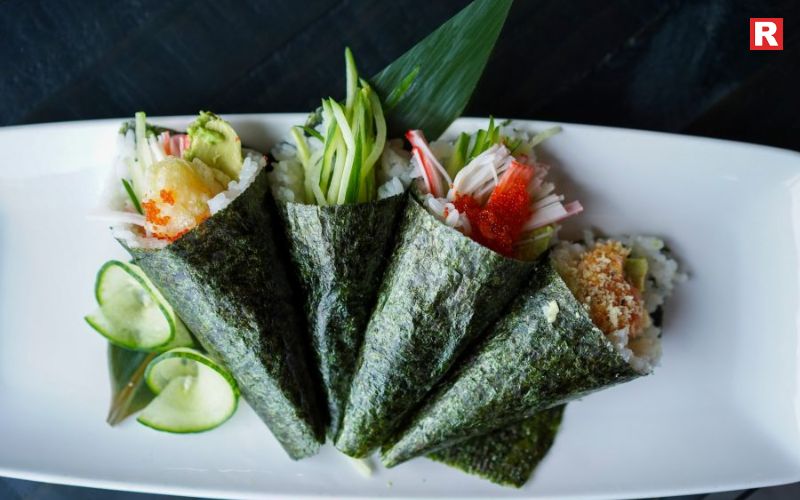
Japan redefines wrapping with Temaki, or sushi hand rolls. Made from seaweed sheets filled with rice, fish, and vegetables, Temaki is light, fresh, and precise — just like Japanese cuisine itself. Each roll is shaped into a cone and eaten by hand. It’s the most artistic wrap on this list, blending health, flavour, and craftsmanship in every bite.
8. USA: The Tex-Mex Fajita Wrap
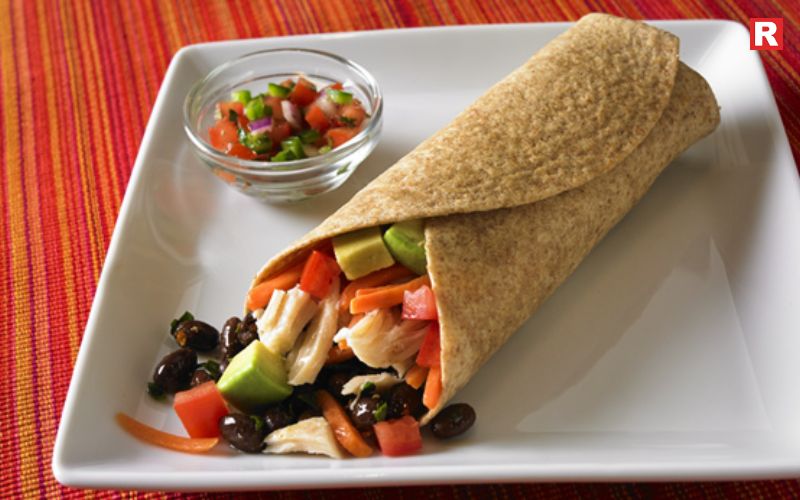
From Texas comes the sizzling fajita wrap, where grilled beef or chicken is mixed with sautéed onions and peppers, wrapped in a soft tortilla. Fajitas began as a way for Mexican cowboys to use leftover meat cuts. Today, they’re served worldwide, often still sizzling on a hot plate. They’re bold, juicy, and colourful — everything you’d expect from Tex-Mex cooking.
Why Wraps Are Loved Everywhere
Wraps symbolize more than convenience — they represent comfort and creativity. Every region has its own story: from the spicy streets of Kolkata to the cafés of Athens and the markets of Mexico City. They fit every lifestyle — from street vendors to fine dining. Each wrap connects people through flavour, showing that the best food often comes from simple ideas.
Check more: Domino’s 4-Course Meal— The Ultimate Lunch Deal You Can’t Miss
How to Pair Beer with Indian Food: A Desi Guide to Perfect Pints
7 Healthy Chicken Dishes to Maintain Your Diet
Flavour That Travels the World
From Lebanon’s shawarma to India’s Kolkata Kathi Roll, wraps are loved around the world. They are quick to eat, easy to carry, and full of flavour. The Kolkata Kathi Roll recently made headlines as the 6th best wrap in the world. This is a proud moment for the city and for Indian cuisine. The roll reflects India’s rich street food culture. It is made by hand, with fresh ingredients, spices, and care. Every bite bursts with taste and history. Other wraps like the Mexican burrito or the Middle Eastern shawarma also carry stories of their regions. They combine local flavours, textures, and traditions in a simple yet delicious way. Whether it is a burrito, shawarma, or Kathi Roll, each wrap is more than food. It is a journey — a story folded in bread, wrapped in flavour, and served with love.

Tea in India is far more than just a drink; it is a part of everyday life and culture. Each cup carries tradition, memories, and emotions. From the early morning ritual of bed tea to the evening break after a long day, tea holds a special place in Indian homes. India is both one of the largest producers and consumers of tea in the world. Every region offers a distinct flavor and style, making the country a treasure trove for tea lovers. Assam is known for its strong, bold teas that energize the day.
Darjeeling offers light, floral teas that are aromatic and soothing. South India has its unique blends, and masala chai adds a spicy, comforting touch to daily life. Tea is served everywhere — in homes, offices, street stalls, and even five-star hotels. It brings people together, whether during casual conversations or formal gatherings. Its aroma, taste, and warmth make every moment memorable. For Indians, a perfect cup of tea is not just about flavor; it is about connection, comfort, and tradition.
Read more: 6 Benefits of Drinking Black Coffee
7 Types of Whiskies Everyone Should Try Once
Discover Your Kadak Chai!
Here’s a look at the Top 10 Tea Brands in India that define quality, taste, and trust across generations.
1. Tata Tea
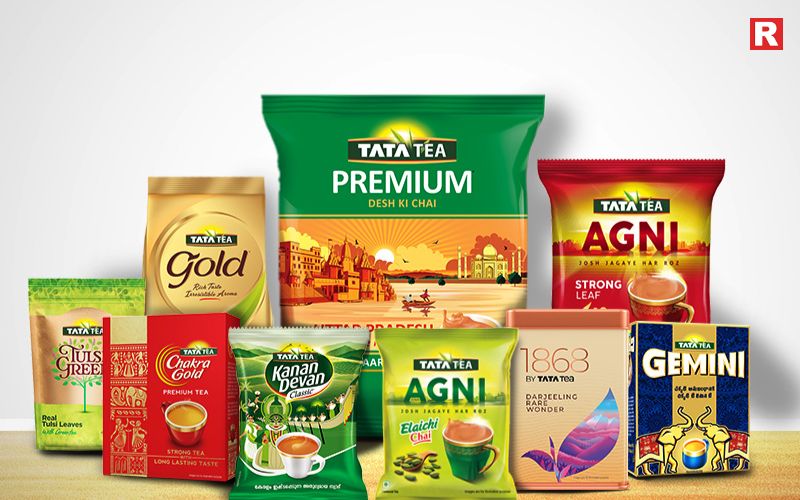
Tata Tea is one of India’s oldest and most trusted tea brands. Founded in 1964, it is part of Tata Consumer Products. The brand has a strong presence across India and is known for its high-quality tea leaves sourced mainly from Assam and Darjeeling. Tata Tea offers a range of blends, including Tata Tea Gold, Tata Tea Premium, and Tata Tea Agni, each catering to different tastes. The brand focuses on freshness, rich aroma, and consistent flavor. It is also recognized for its innovative campaigns like Jaago Re, which connect with social causes while promoting the beverage. Tata Tea has played a major role in shaping India’s tea culture and continues to be a preferred choice for households, offices, and tea lovers nationwide.
- What makes it special: Tata Tea stands out for its focus on freshness and authentic taste. The tea leaves are sourced from the finest gardens in Assam and Darjeeling.
- Popular products: Tata Tea Gold, Tata Tea Premium, and Tata Tea Agni are among the top-selling variants.
- Why people love it: Tata Tea connects with Indian emotions through campaigns like Jaago Re, which promotes social awareness along with great taste.
2. Brooke Bond Red Label

Brooke Bond Red Label is one of India’s most iconic tea brands. Launched in 1903, it has become a symbol of warmth and togetherness. Its signature blends are made using carefully selected Assam tea leaves, which give it a strong, robust flavor. Red Label is available in several variants, including Red Label Natural Care, infused with herbs like tulsi and ginger for a healthier option. The brand’s tagline, Taste of Togetherness, reflects its role in bringing families and friends together over a cup of tea. Brooke Bond Red Label is widely consumed in households and offices across India. It has maintained its popularity through consistent quality, strong aroma, and flavor that appeals to the Indian palate.
- What makes it special: The blend is designed to bring strong flavor and aroma to every cup. Red Label’s secret lies in its unique mix of Assam tea leaves.
- Popular products: Red Label Natural Care, infused with traditional herbs like tulsi, ginger, and cardamom, is a favorite for those who prefer a health twist.
- Why people love it: The brand’s tagline “Taste of Togetherness” captures how chai brings people closer, no matter where they come from.
Know more: Pani Puri Has Different Names in Different Indian States—Know Them All
3. Taj Mahal Tea

Taj Mahal Tea is a premium tea brand introduced in 1966 under Brooke Bond. It is celebrated for its rich flavor, aroma, and superior quality. The tea leaves are handpicked from the best gardens in Assam, giving every cup a perfect balance of strength and fragrance. Taj Mahal Tea is available in loose leaf and tea bag variants, including the signature Darjeeling Long Leaf Tea. Known as a brand that represents luxury and elegance, it has built a reputation for providing a refined tea experience. Many Indian households choose it for special occasions and daily consumption alike. The brand also associates itself with cultural refinement through promotions that highlight music, art, and premium living.
- What makes it special: Taj Mahal Tea uses carefully handpicked tea leaves, known for their perfect balance of strength and aroma.
- Popular products: Brooke Bond Taj Mahal Tea Bags and Darjeeling Long Leaf Tea are preferred by those who enjoy an elegant, smooth brew.
- Why people love it: The brand’s association with classical music and icons like Zakir Hussain reflects its commitment to excellence and tradition.
4. Wagh Bakri Tea

Wagh Bakri Tea is a heritage brand founded in 1892 and is headquartered in Gujarat. It is known for its strong and flavorful blends that cater to the Indian taste for robust chai. The tea leaves are sourced from premium estates in Assam and Darjeeling, ensuring a rich, aromatic cup. Wagh Bakri offers a variety of options, including Wagh Bakri Premium Leaf Tea, Masala Tea, and Instant Premix. Its products are widely used in homes, offices, and tea lounges across India. The brand also promotes social and cultural engagement through its tea clubs and cafes. Wagh Bakri Tea remains a symbol of quality, consistency, and energy, making it a preferred choice for strong, everyday chai.
- What makes it special: The brand is known for its strong and refreshing blends. Its tea leaves are sourced from the best gardens in Assam and Darjeeling.
- Popular products: Wagh Bakri Premium Leaf Tea, Masala Tea, and Instant Premix are well-loved.
- Why people love it: It’s the go-to choice for those who love a strong cup of tea that energizes the day. The brand also runs tea lounges in select Indian cities.
5. Society Tea

Society Tea has been a trusted household name in Mumbai since 1933. It is known for its robust flavor and aromatic blends. The tea leaves are carefully sourced and processed to deliver a consistent and rich taste that appeals to Indian consumers. Popular products include Society Masala Tea and Society CTC Tea, which are staples in many homes and offices. Society Tea has maintained its market position through quality, freshness, and affordable pricing. It is particularly favored in western India, where it is synonymous with morning tea routines. The brand’s packaging and product offerings focus on convenience and taste, making it a reliable choice for daily consumption. Society Tea continues to uphold its legacy of delivering authentic Indian chai.
- What makes it special: Society Tea offers a perfect blend of strong and aromatic flavors, appealing to the Indian palate.
- Popular products: Society Masala Tea and Society CTC Tea are its signature offerings.
- Why people love it: It has maintained trust through decades of consistency. The packaging and flavor are crafted for everyday Indian households.
6. Lipton

Lipton is a globally recognized tea brand owned by Unilever. It has a strong presence in India and is popular for both black and green teas. The brand focuses on health and wellness, offering blends that are light, refreshing, and easy to brew. Lipton sources its tea leaves from quality gardens in India and other countries to ensure consistent flavor. Popular products include Lipton Yellow Label Tea, Lipton Green Tea, and Lipton Darjeeling Tea. The brand appeals to a wide audience, from daily chai drinkers to health-conscious consumers seeking green or herbal teas. Lipton’s teas are convenient, available in loose leaf, tea bags, and ready-to-drink variants. Its global reputation, consistent quality, and emphasis on wellness have made it a favorite among modern Indian tea lovers.
- What makes it special: Lipton’s range includes both traditional black teas and modern green tea blends.
- Popular products: Lipton Green Tea, Darjeeling Tea, and Yellow Label Tea are popular in Indian markets.
- Why people love it: It’s a brand that merges global quality with local preferences. Health-conscious Indians prefer Lipton for its light, refreshing teas.
Also check: 11 Best Commercial Coffee Machine Brands for Café: Top Picks & Buying Guide
7. Tetley

Tetley is one of the world’s largest tea brands and a part of Tata Consumer Products in India. It is known for its variety of teas, including black, green, and flavored blends. Tetley focuses on health and taste, offering options like Tetley Green Tea, Tetley Black Tea, and Tetley Immune with Vitamin C. The brand sources tea leaves from premium gardens and ensures consistent quality in every cup. Tetley is particularly popular among younger urban consumers who prefer lighter, refreshing teas with health benefits. Its tea bags are convenient for daily use, while its flavored options add variety to everyday tea routines. Tetley has built a reputation for global standards, premium taste, and wellness-focused blends, making it a strong contender in India’s competitive tea market.
- What makes it special: Tetley is known for its green tea collection and innovative flavors such as lemon, ginger, and mint.
- Popular products: Tetley Green Tea, Tetley Black Tea, and Tetley Immune with Vitamin C.
- Why people love it: Tetley appeals to a younger audience looking for a balance between health and taste. It’s often chosen for its refreshing flavor and wellness benefits.
8. AVT Tea (Sulaimani Tea)

AVT Tea is a South Indian brand with over 80 years of heritage. It is especially known for its Sulaimani tea, a light and aromatic black tea enjoyed widely in Kerala. AVT Tea sources leaves from the best gardens in South India and ensures careful processing to retain flavor and aroma. The brand offers premium loose leaf teas and packaged options such as AVT Premium Tea, AVT Gold Cup, and AVT Sulaimani Tea. Known for its smooth and mild taste, it is a preferred choice for those who enjoy delicate yet flavorful tea. AVT Tea has maintained trust among consumers through consistency, quality, and a focus on traditional tea experiences. Its products are used daily in homes, offices, and South Indian tea stalls.
- What makes it special: The brand’s teas are known for their mild flavor and soothing aroma.
- Popular products: AVT Premium Tea, AVT Gold Cup, and AVT Sulaimani Tea.
- Why people love it: AVT is trusted for its smooth flavor and consistent quality. It’s often the first choice in South Indian households.
9. Girnar Tea

Girnar Tea, established in 1978, is a brand widely recognized for its instant tea premixes and traditional Indian flavors. It offers black tea, green tea, herbal blends, and masala chai mixes that are convenient and easy to prepare. Popular products include Girnar Instant Masala Chai, Cardamom Tea Premix, and Detox Green Tea. Girnar focuses on modern convenience without compromising authentic Indian taste. Its teas are popular in households, offices, and among consumers who prefer quick brewing options. The brand sources quality tea leaves and herbs to maintain freshness and flavor. Girnar has also tapped into the health-conscious segment with green and herbal teas, appealing to both traditional chai drinkers and modern tea enthusiasts across India.
- What makes it special: Girnar offers a range of teas — from black and green to instant masala chai mixes.
- Popular products: Girnar Instant Masala Chai, Cardamom Tea Premix, and Detox Green Tea.
- Why people love it: The brand blends modern convenience with authentic Indian taste. It’s perfect for people who love chai on the go without compromising on flavor.
10. Typhoo India
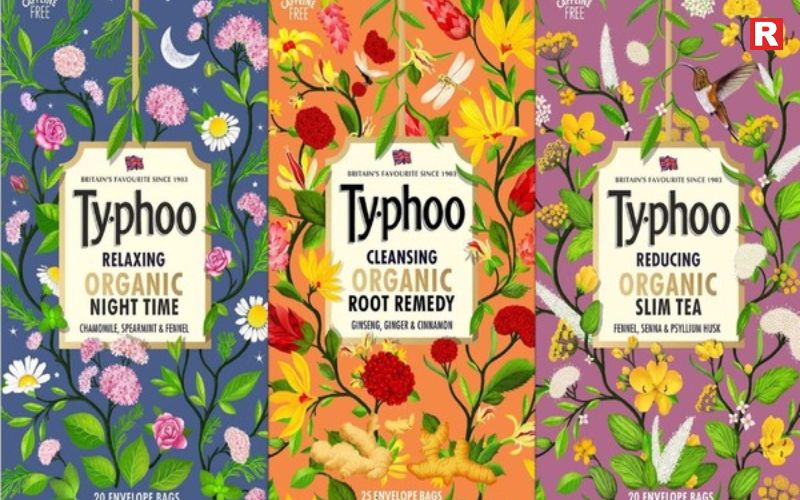
Typhoo India is the Indian arm of the British tea brand Typhoo. It is known for its premium and wellness-oriented teas, including green, herbal, and flavored blends. Typhoo sources tea leaves from trusted gardens and focuses on quality, taste, and natural ingredients. Popular products include Typhoo Green Tea, Peppermint Tea, and Chamomile Infusion. The brand caters to health-conscious consumers looking for mild, aromatic, and refreshing teas. Typhoo is positioned as a premium choice for those seeking subtle and sophisticated flavors. Its teas are easy to brew and suitable for daily consumption. By combining international quality standards with Indian tastes, Typhoo India has gained popularity among urban consumers who prefer wellness-focused tea options.
- What makes it special: Typhoo focuses on organic and herbal blends catering to the growing health-conscious audience.
- Popular products: Typhoo Green Tea, Chamomile Infusion, and Peppermint Tea.
- Why people love it: Typhoo brings an international tea experience to Indian consumers who enjoy subtle and sophisticated blends.
Why Indians Love Their Chai
Tea holds a special place in India, far beyond being just a beverage. It is woven into daily routines and cultural practices. From bustling roadside tea stalls to elegant luxury hotels, tea brings people together. It is a symbol of warmth, hospitality, and care, offering comfort in every sip. In offices, a quick cup of chai provides a refreshing break and a moment to recharge. At home, tea accompanies conversations, celebrations, and quiet reflections, creating a sense of togetherness. The aroma of freshly brewed tea evokes memories and feelings of familiarity for many Indians. Different regions offer unique flavors, from the strong, malty Assam teas to the light, floral Darjeeling blends. Tea is also versatile, available as traditional masala chai, green tea, or herbal infusions. Its presence in everyday life makes it a cherished part of Indian culture and social bonding.
Check more: Top 10 Health Benefits of Eating Dry Fruits Daily
8 Famous Vegetarian Dishes of Uttar Pradesh and Their Timeless Legacy
5 Cities That Serve the Best Non-Vegetarian Street Food
Tea Time!
India’s tea culture is one of the oldest and most celebrated in the world. Tea is not just a drink here; it is part of daily life. Every region offers its own flavors and styles, from the strong, malty Assam teas to the light, floral notes of Darjeeling. Each brand in India carries its own story and tradition. Some focus on bold, full-bodied blends, while others bring delicate and aromatic teas for a refined experience. Many brands also cater to modern tastes with green tea, herbal infusions, and masala chai mixes. Tea is enjoyed in homes, offices, and roadside stalls, creating moments of connection and comfort. With so many trusted brands, consumers have the freedom to explore and find teas that match their taste and lifestyle. From classic favorites to premium blends, India’s tea brands continue to define the nation’s love for chai.

Puducherry (or Pondy, as the locals lovingly call it) isn't just a place to go sightseeing; it’s also a place full of delicious wonders. As Pondicherry was once a French colony, its remnants can still be seen both in its culture and food. Walk down the streets of the French Quarter, with its iconic yellow walls draped in bougainvillea flowers, and you’ll feel like walking through a colonial postcard. But the real magic happens in the kitchens, where centuries of French, Tamil, and Creole history have been slowly simmered into a cuisine that exists nowhere else on Earth.
If you’re a foodie, this charming coastal town, officially the Union Territory of Puducherry, can become your next great adventure. Forget what you think you know about South Indian or European food; this city has forged a completely new flavor profile unique to its own. From the crispiest croissants imaginable to curries that will set your palate on fire (in the best way), here are the 10 essential dishes that define the true taste of Pondicherry.
Read more: 5 Tasty Dishes from Bihar You Must Try
The Franco-Tamil Love Story: Creole Specialties
The heart of Pondicherry’s unique food lies in its Creole cuisine, which is a magnificent fusion of traditional French cooking principles and the fiery taste of Tamil spices. Do not just think of them as French dishes that are adapted, but as entirely new creations.
1. Pondicherry Fish Curry (Meen Kuzhambu)
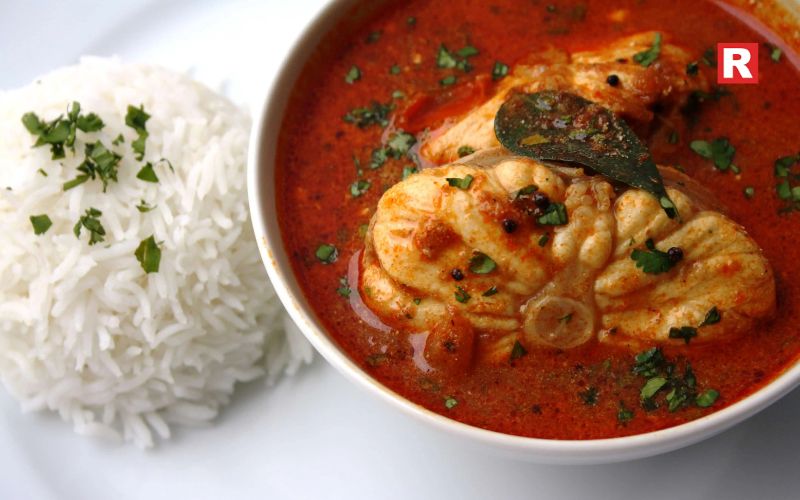
Visiting Pondy and not having this dish is a crime in itself. At first glance, this fish curry might look like a typical coastal dish, but the complexity of its flavor is miles ahead. Its gravy is a masterwork, featuring a powerful blend of tamarind’s tang and the mellow creaminess of coconut milk. A fresh, locally sourced fish (often a tender white fish, such as seer) is slow-cooked in this broth. A unique blend of Creole spices and a hint of ginger lends this dish a subtle depth that sets it apart from its Tamil Nadu counterparts. The best way to eat it is when poured generously over hot, unpolished rice.
2. Kadugu Yerra (Mustard Prawn Curry)
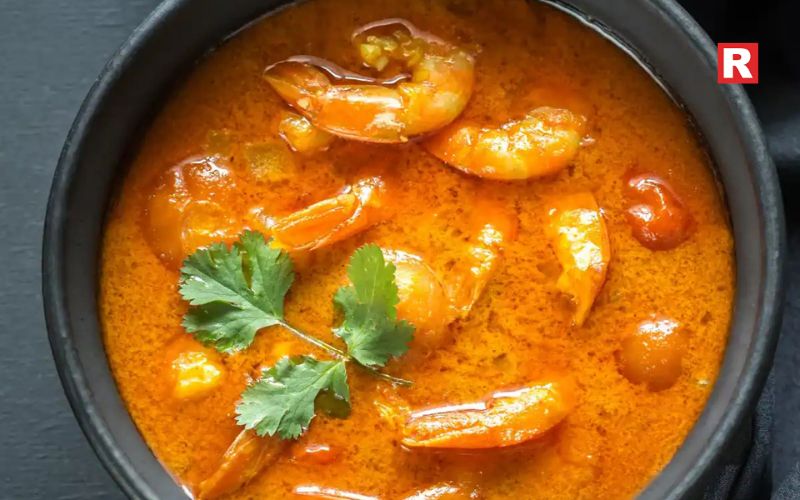
Prawn lovers, prepare to be amazed by this special pondy curry, made with fresh prawns. Kadugu Yerra translates simply to Mustard Prawn. Its name can barely hint at the utter deliciousness of the dish. This is where the French love for mustard seeds met the coastal people’s reliance on coconut. Plump, juicy prawns are cooked in a thick, fragrant gravy. The mustard seeds provide a sharp, earthy kick, which is beautifully balanced by the sweet coconut base. It is rich, comforting, and spicy enough to clear your sinuses. You can call this a perfectly executed seafood curry that makes you clean your plate.
Know more: 10 Iconic Dishes from Kashmir That Will Give You a Flavor of Paradise
From the Sea: Must-Try Coastal Catches
Puducherry’s proximity to the Bay of Bengal guarantees some of the freshest seafood imaginable, often sold directly from small fishing boats right onto the tawa or griddle.
3. Kanava Thokku (Squid Masala Fry)
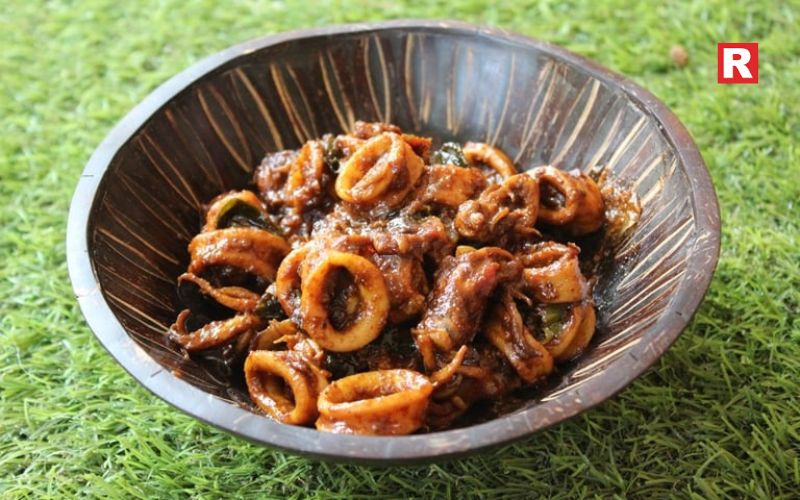
This is Pondicherry's best seafood snack or side dish. Squid rings (Kanava) are prepared in a fiery, semi-dry manner in Kanava Thokku. The rings are quickly tossed and simmered in a dark, flavorful masala made from caramelized onions, chunky tomatoes, and a generous amount of local red chili powder and curry leaves. The key here is the technique: the squid is cooked just right to stay tender and springy, soaking up every bit of the intense, spicy gravy. You need to just grab a piece of parotta and scoop it up!
4. Crab Masala Fry

Pondy’s street food stalls and specialized seafood restaurants often showcase huge, fresh mud crabs. The best way to create crab is the local method, the Crab Masala Fry, which is fantastic because it lets the natural sweetness of the crab meat shine. The crab is marinated in a fragrant paste of garlic, ginger, turmeric, and cayenne, then fried until the shell is crispy and the meat gets juicy. To truly enjoy this delight, crack open the shells and suck out the flavorful delight. It might be messy, but this will give you an authentic Puducherry experience.
The French Connection: Pastries and Cafe Culture
You can see the most French influence in the area called the White Town. Its charm in itself is inextricably linked to its boulangeries (bakeries) and cafes, where you can instantly transport yourself to Europe.
5. Croissants, Baguettes, and Brioche

The quality of baking here is surprisingly authentic, which is a testament to its French legacy. You can easily skip breakfast at your hotel and head straight for a bakery like Baker Street or Auroville Bakery. The aroma of the cafe alone is intoxicating. Their croissants are world-class. Flaky, buttery, and perfectly layered, exactly what you’d expect from a hidden Parisian cafe. A crusty baguette with homemade jam and butter, or a slice of soft, sweet brioche, is a simple breakfast you can indulge in that feels completely appropriate here.
To enjoy a traditional Pondy breakfast, serve a plain croissant with a French press or a cup of strong South Indian filter coffee. For a more luxurious meal, try the chocolate or almond versions of the croissant.
What's new: 8 Famous Street Foods from Hyderabad You Can’t Miss
6. Crêpes (Sweet and Savoury)

The Crêpe is Pondy's signature French snack. You’ll find them everywhere, from old-fashioned cafes to specialized stalls. For a delightful afternoon treat, try a sweet crêpe slathered in Nutella and local bananas, or perhaps a spicy one filled with cheese, spinach, and mushrooms. It's light, versatile, and wonderfully satisfying. Seeking out a cafe that serves them with a genuine French feel is part of the fun.
7. Quiche Lorraine

For a perfect light lunch that leans towards European cuisine, look for a local spot serving authentic Quiche. This savory egg custard baked in a flaky pastry crust comes with fillings like spinach, smoked chicken, or cheese. They are often sold in individual portions, making them ideal for a quick bite while you explore the architectural beauty of the French Quarter. The quality and freshness of the ingredients are generally superb. The sightseeing, along with this snack, will take you straight to the lands of the French.
Grounded in Tradition: Authentic Tamil Staples
Puducherry is still a deeply Tamil region beyond its vital roots to the French. Its daily cuisine is the backbone of local life, spicy, filling, and utterly delicious. These dishes are best found at the traditional local restaurants (or mess).
8. Kal Dosai with Sambar and Chutney
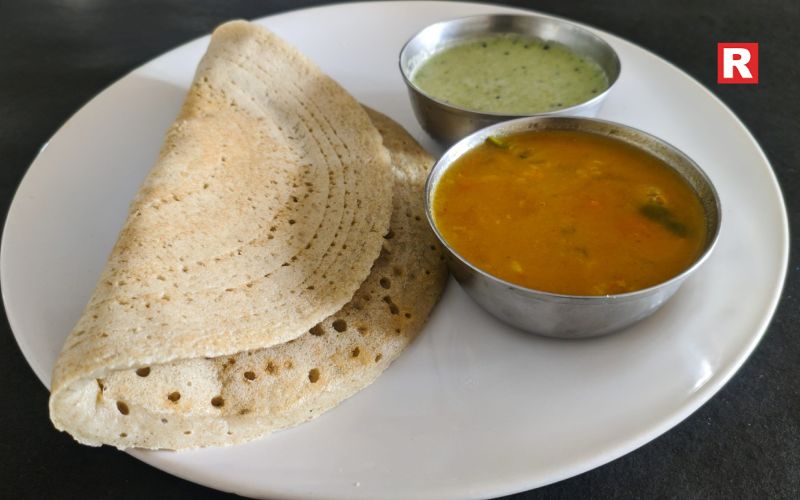
Unlike the gigantic, crispy masala dosas that stand vertically on your plate, the Kal Dosai is a softer, smaller, and slightly thicker version, similar to a soft pancake. They are made quickly on the kal (griddle) and are usually served in pairs with a generous bowl of piping hot, aromatic Sambar and a trio of fresh, vibrant chutneys (coconut, mint, and tomato/chili). This is an absolute must-try for breakfast and is also a popular tiffin item. The local versions of this dish and chutneys often use their own unique regional ingredients, making the familiar taste of the dosa a little bit new.
Check out: 10 Things You Should Know Before Eating Jolochip
Top Iconic Street Foods from Every Indian State You Must Try
9. Kothu Parotta

If you’re looking for an authentic and comforting street food experience here, then Kothu Parotta is the answer. As evening falls, you'll hear a distinctive rhythmic sound: the chop-chop-chop of metal on a hot griddle (a flat iron plate). That’s the making of Kothu Parotta, one of India's most satisfying street foods. It involves taking flaky, layered flatbread (parotta), shredding it, and then furiously stir-frying the pieces with meat, eggs, and a fiery, spicy masala until it becomes an irresistible mess. It's a delicious spectacle to watch and an explosion of flavor to eat.
10. Filter Coffee (Kaapi)

Okay, it’s not a dish, but no Puducherry culinary list is complete without mentioning the Filter Coffee. The ritual of making a perfect cup of coffee is everything: the slow drip brew, the chicory-enhanced, strong decoction, the frothing of the milk, and the final serving in the traditional davara and tumbler. It is strong, frothy, and intensely flavourful, which is the perfect caffeinated partner to a crispy vada or a soft idli. Find a bustling local restaurant, and watch the kaapi being poured from a height to create that satisfying foam.
Learn more: 10 Simple Rice Bowl Recipes For a Quick and Healthy Lunch
The Final Bite
Puducherry food is a legacy in itself. It’s a rare travel experience where you can enjoy a classic French croissant for breakfast, a flavorful Creole seafood curry for lunch, and a hearty Tamil thali (platter) as dinner all within a single day and within a few blocks of each other. The city’s food scene is a vibrant, living museum of its history. Their mixed legacy of French, Tamil, and Creole is a reason in itself to visit this charming coastal city. So pack your bags and your appetite, because Puducherry is going to take you on a culinary journey you won’t forget.

Kashmir is not called a "Paradise on Earth" just for its beautiful landscapes and scenery. Beyond the breathtaking sights of this place is a universe of rich, aromatic, and deeply soulful food that will warm anyone’s heart, even if it is as cold as the snow-covered mountains of Kashmir. Their food is a love letter written with spices, a culinary history, culture, and craftsmanship that is passed through generations.
To get a proper taste of Kashmiri cuisine, you need to forget about Indian cuisine for a while. Kashmiri food is a cuisine of its own. The warmth of spices isn’t about brutal heat, but about a gentle, lingering warmth that comforts you from the inside out. It’s a dance of flavors where saffron, fennel, and ginger play the lead roles. So, let’s take you on this culinary journey where we will explore the 10 iconic dishes that define the taste of Kashmir.
Read more: Best Dishes in North East Indian Cuisine
1. Rogan Josh: The Crimson Jewel of Kashmir
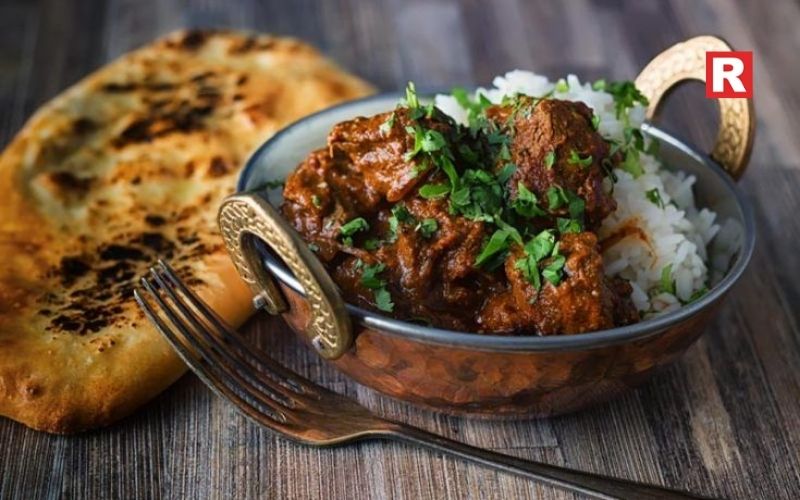
You simply cannot talk about Kashmiri food without mentioning Rogan Josh. This is the dish that has traveled the world and become the global ambassador of this region's cuisine. Rogan Josh is a slow-cooked lamb curry, known for its vibrant, signature red color and incredibly tender meat that falls off the bone. Its fiery red color can make it look spicy, but don't let the color fool you; it's not too spicy. Its heat level is mild. Its magic comes from a blend of Kashmiri red chilies (which provide color more than intense heat) and a symphony of aromatics like fennel, ginger, and cardamom. The result is deeply aromatic, slightly sweet, and extremely savory.
The key is the slow "roghan" (oil) cooking method, which allows the meat to become totally tender and the spices and fully integrate in the gravy. It’s a Sunday special meal in many households, best enjoyed with steamed rice.
2. Gushtaba: The Meatball Curry

If Rogan Josh is the king of Kashmiri cuisine, then Gushtaba can be considered the queen. It is a grand finale dish of the traditional Kashmiri multi-course feast, the Wazwan. It is a luxurious creamy dish made of velvety, minced mutton balls simmered in a creamy, yogurt-based gravy. The star of the dish is its rich, creamy gravy, delicately spiced with cardamom, cloves, and fennel. It has a subtle tang from the yogurt that balances the richness of the meat. The meatballs themselves are so smooth that they practically melt in your mouth.
Making Gushtaba is an art. The meat is pounded for hours with fat to achieve that signature smooth, cloud-like texture. It's a dish that speaks of patience and celebration.
Know more: Thai Food: 8 Thai Cuisine Dishes You Shouldn’t Miss
3. Yakhni: The Delicate Yogurt Curry
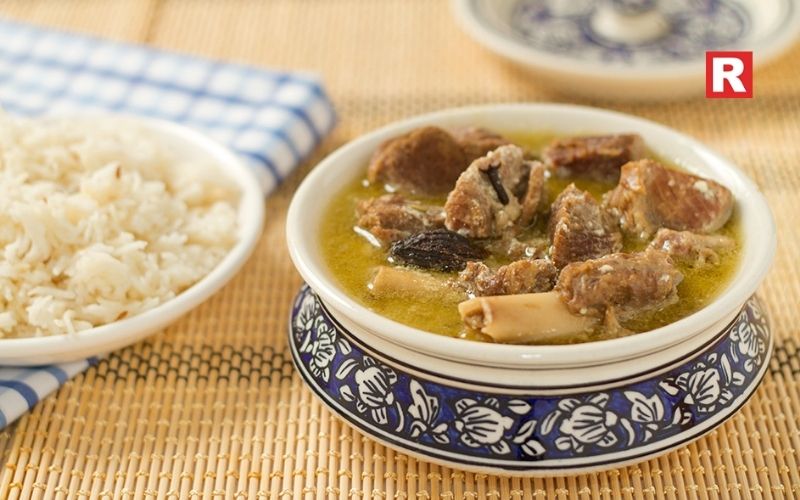
Yakhni is a milder version of Gushtaba. While it also features meat in a yogurt gravy, the flavor profile is entirely different, showcasing the versatility of Kashmiri cuisine. It is a mild, soothing curry made with chicken or lamb, simmered in a yogurt-based sauce infused with aromatic spices. The dominant flavors of Yakhni come from bay leaves, cardamom, and cloves, with creaminess from the yogurt. This makes the dish subtle, fragrant, and gentle on the palate. It is also a little sweet and incredibly comforting.
The yogurt must be stabilized carefully to prevent it from splitting, a technique that Kashmiri cooks have mastered. It’s the ultimate comfort food, especially on a chilly evening.
4. Rista: The Fiery Sibling of Gushtaba

Often served as a course before Gushtaba in the Wazwan, Rista is another masterpiece of minced meat, but with a completely different personality. Similar to Gushtaba, Rista is a meatball made from pounded mutton. However, they are served in a vibrant, red, and slightly spicier gravy. The gravy gets its fiery red hue and a bit more kick from a generous use of Kashmiri red chilies. It’s less creamy than Gushtaba and has a more noticeable and stronger flavor.
The art of pounding the meat to the perfect consistency is what separates a good Rista from a great one. It’s a testament to the skill of the traditional Kashmiri chef, the "Waz".
5. Modur Pulao: The Sweet Festive Rice

Modur Pulao, a dish that is for celebrations, has a beautiful balance of savory and sweet, which shows the variety in Kashmiri cuisine. Basmati rice is cooked with a touch of sugar or jaggery, ghee, and warm spices like cinnamon, cardamom, and cloves. It's sprinkled with colorful dry fruits like raisins, almonds, and cashews, and often, a few strands of saffron are added for a royal aroma and golden hue.
The balance of sweet and savory is key in this dish. It’s never too sugary, but a subtle, fragrant sweetness that complements the rich meat dishes perfectly.
What's new: 6 Common Ingredients Used in South Indian Cuisines
6. Nadru Monji: The Crispy Lotus Stem Fritters

Kashmiri cuisine is not just famous for its non-veg dishes. If you are a vegetarian looking for veg dishes to eat during your next visit to Kashmir, then you should definitely try Nadru Monji. Nadru, or lotus stem, is a unique and beloved ingredient in Kashmir. It is thin slices of lotus stem, dipped in a spiced gram flour (besan) batter and deep-fried to golden, crispy perfection. The lotus stem itself has a mild, slightly sweet, and starchy flavor, similar to a potato but with a delightful crunch. The crispy, spiced batter makes it truly addictive.
Served hot with a side of tangy tamarind chutney or mint chutney, these fritters are a popular street food and a common snack in households, especially during the winter.
7. Dum Aloo: The Potato Curry Like No Other
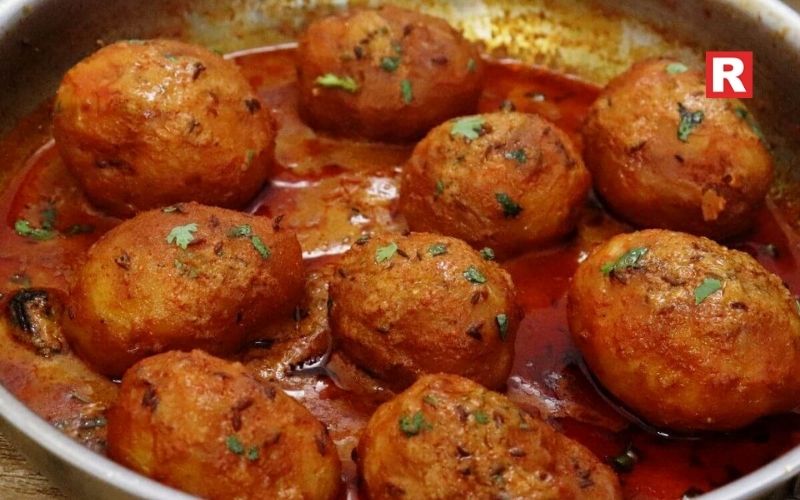
You've had aloo curry before, but not like this. Kashmiri Dum Aloo is in a league of its own. To make this dish, baby potatoes are used instead of normal ones. Baby potatoes are first deep-fried and then slow-cooked ("dum") in a spicy and tangy yogurt-based gravy. Due to deep frying, the potatoes have a wonderfully crispy skin that soaks up the gravy, while the inside remains soft and fluffy. The gravy is a beautiful balance of tangy (from yogurt and sometimes a hint of dry ginger powder) and spicy (from Kashmiri chilies).
The double cooking process, frying and then slow-cooking, is what gives this dish its incredible texture and depth of flavor.
Check out: A Close Look at Goa's Diverse Cuisine
Rogan Josh Recipe – Authentic Kashmiri Delight You Can Make at Home
8. Kashmiri Saag: A Leafy Green Delight
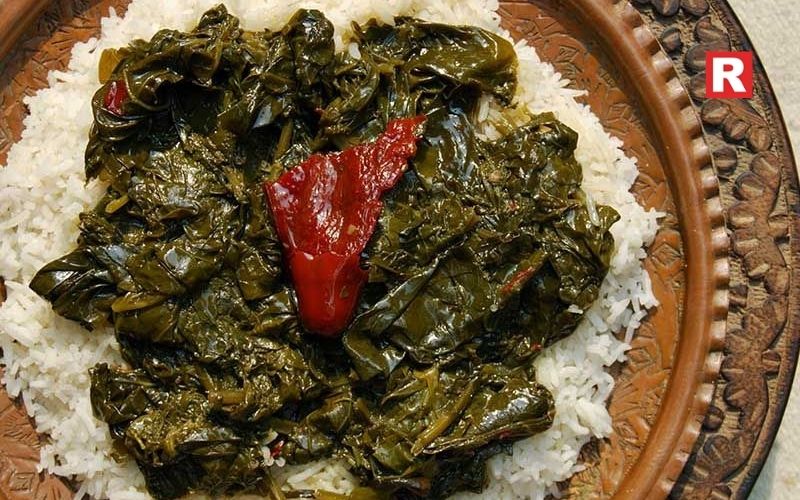
Kashmiri Saag is a simple, home-style dish that showcases the fresh produce of the valley. This isn't your average saag; it has a unique Kashmiri touch. Made from hak, a local green, this simple dish keeps you grounded amid all the rich flavors. Tempered with mustard oil and fenugreek seeds, it has that unique earthy taste that pairs perfectly with simple steamed rice. It tastes like the fresh mountain air feels. The flavor is earthy, slightly bitter, and totally green.
It’s a simple dish that is often eaten with steamed rice or Makki ki Roti (cornbread), providing a comforting and nutritious counterpoint to the richer meat dishes.
9. Sheermal: The Saffron-Infused Flatbread

This slightly sweet, saffron-infused bread is too special for ordinary days. Sheermal is a slightly sweet, fermented flatbread that is rich, flaky, and incredibly aromatic. Tearing off a piece to scoop up Rogan Josh gravy is one of life's simple pleasures. The dough is mixed with milk, ghee, and a pinch of sugar. Its unique characteristic is the infusion of saffron, which gives it a beautiful yellow color and a floral, luxurious aroma.
10. Noon Chai or Sheer Chai: The Pink Salted Tea

No visit to Kashmir, whether it is virtual or real, is complete without its most iconic beverage. That is, the famous pink tea. Noon Chai or Sheer Chai is a traditional salted tea, most famous for its stunning pink color. The first time you see it, you can't believe your eyes. The saltiness might surprise you at first, but soon you find yourself craving its unique flavor. It has a unique, slightly salty, and creamy taste. It’s made with green tea leaves, baking soda (which causes the chemical reaction that turns it pink), milk, and salt. Sipped slowly from small cups, it's not just a drink - it's a conversation starter, it's the warmth of the valleys, it's Kashmir in a teacup.
Served piping hot in small cups, often with a traditional bread like "Kandir Chot," Noon Chai is a welcome drink, and a daily ritual for Kashmiris, especially during the harsh winters.
Learn more: Why North Indian Cuisine is Still Trending in India?
A Final Taste of Paradise
What makes Kashmiri food so special isn't just the ingredients or techniques, but the love and history woven into every dish. Each recipe tells a story of the land, the people, and their way of life. Each of these ten dishes is a gateway to understanding the soul of this majestic region. These recipes showed that Kashmir is much more than its vast valleys and lakes. So the next time you want to experience paradise, better come and know its culture more by taking a bite of its cuisine. Take a step forward, and find a good Kashmiri restaurant, or better, try one of these recipes yourself. Let your taste buds take a journey to paradise. You won't regret it.

As the festive season unfolds in a haze of gold and laughter, it’s time to raise a glass to the finer spirits. The heart of every celebration often lies not in the grandeur, but in the moments shared — and what better way to savour them than with a perfectly stocked bar? From the smoky sophistication of whiskies to the velvety warmth of rums and the crisp allure of fine wines, each bottle adds its own sparkle to the season’s spirit.
Here’s your definitive guide to the ten spirits that deserve pride of place in your bar cart this festive season.
Indri Agneya

Agneya, derived from the Sanskrit word meaning “belonging to fire,” is a lightly peated single malt whisky that draws its character from maturation in both Sherry and Bourbon casks. This dual-cask aging imparts layers of depth and complexity, evoking the elemental interplay of fire and wood. Crafted in the tranquil village of Indri in Haryana, Agneya is a bold yet elegant expression—one of the most refined Indian single malts to date. On the nose, it reveals rich notes of nuttiness and ripe fruit. The palate unfolds with a smooth, rounded texture, culminating in a gentle, lingering smokiness that sets it apart.
Blenders Pride Reserve Collection

Blenders Pride Reserve Collection, India’s #1 brand in the Premium+ whisky category, is a true testament of its refined craftsmanship and timeless appeal. This exquisite blend is double cask matured with exceptional Scotch malts and the finest Indian grain whiskies aged in both European and American oak casks for the depth of flavour. The American oak imparts delicate floral and fruity notes, while the European oak adds layers of spicy, nutty richness.
True to its name, ‘Reserve’ reflects the Master Blender’s meticulous selection of the finest Scotch malts to create this exceptional blend. The result is a spirit with a rich, woody aroma complemented by hints of peaches, apples, and a whisper of smoke. On the palate, it reveals a full-bodied, creamy texture layered with notes of vanilla, red apple, and gentle smokiness, unfolding in an aromatic, complex finish that is floral and elegantly refined.
Camikara 3YO

Camikara from the house of Piccadily Distilleries is India’s first pure cane juice rum. It recently added another feather to its cap; Camikara proudly earned a gold medal at Global Rum & Cachaça Masters 2025 competition becoming the only Indian brand to earn this accolade. The name "Camikara" is derived from the Sanskrit term for liquid gold, paying homage to the Indian farmers who have dedicated centuries to growing and distilling sugarcane. This exceptional rum undergoes an extensive ageing process of 3 years, resulting in a remarkable celebration of the land, time, culture, and people. Bottled at 42.8% ABV, Camikara stands as a testament to purity, whether enjoyed neat or as the cornerstone of your preferred cocktail, it serves as a pristine canvas for the authentic essence of cane juice to shine forth.
Seagram’s Longitude 77

Seagram’s Longitude 77’ Indian Single Malt Whisky - from the House of Pernod Ricard India is an homage to the enchanting spirit of India and reimagines an India of unparalleled luxury and sophistication. It is crafted in small batches in a distillery in Dindori, Nashik (Maharashtra), with utmost care for seekers of authentic contemporary Indian luxury. The flavour profile is rich and mellow with notes of oak, vanilla, and a subtle hint of fruit.
The brand gets its name from Longitude 77 - A line that marks India’s position on the world map. It represents India’s richness of ingredients, historical craftsmanship, her diverse culture, and rich terroir. A line that connects India’s glorious past, enchanting present and vibrant future Every pack of Longitude 77 pays tribute to the colour indigo - India’s unique gift to the world.
Available in Maharashtra, Goa, Haryana, Chandigarh, Rajasthan, Uttar Pradesh, Punjab, Dubai, and at Delhi Duty-Free & Mumbai Duty Free.
Khukri XXX Rum

Crafted in the majestic Himalayas, is an exceptional dark blend that features rich molasses, pristine Himalayan spring water, and artisanal flavors. Aged in casks made from the exclusive Shorea Robusta tree, this rum offers a complex taste profile with earthy undertones and a smooth, caramel finish. It reflects the bold traditions and handcrafted expertise of Nepal's first distillery, The Nepal Distilleries Pvt. Ltd. established in 1959, which utilizes fresh spring water and cool mountain temperatures to create its signature spirit.
Ballantine's 30-Year-Old

Time is incredibly valuable when creating Ballantine’s 30-year-old; our whiskies have been sleeping in oak casks in the cool and crisp climate of the Scottish Highlands, for at least 3 decades! A blend of extremely rare whiskies that are at least 30 years old, some coming from distilleries that no longer exist – known as ‘lost’ or ‘ghost’ distilleries. A Scotch whisky that is truly luxurious. Best enjoyed neat, on the rocks or with a couple drops of water. Elegant sweetness, oakiness, with a balance of floral and fruity flavors are at the forefront of this expression.
Jacob’s Creek Crisp Rosé

The first Rosé to be introduced by the House of Pernod Ricard India, this wine offers great depth of flavour, courtesy bright berries and fragrant spices. On the palate, it is crisp and refreshing and leads to a long vibrant finish, this refreshing modern Rosé also entices with its aroma of red currant, strawberry and subtle notes of rose. It is part of the Jacob’s Creek Classic range, which offers fresh, great-tasting wines across a wide selection of popular varieties and blends. Jacob’s Creek Crisp Rosé is best enjoyed chilled and pairs well with charcuterie platters, feta and spinach tartlets, roast duck with chargrilled vegetables. Add a rosy hue to your Mother’s Day celebrations this year by celebrating with a bottle of Jacob’s Creek Crisp Rosé.
Absolut Vodka

Originating from Sweden, the classic Absolut vodka is known for its pure and smooth taste. It is made exclusively from natural ingredients without any added sugar.
Campo Viejo Tempranillo

Campo Viejo Tempranillo is soft and fresh on the palate, with a long finish that leaves a taste of red fruit, vanilla, and cocoa. The nose is rich in aromas and pronounced in intensity. It contains wood nuances with gently sweet notes of vanilla to finish with other sweet spices. The Spanish wine pairs best with pasta, poultry, grilled chicken and vegetables, fresh light cheeses, and small bites. Make Campo Viejo Tempranillo your companion this Christmas to enhance the joyous occasion with the wine’s exquisite flavours and versatility in pairing it with a variety of celebratory dishes.
Royal Stag Double Dark peaty whisky

Seagram’s Royal Stag introduces Royal Stag Double Dark peaty whisky, specially crafted for ‘the gamechangers’. Every drop of Seagram’s Royal Stag Double Dark is an exquisite combination of selected peated malt and Scotch malt concentrate, matured in deep-charred oak barrels, all expertly blended with the finest Indian grain spirit to bring out a distinct smoky flavour and an elevated experience. These malts have been double distilled in copper pots, aged in dark charred American and European oak barrels. The product comes in contemporary & premium packaging in a standout Ashberry colour with a burnt wood tactile finish, accentuating the smoky nature of the whisky. This is Perfect for adding a bold, smoky touch to your Christmas celebrations!
As the diyas fade and the music mellows into laughter, your home bar becomes more than a corner of bottles — it turns into a storyteller of the season. Each spirit you pour carries its own legacy, craftsmanship, and character, perfectly suited to the festive warmth of Diwali. Whether you’re raising a glass of smoky Indri, a pour of crisp Jacob’s Creek Rosé, or a bold Royal Stag Double Dark, let your choices reflect both your taste and your traditions. After all, the best celebrations aren’t about how much you pour — but who you share it with. Cheers to light, love, and lingering toasts this Diwali.

Mushrooms are one of the most loved ingredients in kitchens around the world. They have a rich, earthy flavor and a soft, meaty texture. This makes them very versatile. They can be added to rice, pasta, bread, or meat dishes. Mushrooms can make even a simple meal feel special. They are easy to cook and take on the flavor of the ingredients they are cooked with. Butter, garlic, herbs, or sauces can make mushrooms even more delicious. They can be sautéed, grilled, roasted, or baked. Each cooking method brings out a different taste and texture.
Mushrooms are also healthy. They are low in calories but rich in nutrients like vitamins, minerals, and antioxidants. This makes them a good choice for daily meals. The seven mushroom side dishes featured here show how this ingredient can shine. From buttery garlic mushrooms to creamy risotto or grilled portobello, each dish is simple to make. They pair well with both vegetarian and non-vegetarian meals. These dishes bring out the best flavors of mushrooms. They are a perfect way to enjoy this humble yet special ingredient.
Read more: 8 Famous Vegetarian Dishes of Uttar Pradesh and Their Timeless Legacy
5 Cities That Serve the Best Non-Vegetarian Street Food
1. Garlic Butter Mushrooms
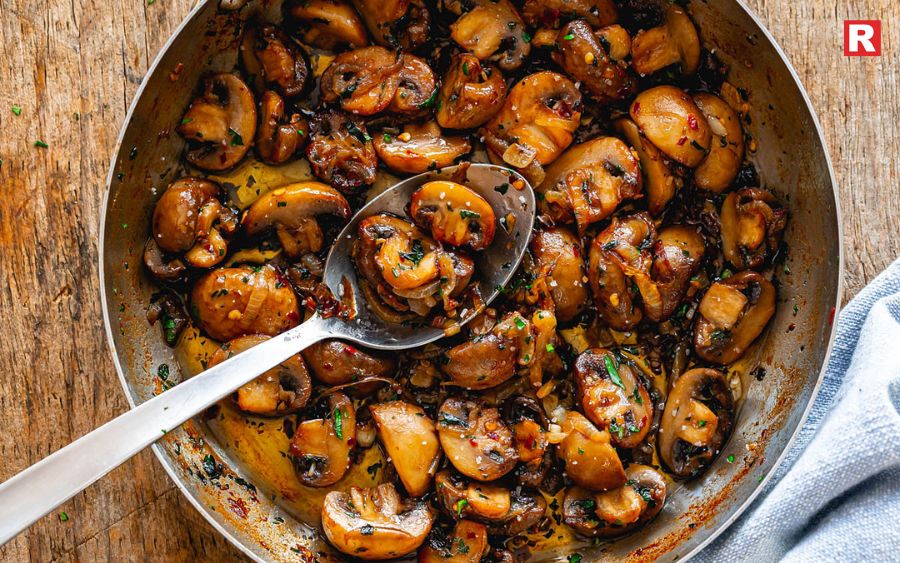
If you love simple food with bold flavors, Garlic Butter Mushrooms should be your first choice. It is one of the easiest yet most delicious side dishes you can make. Fresh button mushrooms are sautéed in a mix of butter, minced garlic, and herbs until they turn golden brown and juicy. The aroma of garlic and the richness of butter coat each mushroom perfectly, making it an irresistible side for steaks, grilled chicken, or even a slice of toasted bread.
- Quick tip: Add a splash of white wine or lemon juice toward the end of cooking. It brightens the flavor and adds a restaurant-style finish.
- Why it works: Butter enhances the natural umami of mushrooms, while garlic adds depth and warmth. This classic pairing never fails to impress.
2. Creamy Mushroom Risotto
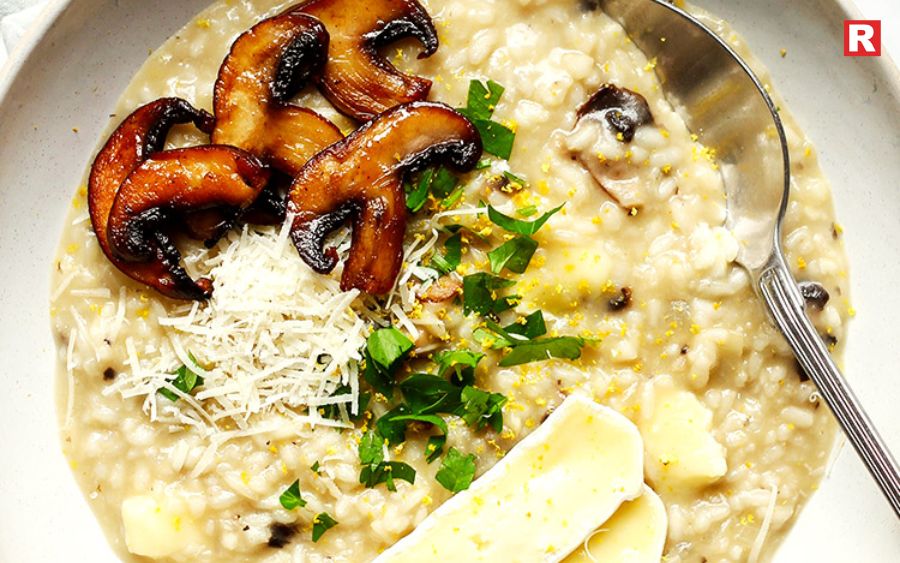
A comforting Italian favorite, Mushroom Risotto combines the richness of Arborio rice with the deep flavors of sautéed mushrooms and Parmesan cheese. The slow-cooking process allows the rice to absorb the broth and mushroom essence, creating a creamy texture without any cream. mEach spoonful is velvety and full of flavor, making it a perfect side dish for roasted vegetables, grilled fish, or baked chicken.
- Cooking tip: Use a mix of shiitake, button, and porcini mushrooms for a deeper, layered taste. Stir continuously and add warm broth gradually to get that silky consistency.
- Why it stands out: It’s a complete comfort food with the balance of creaminess and umami that makes every bite indulgent.
3. Balsamic Glazed Mushrooms

If you enjoy sweet and tangy flavors, Balsamic Glazed Mushrooms are a must-try. The dish is simple but delivers an elegant taste. Fresh mushrooms are sautéed and then tossed in a reduction of balsamic vinegar, olive oil, and a touch of brown sugar or honey. The glaze caramelizes beautifully, giving the mushrooms a shiny coating and a rich, complex flavor. The balance of tanginess and sweetness makes it a perfect companion for grilled meats, roasted chicken, or even salads.
- Chef’s tip: Add a sprig of thyme or rosemary while cooking for a herby aroma.
- Why it’s special: It’s light, quick to prepare, and turns everyday mushrooms into a gourmet side dish.
Know more: Top 4 Ways to Use Betel Leaves for Daily Detox
4. Mushroom Stroganoff
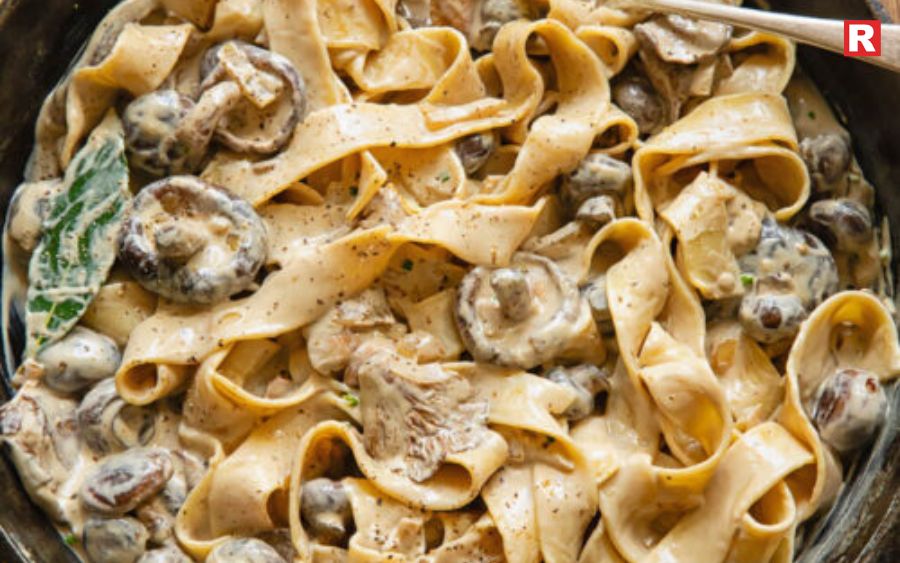
Mushroom Stroganoff brings a creamy, comforting touch to any table. Inspired by the classic Russian dish, this version uses tender mushrooms cooked in a rich sauce made of onions, garlic, butter, sour cream, and a hint of mustard. The sauce has a tangy-smooth flavor that coats the mushrooms perfectly. Serve it with mashed potatoes, steamed rice, or noodles, and it becomes a hearty side that can even double as a main dish.
- Pro tip: If you want a lighter version, replace sour cream with Greek yogurt. It keeps the creaminess while adding a fresh twist.
- Why it’s popular: The balance of creamy, savory, and slightly tangy notes makes it a universal favorite across cuisines.
5. Asian-Style Soy-Garlic Mushrooms

For a burst of umami and a touch of Asian flair, Soy-Garlic Mushrooms are unbeatable. In this dish, mushrooms are stir-fried with soy sauce, garlic, and sesame oil, creating a glossy coating that’s savory and satisfying. The flavors are deep and balanced, making this side perfect with fried rice, noodles, or tofu. You can even serve it with grilled chicken or paneer for a fusion-style meal.
- Quick tip: Sprinkle toasted sesame seeds and chopped spring onions before serving for extra crunch and color.
- Why it stands out: It’s quick, flavorful, and gives you that restaurant-style Asian taste right in your kitchen. The combination of soy and sesame brings out the mushroom’s natural umami beautifully.
Also check: 5 Ways to Use Garden Cress Seeds (Halim) for Stronger Hair and Bones
6. Stuffed Mushrooms

Stuffed Mushrooms are bite-sized delights that add elegance to any meal or party platter. The dish features mushroom caps filled with a flavorful stuffing—usually made from breadcrumbs, cheese, herbs, and sometimes vegetables or minced meat. Once baked, the mushrooms turn tender while the filling becomes golden and crisp on top. They are perfect for pairing with soups, pastas, or grilled dishes.
- Pro tip: Try stuffing them with spinach and cream cheese for a vegetarian version, or crab meat and garlic butter for a seafood twist.
- Why they’re a favorite: They’re versatile, visually appealing, and pack a burst of flavor in every bite. You can easily adapt them to your taste or occasion.
7. Grilled Portobello Mushrooms

If you prefer a smoky, meaty flavor, Grilled Portobello Mushrooms are the ultimate side dish. Their large caps and firm texture make them perfect for grilling. A simple marinade of olive oil, soy sauce, garlic, and herbs transforms them into a juicy, flavorful delight. When grilled, the mushrooms develop charred edges and a smoky aroma that pairs beautifully with barbecue spreads, burgers, or even served on their own with a side salad.
- Cooking tip: Marinate for at least 20–30 minutes before grilling to help the mushrooms absorb the flavors.
- Why they’re special: They’re a healthy alternative to meat sides and offer the same satisfying texture and flavor. Perfect for vegetarians and grill lovers alike.
How to Make the Perfect Side Dish
Mushrooms are one of the most adaptable ingredients in cooking. Their umami-rich flavor complements everything—from meats to grains and vegetables. They’re also low in calories, high in fiber, and rich in vitamins and antioxidants, making them a healthy choice for everyday meals. Whether you sauté, grill, roast, or bake them, mushrooms always deliver a depth of flavor that enhances any dish they accompany. They also absorb seasonings beautifully, allowing you to experiment with herbs, sauces, and marinades from different cuisines.
Types of Mushrooms to Use
- Button Mushrooms: Mild in taste and perfect for sautéing or frying.
- Shiitake Mushrooms: Deep, earthy flavor ideal for Asian-style dishes.
- Portobello Mushrooms: Meaty texture, best for grilling or roasting.
- Oyster Mushrooms: Delicate and tender, perfect for stir-fries or soups.
Choosing the right type of mushroom can elevate the taste and texture of your side dish. Always use fresh, firm mushrooms and avoid overcrowding them while cooking. This ensures a golden, flavorful finish instead of a soggy texture.
Check more: 12 Delicious High-Protein Foods to Eat Daily for a Healthier You
5 Foods to Avoid for Better Cholesterol
7 Healthy Chicken Dishes to Maintain Your Diet
Cooking Tips for Perfect Mushroom Dishes
- Clean properly: Wipe mushrooms with a damp cloth instead of washing under water—they soak up moisture easily.
- Use high heat: Mushrooms release water when cooked, so high heat helps them brown quickly.
- Don’t overcrowd the pan: Cook in batches for better searing and texture.
- Balance with acids: A splash of lemon juice or vinegar enhances their earthy flavor.
- Finish with butter or oil: It adds richness and helps bring all flavors together.
Final Thoughts!
Mushrooms have the power to make any meal feel special. Their rich, earthy taste and soft, meaty texture make them a favorite in kitchens everywhere. These seven mushroom side dishes show just how versatile mushrooms can be. From the creamy and comforting Mushroom Stroganoff to the bold and flavorful Asian Soy-Garlic mushrooms, each dish brings out a unique side of this ingredient. Mushrooms work well with almost any meal. They can complement a family dinner, add richness to a festive spread, or make a simple meal more satisfying. They pair easily with meat, rice, pasta, or vegetables. Healthy, tasty, and easy to cook, mushrooms are always a smart choice. Their flavor deepens with simple ingredients like butter, garlic, or herbs. Adding one of these side dishes to the table is a great way to enjoy their magic and rediscover why mushrooms are so loved.

Flights are the best option for people who are travelling a large distance. Whether it is a business trip or meeting your family that lives in another country, flights are the best and time-saving option for this. However, flight regulations are very strict, and although there is a certain amount of baggage you can bring with you, there are certain items that are prohibited on a plane. This includes certain food items like watery dishes or gravies. And this also applies to certain frozen foods.
Though there is no specific list of frozen food items that are banned, bringing them to the airport will only delay your flight, as your food items will be confiscated at the security point. Some frozen foods are allowed while checking in; however, you cannot bring them on the plane. For example, you can eat an ice cream at the airport, but you can’t bring it on the plane.
The Bureau of Civil Aviation Security (BCAS) and Indian airline regulations are quite strict when it comes to carry-on baggage: all liquids, aerosols, and gels (LAGs) must fit inside a single, transparent, resealable plastic bag and be in containers no bigger than 100 ml (3.4 ounces).
Read more: Best Frozen Food Brands for Quick Service Restaurants
Find 5 Banned Frozen Foods in Indian Flights
Let’s take a look at the ten frozen food items that are absolutely prohibited on flights.
1. Frozen Curries and Gravies/ Dal & Soups

Food items with curries and gravies like Butter Paneer or Dal Makhni are not allowed to be carried, even if they are frozen. This is because the creamy and thick consistency of these dishes comes under the category of gels. And gels are banned on Indian flights as these can leak easily. Also, they have a very strong odor.
The problem is not in the food. You can take frozen curries and gravies on a plane if they are in a 100 ml container. The rule is that the container should be airtight and the food should not thaw. Once it thaws, it would come in the category of gels and liquids.
Dal & Soups: These foods, just like curries, fall directly into the category of liquid items, whether it is a bowl of lentil soup or a simple vegetable broth. These liquids are great if frozen. But airport temperatures, waiting times, and body heat can quickly turn that solid block of lentil ice to a slushy or total liquid. So the 100 ml rule applies to this as well. It can be carried after frosting in a 100 ml container; however, checking on them becomes risky, as they could’ve thawed and can leak at any time.
Know more: 10 Low Sugar Sweets to Savour This Festive Season
2. Raw Frozen Meat / Sea Food

When it comes to frozen food items that are prohibited during flights, raw meat and seafood are at the top of the list. This rule is motivated by a number of security reasons, hygienic requirements, and other passengers’ comfort. You can carry the food item when it is completely rock solid. However, if it is not packed properly, it will ultimately melt during transportation, airport wait times, and changes in cabin temperatures.
This is why only cargo flights can carry frozen fish and meat on board, and they must also maintain proper temperature control; otherwise, the fish and meat will spoil for sure. But don’t expect to take frozen meat and fish on a passenger flight. While fish and meat are not liquid, fish do emit a strong odor after thawing. This can be quite unpleasant for other passengers. More importantly, the thawing process may cause leaks and drips that might harm your baggage. Due to odor, several airlines (such as IndiGo) specifically prohibit "fresh/frozen meat/fish" in carry-on luggage.
3. Dairy Products / Frozen Cheese / Butter / Paneer
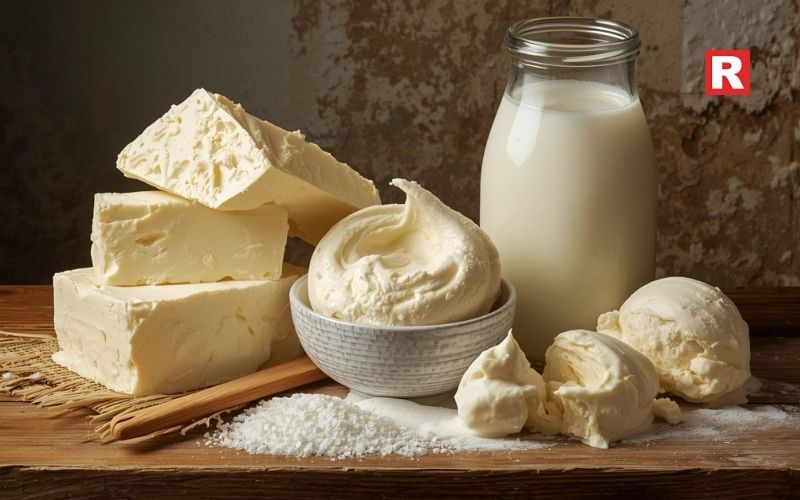
While dairy products are not totally banned from planes, they do have some restrictions when carrying them. The items that come under dairy products can be divided into two sections: Solid and liquid or spreadable. Food products like firm cheese, frozen butter, milk solids, or paneer are all solid and can be carried on a flight without any issue. While liquid or spreadable dairy products like milk, yogurt, soft cheese, and cheese spread have the 100 ml rule. You need to carry them in a 100 ml container, and it should be frozen properly. If not, it will start thawing. Also, some countries have different rules regarding the import of dairy, even if you bring it for personal use. So if you’re travelling on an international flight, then check the country rules beforehand before you carry these items.
Ice Cream: As ice cream melts very quickly, it can go from a frozen solid to a liquid in the span of a few minutes. This dairy-based dessert is considered gel/cream. It is almost impossible to keep it solid throughout the entire airport process. So, if you liked a unique ice-cream flavor and want to bring it home with you on the flight, you can’t.
What's new: 10 Healthy 20-Gram Protein Breakfast Recipes
4. Large Jars of Frozen Pickles
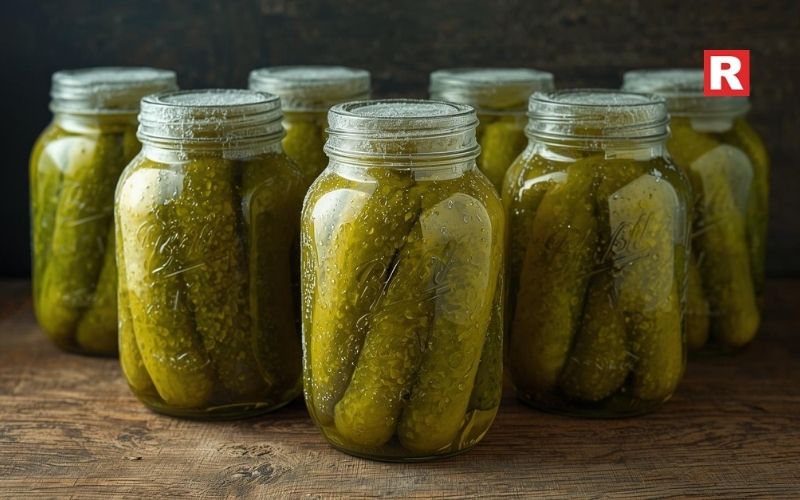
Pickles, whether frozen or not, are filled with oil and brine to the brim. While both are necessary for the fermentation process, they come under the liquid and gel section of the LAGs. For carry-on baggage, the rule says that oil and brine should be carried in a 100 ml container and that also be sealed within a transparent and resealable plastic bag.
Even if you take the pickle jar this way, there is a high chance they will thaw and leak inside the cabin, which can create a mess. This is why most airlines do not like it if you take pickles with you, frozen or not. If you want to have pickles with you on the plane, it is better to get travel-size sachets that are sealed properly.
5. Dry Coconut
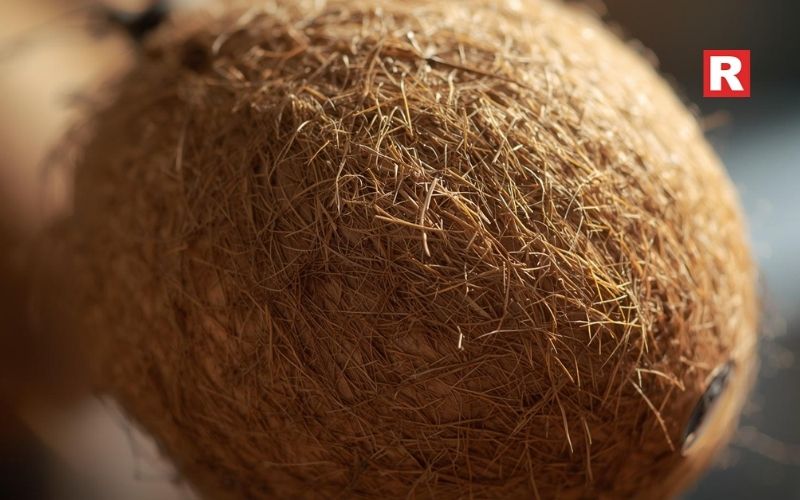
The reason why dry coconut is banned from being taken on commercial flights, both carry-on and checked luggage, is the risk of fire. The meat of dry coconut has a very high concentration of oil, making it a highly inflammable solid. The International Air Transport Association (IATA) classifies it as a Class 4 Dangerous Good.
Copra (Dry Coconut) has the potential of self-heating when packed tightly. The oil can oxidize and generate heat in the situation it is packed in a flight’s cargo hold or baggage compartment. Even a small spark or contact with any external heat source can easily ignite the oily and dry fibres of the copra. This can also lead to a sudden flame or small combustion in extreme situations. Also, the dense and hard shell of dry coconut can cause problems during security screening, as it cannot be scanned by the X-ray machine. In such cases, the security personnel will need to do a manual inspection, which can consume your time.
Check out: 10 Best Snacks without Onion and Garlic you can order today
5 Ways to Reduce Commercial Buffet Food Waste
Rules for Proper Storage
Here are some pointers, as many prohibited situations are not based on "frozen vs. not frozen," but rather on leaking, stench, risk, or lack of documentation:
- Store in well-insulated, airtight, and leak-proof containers. Use dry ice only as permitted by the airline.
- When possible, use commercial packaging that is marked, sealed, which indicates the product's origin, expiration date, etc.
- During security time, ensure that frozen goods are completely frozen to prevent sloshing.
- Check the import and customs laws of the country you are traveling to, particularly those related to meat, dairy, fruits, and vegetables.
- When in doubt, it is preferable to pack frozen goods in checked luggage rather than carry-on. Although there is a greater chance of spoiling, checked luggage often has looser regulations for liquids and perishables.
- Keep your cabin bags free of greasy or strong-smelling things, since both security and other travelers dislike them.
Learn more: How to Train Your Staff on Buffet Etiquette
Conclusion
Getting through airport security with food might feel like a dangerous cooking competition, but the regulations aren't meant to ruin your fun—they're there to keep everyone safe and the plane clean. However, a few frozen items are strictly prohibited. When you consider the possibility of strong scents from seafood, as well as the chance of leaks from flimsy containers, you can see why security is so strict.
Check in if you need to bring that frozen flavor of home with you. Use the strongest, leak-proof containers you can find, double-bag everything, and be aware that it can melt. When packing your carry-on, keep in mind that frozen solids should be 100 ml or less. A little planning saves a lot of trouble (and keeps that tasty food out of the trash). Fly cautiously, pack wisely, and enjoy your food when you land!

India's street food industry is a sensual blast that is lively, chaotic, and supremely tasty all at the same time. In India, "fast food" refers to a wide variety of freshly prepared, extremely delicious dishes that are often prepared in front of you, despite many people associating it with boring, predictable food chains. And India offers a range of heat that is unmatched for those who want a real kick.
These foods are not for the weak of heart, so forget about etiquette. It's the type of spice that makes your eyes wet, your nose run, and your taste receptors scream with a thrilling, unforgettable burn. In this multicultural country, every corner provides a different kind of mouthwatering fire, from busy metropolises to charming streets (gali-alleys).
Hold on tight if you're a true chili-head and are prepared to go on a food journey that will challenge your tolerance for fiery foods. The following list of seven of India's most fiery street foods promises a searing yet fulfilling eating experience.
Read more: How "Swicy" Dishes Can Transform Your Restaurant's Menu
1. Vada Pav (Mumbai's Beloved Burger, Spiced Up!)

Although the Vada Pav is frequently regarded as Mumbai's vegetarian equivalent of a burger, it can be surprisingly spicy, particularly when you try the spicier, authentic varieties. Fundamentally, a vada pav consists of a deep-fried vada (potato patty) wrapped in a soft bread bun (pav) and seasoned with ginger, garlic, green chilies, and turmeric.
However, what makes it so "fiery"? The accompaniments are crucial in making it a fiery treat. A spicy tamarind chutney, a dry garlic-chili chutney (lehsun sukha chutney), and sometimes a bright green chili chutney are among the common choices. Vendors will generously cover the pav with many layers of green chili chutney, which is occasionally made with strong roasted chilies, and even stuff a fried green chili (bhaji mirchi) into the bun for those who truly enjoy spice. With each bite, the heat intensifies, creating a slow-burning fire that complements the bread and soft potato.
Why it's fiery: It's spicy because of the strong dry garlic-chili powder, fried green chilies, and green chili chutney.
Where to find it: On every street corner in Mumbai, but for the spiciest and freshest varieties, seek out the busiest booths.
2. Tandoori Momos (Delhi's Fiery Fusion Dumpling)

Despite being mainly Tibetan, street food sellers in North India, especially Delhi, have adapted, improved, and greatly spiced up momo, or steamed dumplings. Spice fans should try the "Tandoori" version, which is a modern and spicy blend.
A rich, colorful sauce consisting of yogurt, ginger-garlic paste, cream, and a significant amount of Kashmiri red chili powder and other spices marinates regular steamed or fried momos. After marinating, the dumplings are skewered and grilled in a tandoor, an extremely hot clay oven, until they are smoky and have a hint of char. The traditional but incredibly strong, spicy red chili chutney, which is prepared from dried red chilies and garlic, is served with the finished meal, giving it a double whammy of heat and taste.
Why it's fiery: It's fierce because the tandoori marinade is full of chilies and comes with a fiery red chili-garlic dipping sauce.
Where to find it: Chandigarh and Delhi's street food hotspots.
Know more: Mutton Chukka (Sukka) Recipe – A Spicy South Indian Delight
3. Bhut Jolokia Dishes (Northeast India's Atomic Heat)

When talking about "fiery" Indian cuisine, you have to visit the Northeast, which is home to the Bhut Jolokia, also known as the Ghost Pepper, which was formerly deemed the spiciest chili in the world. With its gradual, powerful, and long-lasting heat, this substance is an experience in itself.
Although not a single meal, the Bhut Jolokia is frequently used by street vendors in these states as a necessary complement. This might be a raw, fresh chili chutney that is crushed and eaten with local smoked pig fries or steaming momos, which are common street foods. On occasion, the chili is used in noodle dishes or to make hot regional pickles (achar). Even the most experienced chili lovers are challenged by the Ghost Pepper's unmatched level of heat because of its enormous potency.
Why it's fiery: The Bhut Jolokia's (Ghost Pepper) pure, undiluted flavor is the reason it's hot.
Warning: Proceed with utmost caution due to the extreme heat.
4. Madurai Mutton Kari Dosa (South India's Spicy Meat Crepe)
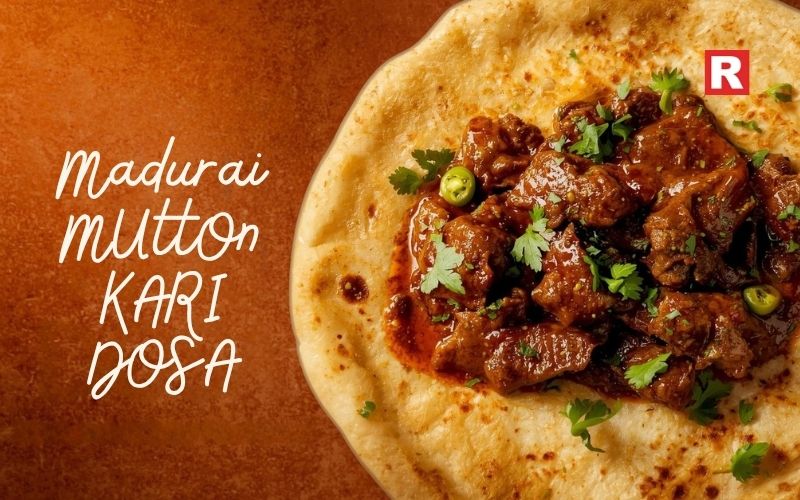
This dish, which originates from the heart of Tamil Nadu, masterfully combines the robust flavor of Chettinad/Madurai-style meat cooking with the crispness of a dosa. A multi-layered, high-protein street food that is anything but mild is the Mutton Kari Dosa.
It begins with a thin, crispy rice-lentil crepe (dosa). A layer of beaten egg, a sprinkle of chopped onions and coriander, and a thick, dry, intensely spicy mutton curry (kari) and minced meat fry are placed on top of the dosa. Fresh gunpowder chili masala, dark aromatic spices, and a generous amount of dried red chilies and pepper in the kari paste are what give it its hot character. This street food is thick, hefty, and extremely spicy, in contrast to the mild, acidic South Indian tastes that can often be found elsewhere.
Why it's fiery: The intense heat of the kari (meat fry), which is created with concentrated red chili paste and dark spices, is the reason it's hot.
Where to find it: Famous Chennai and Madurai street vendors.
What's new: Indian Spice Blends from Restaurant Chefs: Recipes, Techniques & Regional Masalas
5. Pani Puri / Golgappe with Teekha Pani (The Exploding Flavor Bomb)

Perhaps the most famous and attractive Indian street cuisine is pani puri, also called golgappe in North India and puchka in East India. Spiced mashed potatoes or chickpeas are stuffed into small, crispy hollow puris, which are then dipped in a variety of flavored waters. The "teekha pani" (spicy water) is what ignites the fire, even though the other pani are sweet or tart.
Usually, ginger, mint, coriander, black salt, and a lot of green chilies are added to this spicy water. The very best vendors will provide a variety of teekha pani levels, some of which are so hot that they instantly clear your sinuses. Any spice enthusiast will experience an adrenaline surge when they put the entire puri into their mouth and feel the crunch of the chilly potato followed by the explosion of sour, intensely spicy water. Long after the puri is gone, there is still a tingling sense from the quick, intense heat.
Why it's fiery: The "teekha pani" has a lot of green chilies along with some red chili powder.
Where to find it: It is widely distributed across India. For the ultimate challenge, request "extra teekha" pani.
6. Chilli Chicken / Chilli Paneer (Indo-Chinese Firepower)

Despite coming from the vibrant Indo-Chinese culinary mix, street snacks like chilli chicken and its vegetarian equivalent, chilli paneer, remain common throughout India, particularly in cities. These foods combine sour, sweet, and—above all—spicy tastes in a magnificent harmony.
After batter-frying chicken or paneer (cottage cheese) cubes until crispy, they are mixed in a wok with a ton of chopped green chilies, bell peppers, onions, garlic, ginger, soy sauce, and frequently a unique mixture of chili sauces. Due to the vendor's generous use of dried red chili flakes and green chilies, street-style versions are frequently far hotter than their restaurant equivalents. Even though your mouth is burning, you can't resist reaching for another mouthful because of how intense, instantaneous, and highly addictive the heat is.
Why it's fiery: Abundant use of fresh green chilies, dried red chilies, and chili sauces.
Where to find it: Popular across all major Indian cities, look for Indo-Chinese street food stalls.
Check out: 5 Indian Spices You Should Never Skip in Daily Cooking
10 Pizza Without Onion and Garlic
7. The Fiery Drink Challenge: Fuljar Soda (A Viral Volcano)

The Fuljar Soda, India's most intense and very spicy street beverage, deserves a place on this list even if the other items are food. This drink, which originated in Kerala and is rapidly becoming popular throughout India, is a literal bomb of flavor and fire.
The entire process is simple but effective: A strong mixture consisting of crushed raw green chilies, ginger, mint, sabja (basil) seeds, and a secret blend of strong spices is stuffed into a tiny shot glass. After that, this shot is "fuljar-ed"—or dropped—into a tall glass of ice-cold soda water. As a result of the reaction, the drink overflows and fizzes forcefully, requiring a single, continuous sip to avoid losing its fizz. The raw, sharp, and flaming heat of the crushed ginger and green chilies swiftly overcomes the first chill, creating a memorable, nose-clearing challenge.
Why it's fiery: Strong ginger paste and raw, crushed green chilies that are rapidly consumed.
Warning: This is a strong drink that should be taken all at once.
Tips for the Adventurous Eater:
- Neutralize the Heat: Avoid using water to neutralize the heat. Water is not going to help because capsaicin is an oil-based substance. Keep a chilled dairy product on hand at all times. The best remedy is a teaspoon of plain yogurt (dahi), buttermilk (chaas), or lassi (yogurt drink).
- Order Smartly: Request "kam teekha" (less hot) from the vendor if you're not sure. To make sure you receive the spiciest version from the seller, ask for "aur teekha" (more spicy) if you're feeling really bold!
- Trust the Crowd: A long line at a street stand indicates authenticity, quality, and frequently an appropriate level of fire.
Read this: 5 Easy Ways to Make Wheatgrass Juice at Home
Conquering the Flames
Although it takes some planning, exploring India's spicy street food is a wonderful experience. Indian food is characterized by its remarkable depth of flavor, even if these dishes promise a lot of spice. India is known for its strong and unrestrained tastes, which are represented by these six dishes and one spicy beverage. For anybody looking for a genuine sense of India's fiery and lively soul, they provide a tasty and thrilling challenge that goes beyond simple fast food. Go On! The spice is yours to conquer!
Disclaimer: This article is intended for general informational purposes only and should not be considered a substitute for professional medical advice, diagnosis, or treatment. Readers are advised to consult a qualified healthcare professional before making any dietary, health, or lifestyle changes.

A journey through history, tradition, and authentic flavours of India’s ‘Rice Bowl.’ Chhattisgarh, often called the ‘Rice Bowl of India,’ is a state where food is more than just nourishment. It is a reflection of community living, natural abundance, and centuries-old culinary practices. The cuisine of this region blends royal influences with tribal wisdom, using ingredients sourced from fields and forests. Rice, millets, lentils, and locally grown vegetables are at the heart of most dishes. The cooking methods are simple, often involving steaming, fermenting, or slow cooking, which brings out deep, earthy flavours.
Whether it is a festive sweet, a humble steamed snack, or a spicy curry, every dish in Chhattisgarh carries a story. Below are seven famous dishes from this region, each with a distinct history, preparation style, and flavour that defines the cultural identity of the state.
Read more: 5 Cities That Serve the Best Non-Vegetarian Street Food
10 Awadhi Cuisine Classics You Must Try at Least Once
Chhattisgarh’s Culinary Culture
The food of Chhattisgarh reflects the land and the people. Tribal communities have shaped the cuisine through their use of forest ingredients, local grains, and traditional cooking methods. Most dishes use minimal oil, rely on steaming or slow cooking, and make full use of seasonal produce.
Rice is a staple ingredient because of the state’s fertile plains and abundant rainfall. Millets like kodo and kutki are also used, especially in tribal areas. The focus on simple ingredients and natural flavours makes this cuisine both healthy and sustainable. Many of these dishes are naturally gluten-free and vegan, which makes them relevant to modern food trends as well. Let’s explore!
1. Chana Samosa
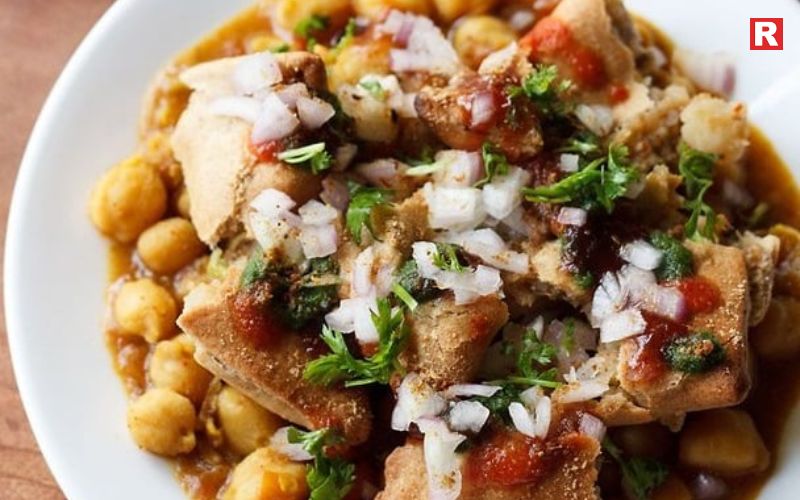
This popular street food gives the classic samosa a local twist. Instead of the usual potato filling, Chhattisgarh’s version is packed with spicy boiled chana (chickpeas). The origins of this dish are linked to the bustling local markets, where vendors wanted to create a filling and affordable snack. The boiled chickpeas are cooked with onions, garlic, coriander, and a special masala mix that gives the samosa its bold flavour. The crisp outer shell contrasts beautifully with the soft and spiced filling.
Chana Samosa is a favourite among locals during evening tea time. It is often served with tangy tamarind chutney or a thin, spicy gram flour curry poured over it. This combination turns a simple snack into a wholesome street-side meal.
2. Muthia

Muthia is a steamed rice flour dumpling that reflects the tribal roots of Chhattisgarh’s cuisine. Traditionally, farming communities prepared this dish during the busy agricultural season because it is light, easy to make, and energising. The dough is made from rice flour mixed with salt, water, and sometimes mild spices. Small cylindrical shapes are formed and steamed until soft. In some households, the steamed muthias are lightly sautéed with mustard seeds and curry leaves for extra flavour.
Muthia is often served with a simple green chutney or spicy lentil curry. Its mild flavour makes it a versatile dish that can be eaten for breakfast, lunch, or as an evening snack. The steaming process also preserves nutrients, making it a healthy choice.
Know more: 7 Types of Whiskies Everyone Should Try Once
3. Bafauri
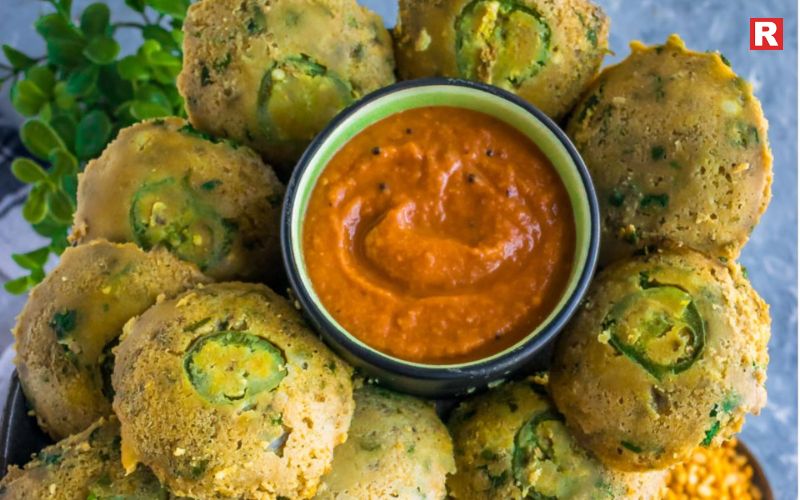
Bafauri is another popular steamed dish, but it uses chana dal (split Bengal gram) instead of rice. It is known for being oil-free and high in protein, which makes it a preferred option during festive fasts and for people who follow traditional diets.
The soaked chana dal is ground into a coarse paste and mixed with spices, chopped onions, coriander, and green chilies. Small balls or patties are shaped and then steamed until firm. Unlike fried snacks, Bafauri retains the natural nutty flavour of dal. This dish is often served with mint chutney or curd. It is a great example of how Chhattisgarh’s cuisine uses minimal ingredients to create wholesome and satisfying food.
4. Faraa
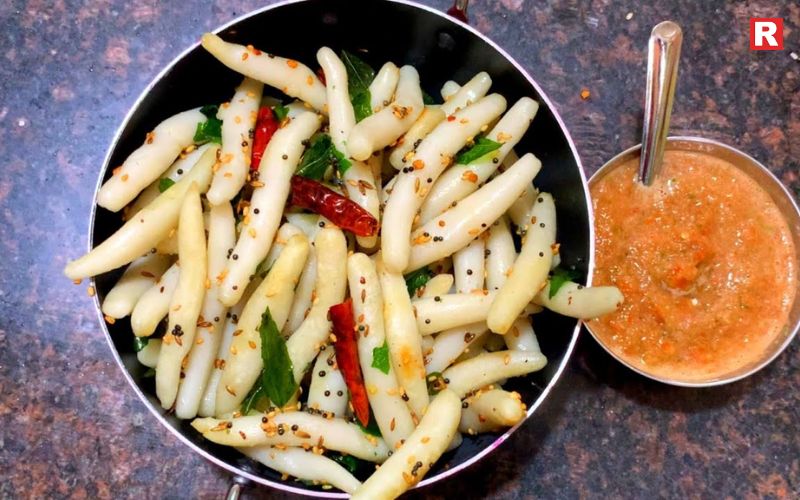
Faraa is often called Chhattisgarh’s version of momos. It is made from rice flour dough shaped into small dumplings and then steamed. The filling can be plain or lightly seasoned with cumin and coriander. Some families also stuff them with spiced lentils for added flavour.
After steaming, the faraa can be eaten as is or shallow-fried with mustard seeds and curry leaves to give it a crisp outer layer. It is usually enjoyed with chutneys made from coriander, garlic, or tamarind. The preparation of faraa is often a community activity. Family members sit together to shape and steam the dumplings, making it a shared experience during festivals and special occasions.
5. Dubki Kadhi
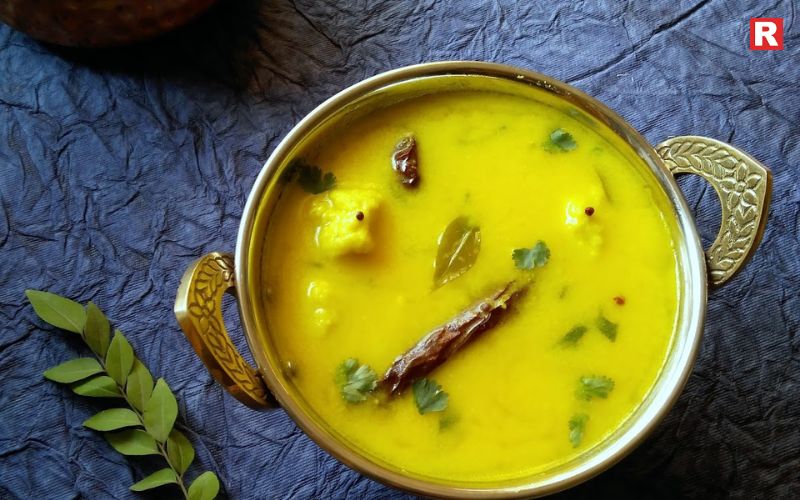
Dubki Kadhi showcases the influence of Marwari settlers on Chhattisgarh’s food culture. Over time, the dish has evolved into a local favourite. This kadhi is made with curd, gram flour, and spices, and has soft pakoras (dubkis) floating in it. The name “dubki” comes from the way the pakoras sink and then rise to the surface as they cook. The kadhi is simmered slowly to develop a tangy and aromatic flavour. Dubki Kadhi is usually served with plain rice or jeera rice. It is a comfort food for many households, especially during the monsoon and winter months.
Also check: 5 Ways to Use Garden Cress Seeds (Halim) for Stronger Hair and Bones
6. Aamat

Aamat is often described as Chhattisgarh’s version of sambhar, but its flavour and ingredients are unique. It is a spicy and slightly sour curry made using bamboo shoots, vegetables, and a spice paste.
Traditionally, Aamat is cooked in clay pots over a wood fire. This method gives the dish an earthy aroma and enhances its taste. The bamboo shoots provide a distinct texture and sourness, while the spice mix creates a warm, lingering flavour. Aamat is usually paired with steamed rice and eaten as a main meal. It reflects the tribal practice of using forest produce to create hearty and flavourful dishes.
7. Tilgur and Thethari Khurma

Sweets are an essential part of Chhattisgarh’s culinary heritage. Tilgur and Thethari Khurma are traditional festive sweets made during weddings and religious celebrations.
Tilgur is made with sesame seeds and jaggery, shaped into balls or bars. It is rich in iron and healthy fats. Thethari Khurma, on the other hand, consists of deep-fried wheat flour strips coated with sugar syrup. The crisp texture and sweet coating make it a popular treat for children and adults alike. These sweets are often prepared in large batches and shared with neighbours and relatives, reflecting the community-oriented nature of the culture.
Check more: 5 Foods to Avoid for Better Cholesterol
Top 5 States With the Spiciest Food in India
7 Healthy Chicken Dishes to Maintain Your Diet
A journey of Rice Bowl!
Exploring the cuisine of Chhattisgarh is like tasting history. Each dish tells a story of fields, forests, festivals, and family traditions. From the crisp Chana Samosa sold in local markets to the earthy flavours of Aamat cooked in clay pots, the variety is both comforting and exciting.
Whether you are a food enthusiast or a curious traveller, trying these dishes offers a window into the heart of India’s lesser-explored culinary landscape. You can start by making simple dishes like Muthia or Bafauri at home, or plan a food trail across Chhattisgarh to taste them in their authentic form. These seven dishes are more than just recipes—they are a living heritage that continues to thrive in kitchens and communities across the state.

Have you seen yourself pondering what to cook for an evening snack while holding a few pieces of bread and staring into the kitchen? In the chaos of a hectic day, bread is frequently the first food we reach for, whether we're balancing a demanding job, running a household, or just satisfying our sudden hunger. It is a delicious blank canvas that is just waiting to be filled. But why limit yourself to a basic sandwich or toast?
This article is for you if you're sick of the same old routine and want to surprise your family or your own taste buds. Our goal is to take you beyond the fundamentals by transforming plain bread into ten innovative, delicious, and very simple snacks.
Read more: Celebrate Durga Puja in Style: Bringing Bengal’s Festive Spirit to Life
Why Get Creative with Bread?
Bread's ease and adaptability are what make it so lovely. It's easy to find, affordable, and ideal for urgent situations. More than that, though, using innovative bread snacks is a great way to:
- Minimize Food Waste: At the end of the week, do you have any leftover slices? Don't discard them! These recipes are ideal for making use of leftover or stale bread.
- Save Time: These snacks are ideal for those sudden hunger pains because they can be prepared in less than 20 minutes.
- Try Different Flavors: Bread may be used as a foundation for about any flavor profile you can think of, from savory and spicy to sweet and crunchy.
Let's get started to improve your snack game.
1. Cheesy Chilli Bread Toasties

This is the ideal option for a quick, cheesy bite and is sure to impress everyone who tastes it. Imagine a creamy, hot cheese mixture on top of a crunchy slice of bread.
- You'll need: Some butter, finely chopped onions and green chillies, shredded cheese (either mozzarella or cheddar), sliced bread, and a dash of black pepper.
- Let's Create It: In a bowl, combine the shredded cheese, black pepper, green chillies, and chopped onions. Toast the bread till browned on one side. Turn the slice over and evenly cover the toasted side with the cheese mixture. Return it to the pan or toaster oven and cook until the cheese is bubbling and melted.
- Chef's Tip: For a pizza-like taste, add a dash of oregano or a few drops of chilli flakes.
2. Spiced Potato & Pea Bread Rolls

This old-fashioned snack goes well with evening tea. These have a crunchy outside and a soft, delicious potato mixture inside.
- You'll need: Bread slices, boiling and mashed potatoes, boiled green peas, finely chopped ginger and green chilies, turmeric, coriander powder, red chilli powder, and frying oil are all necessary.
- Let's Create It: Add the mashed potatoes and spices to the stuffing after the ginger and chilies have been sautéed. Using a rolling pin, flatten out each piece of bread. Roll the bread firmly, seal the edges with a little water, and place a tablespoon of the potato mixture on one end. Deep-fry till crispy and golden brown.
- Chef's Tip: Instead of deep-frying these, you may bake or air-fry them for a healthier option.
Know more: Sip Smart: Hydrating Drinks to Power You Through Navratri Fasting
3. Garlic Herb Breadsticks

Who knew that making crispy breadsticks at home could take just a few minutes? These are delicious and ideal for dipping in creamy dips or ketchup.
- You'll need: dried herbs like parsley and oregano, melted butter, minced garlic, and sliced bread.
- Let's Create It: Slices of bread should be cut into long strips. Combine the dried herbs, minced garlic, and melted butter in a small bowl. Lightly brush the bread strips on all sides with this mixture. Bake them in a frying pan or an oven that has been preheated until they are crispy and brown.
- Chef's Tip: Try a sweet version by substituting honey and cinnamon for the garlic and herbs.
4. Bread Pizza Bites

These little pizzas are really simple to prepare and quite popular with children.
- You'll need: Grated cheese, your preferred toppings (chopped onions, bell peppers, or corn), sliced bread, pizza sauce or ketchup, and a dash of oregano are all necessary.
- Let's Create It: Slices of bread should be cut into tiny squares. Cover each square with a thin layer of pizza sauce. Top with a good amount of cheese and garnish with preferred toppings, including oregano. Bake in a frying pan or oven that has been warmed until the cheese is completely melted and bubbling.
- Chef's Tip: To make bell peppers appear lively and attractive, combine a variety of colors.
5. Crispy Bread Pakoras

A classic snack of every Indian household. We're keeping it easy and tasty instead of using traditional batter.
- You'll need: Bread slices, besan (chickpea flour), red chilli powder, salt, a pinch of turmeric, asafoetida (hing), and frying oil.
- Let's Create It: Combine the besan, water, and spices to make a thick, smooth batter. Slices of bread should be cut into triangles. Make sure to evenly coat each triangle by dipping it in the batter. Slide gently into hot oil and cook until golden and crispy.
- Chef's Tip: To enhance the batter's flavor, add a sprinkle of carom seeds (ajwain) and a small amount of chopped coriander.
What's new: Easy & Delicious Meal Prep Ideas for a Busy Week
6. Mumbai Pav Bhaji Toast

This one will bring the street food of Mumbai into your kitchen. There is a lot of flavor in this quick and sticky snack.
- You'll need: A teaspoon of leftover bhaji or a fast bhaji made with mashed potatoes and veggies, butter, and pav (buns) are required.
- Let's Create It: Melt some butter in a nonstick pan. Put the pav on the buttered pan and give it a quick toast. Now cover one-half of the pav with a thick coating of hot bhaji. Place the other half on top, gently press, and serve right away.
- Chef's Tip: For a taste of real street food, garnish with finely chopped onions and a squeeze of fresh lemon juice.
7. Leftover Roti/Chapati Crisps with Chutney
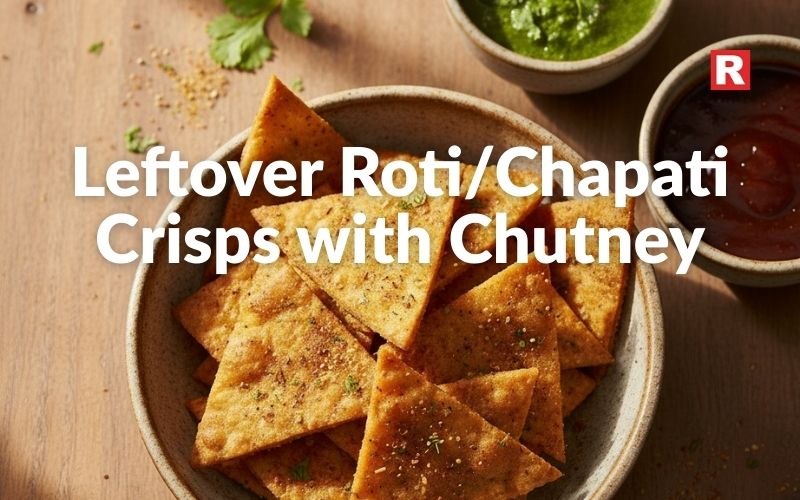
You don't have any bread? No issue! This is the ideal method for utilizing leftover chapatis or rotis.
- You'll need: your preferred chutney (garlic, tamarind, or mint), oil, salt, and leftover rotis.
- Let's Create It: Make little triangles out of the rotis. Sprinkle them with a little salt and lightly oil them. They can be deep-fried for a quick, crunchy snack, pan-roasted until crispy, or baked in an oven.
- Chef's Tip: To give them a tangy, chatpata taste, sprinkle them with a little chaat masala.
8. Bread Upma

This is a delicious, flavorful breakfast or snack that comes together quickly. It's an excellent method of using up stale bread.
- You'll Need: Bread cubes, chopped tomatoes, onions, curry leaves, mustard seeds, turmeric, and green.
- Let's Create It: Curry leaves and mustard seeds should be fried in a pan. Add the green chilies and onions. Add chopped tomatoes and spices once it's soft. Add the bread cubes after thoroughly mixing. Cook until the bread is tender and has absorbed all of the flavor.
- Chef's Tip: For a delicious crunch, add a handful of roasted cashews or peanuts.
Check out: Best White Bread Brands in India
Top Navratri Dishes You Can Relish Without Guilt
9. Sweet Bread Pudding Cups

Who said only savory bread snacks can be made with bread? This is a sweet treat or a simple, cozy dessert.
- You'll need: Bread cubes, milk, sugar, a small amount of cardamom powder (elaichi), and a few raisins.
- Let's Create It: Soak the bread cubes in warm milk in a bowl until they become mushy. Add the raisins, cardamom powder, and sugar. Transfer the mixture into tiny bowls or cups that are safe to put in the oven, and bake until the top is firm and golden.
- Chef's Tip: For added sweetness, drizzle with honey or condensed milk after baking.
10. Paneer Bhurji Stuffed Bread Pockets

A filling snack that has the texture and richness of a full dinner. They make a filling evening snack and are ideal for lunchboxes.
- You'll need: Bread pieces, paneer bhurji (scrambled paneer with vegetables and spices), and toasting oil.
- Let's Create It: Get your paneer bhurji ready. Using a rolling pin, flatten the bread pieces after cutting off the crusts. Put a teaspoon of paneer bhurji in the middle, fold the bread into a pocket, and use a little water to seal the corners. Put a little oil in a pan and toast the pockets until they are brown and crispy.
- Chef's Tip: To give the paneer bhurji an extra-creamy texture, add additional grated cheese.
Read this: 5 Timeless Indian Sweets That Rule Every Celebration
A Few Final Tips for Your Kitchen
- Prepare ahead: prep in advance by chopping your vegetables and grating your cheese. To make assembly even quicker, store them in sealed containers.
- Master the Pan: If you don't have a fancy oven, don't panic; many of these recipes can be prepared on a basic non-stick pan.
- Engage the Family: Even children can assist with these because they are so easy. Watch them gobble up these small snacks and make it an enjoyable pastime.
Conclusion
Think beyond the box the next time you see that loaf of bread. You can turn it into a variety of tasty, easy, and entertaining snacks with a little imagination and a few basic items from your kitchen. Bread is your key to a world of creative cooking possibilities, from the comforting sweetness of a pudding cup to the spicy crunch of a bread roll. So go ahead, take a chance, and turn your kitchen into a center of delicious creativity.

Navratri is one of the most celebrated festivals in India. For nine days, many people fast as a way to cleanse the body and mind. While fasting brings discipline and devotion, it can also make you feel tired, dizzy, or drained if your body is not properly hydrated.
During fasting, our food and liquid intake often changes. Many of us avoid grains, regular salt, and heavy meals. This shift can cause dehydration if we do not pay attention to what we drink. The good news is that Navratri allows several natural, sattvik-friendly drinks that keep you energized and refreshed throughout the day. In this guide, we’ll look at the best hydrating beverages for Navratri fasting, their benefits, and some practical tips to stay active and fresh.
Read more: Pani Puri Has Different Names in Different Indian States—Know Them All
These 7 Foods Can Help You Cool Your Stomach in Summer
Why Hydration Matters During Navratri
When you fast, your body gets fewer meals than usual. This means fewer chances of getting fluids from food. At the same time, your body continues to lose water through sweating, urination, and even breathing.
Without enough water or hydrating drinks, you may feel:
- Headaches or lightheadedness
- Fatigue and low energy
- Indigestion or acidity
- Dry skin or dullness
Staying hydrated helps regulate body temperature, keeps digestion smooth, and prevents weakness. It also helps you enjoy the festival without feeling worn out.
Find the Hydration Heroes
Here are some healthy, sattvik-approved beverages that not only quench your thirst but also nourish your body.
1. Coconut Water – Nature’s Energy Booster

Coconut water is one of the purest natural drinks for Navratri fasting. It is light, sweet, and refreshing. The drink is filled with potassium and minerals that keep the body active. When people fast, they often feel weak or tired. Coconut water helps fight this fatigue. It also restores the electrolytes that are lost through sweat. Unlike heavy drinks, it never makes the stomach feel full or uneasy. It is gentle and easy to digest. Many prefer drinking it in the morning or afternoon for a quick lift. Its cooling nature keeps the body calm. For long fasting hours, coconut water works like a natural shield against tiredness. It is truly a simple, sattvik drink for energy and hydration.
Why choose it?
- Keeps you hydrated without heaviness
- Balances electrolytes and prevents cramps
- Helps beat fatigue during long fasting hours
2. Buttermilk (Chaas) – Cooling & Digestive
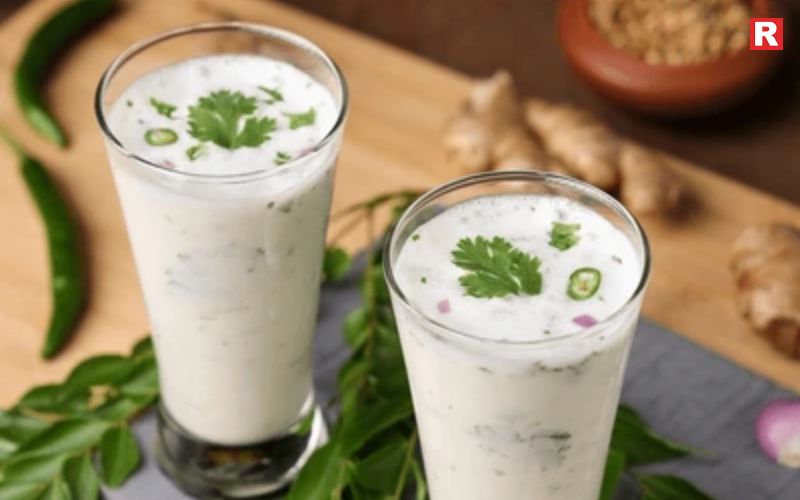
Buttermilk is another popular choice during Navratri fasting. Made by mixing curd with water, it is light yet filling. Many people feel heaviness after their fasting meals. Buttermilk helps ease that discomfort. It keeps the stomach cool and supports digestion. A pinch of roasted cumin or rock salt makes it tastier and sattvik. Its natural cooling effect is helpful in warm weather when dehydration is common. Unlike carbonated drinks, buttermilk never harms the stomach. It keeps acidity under control and prevents bloating. For people who want a soothing drink that is also healthy, buttermilk is perfect. Taken in the afternoon, it refreshes the body and mind. Simple, cooling, and nourishing, it is one of the safest drinks for fasting.
Why choose it?
- Prevents acidity during fasting
- Keeps the body cool in warm weather
- Boosts digestion naturally
Know more: 12 Delicious High-Protein Foods to Eat Daily for a Healthier You
3. Lemon Water with Honey – Quick Refreshment

Lemon water with honey is a simple yet powerful fasting drink. It is easy to prepare and refreshing to taste. Lemon provides Vitamin C, which improves immunity. Honey works as a natural energy booster. Together, they create a drink that fights fatigue during fasting hours. Many people drink it in the morning or evening for a quick lift. It helps in digestion and keeps constipation away. The drink also prevents dehydration by restoring fluids. It is light on the stomach, unlike heavy fruit juices. The natural sweetness of honey makes it enjoyable without refined sugar. Lemon water with honey is a trusted way to stay fresh, hydrated, and active while fasting. It brings both energy and health benefits.
Why choose it?
- Refreshes instantly
- Keeps you energetic during fasting hours
- Improves digestion and prevents constipation
4. Herbal Teas – Gentle & Soothing

Herbal teas are a smart choice during Navratri fasting. They replace regular tea or coffee in a healthy way. Teas made from tulsi, ginger, mint, or cinnamon are gentle on the stomach. They do not have caffeine, which often causes dehydration. Instead, they hydrate the body and provide calmness. Herbal teas also improve digestion and reduce bloating. Tulsi strengthens immunity, while ginger eases discomfort. Mint adds freshness, and cinnamon helps balance the body. Many people drink herbal teas in the evening to relax after fasting. Warm and soothing, they create comfort for both body and mind. Herbal teas are sattvik-friendly and natural. They are a safe and healing option for those who want light yet hydrating drinks during Navratri.
Why choose it?
- Caffeine-free alternative to regular tea
- Helps with digestion and bloating
- Strengthens immunity naturally
5. Fresh Fruit Juices – Natural Sweetness

Fresh fruit juices are loved during fasting for their natural taste and health benefits. Fruits like apple, pomegranate, and watermelon are rich in water and nutrients. When juiced, they provide instant hydration. Unlike packaged juices, fresh ones have no added sugar or preservatives. They are filled with natural vitamins, minerals, and antioxidants. These juices keep the body refreshed and active during long fasting hours. Pomegranate juice boosts energy, while watermelon cools the body. Apple juice provides gentle sweetness without heaviness. They are best taken in the daytime when energy dips. Fresh juices are also good for skin health, adding glow and freshness. They are light, tasty, and filling. For a natural dose of hydration, fruit juices are a perfect choice.
Why choose it?
- Hydrates and refreshes
- Gives instant natural energy
- Rich in antioxidants for skin glow
6. Smoothies with Yogurt & Fruits
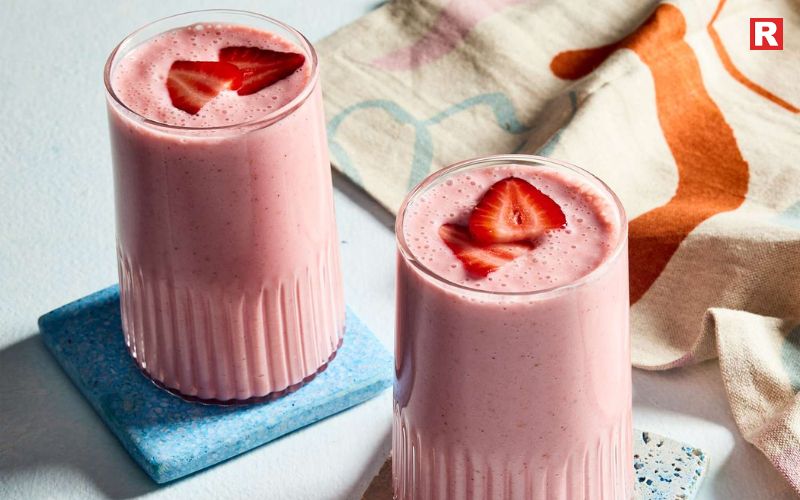
Smoothies are a filling and hydrating drink during Navratri fasting. They are made by blending yogurt with fruits like banana, apple, or papaya. This makes a thick and creamy drink. Smoothies combine hydration with nutrition in one glass. Yogurt provides protein and probiotics that support digestion. Fruits add vitamins, minerals, and natural sweetness. Together, they keep the stomach full for longer hours. Smoothies are especially helpful in the evening after breaking the fast. They give energy and are easy to digest. Unlike heavy foods, they never cause discomfort. Smoothies are also versatile, as they can be made with different fruits. They are simple, tasty, and wholesome. For those who want both hydration and nourishment, smoothies are a great option.
Why choose it?
- Combines hydration with nutrition
- A filling option for suhoor or evening meals
- Good source of protein and probiotics
Also check: 6 Unexpected Benefits of Eating Jackfruit (Kathal) – Nature’s Spiky Surprise!
7. Warm Milk with Cardamom or Saffron
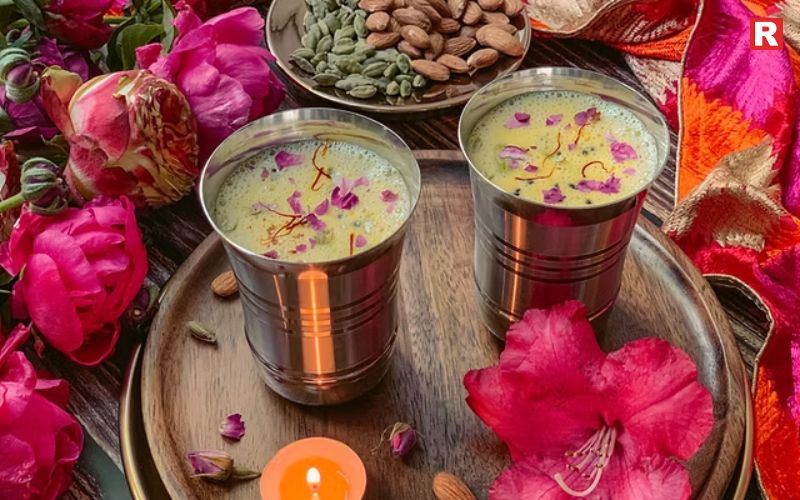
Warm milk with cardamom or saffron is a traditional drink during fasting. It is soothing, nourishing, and calming. Milk provides calcium and protein, which strengthen the body. Adding cardamom makes it fragrant and helps in digestion. Saffron brings warmth and improves mood. This drink is best taken at night before sleep. It keeps the stomach full and prevents midnight hunger. The calming effect of warm milk helps the body relax after a day of fasting. Unlike caffeinated drinks, it does not disturb sleep. Instead, it supports rest and recovery. Many families use this drink as a ritual during festivals. It is simple yet powerful in its benefits. Warm, comforting, and nutritious, it completes a healthy fasting routine with ease.
Why choose it?
- Keeps you full at night
- Helps relax the body
- Strengthens bones and immunity
Smart Tips to Stay Hydrated During Navratri
Drinks are important, but how you consume them matters too. Here are some practical hydration tips:
- Sip, Don’t Gulp – Drink water in small sips regularly instead of drinking large amounts at once.
- Choose Fresh Over Packed – Avoid packed juices and aerated drinks, as they often contain sugar and preservatives.
- Limit Caffeine – Too much tea or coffee causes dehydration. Replace with herbal teas.
- Include Hydrating Fruits – Watermelon, cucumber, oranges, and papaya are great choices during Navratri.
- Listen to Your Body – Don’t wait until you feel thirsty. Thirst is already a sign of dehydration.
Check more: Pouring Festive Cheer: Beers & Spirits Winning Consumer Carts This Season
5 Delicious Snacks to Enjoy This Navratri Season
10 Must-Try Goan Dishes That Define Its Rich Food Culture
A Quick Drinks Guide for Navratri
Drink | Key Benefit | Best Time to Have |
|---|---|---|
Coconut Water | Replenishes electrolytes | Morning or post-afternoon |
Buttermilk | Cooling and aids digestion | Afternoon |
Lemon Honey Water | Refreshing, boosts energy | Mid-morning or evening |
Herbal Tea | Caffeine-free, soothing | Evening |
Fresh Juice | Natural sugars, antioxidants | Midday |
Smoothie | Filling and nutritious | Evening |
Warm Milk | Relaxing, improves sleep | Night |
Happy Fasting!
Navratri fasting is not only a spiritual practice but also a way to refresh the body. When done correctly, it can improve both health and energy. While people often focus on what foods to eat during fasting, drinks are equally important. Proper hydration keeps the body active and prevents fatigue. It also supports digestion and helps maintain a clear mind throughout the day.
Choosing the right drinks can make fasting easier and more enjoyable. Coconut water, buttermilk, herbal teas, fruit juices, and smoothies are all excellent choices. Each of these beverages provides hydration, energy, and essential nutrients. Drinking them at the right time ensures that the body stays balanced during fasting hours. It is important to sip water and other drinks regularly. Listening to the body’s needs and staying consistent with fluids is key. With proper hydration, fasting becomes a smooth, healthy, and fulfilling experience.
Disclaimer: This article is intended for general informational purposes only and should not be considered a substitute for professional medical advice, diagnosis, or treatment. Readers are advised to consult a qualified healthcare professional before making any dietary, health, or lifestyle changes. Persons with diabetes/specific allergies/special conditions are advised to follow their doctor's advice.

Navratri is one of the most celebrated festivals in India. It is a time of devotion, dance, and family gatherings. Food plays an important role in bringing people together during these nine days. Many people observe fasts to cleanse their body and mind. Fasting during Navratri is not about eating less. It is about eating right, choosing clean and wholesome foods, and enjoying tasty sattvik dishes. Fasting foods during Navratri are full of flavour, energy, and nutrition. They are carefully prepared to follow fasting rules, but they do not compromise on taste. From crunchy pakoras to light khichdis and creamy desserts, there are many options to try. These dishes help keep energy levels steady throughout the day. They are also easy to digest and nourishing for the body.
Families often look forward to traditional recipes that are passed down through generations. Sabudana khichdi, kuttu ki poori, makhana kheer, and rajgira ladoos are some of the popular choices. Each dish has its own benefits and brings joy to the meal. Navratri fasting food is not a restriction; it is a way to celebrate purity, taste, and health. Here is a list of top tasty fasting dishes you can eat this Navratri, along with why they are popular and how they benefit your health.
Read more: 5 Delicious Snacks to Enjoy This Navratri Season
Top 7 Regional Indian Thali Platters That Showcase Culinary Diversity
1. Sabudana Khichdi – Light and Filling

Sabudana Khichdi is the most popular fasting dish in India. Made with sago pearls, peanuts, green chillies, and sendha namak (rock salt), it is both light and filling. The peanuts add a nutty crunch while the sabudana gives you instant energy.
This dish is often eaten in the morning because it keeps you full for hours. It is gluten-free, easy to digest, and provides the right balance of carbs and proteins. Many families also add boiled potatoes for extra taste. If you want comfort food while fasting, this is your go-to dish.
2. Kuttu Ki Poori – Crisp and Comforting
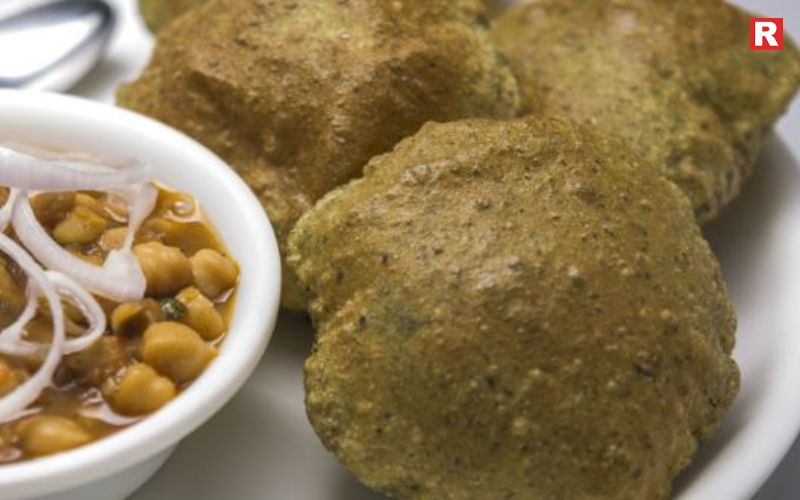
Kuttu or buckwheat flour is a staple during Navratri. Kuttu ki Poori is a deep-fried delight made with this flour. It is usually paired with aloo sabzi or pumpkin curry.
The best part about kuttu flour is that it is rich in fiber and keeps your digestion strong during fasting. It also helps in controlling blood sugar levels. These pooris are crisp, tasty, and perfect for a hearty Navratri meal.
Know more: 10 Steamed Indian Dishes Beyond Idli & Dhokla
3. Singhare Ke Pakode – Crispy and Addictive

If you are craving something crunchy, Singhare ke Pakode is the answer. Made with water chestnut flour and boiled potatoes, these fritters are fried until golden and crispy.
They are often enjoyed with green chutney or plain curd. Since water chestnut is packed with minerals like potassium and antioxidants, these pakoras are not just tasty but also healthy. They make a perfect evening snack when hunger strikes during fasting.
4. Samak Rice Pulao – Wholesome and Nutritious
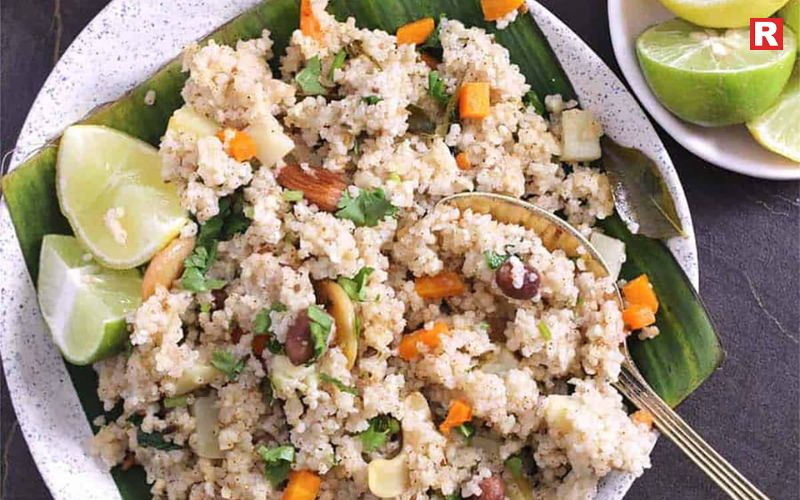
Many people miss rice during Navratri, but samak rice (also called vrat ke chawal or barnyard millet) is a great replacement. Samak rice pulao is made with vegetables like carrots, beans, or peas along with mild spices.
It is light, non-sticky, and easy to digest. Samak rice is high in fiber and low in calories, making it a healthy option if you are trying to keep your meals balanced. This dish tastes great with plain curd or raita.
5. Makhana Kheer – Sweet and Creamy
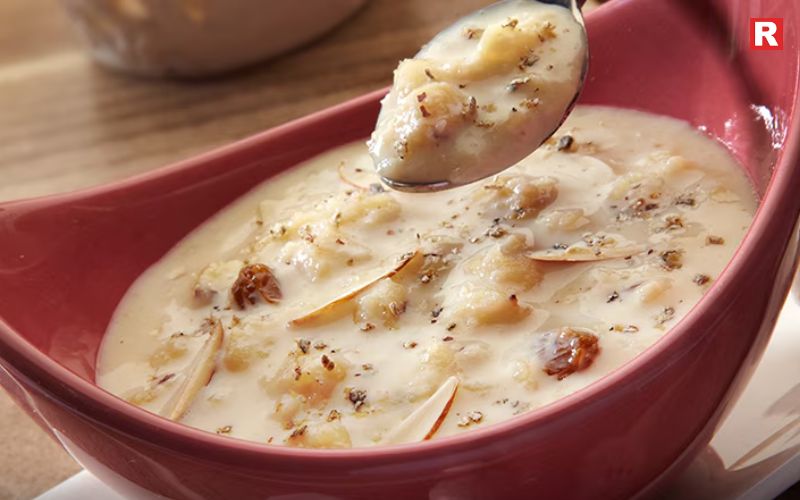
No festival is complete without a sweet dish. Makhana Kheer is a traditional fasting dessert made with foxnuts, milk, sugar, and dry fruits. It is creamy, rich, and loaded with nutrients.
Makhana (foxnuts) is known for its high protein and low-calorie content. It also has anti-aging properties and is great for your skin. This dish is often served as prasad during Navratri. If you love desserts, this one will make your fasting special.
6. Aloo Tamatar Sabzi – Tangy and Spicy
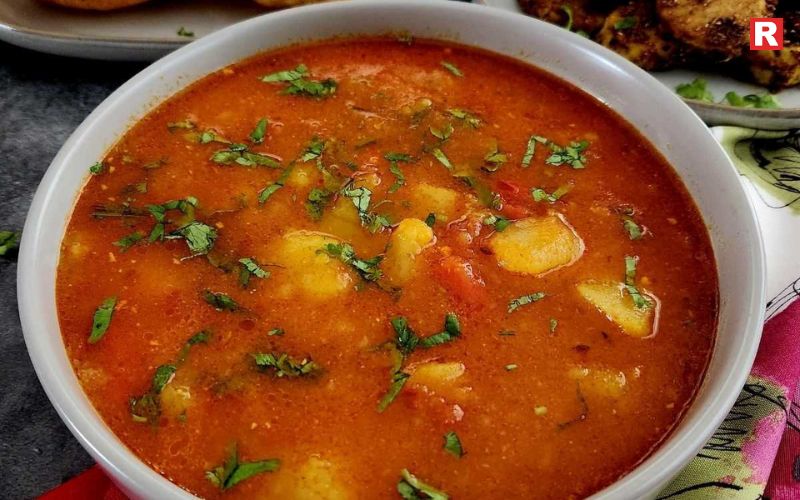
Aloo Tamatar Sabzi is one of the simplest yet most satisfying fasting dishes. Made with boiled potatoes, fresh tomatoes, and rock salt, it is tangy, spicy, and comforting.
This dish pairs perfectly with kuttu ki poori or samak rice. Since potatoes are rich in carbs, they keep you full and energetic throughout the day. It is a quick recipe that can be made in less than 20 minutes, making it a family favourite.
Also check: Festive Seasons Are Changing the Restaurant Industry in India
7. Rajgira Ladoo – Healthy Sweet Bites

Rajgira or amaranth seeds are another fasting staple. Rajgira Ladoo is made by mixing roasted amaranth seeds with jaggery. It is crunchy, sweet, and full of energy.
These ladoos are often prepared in advance and stored for snacking during the nine days. Rajgira is rich in iron and calcium, making it excellent for bone health. A small ladoo gives you a power-packed dose of nutrition while keeping your sweet cravings satisfied.
Why Navratri Fasting Foods Are Healthy
Many people think fasting is only about rituals. But there is a scientific reason behind the Navratri diet. The dishes allowed during these days are sattvik, which means they are clean, pure, and natural.
Here are some benefits:
- They are rich in fiber, protein, and antioxidants.
- They help detoxify the body and improve digestion.
- They balance energy levels and prevent bloating.
- They replace refined grains with millets and flours like buckwheat and amaranth, which are healthier.
When followed correctly, Navratri fasting can actually make your body feel lighter and more energetic.
Check more: The Top 7 Sweet Dishes You Can’t Miss This Durga Puja
Frankenstein-Inspired Foods and Drinks for Your Spooky Celebrations
12 Delicious High-Protein Foods to Eat Daily for a Healthier You
Tips to Make Fasting Delicious and Healthy
- Use sendha namak instead of regular salt. It is less processed and better for your body.
- Avoid refined sugar. Use jaggery, honey, or dates for sweetness.
- Add dry fruits like almonds, walnuts, and raisins to your meals for extra energy.
- Drink coconut water, buttermilk, and fresh juices to stay hydrated.
- Do not over-fry everything. Try roasting or shallow frying to keep meals light.
By making small changes, you can enjoy fasting foods without worrying about health issues.
Happy Fasting!
Navratri fasting is not just about avoiding certain foods. It is about eating in a pure and balanced way. People can enjoy a variety of dishes that are both tasty and healthy. Sabudana khichdi, made with sago and peanuts, provides energy and keeps the stomach full. Kuttu ki poori with aloo sabzi is filling and light at the same time. Makhana kheer and rajgira ladoos offer sweet treats without harming the fast. These dishes are rich in nutrients and easy to digest. Fasting gives people a chance to explore traditional recipes. It encourages trying new combinations and ingredients. Families often gather in the kitchen, preparing meals together. This creates warmth and memories that last beyond the festival. Navratri fasting can be simple, healthy, and enjoyable. When planned well, it feels like a celebration of food rather than a restriction.

When it comes to pizza in India, Domino’s is the first name that comes to mind. For years, it has been a part of everyday life. From family get-togethers to late-night hunger, Domino’s has always been there. The brand is known for quick delivery, affordable prices, and a wide range of options. It has become more than a place to order food. For many people, it is comfort food that brings joy. Domino’s has managed to win hearts by offering pizzas that suit every mood. The menu has something for everyone. From classic Margherita to loaded chicken specials, the choices are endless. Vegetarians have just as many delicious options. The cheese burst crust has become a favorite for those who love extra indulgence.
Over time, Domino’s has also adapted to Indian tastes. Pizzas like Peppy Paneer and Chicken Tikka show how the brand understands local flavors. This mix of global style and Indian touch makes it special. With so many pizzas on the menu, one question always remains. Which ones are truly worth trying? That is where the best picks stand out.
Read more: 10 Must-Try Goan Dishes That Define Its Rich Food Culture
Domino’s 4-Course Meal— The Ultimate Lunch Deal You Can’t Miss
Why Domino’s is Everyone’s Favorite
Domino’s is loved across India for many reasons. First, the taste is consistent no matter where you order from. Second, the prices are pocket-friendly, making it easy to enjoy pizzas regularly. Third, the delivery service is fast and reliable, which makes it perfect for both busy weekdays and relaxed weekends.
What makes Domino’s stand out is its ability to bring global pizza flavors and mix them with Indian tastes. You can enjoy classic Italian flavors as well as spicy desi twists. The variety of crusts—classic hand-tossed, wheat thin, pan, and the famous cheese burst—also makes Domino’s unique. On top of that, you can customize your pizza with extra toppings or add-on sides.
Discover Top Domino’s Pizzas To Try
In this article, we will take you through the must-try Domino’s pizzas that have won millions of hearts. Whether you love cheese, spice, or meat, there is a slice waiting for you.
1. Margherita Pizza

The Margherita is a classic for a reason. It is simple, made with fresh tomato sauce, gooey mozzarella cheese, and herbs. If you are new to Domino’s or want something light yet tasty, this is a safe and satisfying choice.
2. Peppy Paneer

For those who like Indian flavors, Peppy Paneer is a delight. Loaded with paneer cubes, crunchy capsicum, and spicy seasoning, it is a pizza that gives you a punch of taste in every bite. As someone who loves paneer dishes, this is one of my personal favorites.
3. Chicken Dominator

If you are a non-veg lover, the Chicken Dominator is made for you. It is fully packed with different types of chicken toppings—roasted, spicy, and grilled. Every slice feels hearty and filling. I remember ordering this once during a movie night, and it easily became the star of the evening.
4. Veg Extravaganza

Sometimes, a pizza feels complete only when it has all the toppings. That is where Veg Extravaganza comes in. It has onions, capsicum, mushrooms, black olives, corn, and more. It is colorful, flavorful, and filling. Vegetarians often call this their go-to pizza because it has everything in one.
Know more: Pani Puri Has Different Names in Different Indian States—Know Them All
5. Cheese Burst Pizza

This is not just a pizza—it is an experience. The Cheese Burst crust is filled with molten cheese that oozes out when you bite into it. For cheese lovers, this is nothing less than heaven. It is indulgent, rich, and unforgettable.
6. Indi Tandoori Paneer / Chicken Tikka Pizza

These pizzas show how Domino’s understands Indian taste buds. The Indi Tandoori Paneer has smoky paneer with spicy seasoning, while the Chicken Tikka version has marinated chicken pieces with a desi touch. If you love Indian spices, these are a must-try.
7. Farmhouse Pizza

The Farmhouse pizza brings a fresh, garden feel to your plate. With onions, capsicum, tomatoes, and mushrooms, it is light yet filling. I personally like it because it feels healthier compared to other pizzas, without compromising on taste.
More Than Just Pizza: Domino’s Must-Haves
Domino’s is not only about pizza. Some of its sides and desserts have become just as popular as the main menu.
- Garlic Breadsticks – Soft, buttery, and perfect with cheese dip. Many people order these just as eagerly as pizzas.
- Taco Mexicana – Unique to Domino’s in India, this is a fusion snack that mixes Mexican style with Indian flavors.
- Choco Lava Cake – A warm, gooey dessert that melts in your mouth. Many customers admit that they look forward to this as much as the pizza itself.
These extras complete the Domino’s experience and make it a one-stop solution for meals and snacks.
Also read: Top 5 States With the Spiciest Food in India
What Makes These Pizzas Stand Out
The secret of Domino’s pizzas lies in the balance of flavors. The sauces are tangy and spiced just right. The cheese is always fresh and stretchy. The toppings are evenly spread so that every slice feels satisfying.
Another reason people love Domino’s is its variety of crusts. While many stick to the classic hand-tossed base, the wheat thin crust is a good option for those who want something lighter. And of course, the cheese burst crust remains a fan favorite.
Domino’s has also managed to adapt its menu for Indian customers. Flavors like Paneer Tikka, Chicken Keema, and Tandoori toppings are not something you usually find in international pizza chains. This local touch has made Domino’s connect strongly with Indian food lovers.
Check more: High Protein Indian Meals You Should Try
Top 7 Regional Indian Thali Platters That Showcase Culinary Diversity
10 Steamed Indian Dishes Beyond Idli & Dhokla
Final Thoughts
Domino’s has built its reputation on taste, speed, and affordability. With options for vegetarians, meat lovers, spice seekers, and cheese fans, there is truly something for everyone. The pizzas listed above are the ones you simply cannot miss. From the simple Margherita to the indulgent Cheese Burst, each one has a story to tell.
Next time you order, try one of these must-try pizzas. Pair it with garlic bread and end with a Choco Lava Cake. You will realize why Domino’s is not just about eating—it is about creating small moments of happiness. Because no matter your mood, there is always a Domino’s pizza waiting to cheer you up.

The festive season is a time of joy, celebrations, and togetherness. People often stay up late, eat rich food, and spend time with family and friends. While it’s fun, it can also leave the body tired and the skin looking dull. The skin needs extra care during this time. What a person drinks plays a big role in keeping the skin healthy. Drinking the right fluids helps the body stay hydrated. It also helps reduce inflammation and supports skin repair. This keeps the skin fresh, soft, and glowing. Simple and natural drinks can make a big difference. They provide essential vitamins, minerals, and antioxidants. These nutrients help the skin stay firm and radiant. Adding such drinks to a daily routine is easy. They don’t require special ingredients or hard steps.
By drinking healthy beverages regularly, the body gets the support it needs. The skin looks brighter and feels better. A few small changes can lead to noticeable results. These drinks are a simple way to help anyone look and feel their best throughout the festive season. Taking care of the skin starts from within.
Read more: 6 Benefits of Drinking Black Coffee
12 Delicious High-Protein Foods to Eat Daily for a Healthier You
Why Drinks Matter for Skin Health
Your skin is your body’s largest organ. It needs water, vitamins, and minerals to stay soft, smooth, and glowing. Many skin problems, like dryness, puffiness, and breakouts, can happen when you don’t drink enough fluids or eat unhealthy food. Drinks with natural ingredients like fruits, herbs, and seeds can boost your skin’s health. They supply your body with essential nutrients, antioxidants, and hydration. These drinks also support digestion, reduce inflammation, and help your body remove toxins.
Let’s look at the best drinks that can give you a festive glow while keeping you refreshed.
1. Lemon and Honey Detox Water

Lemon and honey detox water is one of the simplest yet most powerful drinks for glowing skin. Lemon is full of vitamin C, which helps your body produce collagen. Collagen keeps your skin firm and smooth. Honey is a natural humectant. It locks in moisture and heals dry skin. You can make this drink by adding half a lemon’s juice and a teaspoon of honey to a glass of lukewarm water. Drink it in the morning or between meals. For an extra boost, add a pinch of turmeric powder. Turmeric has anti-inflammatory properties that calm irritated skin. This simple drink helps flush out toxins and keeps your skin hydrated throughout the day.
2. Coconut Water with Mint and Basil

Coconut water is a natural hydrator. It is rich in electrolytes like potassium and magnesium. These help your body stay hydrated, which is essential for soft and plump skin. Mint adds a cooling effect and helps with digestion. Basil is full of antioxidants that support detoxification. Together, they make a refreshing drink that keeps your skin fresh and radiant. Mix a glass of coconut water with a few mint leaves and crushed basil. Drink it after a workout or when you spend long hours outdoors in the sun. This drink not only keeps you cool but also helps your skin retain moisture, making it look healthy and glowing.
Know more: Pani Puri Has Different Names in Different Indian States—Know Them All
3. Aloe Vera Juice with Cucumber

Aloe vera is known for its healing properties. It helps soothe and repair the skin. It also supports hydration from inside. Cucumber adds extra moisture and helps reduce puffiness. It is rich in water content and vitamins that nourish your skin. Blend fresh aloe vera gel with cucumber slices and a little water. You can also add a few drops of rose water for a floral scent and additional skin benefits. Drink this in the afternoon or before bed to relax and rejuvenate your skin. It helps in reducing inflammation, keeping the skin soft, and improving texture.
4. Turmeric and Ginger Golden Elixir
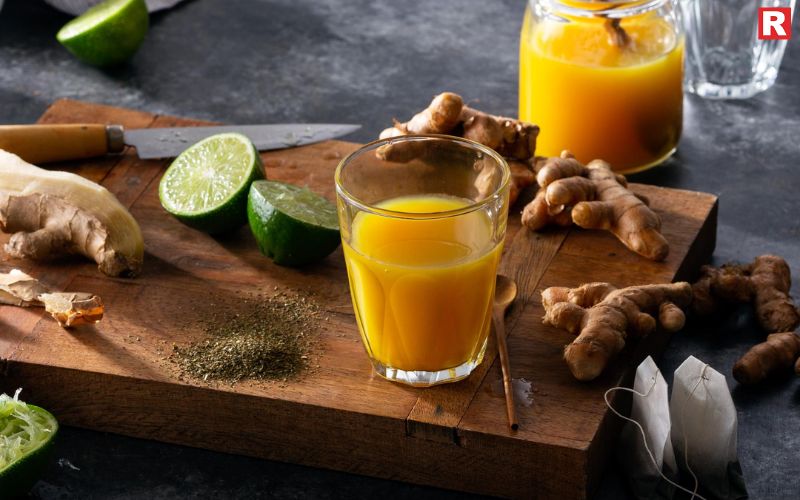
For those who want a stronger solution, turmeric and ginger are a perfect pair. Turmeric contains curcumin, a compound that fights inflammation and promotes skin repair. Ginger improves blood flow and helps your body absorb nutrients better. You can make a golden elixir by mixing a teaspoon of turmeric powder and half a teaspoon of grated ginger in warm water. Adding a pinch of black pepper helps your body absorb turmeric more effectively. Drink this in the morning or evening. It helps reduce puffiness, brighten your skin, and improve circulation. This drink gives you a natural glow without harsh chemicals.
5. Berry Smoothie with Flaxseeds
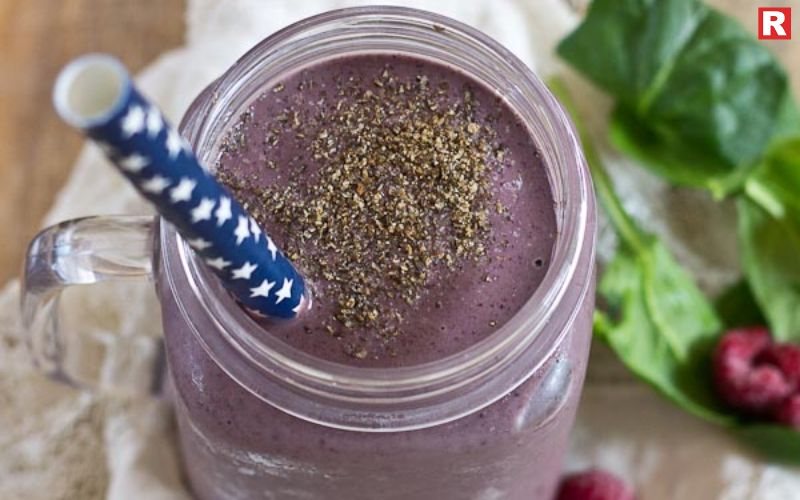
Berries like strawberries, blueberries, and raspberries are packed with antioxidants. These help fight free radicals that cause skin aging and dullness. Flaxseeds are rich in omega-3 fatty acids that support healthy skin and reduce dryness. Blend a cup of mixed berries with a tablespoon of flaxseeds and some yogurt or almond milk. You can also add a small piece of banana for sweetness. This smoothie is perfect as a snack or after lunch. It helps keep your skin firm and youthful by protecting it from damage.
6. Green Tea with Lemon and Honey

Green tea is one of the healthiest drinks for glowing skin. It contains polyphenols that protect your skin from environmental damage and pollution. These compounds also help fight inflammation. Add lemon juice and a small amount of honey to brewed green tea. Lemon adds vitamin C, while honey provides hydration. Drink this tea any time you need a relaxing boost. It not only supports your skin’s health but also helps calm your mind.
Also check: 5 Ways to Use Garden Cress Seeds (Halim) for Stronger Hair and Bones
How to Make These Drinks Work Best for You
- Consistency is key: Drinking these beverages regularly will give you the best results. Make them a part of your daily routine.
- Stay hydrated: Along with these drinks, make sure you drink plain water throughout the day.
- Balance your diet: Eat fruits, vegetables, and healthy fats like nuts and seeds to complement the effects of these drinks.
- Get enough sleep: Your skin repairs itself at night. A good sleep schedule will enhance the benefits of these drinks.
- Manage stress: Stress can affect your skin’s appearance. Try meditation, yoga, or simple breathing exercises to keep calm.
Check more: 5 Foods to Avoid for Better Cholesterol
These 7 Foods Can Help You Cool Your Stomach in Summer
Six Benefits of Starting Your Day with Okra Water
Glow Up!
Looking good during festivals doesn’t have to be hard or expensive. With a few simple drinks, you can give your skin the nourishment it needs. These beverages are natural, safe, and easy to prepare. They not only keep you hydrated but also protect your skin from damage and stress. Start your day with lemon and honey detox water, enjoy coconut water in the afternoon, and sip on green tea in the evening. With small changes, you will see a big difference in how your skin looks and feels. Celebrate this festive season with confidence, energy, and glowing skin!
Disclaimer: This article is intended for general informational purposes only and should not be considered a substitute for professional medical advice, diagnosis, or treatment. Readers are advised to consult a qualified healthcare professional before making any dietary, health, or lifestyle changes.

Living in the modern world has become a race against time. In fact, everyone is surviving here instead of living where each day becomes more hectic than the other. From daily schedules that are too demanding to daily exercise routines that are actually designed to get fit but only end up taking more of our energy, or just the desire to go through the day, people need an energy boost to go through everything. This leads us to reach out to carbonated energy drinks. These beverages, which are designed to give us a rapid boost of energy, increase our mental clarity, and help us perform better physically, are getting more popular day by day. But not each drink is the same, and drinking anything would not give you the energy boost you need.
So, in this article, we will dive into the world of energy drinks and pick up the 10 most popular brands from the market. To help you comprehend the different benefits they offer and how they provide that much-needed boost, we'll break down the main components of each, from sugar and caffeine to extra vitamins and performance-enhancing substances.
Read more: What Are Rail Drinks? The Anatomy of Your Cheapest Night Out
Understanding the Basics of Energy Drinks

The majority of energy drinks use a similar combination of substances to produce their energizing effects. Caffeine, a naturally occurring substance that blocks the brain's adenosine receptors( these receptors induce sleep and exhaustion) to lessen feelings of exhaustion, is usually the main ingredient. In addition to caffeine, many contain a combination of sugars (such as sucrose and glucose) for a rapid energy boost, B vitamins (B2, B3, B6, and B12) to help with energy metabolism, and other safe stimulants and substances.
Typical additives are as follows:
- Taurine: An amino acid considered to be involved in physical performance, taurine promotes nerve growth.
- Guarana: A high-caffeine plant extract that is frequently utilized to extend the stimulating effects of drinks.
- Ginseng: A botanical extract that is said to increase vitality and lower stress levels.
- L-Carnitine: One substance that helps turn fat into energy is L-carnitine.
Even while these components may provide advantages like improved attention and alertness, it's important to use energy drinks sensibly. If taken in excess, the high amounts of sugar and caffeine may cause adverse side effects.
Disclaimer: This article is intended for general informational purposes only and should not be considered a substitute for professional medical advice, diagnosis, or treatment. Readers are advised to consult a qualified healthcare professional before making any dietary, health, or lifestyle changes.
Top 10 Popular Energy Drinks and Their Profiles
This article provides a thorough analysis of ten well-known energy drinks, highlighting their main characteristics, advantages, and nutritional data per average 16-ounce (473 ml) can, unless otherwise noted.
1. Red Bull

It is the undeniable leader that established the whole energy drink market. Red Bull's famed "gives you wings" tagline and iconic slim can are well-known around the world. It is a high-end product that is frequently linked to excellent performance and late-night productivity in India. It gives you a strong physical and mental boost.
Caffeine: 75 mg per 250 ml can.
Sugar: 27.5 g (11 g per 100 ml) per 250 ml can.
Calories: 115 kcal (46 kcal per 100 ml) per 250 ml can.
Energy Type: A physical jolt paired with a focused and alert mental boost.
Know more: Coffee Cocktail Drinks: 10 Must-Try Options to Follow in 2025
2. Monster Energy

Red Bull's major rival, Monster, is renowned for its huge can size and strong, "no-nonsense" branding. It is well-liked by athletes, gamers, and anybody else in need of a stronger energy boost since it provides a stronger and longer-lasting energy boost than its competitors. Its combination of B vitamins, taurine, and caffeine seeks to provide a full-bodied energy boost.
Caffeine: 160 mg per 500 ml can.
Sugar: 55 g per 500 ml can.
Calories: 237 kcal per 500 ml can.
Energy Type: A strong, continuous energy boost that is perfect for extended periods of mental or physical exertion.
3. Sting

Sting, a PepsiCo product, has swiftly gained popularity in India's mass market thanks to its affordable price and unique, sweet taste. College students and young adults looking for a quick and easy energy boost are particularly fond of it. Its flavor and vivid color are two of its main attractions.
Caffeine: 72 mg per 250 ml bottle.
Sugar: 17.5 g (7 g per 100 ml) per 250 ml bottle.
Calories: 70 kcal (28 kcal per 100 ml) per 250 ml bottle.
Energy Type: A quick energy boost that is fueled by high-octane sugar and caffeine.
4. Gatorade

Despite being a sports drink rather than a usual energy drink, Gatorade is popular in India because it replenishes energy, especially during or after physical activity. Although it doesn't include caffeine, it gives you energy by restoring the body's electrolyte and glucose balance after you sweat out.
Caffeine: 0 mg.
Sugar: 30 g (6 g per 100 ml) per 500 ml bottle.
Calories: 120 kcal (24 kcal per 100 ml) per 500 ml bottle.
Energy Type: Hydration and electrolyte replacement provide energy for physical activity and recovery.
What's new: Top 10 Non-alcoholic Drink Ideas for Your Restaurant
5. Mountain Dew

Because of its high sugar and caffeine content, Mountain Dew, a classic soft drink, serves as an unofficial energy drink for many Indians. It provides a brief, sweet thrill along with a caffeine spike. Its "Darr Ke Aage Jeet Hai" motto and unique citrus flavor have made it strongly associated with taking risks and conquering obstacles.
Caffeine: Approximately 54 mg per 600 ml bottle.
Sugar: 73 g per 600 ml bottle.
Calories: 282 kcal per 600 ml bottle.
Energy Type: A fast, high-sugar energy boost that gives you a sugary high and a brief mental clarity boost.
6. Thums Up Charged

This version of Thums Up, a variant of the well-known Indian cola brand, is promoted for having more caffeine. This cola, which has a high caffeine content, promises a strong energy boost while maintaining the rich, well-known flavor of the original Thums Up. Customers who desire the traditional cola experience with a big energy boost are pleased to by it.
Caffeine: 61.5 mg per 250 ml bottle.
Sugar: 18.25 g (7.3 g per 100 ml) per 250 ml bottle.
Calories: 75 kcal (30 kcal per 100 ml) per 250 ml bottle.
Energy Type: A strong energy boost along with the robust, well-known flavor of a traditional cola.
7. Tzinga

With a variety of unique and tasty options, the energy drink brand Tzinga has effectively established a niche for itself in the Indian market. It is a well-liked substitute for more costly foreign brands since it has a reputation for being an affordable option that also provides a consistent energy boost.
Caffeine: 72 mg per 250 ml can.
Sugar: 18 g per 250 ml can.
Calories: 82 kcal per 250 ml can.
Energy Type: A quick, accessible, and efficient energy boost that comes in a range of tastes.
Check out: 6 Fermented Drinks Known To Support Digestive Health
10 Delicious Detox Drinks | Easy Detox Drinks for Summers
8. Cloud 9

An Indian energy drink company called Cloud 9 is well-known throughout the nation and has a traditional, citrus-inspired flavor profile. A popular choice for a wide variety of customers, it is promoted as a reviving and delightful carbonated beverage that gives a rapid energy boost.
Caffeine: Although not always stated on the box, caffeine content is usually between 70 and 80 mg per 250 ml, which is comparable to other energy beverages.
Sugar: Approximately 27.5 g per 250 ml can.
Calories: Approximately 110 kcal per 250 ml can.
Energy Type: An energizing and revitalizing energy boost that is ideal for a last-minute pick-me-up.
9. Power Horse

Power Horse is a well-known global brand that has established a significant presence in the Indian market thanks to its potent, somewhat sweeter flavor profile. It offers a steady and dependable energy boost, making it appealing to a large Indian consumer base that appreciates the flavor and functionality of a reputable international brand.
Caffeine: 80 mg per 250 ml can.
Sugar: 27.5 g (11 g per 100 ml) per 250 ml can.
Calories: 110 kcal (48 kcal per 100 ml) per 250 ml can.
Energy Type: A consistent energy boost that supports lasting alertness and attention.
10. Wild Tiger

Another well-known Indian company that has centered its branding on a unique, exotic appearance is Wild Tiger. Well-known for its unique taste and frequently available in a range of retail locations, it offers a consistent and strong energy boost and is a dependable substitute for some of the more costly brands.
Caffeine: Usually between 70 and 80 mg per 250 ml can, though this is not always the case.
Sugar: 25 g per 250 ml can.
Calories: 125 kcal per 250 ml can.
Energy Type: A reliable and constant energy boost that promotes mental clarity and fights weariness.
Read this: Frankenstein-Inspired Foods and Drinks for Your Spooky Celebrations
A Word of Caution: The Risks
Energy drinks can be a helpful tool, but it's important to be aware of any potential drawbacks. Many of these drinks include a lot of sugar, which can lead to tooth decay, weight gain, and other health problems. An increased heart rate, jitters, anxiety, and disturbed sleep can result from consuming too much caffeine. These beverages cannot replace adequate sleep, staying hydrated, and eating a healthy, balanced diet. You should always be mindful of your own personal caffeine sensitivity and take them in moderation.
Conclusion
Energy drinks, which provide a practical means of overcoming weariness and boosting productivity, have solidified their position in the fast-paced Indian culture. There are several options available on the market, ranging from the well-known Red Bull and Monster to domestic favorites like Sting and Thums Up Charged. Customers may make wise choices if they are aware of the ingredients and nutritional information, particularly the important details about calories, sugar, and caffeine. Always put your health and well-being first, and use these drinks as a tool for a short-term energy boost rather than as an excuse for long-term energy.

The modern food industry is growing through a major revolution that may be silent, but is so powerful that it goes beyond the food. As trends related to personal health and fitness are gaining popularity, people are moving towards ‘staying sober’. As people are staying away from drinking alcohol, there has been an increase in demand for non-alcoholic drinks that are both innovative and delicious. The customers are seeking more than just any soft drink or juice to go with their food. People want unique and exciting drinks that provide the same level of satisfaction as that of any alcoholic drink. This new trend is not just a passing facade that will go away in just a few months or years. For the restaurants that provide high-end meals with alcohol or specialty drinks, adding dynamic non-alcoholic beverages to their menu is a necessity, not a luxury.
This shift towards non-alcoholic beverages is the most beneficial to a customer base that is made up of drivers, non-drinkers to families, and health-conscious customers. Beyond the affordable factor, these drinks can be a significant factor for profitability, frequently have larger profit margins, and lower ingredient prices. Therefore, in this article, we will be covering the top 10 non-alcoholic drinks for your restaurant that are both creative and profitable. They can help increase the customer experience, attract a big customer base, and solidify the restaurant’s reputation as a progressive business.
Read more: Frankenstein-Inspired Foods and Drinks for Your Spooky Celebrations
Why Non-alcoholic Beverages Are a Must-Have for Restaurants
If you ignore the non-alcoholic beverage market, then that means you will be leaving behind a chunk of your revenue and potential customers, and a loyal customer base as a restaurateur. So it is important to know why adding non-alcoholic beverages is important to the business:
- Growing Market: The international market for non-alcoholic drinks is expanding. In India, the party culture is strong due to the large amount of youth population. But, this specific population is also striving towards their own health and fitness, which has also started showing in various aspects of their life, including beverages. The young customers don’t want to compromise on both fitness and experience. This has led to the rise of luxurious, alcohol-free options.
- Increased Profitability: Specialized non-alcoholic drinks, such as house-made sodas and gourmet mocktails, can be priced reasonably to showcase their high-quality ingredients and expertise. They have a higher profit margin than alcoholic drinks due to their cheaper cost of goods, which will greatly increase your bottom line.
- Enhanced Guest Experience: a menu with a diverse range of drinks, varying from sodas to cocktails and non-alcoholic drinks, ensures that every customer, regardless of their drinking habits, feels appreciated and cared for. This inclusion is an effective strategy for increasing customer loyalty and positive word-of-mouth.
- Brand Differentiation: A restaurant that has a non-alcoholic menu is different and unique from its competitors, and stands out in the market. It presents the business as innovative, contemporary, and sincere in its goal of giving everyone a wonderful time.
- Versatility: These drinks are a reliable source of income during all service hours because they may be served at any time of day, from brunch to late at night.
Top 10 Non-alcoholic Drink Ideas
The following ten beverage ideas will turn your non-alcoholic menu from an afterthought to a focal point:
1. Elevated Mocktails

Get rid of the syrupy, excessively sugary recipes from the past. Mocktails today are as elegant, complex, and aesthetically pleasing as their alcoholic counterparts. They make their own syrups, use premium, fresh ingredients, and pay attention to flavor balance.
Key Selling Point: Provides visitors with the delicious flavor and the normal version of a cocktail without the alcohol.
Examples:
- Spiced Guava Cooler: A regionally inspired drink that has a tart, refreshing kick from fresh guava juice, a touch of mint, and a dusting of black salt.
- Cucumber and Basil Smash: a concoction of fresh basil and muddled cucumber, garnished with sparkling water and a tangy lime juice.
- Lavender Lemonade Spritz: A delicate combination of fresh lemon juice, homemade lavender syrup, and sparkling water, topped with a lavender sprig.
2. Artisanal Iced Teas

Serve more than simply plain iced tea. Take advantage of this to highlight unique flavors and brewing methods. Cold brewing produces a smoother, less bitter flavor profile, which makes it an excellent method.
Key Selling Point: very customizable with various tea varieties and flavor infusions, refreshing, and low in calories.
Examples:
- Peach & Rosemary White Tea: A delicate white tea flavored with a fragrant rosemary sprig and luscious peach purée.
- Hibiscus & Ginger Iced Tea: The spicy warmth of fresh ginger nicely balances the tartness of hibiscus blooms.
- Masala Chai Iced Latte: Using cold-brewed masala tea concentrate mixed with milk and served over ice, the Masala Chai Iced Latte is a contemporary Indian take on a traditional beverage.
Know more: Best Bar Blender Brands in India – Power, Precision, and Reliability
3. Creative Lemonades and Limeades

A gourmet makeover of a classic that has been around for a while. A basic beverage can be transformed into a memorable one by incorporating different and fresh fruits, herbs, and spices.
Key Selling Point: A beloved classic with a contemporary spin that feels thrilling and new.
Examples:
- Kiwi & Mint Limeade: Fresh kiwi, muddled mint leaves, and lime juice combine to create the bright green Kiwi & Mint Limeade.
- Spiced Orange Lemonade: Freshly squeezed orange and lemon juice with a touch of cloves and cinnamon is called spiced orange lemonade.
- Strawberry Basil Lemonade: The flavorful, peppery undertones of fresh basil and luscious strawberries are well balanced.
4. Specialty Hot and Cold Coffees

Provide a menu that offers more than the bare minimum to appeal to the expanding market of coffee lovers. Consider cold brew varieties, handcrafted brews, and specialty lattes.
Key Selling Point: Capitalizes on the enormous popularity of specialty coffee culture.
Examples:
- Rose & Cardamom Latte: A sophisticated palate will enjoy this exquisite and aromatic latte made with rose water and a touch of cardamom.
- Nitro Cold Brew with Cinnamon Stick: A cinnamon stick is served alongside a rich, velvety cold brew coffee that has been injected with nitrogen for a creamy head.
- Sea Salt Caramel Frappe: A rich and decadent iced coffee concocted with salted caramel and garnished with whipped cream is called a sea salt caramel frappe.
What's new: Best Whole Wheat Pasta Brands in India
5. House-made Infused Sodas (Shrubs)

Fruit, sugar, and vinegar are combined to make shrubs, often known as drinking vinegars. They have a distinct tangy-sweet flavor and are frequently combined with sparkling water to make cool beverages.
Key Selling Point: A really unique, adult-flavored craft beverage that differentiates your menu.
Examples:
- Mango and Turmeric Shrub: This shrub combines the earthy warmth of turmeric with a tangy-sweet taste.
- Raspberry & Apple Cider Vinegar Soda: A vibrant, delicious shrub with a strong vinegar tang is raspberry and apple cider vinegar soda.
- Pineapple & Chilli Shrub: The ideal ratio of spicy zing to tropical sweetness.
6. Sophisticated Kombuchas

A popular beverage among health-conscious people is kombucha, a fermented tea. Providing a range of high-quality, house-made, or partnered kombuchas can be very appealing.
Key Selling Point: Its distinct flavor and probiotic benefits capitalize on the wellness trend.
Examples:
- Ginger & Lemongrass Kombucha: This energizing and delightful kombucha is spicy and zesty.
- Berry and Mint Kombucha: This kombucha has a mild, herbal finish and is delicious and refreshing.
- Apple & Cinnamon Kombucha: This kombucha has hints of spiced apple and is warm and soothing.
7. Smoothies and Lassi
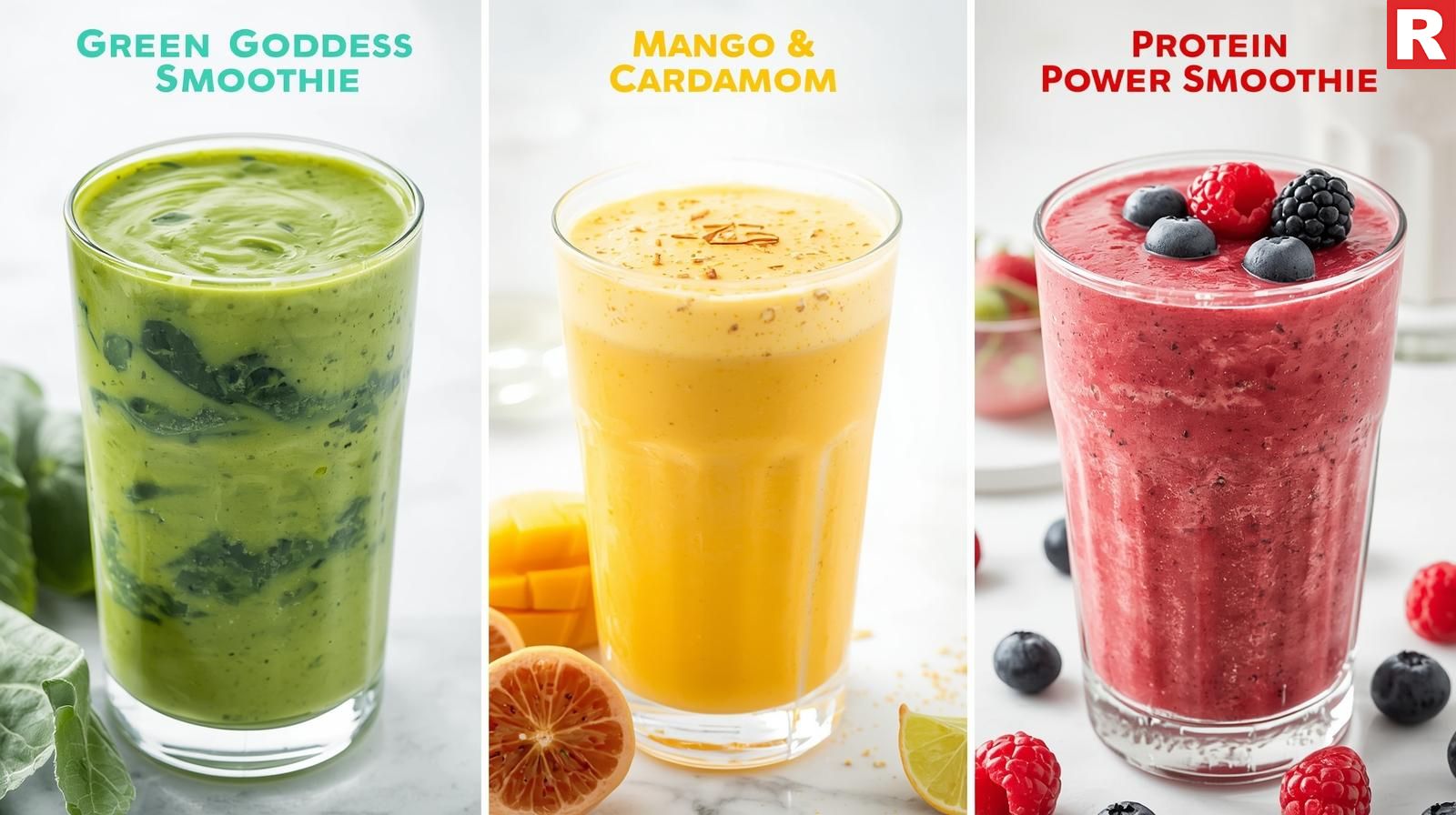
Enhance these traditional drinks with premium ingredients and a gourmet touch. In India, lassi is a common beverage, and a high-end version can serve as its focal point.
Key Selling Point: A satisfying and wholesome choice that may be used as a healthy treat or as a meal substitute.
Examples:
- Green Goddess Smoothie: The Green Goddess Smoothie is a nutrient-dense, creamy drink made with spinach, avocado, banana, and plant-based milk.
- Mango and Cardamom Lassi: This traditional sweet mango lassi is enhanced with a dash of cardamom for a fragrant treat.
- Protein Power Smoothie: A combination of Greek yogurt, protein powder, and berries for a healthy or post-workout meal.
Check out: 10 Best Indian Quinoa Recipes for Weight Loss
Best brown bread brands in India
8. Fresh Juices and Juice Blends
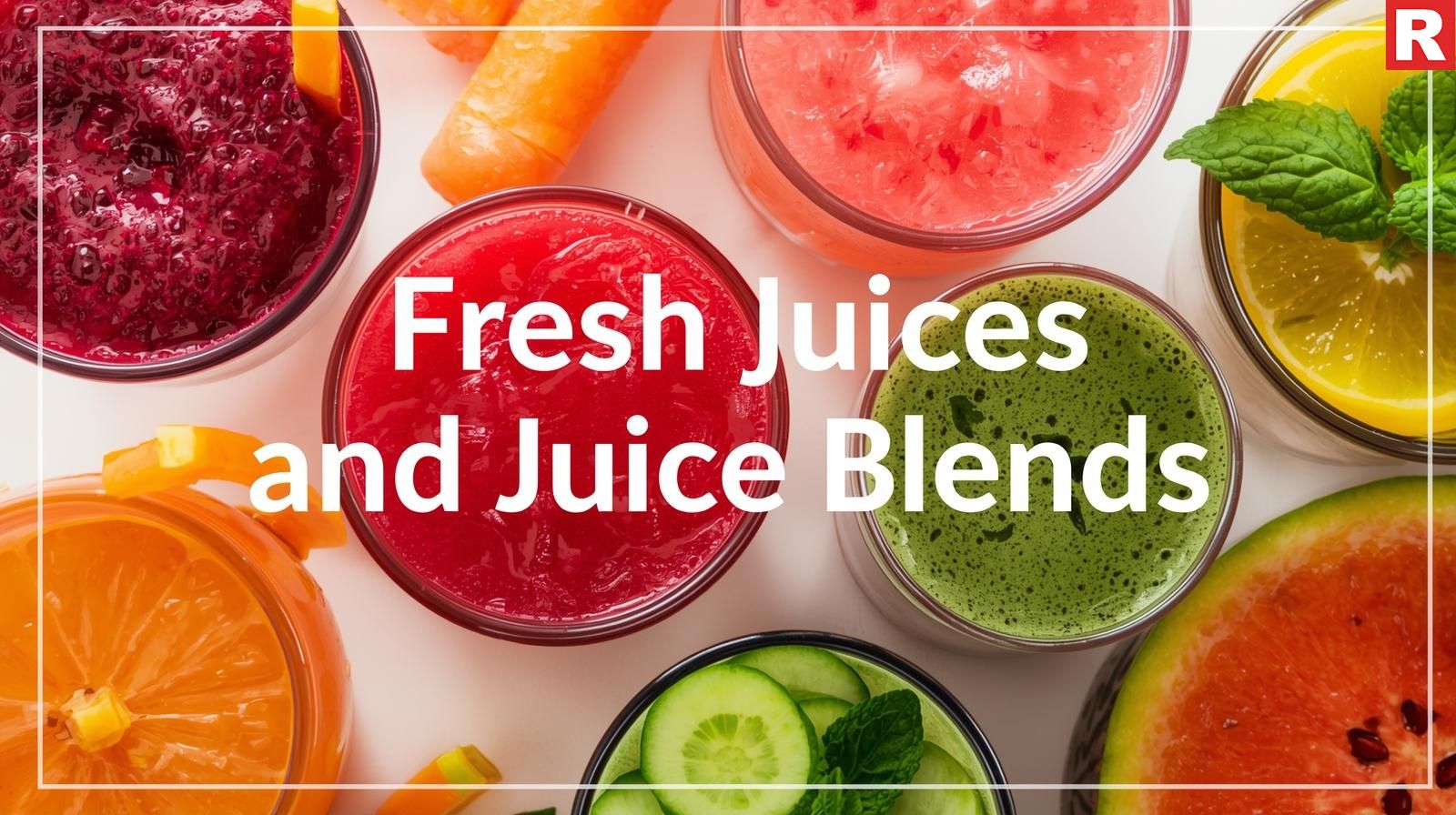
Offer freshly pressed or blended juices instead of prepackaged ones. Fresh juices are always tempting because of their vivid colors and simple, undiluted flavors.
Key Selling Point: A colorful, healthy, and pure option that demonstrates your dedication to using only the freshest ingredients.
Examples:
- Beet, Carrot, Apple & Ginger Juice: A strong, earthy, and spicy juice blend with health benefits is beet, carrot, apple, and ginger juice.
- Watermelon & Mint Juice: Simple, sweet, and refreshing, watermelon and mint juice is ideal for hot weather.
- Spinach, Pineapple, and Cucumber Detox: A crisp and energizing green juice mixture.
9. Non-alcoholic Cocktail Replicas

By carefully replicating the flavor profile and sensation of a particular, well-known alcoholic cocktail, this beverage type goes above and beyond the generic mocktail. Restaurants can serve zero-proof versions of traditional drinks like a Mojito, Margarita, or Old Fashioned by using a range of creative non-alcoholic "spirits," bitters, and syrups. In order to give designated drivers and non-drinkers a genuinely authentic-tasting substitute, the objective is not just to substitute the alcohol but also to replicate the original drink's complexity, texture, and aroma.
Key Selling Point: Enables customers to enjoy their favorite beverages without the alcohol content while still providing the full flavor experience and social ritual of a classic cocktail.
Examples:
- NA Spiced Rum & Cola: A perfect imitation of a traditional rum and cola made with a premium non-alcoholic rum substitute that has a hint of spice and molasses.
- Zero-Proof Margarita: This drink is a zesty and revitalizing mixture of fresh lime juice, agave nectar, and a non-alcoholic tequila alternative that is served in a glass with a salt rim.
- Herbal Gin & Tonic: An elegant blend of a botanical non-alcoholic "gin" with fresh botanicals such as juniper berries or rosemary and a high-end tonic water.
10. Flavored Hot Chocolates and Spiced Milks

An excellent choice for dessert or as a cozy drink, particularly at restaurants that welcome families. These can be very well-liked in the winter.
Key Selling Point: A rich, cozy, and kid-friendly substitute for tea or coffee.
Examples:
- Chilli & Cinnamon Hot Chocolate: Rich, black hot chocolate with a subtle spicy sting and a comforting cinnamon undertone is known as "chilli and cinnamon hot chocolate."
- Saffron & Pistachio Badam Milk: This traditional Indian beverage is made with almond milk and enhanced with crushed pistachios and the luxurious taste of saffron.
- Salted Caramel Hot Chocolate: A delightful and comforting blend of sweetness and salt.
Read this: 7 Reasons to Add Macadamia Nuts to Your Daily Diet
Conclusion
A modern restaurant can no longer afford to overlook a unique and dynamic non-alcoholic beverage menu, as it is now a strategic advantage. Restaurants can boost revenue, satisfy evolving customer preferences, and establish themselves as progressive, diverse dining places by adopting these top ten non-alcoholic drink concepts. In today's time, providing a genuinely appealing zero-proof menu is a potent method to improve the visitor experience and guarantee that your business stays at the forefront of the hospitality sector in the cutthroat culinary industry.

Macadamia nuts are more than just a tasty snack. Their rich and buttery flavor makes them a favorite among many. People enjoy them as a treat, but they also offer several health benefits. These nuts are packed with important nutrients that support the body in different ways. For those who want to eat healthy without giving up on good taste, macadamia nuts are an excellent choice. They are natural and full of nutrients like healthy fats, fiber, vitamins, and minerals. Adding them to everyday meals is simple and doesn’t require much effort. Macadamia nuts can be eaten as a quick snack or added to salads, breakfast bowls, or desserts. Even a small amount each day can make a difference in your health.
These nuts help in improving heart health, boosting energy, supporting digestion, and keeping the skin healthy. They are a smart option for people of all ages. With their unique taste and health benefits, macadamia nuts are an easy and enjoyable way to stay fit and feel good every day. Starting small can lead to big benefits in the long run.
Read more: High Protein Indian Meals You Should Try
Top 10 Health Benefits of Eating Dry Fruits Daily
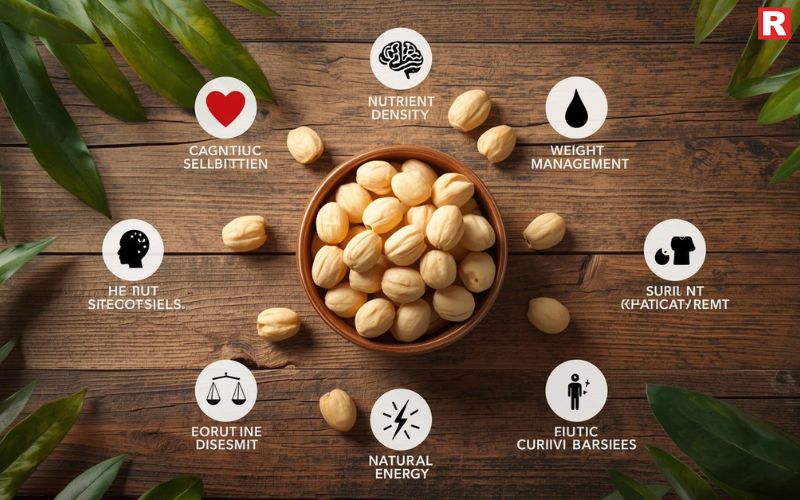
1. Heart-Healthy Goodness
One of the biggest reasons to eat macadamia nuts is that they support heart health. These nuts are full of monounsaturated fats. These fats are the same kind that you find in olive oil, which is known to be good for your heart. Eating these healthy fats helps lower bad cholesterol (LDL) and can increase good cholesterol (HDL). This balance is important for keeping your heart healthy. Studies show that regular intake of monounsaturated fats may reduce the risk of heart diseases like heart attacks. Including just a handful of macadamia nuts in your diet can be an easy way to support your heart without making big changes.
2. A Boost for Brain Health
What you eat affects how your brain works. Macadamia nuts are great brain food. They contain omega-9 fatty acids, also known as oleic acid, which helps protect your brain cells from damage. These nuts also have antioxidants that fight harmful free radicals. Free radicals can cause stress in the brain, leading to memory loss or other issues. Regular consumption of macadamia nuts may help improve memory, focus, and mental clarity. For students, professionals, or anyone who needs to stay sharp, adding macadamia nuts to your diet can give your brain the fuel it needs to perform better.
3. Packed with Nutrients
Macadamia nuts are more than healthy fats. They are a good source of several essential vitamins and minerals. For example, they are rich in vitamin B1 (thiamine), magnesium, manganese, and copper. Vitamin B1 helps your body turn food into energy. Magnesium supports muscle and nerve function. Manganese and copper play a role in bone health and enzyme production. These nutrients work together to keep your body running smoothly. If you have a busy lifestyle, eating macadamia nuts can help you stay energized and balanced.
4. Great for Weight Management
It may sound strange that nuts, which are high in calories, can help you manage weight. But macadamia nuts are an exception. They are full of healthy fats and fiber, which help you feel full for longer. When you feel full, you are less likely to snack on unhealthy foods like chips or sweets. Eating a small portion of macadamia nuts between meals can prevent overeating and keep your weight in check. Also, these nuts don’t cause sharp spikes in blood sugar, unlike processed snacks. This slow and steady energy release helps you stay satisfied throughout the day.
Know more: 6 Benefits of Drinking Black Coffee
5. Supports Healthy Skin
Your skin is the largest organ in your body. What you eat can have a direct impact on its health. Macadamia nuts are especially good for the skin because they contain a rare type of fat called palmitoleic acid (omega-7 fatty acid). This nutrient helps keep your skin hydrated and soft. It also plays a role in repairing damaged skin and protecting it from aging signs like wrinkles and dryness. Adding macadamia nuts to your diet can help you glow from the inside out. For people living in harsh weather conditions or with dry skin, this natural boost is especially helpful.
6. Gut-Friendly Snack
A healthy gut is key to overall wellness. Macadamia nuts are rich in fiber, which helps your digestive system work properly. Fiber promotes healthy bowel movements and prevents constipation. More importantly, fiber feeds the good bacteria in your gut. These bacteria are essential for digestion, immune function, and even mood regulation. Eating macadamia nuts regularly supports a balanced gut microbiome. This means you will feel lighter, more energetic, and less bloated.
7. A Natural Energy Booster
If you are always on the go, macadamia nuts can be your secret weapon. They are calorie-dense, which means they provide a lot of energy in a small portion. But unlike sugary snacks that cause energy crashes, macadamia nuts give you a steady release of energy. This helps you stay active without feeling tired. A handful of these nuts before a workout or during a long day can keep you going. They are especially useful for athletes, students, or anyone with a demanding schedule.
Also check: 5 Foods to Avoid for Better Cholesterol
These 7 Foods Can Help You Cool Your Stomach in Summer
From Murukku to Misal: Regional Snack Stars Winning Big on Q-Commerce Platforms
How to Add Macadamia Nuts to Your Daily Diet
Now that you know the benefits, you might be wondering how to include macadamia nuts in your meals. Here are some simple and effective ways:
- As a snack: Eat them raw or roasted. A handful is enough for a quick energy boost.
- In smoothies: Add a few nuts for extra creaminess and nutrients.
- In salads: Sprinkle chopped macadamia nuts over your favorite salad for texture and flavor.
- With breakfast: Mix them into oatmeal, yogurt, or cereal.
- In baked goods: Add them to muffins, cookies, or granola bars.
- With desserts: Use them as toppings for ice cream or chocolate-based treats.
You don’t have to make big changes. Even a small portion every day can make a difference.
Final Thoughts
Macadamia nuts are a simple yet powerful way to improve your health. From supporting your heart to boosting your brain and keeping your skin healthy, they are a nutrient-rich option for everyone. You don’t need to overhaul your entire diet to enjoy their benefits. Just add them gradually, and you’ll start to feel the difference. For those looking for a natural, tasty, and nutritious snack, macadamia nuts are the perfect choice. Whether you are a busy professional, a student, or someone focused on wellness, they can help you stay energized, healthy, and balanced every day. Start today—make macadamia nuts a part of your daily routine and give your body the care it deserves.

Desserts hold a special place in a restaurant’s menu. They are more than just food—they create memories. A scoop of ice cream or gelato can turn an ordinary meal into a celebration. It brings smiles to faces and warmth to hearts. People come back not just for the main course but for that sweet ending. Ice cream and gelato are loved by all ages. They offer a cool, creamy, and indulgent treat that comforts and delights.
ut not all desserts are the same. The right brand can make all the difference. A poor choice can ruin the experience, while a trusted brand can leave a lasting impression. Whether it’s a small café, a busy family restaurant, or a luxury hotel, picking the perfect ice cream or gelato brand is crucial. It enhances taste, ensures quality, and builds trust. It also helps boost profits. For every kind of restaurant, there is a brand that matches its style, its customers, and its dreams. Choosing wisely means serving joy in every scoop.
Read more: 12 Delicious High-Protein Foods to Eat Daily for a Healthier You
10 Fastest-Growing Alcohol Brands in India’s HoReCa Sector
Why Ice Cream & Gelato Matter for Restaurants
Ice cream and gelato are not just desserts. They create experiences. Customers expect creamy, fresh, and tasty options at the end of their meal. Many restaurants see desserts as a way to boost sales. Offering the right flavors can attract new customers and encourage larger orders.
Moreover, ice cream and gelato allow restaurants to experiment with flavors and create signature desserts. Seasonal and regional flavors can reflect your restaurant’s theme. Also, dietary preferences like vegan and gluten-free options are becoming more popular. Choosing the right brand ensures that you meet these expectations.
What to Look for in a Brand
When selecting a brand, focus on these factors:
- Taste and Texture – Smoothness, creaminess, and the right level of sweetness are important.
- Ingredients – Real dairy, fresh fruits, and no artificial flavors make a difference.
- Packaging – Easy-to-serve packs, portion sizes, and attractive packaging help in quick service.
- Supply Support – Availability, logistics, and customer service matter for consistent supply.
- Special Options – Vegan, dairy-free, and low-fat versions cater to health-conscious customers.
Now, let’s look at some of the best ice cream and gelato brands suitable for restaurants.
Top Ice Cream & Gelato Brands for Restaurants

- Naturals Ice Cream: Naturals is a popular Indian brand known for its fruit-based flavors. oIt uses fresh and natural ingredients. Many restaurants prefer it because it offers a homemade feel. Flavors like sitaphal, mango, and tender coconut are loved by customers.
- Amul: Amul is one of India’s oldest and most trusted dairy brands. It is widely available and affordable. Restaurants benefit from its consistent quality and supply chain. Amul’s flavors range from classics like vanilla and chocolate to seasonal offerings.
- Kwality Wall’s: Kwality Wall’s is a widely distributed brand in India. It offers a large variety of flavors suitable for family restaurants and casual dining. Its affordable pricing makes it a good option for restaurants aiming for volume.
- Vadilal: Vadilal is another trusted brand with a strong presence in hotels and restaurants. It is known for its bulk packs and wide range of flavors. Its products are reliable and easy to store, making it ideal for restaurants with large customer footfall.
- NIC Ice Creams: NIC focuses on natural ingredients and avoids preservatives. Many restaurants that value organic and healthy ingredients partner with this brand. It is ideal for cafés, dessert parlors, and health-conscious menus.
- Baskin Robbins India: Baskin-Robbins is an international brand with premium offerings. It is known for its creative and indulgent flavors. Restaurants that want to offer upscale dessert experiences benefit from its consistent texture and taste.
- Häagen-Dazs India: Häagen-Dazs is a luxury ice cream brand with smooth texture and rich flavors. It is often used in fine dining restaurants and hotel dessert menus. Though more expensive, it attracts customers seeking gourmet experiences.
- London Dairy: London Dairy offers premium ice cream with thick, creamy textures. It is a popular choice in metropolitan areas and luxury hotels. It pairs well with coffee, cakes, and other desserts.
- Giani’s: Giani’s is a well-loved North Indian brand with strong presence in restaurants and street cafes. It offers authentic flavors and nostalgic appeal. Many restaurants prefer it for regional menus.
- Pabrai’s Fresh & Naturelle: Pabrai’s focuses on regional and seasonal flavors. Flavors like nolen gur and kesar pista bring a unique taste to menus. It is ideal for restaurants that want to stand out with specialty desserts.
- Gelato Vinto: Gelato Vinto is among the first gelato brands in India. It offers authentic Italian recipes with a creamy, rich texture. It works well in cafés and dessert bars aiming for a premium but accessible option.
- Gelato Italiano: Gelato Italiano offers classic Italian gelato with fresh ingredients and smooth textures. It is preferred by restaurants that want to provide a true European dessert experience.
- Ben & Jerry’s: Ben & Jerry’s is known for quirky flavors and indulgent desserts. It is used by restaurants that want to add fun elements to their menu. Its rich texture and creative combinations attract younger customers.
- Mövenpick: Mövenpick is a Swiss brand offering premium ice creams and gelato. Its elegant packaging and smooth taste are ideal for luxury restaurants and hotels.
- Grom (Italy): Grom focuses on authentic, natural gelato without artificial additives. It is perfect for restaurants that prioritize purity and craftsmanship.
- Carte D’Or: Carte D’Or is a global brand used in hotels and restaurants. It offers reliable quality, smooth texture, and wide flavor variety, making it a great option for buffet-style service.
Know more: 6 Benefits of Drinking Black Coffee
Types of Offerings Restaurants Can Explore
- Classic Flavors – Vanilla, chocolate, and strawberry are safe bets that appeal to most customers.
- Regional Flavors – Mango, pistachio, saffron, or nolen gur create unique offerings.
- Seasonal Specials – Winter flavors like kesar pista or summer specials like watermelon attract repeat orders.
- Vegan & Dairy-Free – Coconut milk or almond-based options cater to health-conscious customers.
- Signature Creations – Restaurants can collaborate with brands to create exclusive flavors.
How Ice Cream & Gelato Can Boost Revenue
Adding ice cream or gelato can increase average bill size. It offers opportunities for upselling. Pairing it with coffee, hot chocolate, or cakes creates attractive combos. Desserts also enhance customer experience, encouraging longer stays and repeat visits.
Premium brands like Häagen-Dazs or Mövenpick add luxury to menus. Affordable brands like Amul or Kwality Wall’s allow high volume sales. Restaurants can choose based on customer preferences and pricing.
Also check: 5 Ways to Use Garden Cress Seeds (Halim) for Stronger Hair and Bones
5 Foods to Avoid for Better Cholesterol
Pani Puri Has Different Names in Different Indian States—Know Them All
Sustainability & Dietary Preferences
Today’s customers are mindful of ingredients and the environment. Many brands now offer vegan or low-fat options. Organic flavors with no artificial additives are gaining popularity. Packaging made from eco-friendly materials is also appreciated by conscious diners. Restaurants can highlight these choices in menus to attract health-focused customers.
The Bottom Line
It’s about finding a partner that reflects the restaurant’s style and values. A good brand can create unforgettable experiences. It can make customers feel cared for and valued. From elegant, high-end restaurants to cozy family cafés, the right dessert brand makes every visit special. Brands like Naturals, Amul, Kwality Wall’s, Vadilal, NIC, Baskin Robbins, Häagen-Dazs, London Dairy, Giani’s, Pabrai’s, Gelato Vinto, Gelato Italiano, Ben & Jerry’s, Mövenpick, Grom, and Carte D’Or offer flavors and quality that customers trust and love. A great brand ensures smooth texture, rich taste, and consistent service. When a restaurant chooses well, it shows. It brings smiles, creates loyal customers, and helps the business grow. Serving the perfect scoop is serving happiness, one dessert at a time.

Quick Service Restaurants, also called QSRs, have changed the food industry in India. People today want meals that are quick, tasty, and reliable. From burgers and fries to nuggets, patties, and kebabs, speed matters as much as flavor. Behind this efficiency is the strong support of frozen food. Frozen food brands play an important role in the success of QSRs. They provide ready-to-cook products that save preparation time and reduce wastage.
These products also make it possible for restaurants to serve the same taste across all outlets. Consistency is key for customer trust, and frozen food makes it possible. It also helps restaurants expand faster by simplifying supply chains and standardizing menus. In a country where dining out and food delivery are growing every day, frozen food has become more than a convenient option. It is a backbone for QSRs, ensuring speed, quality, and growth in a highly competitive market.
Read more: 12 Delicious High-Protein Foods to Eat Daily for a Healthier You
5 Ways to Use Garden Cress Seeds (Halim) for Stronger Hair and Bones
Frozen Food and the QSR Boom
India’s QSR market has seen explosive growth in the last decade. Rising disposable income, urban lifestyles, and the food delivery boom have played a big role. Brands like Domino’s, McDonald’s, and KFC thrive because they can deliver the same taste and quality across outlets.
This is possible because of frozen food. Unlike fresh ingredients, frozen products allow restaurants to keep a steady supply chain, reduce waste, and offer the same taste to every customer. Globally, the frozen food industry is valued at over $250 billion. In India, the frozen food market is growing at a double-digit pace. QSRs are one of the biggest drivers of this growth.
Why Frozen Food is a Game-Changer for QSRs
Quick service restaurants need speed and consistency. Frozen food helps them achieve both.
- Speed and convenience: Products like fries, patties, and nuggets can be cooked instantly.
- Standardized quality: Every outlet serves the same taste.
- Inventory management: Frozen food stays longer without spoilage.
- Menu variety: Both Indian and international snacks are available.
- Scalability: Chains can open new outlets with the same product range.
For QSRs, frozen food ensures they can keep up with customer demand while maintaining brand reputation.
Know more: 7 Healthy Chicken Dishes to Maintain Your Diet
Best Frozen Food Brands for Quick Service Restaurants
This article explores the best frozen food brands for quick service restaurants and why they are trusted by industry leaders.
1. McCain Foods

McCain is one of the most popular frozen food brands worldwide and has built a strong presence in India. The brand is best known for its French fries and potato-based snacks, which are a favorite for QSRs. Popular items include French fries, aloo tikki patties, and potato cheese shots. McCain stands out for its crispness and consistent quality. Quick service restaurants rely on McCain because the products are easy to cook and taste the same every time. McDonald’s and several leading QSR chains source fries and potato products from McCain, making it a trusted choice for frozen potatoes.
- Popular products: French fries, aloo tikki patties, potato cheese shots.
- USP: Crispness and consistency.
- Why QSRs choose it: McCain products are reliable, easy to prepare, and deliver the same taste every time.
2. ITC Master Chef

ITC has built a powerful frozen food brand under the name Master Chef. It serves both vegetarian and non-vegetarian markets, offering a wide variety of options. Popular items include chicken kebabs, fish fingers, veggie patties, and hara bhara kebabs. The brand’s strength lies in its diverse product range that matches Indian and global tastes. Quick service restaurants trust ITC for ready-to-cook products that fit easily into their menus. From nuggets to kebabs, Master Chef offers choices for every type of QSR. Its balance of taste, convenience, and variety makes it a go-to partner for restaurants looking to expand.
- Popular products: Chicken kebabs, fish fingers, veggie patties, hara bhara kebabs.
- USP: A wide range of Indian-style and international products.
- Why QSRs choose it: ITC offers ready-to-cook snacks that suit Indian tastes as well as global menus.
3. Godrej Yummiez

Godrej Yummiez is a frozen food brand from one of India’s most trusted companies. It has carved its place in the QSR industry with products that combine hygiene, taste, and quality. Popular offerings include chicken nuggets, sausages, salami, and kebabs. Restaurants prefer Yummiez because the products are versatile and can be used in burgers, sandwiches, and side dishes. With its strong distribution network, Godrej ensures easy availability across the country. QSRs rely on the brand for safe and consistent frozen products. Yummiez has become a trusted name for quick dining outlets seeking reliability and variety in frozen food.
- Popular products: Chicken nuggets, sausages, salami, kebabs.
- USP: Hygiene, taste, and quality backed by Godrej.
- Why QSRs choose it: Yummiez offers versatile products that fit well in sandwiches, burgers, or side menus.
4. Venky’s

Venky’s is one of India’s oldest poultry brands and is highly respected in the frozen food space. The company specializes in chicken-based products and has earned the trust of many QSRs. Its popular products include chicken nuggets, burger patties, kebabs, and wings. Venky’s USP is its expertise in poultry, which ensures high quality and protein-rich food items. Many quick service restaurants focused on chicken dishes prefer Venky’s because of its heritage and consistency. The brand has built long-term trust by maintaining strong standards in its products. Venky’s continues to be a leading partner for QSRs serving chicken menus.
- Popular products: Chicken nuggets, burger patties, kebabs, wings.
- USP: Expertise in poultry products.
- Why QSRs choose it: Venky’s provides protein-rich frozen food with consistent quality.
Also check: Top 7 Food Safety Practices Every Restaurant Should Follow
5. Al Kabeer

Al Kabeer is a well-known frozen food brand with a strong reputation in both India and international markets. The brand offers a wide range of products that include seekh kebabs, parathas, nuggets, and Arabic-style snacks. Its USP lies in Middle Eastern-inspired flavors and halal-certified food. Many quick service restaurants serving diverse audiences trust Al Kabeer for its unique and authentic range. Its products fit easily into menus that target both Indian and global tastes. Restaurants catering to Middle Eastern or halal food preferences find Al Kabeer especially useful. The brand remains a reliable name in the frozen food industry.
- Popular products: Seekh kebabs, parathas, nuggets, Arabic snacks.
- USP: Middle Eastern flavors and halal-certified products.
- Why QSRs choose it: Restaurants serving diverse audiences trust Al Kabeer for its unique range.
Other Notable Players
- Sumeru: Known for frozen parathas, cutlets, and vegetarian snacks.
- Vista Processed Foods: Supplies burger patties and other products to global chains like Burger King and Domino’s.
- Innov8: Focuses on innovative frozen food solutions for QSRs and cloud kitchens.
What Sets These Brands Apart
The best frozen food brands are not just about convenience. They stand out for several reasons:
- Quality of ingredients: Trusted sourcing and strict hygiene.
- Menu variety: From Indian kebabs to global fries.
- Large-scale distribution: Available across cities.
- Strong QSR partnerships: Many supply directly to global fast-food chains.
This combination of quality, reach, and variety makes them essential partners for QSRs.
Frozen Food Market in India and QSR Growth
The frozen food market in India is valued at over ₹12,000 crore and is growing rapidly. With more young professionals, nuclear families, and food delivery apps, demand continues to rise.
QSRs are one of the biggest drivers of this demand. Outlets depend on frozen food for:
- Maintaining quality across multiple stores.
- Expanding menus without extra kitchen costs.
- Reducing wastage and storage challenges.
Cloud kitchens are also fueling growth. Since these kitchens focus on delivery, frozen food helps them maintain consistency without heavy infrastructure.
Check more: Best International Cuisines You Should Try Once
The Secret Spice Box: Most Common Spices Chefs Can’t Live Without
Best Food Delivery Apps & Quick Commerce Platforms in India
Frozen is the Future of Fast
Frozen food plays a key role in the growth of quick-service restaurants in India. Leading brands such as McCain, ITC Master Chef, Godrej Yummiez, Venky’s, and Al Kabeer supply products that are reliable, safe, and consistent. These brands help restaurants maintain the same taste across outlets, which is important for customer trust. Frozen products also reduce kitchen time and make service faster, a must for quick dining formats. QSRs depend on frozen snacks, fries, patties, and kebabs to meet high demand every day. This support allows them to focus on service and scale their business without worrying about food preparation challenges. For the industry, frozen food is not just about saving time. It ensures quality, taste, and customer satisfaction. In a competitive market, frozen food has already become the foundation of quick service dining in India.

India has long been known for its deep love of tea. Over the last decade, coffee too has found a strong following. The café culture across cities and the recent shift to work-from-home setups have changed the way people enjoy their daily cup. More individuals now prefer brewing fresh tea or coffee at home rather than relying only on cafés or instant mixes. This change has created a rising demand for tea and coffee brewers in India.
Today, the market is filled with options to suit every taste and budget. From simple French presses that bring out rich flavors to advanced espresso machines that deliver café-style drinks, the choices are many. Consumers are also exploring pour-over kits, infuser bottles, and compact kettles. Each type of brewer offers a unique experience, making the process of preparing tea or coffee more personal and enjoyable. With so many options available, it becomes important to look at the brands that are making a mark in this growing market and understand what sets them apart.
Read more: 6 Benefits of Drinking Black Coffee
10 Low-Budget Cafe Interior Design Tips to Follow
Why Brewing at Home is Trending
Brewing at home is no longer just about convenience. It is about enjoying the process of making a perfect cup. People are moving away from instant coffee and tea bags. They want fresher, more flavorful drinks. For many, brewing is a small daily ritual. It gives the same joy as café-style drinks but at a fraction of the cost. Millennials and Gen Z, in particular, are driving this trend. They are investing in brewing gear that is easy to use, stylish, and durable. The rise of online shopping has also made international and Indian brewer brands easily available. Quick commerce platforms are delivering brewing kits within hours. This has made experimenting with home brewing even more exciting.
Top 6 Tea & Coffee Brewer Brands in India
Here are six brands that are popular among Indian tea and coffee lovers these days.
1. Philips

Philips is one of the most trusted names in home appliances. In the coffee brewing space, Philips offers easy-to-use drip coffee machines that are perfect for beginners. Its coffee makers are known for durability, consistent taste, and simple design. For families, the machines with larger carafes are useful. For individuals, Philips also has compact models. The brand is also popular among tea lovers, thanks to its electric kettles. They heat water quickly and are safe to use. Philips combines affordability with long-lasting performance, which is why it remains a top choice for many households in India.
2. Preethi

Preethi is an Indian brand that has won the hearts of coffee lovers, especially in South India. The brand’s filter coffee machines are designed to brew authentic South Indian filter coffee at home. The machines are compact, stylish, and easy to clean. Preethi understands the traditional coffee culture in India and adapts its products accordingly. For tea lovers, Preethi also offers kettles that make brewing fast and convenient. What sets Preethi apart is its strong connection with Indian tastes. If you want your coffee to feel close to home, Preethi is a brand worth trusting.
3. Hario

Hario is a Japanese brand that has become very popular in India in recent years. Known worldwide for its pour-over coffee gear, Hario is the go-to brand for coffee enthusiasts who love manual brewing. The Hario V60 dripper is especially famous. It allows you to control every detail of your brew, from water temperature to pouring speed. This makes it a favorite among people who want to experience coffee at its purest. For tea, Hario offers glass teapots and infusers that combine elegance with function. The brand is slightly premium, but for those who love the craft of brewing, Hario is a great investment.
Know more: 11 Best Commercial Coffee Machine Brands for Café: Top Picks & Buying Guide
4. Bodum

Bodum is a Swiss brand known for its stylish French presses and tea makers. In India, it has a growing following among people who like both tea and coffee. The French press by Bodum is simple, elegant, and produces rich, flavorful coffee. Many tea drinkers also use Bodum presses for brewing loose-leaf teas. Its products are made of high-quality glass and stainless steel, giving them both style and durability. Bodum is perfect for people who like minimalistic design and no-fuss brewing. While slightly higher priced, the brand offers excellent long-term value.
5. InstaCuppa

InstaCuppa is an Indian brand that has quickly made a mark in the home brewing market. It focuses on modern, affordable, and easy-to-use brewing products. The brand offers French presses, cold brew coffee makers, and infuser bottles. InstaCuppa products are designed for young professionals who want a café-style experience without spending too much. What makes InstaCuppa special is that it is a homegrown brand. It understands Indian customers’ need for affordability and practicality. It has become a popular entry-level choice for people starting their brewing journey.
6. DeLonghi

For those who want a premium brewing experience, DeLonghi is a top choice. This Italian brand is well-known for its espresso machines and high-end coffee makers. DeLonghi machines allow you to brew café-quality espresso, cappuccino, and lattes at home. They are equipped with advanced technology but are still user-friendly. In India, DeLonghi is popular among serious coffee lovers who want more than just a basic brew. It is on the expensive side, but it is considered a long-term investment for coffee enthusiasts.
Also check: 10 Coffee Shop Design Tips for Small Spaces (That Brew Big Style)
Features That Set These Brands Apart
Each of these brands stands out for different reasons:
- Philips: Reliable, durable, and budget-friendly.
- Preethi: Authentic South Indian coffee experience.
- Hario: Perfect for manual brewing and pour-over fans.
- Bodum: Elegant French press designs for tea and coffee.
- InstaCuppa: Affordable, stylish, and Indian-made.
- DeLonghi: Premium espresso machines for true coffee lovers.
The Indian Tea & Coffee Brewing Market
India’s love for tea is unmatched, but coffee is quickly gaining ground. The coffee machine market in India is expected to grow by about 8–10% CAGR till 2030. This growth is driven by urban lifestyles, higher disposable incomes, and exposure to global café culture. Specialty coffee roasters like Blue Tokai and Third Wave Coffee Roasters are also making people curious about brewing at home. Similarly, premium tea brands are encouraging customers to try loose-leaf teas and herbal blends.
E-commerce platforms and quick commerce delivery have made brewing gear accessible to people across the country. From tier-1 cities to smaller towns, more Indians are now experimenting with tea and coffee brewing.
Check more: 5 Foods to Avoid for Better Cholesterol
5 Ways to Use Garden Cress Seeds (Halim) for Stronger Hair and Bones
12 Delicious High-Protein Foods to Eat Daily for a Healthier You
How to Choose the Right Brewer for You
Choosing the right brewer depends on your taste and lifestyle.
- If you drink a lot of tea and coffee, a durable machine from Philips or Preethi is a safe bet.
- If you enjoy experimenting with flavors and brewing methods, Hario or Bodum is ideal.
- If you want something affordable and beginner-friendly, InstaCuppa is a great start.
- If you want café-quality drinks at home, DeLonghi is the best investment.
Think about your budget, the type of drinks you like, and how much time you want to spend brewing. That will help you pick the right brand.
Let’s Brew!
Brewing tea and coffee at home has moved beyond being a passing trend. It has now become a regular part of life for many people in India. The market today offers a wide range of brands that cater to different needs and preferences. Philips and Preethi are trusted for their simple and reliable machines, making them ideal for beginners and families. For those who enjoy a more premium experience, DeLonghi brings café-quality espresso makers into the home. Hario and Bodum introduce global brewing styles, loved by enthusiasts who like to experiment with pour-over or French press methods. On the other hand, InstaCuppa has gained popularity for its affordable and practical options, especially among young professionals. Each brand stands out in its own way, giving consumers plenty of choice. One thing remains clear: the right brewer not only improves taste but also makes the daily ritual of tea or coffee more enjoyable.

When it comes to fitness, workouts alone are not enough. The food a person eats before and after exercise plays a key role in performance and recovery. Many people focus only on training and ignore the fact that food works as fuel. Pre-workout meals prepare the body with energy and stamina. Post-workout meals help the body repair muscles, restore glycogen, and recover faster. Eating smart before exercise provides the strength to push harder. Eating the right foods afterward supports healing and muscle growth. Experts suggest simple, natural choices like fruits, oats, yogurt, lean proteins, and hydration.
These foods are easy to digest and give the body what it needs at the right time. Carbohydrates fuel the muscles, protein supports repair, and fluids prevent fatigue. Small changes in diet can make a big difference in energy levels and results. This guide highlights the best pre- and post-workout foods for energy. The suggestions are easy to follow, backed by nutrition science, and suitable for anyone looking to improve fitness and recovery.
Read more: 12 Delicious High-Protein Foods to Eat Daily for a Healthier You
5 Ways to Use Garden Cress Seeds (Halim) for Stronger Hair and Bones
Why Pre- and Post-Workout Nutrition Matters
Think of your body as a car. You cannot drive far without petrol. In the same way, your body needs fuel to power through workouts. Carbohydrates are the quick fuel. Protein helps build and repair muscles. Fats provide slow and steady energy. Water keeps everything running smoothly.
Pre-workout food is about fueling the fire. It prepares your body with enough energy to last the session. Post-workout food is about repair and recharge. It refills your energy stores and supports muscle recovery. Both are important if you want better performance and less fatigue.
Best Pre-Workout Foods
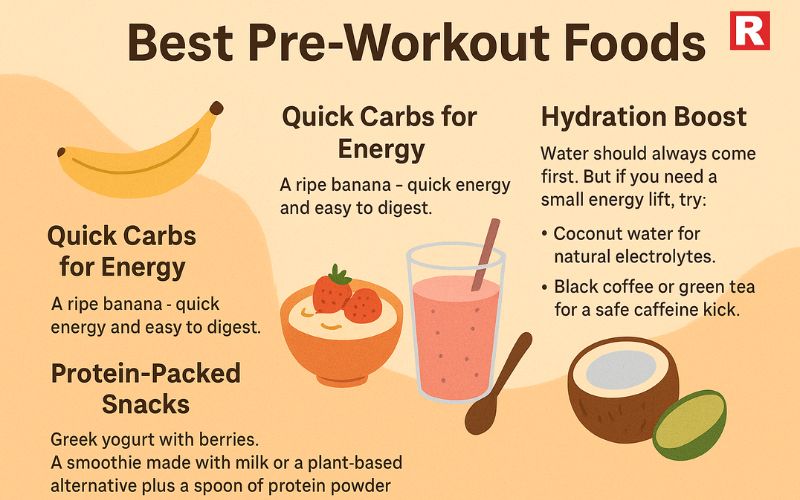
The goal before exercise is to eat food that is light and simple to digest. This kind of meal gives the body quick energy without making it feel heavy. Experts suggest eating 30 to 90 minutes before starting a workout. The best choice is a mix of carbohydrates and protein to fuel the muscles and prepare them for effort. Heavy or greasy meals should be avoided, as they slow digestion and may cause discomfort during training.
Quick Carbs for Energy
Carbohydrates give your muscles the fuel they need. Simple options include:
- A ripe banana – quick energy and easy to digest.
- A small bowl of oats with fruit.
- Whole-grain toast with a drizzle of honey.
These foods raise your blood sugar just enough to help you stay active.
Protein-Packed Snacks
Adding a little protein before exercise helps muscles get ready for work. Examples are:
- Greek yogurt with berries.
- A smoothie made with milk or a plant-based alternative plus a spoon of protein powder.
- A boiled egg with a slice of toast.
Hydration Boost
Water should always come first. But if you need a small energy lift, try:
- Coconut water for natural electrolytes.
- Black coffee or green tea for a safe caffeine kick.
Avoid too much caffeine. It can make you restless instead of focused.
Know more: 5 Foods to Avoid for Better Cholesterol
Best Post-Workout Foods
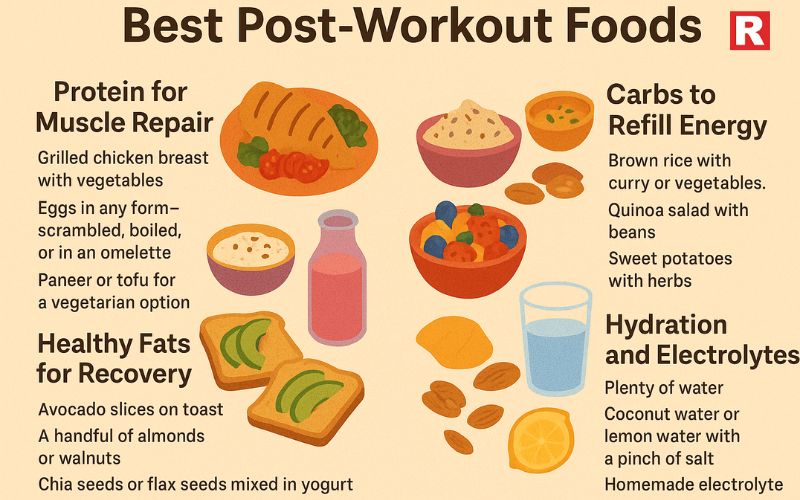
After exercise, the body feels like an empty battery that needs to be charged again. Muscles lose fuel and strength, and energy levels drop. This is when food becomes most important. Carbohydrates help refill glycogen stores that power the muscles. Protein supports repair and prevents muscle breakdown. Eating within 30 to 60 minutes after a workout makes recovery faster. The right balance of carbs and protein helps the body regain energy, reduce soreness, and prepare for the next session.
Protein for Muscle Repair
Protein is the building block of muscles. Eating it after a workout helps reduce soreness and supports growth. Options include:
- Grilled chicken breast with vegetables.
- Eggs in any form – scrambled, boiled, or in an omelette.
- Paneer or tofu for a vegetarian option.
- A protein shake with milk or water.
Carbs to Refill Energy
Carbs are just as important after training as they are before. They bring back the energy used by your muscles. Try:
- Brown rice with curry or vegetables.
- Quinoa salad with beans.
- Sweet potatoes with herbs.
- A bowl of fruit salad with seasonal fruits.
Healthy Fats for Recovery
Fats are not always the enemy. The right fats reduce inflammation and support recovery. Choose:
- Avocado slices on toast.
- A handful of almonds or walnuts.
- Chia seeds or flax seeds mixed in yogurt.
Hydration and Electrolytes
You lose water and minerals like sodium and potassium through sweat. Rehydrate with:
- Plenty of water.
- Coconut water or lemon water with a pinch of salt.
- Homemade electrolyte drinks with water, lemon, and honey.
Also check: 7 Pure Raw Honey Varieties That Offer Exceptional Taste and Natural Healing Benefits
Foods You Should Avoid Around Workouts
Not every food is good before or after exercise. Some make you feel heavy or slow down recovery. Stay away from:
- Fried foods or fast food – they are heavy and slow to digest.
- Sugary snacks or sodas – they give a quick rush but a fast crash.
- Alcohol – it dehydrates your body and reduces muscle recovery.
Quick Reference Cheat Sheet
Here is a simple list you can remember:
Pre-Workout Foods (Fuel) | Post-Workout Foods (Recover) |
|---|---|
Banana with peanut butter | Grilled chicken with rice |
Oats with berries | Eggs with avocado toast |
Greek yogurt with honey | Protein shake with banana |
Black coffee or green tea | Quinoa salad with paneer |
Pro Tips for Maximum Energy
- Keep your pre-workout meals light. A heavy stomach makes you slow.
- Drink water before, during, and after your workout. Dehydration reduces strength and focus.
- Adjust your meals to your goals. If you want to lose weight, reduce carbs and keep protein high. If you want to build muscle, increase both carbs and protein.
- Everyone’s body reacts differently. Try different foods and see what makes you feel best.
Check more: 5 Delicious Sago Desserts to Enjoy This Monsoon
How Food Influencers Are Changing the Way We Eat
6 Benefits of Drinking Black Coffee
Stay Healthy!
Workouts do not begin inside the gym; they begin with the food chosen in the kitchen. The right pre-workout meal gives the body the energy to perform with focus and strength. The right post-workout meal helps repair tired muscles, restore energy stores, and build strength for the next session. A simple formula makes it clear. Before exercise, combine carbohydrates with protein and proper hydration. After exercise, focus on protein, carbohydrates, healthy fats, and rehydration.
Each part works together to fuel energy, support recovery, and prevent fatigue. Natural and whole foods are the best choice, as they provide steady energy without unnecessary additives. Consistency in food habits brings visible results, not only in training but also in overall health and well-being. When the body is fueled smartly, workouts feel easier, recovery is faster, and progress becomes steady. The foundation of fitness is not just movement but the right nutrition every day. For specific requirements, consult a dietician/doctor.

Coffee is more than just a drink. It is a daily ritual for many and a source of comfort. For some, it is the first thing that helps them start their day. Each cup carries its own story, aroma, and character. Some enjoy it bold and black, while others prefer it sweet and creamy. On a hot day, a chilled brew can feel refreshing and light. Around the world, coffee has taken many forms, each with its own flavour and charm. From the deep richness of espresso to the smooth balance of a cappuccino, every style offers a unique experience. Cold brew brings a mellow taste, while mocha adds a touch of chocolate. A flat white is velvety and warm, while Turkish coffee is strong and traditional. For those with a sweet tooth, an affogato blends dessert with coffee in one cup. Whether served hot or cold, simple or indulgent, coffee remains a drink that connects people across cultures. There is always a new flavour to discover and a fresh brew to enjoy.
Read more: 6 Benefits of Drinking Black Coffee
Top Vietnamese Coffee Brands Making Trends in India
The Story Behind Your Cup
Coffee has a history that stretches back centuries. Many believe it was first discovered in Ethiopia. A goat herder noticed his goats became lively after eating red coffee berries. Curious, he tried them himself and felt the same burst of energy. Word of this spread quickly. Soon, coffee found its way to the Middle East, where it became part of daily life. From there, traders and travellers carried it to Europe. Coffee houses began to open, turning into places for conversation and ideas. Over time, it reached every part of the world. Today, coffee is enjoyed in countless ways. In one place, people may sip strong, traditional brews. In another, they may try cold brews, flavoured lattes, or other modern creations. The love for coffee has only grown, and its rich history continues to influence how it is made and shared. Each cup carries a link to its long and fascinating journey.
1. Espresso – The Heart of Coffee

Espresso is often called the king of coffee. It is made by pushing hot water through finely ground coffee beans at high pressure. The process is quick but intense. The result is a small shot packed with strong flavour and rich aroma. On top, it forms a golden crema that adds smoothness to the taste. Espresso is the base for many other drinks like cappuccino, latte, and macchiato. It is loved for its bold character and instant energy. For true coffee lovers, a well-made espresso is more than a drink. It is a pure and powerful coffee experience in every sip.
- Taste & Aroma: Rich, intense, and slightly bitter, with a thick crema layer on top.
- Why Try It: Espresso is the base for most coffee drinks like cappuccino, latte, and macchiato. If you want to understand coffee at its core, start here.
- Best Time: Morning or whenever you need a quick, strong boost.
2. Cappuccino – Creamy Comfort

Cappuccino is a classic coffee drink known for its balance and beauty. It is made with one part espresso, one part steamed milk, and one part milk foam. The layers blend to create a smooth, creamy texture with a rich coffee flavour. This drink began in Italy, where it became a morning favourite. Over time, it spread across the world and gained loyal fans everywhere. Its frothy top can be plain or sprinkled with cocoa or cinnamon for extra taste. A cappuccino is warm, comforting, and perfect for slow mornings or relaxed afternoons. It is coffee at its most inviting form.
- Taste & Aroma: Mild coffee flavour with creamy sweetness and a smooth, frothy top.
- Why Try It: Perfect for those who find espresso too strong. It is a great middle ground — rich but still soft on the palate.
- Best Time: Morning or late afternoon, especially with a croissant or biscotti.
3. Cold Brew – Smooth and Refreshing

Cold brew is a refreshing coffee made through a slow brewing process. Coarse coffee grounds are steeped in cold water for 12 to 24 hours. This long extraction brings out a smooth and mellow taste. It is naturally lower in acidity, making it gentle on the stomach. Cold brew often has subtle notes of chocolate or nuts, depending on the beans used. It can be enjoyed black, over ice, or with milk for extra creaminess. Popular in warm weather, it offers a cool and energising alternative to hot coffee. Cold brew is simple, flavourful, and a favourite among modern coffee lovers.
- Taste & Aroma: Mellow, naturally sweet, with chocolate and nutty notes.
- Why Try It: Ideal for hot days. It is easier on the stomach than hot coffee and can be served over ice or with milk.
- Best Time: Midday or afternoon, especially in summer.
Know more: 11 Best Commercial Coffee Machine Brands for Café: Top Picks & Buying Guide
4. Latte – Gentle and Versatile

Latte, short for “caffè latte,” means “milk coffee” in Italian. It is made by combining a single or double shot of espresso with a generous amount of steamed milk. A thin layer of milk foam is added on top for a smooth finish. The result is a mild and creamy drink with a gentle coffee flavour. Lattes are often enjoyed plain, but many add flavours like vanilla, caramel, or hazelnut. Originating in Italy, the latte has become a favourite in cafés worldwide. It is perfect for those who prefer a softer coffee taste and a warm, comforting drink any time of day.
- Taste & Aroma: Soft, creamy, and mild in coffee flavour.
- Why Try It: Perfect for adding flavours like vanilla, caramel, or hazelnut. If you are new to coffee, this is a gentle way to start.
- Best Time: Morning or during a relaxed coffee break.
5. Mocha – Chocolate Lover’s Dream

Mocha is a rich and indulgent coffee drink that blends espresso with chocolate syrup and steamed milk. It is often topped with whipped cream for extra sweetness and a smooth texture. The combination of bold coffee and sweet chocolate creates a flavour that appeals to both coffee lovers and dessert fans. Mocha can be served hot for a cosy treat or iced for a refreshing twist. Originating from the idea of mixing coffee with chocolate, it has become a popular choice in cafés around the world. It is perfect for those who want a touch of luxury in their daily coffee.
- Taste & Aroma: Rich coffee flavour blended with sweet chocolate and a creamy finish.
- Why Try It: Great for those who find black coffee too bitter. Mocha gives you the caffeine you need with a sweet treat.
- Best Time: As an after-lunch dessert or during an indulgent evening break.
6. Flat White – Smooth and Velvety

Flat white is a smooth and strong coffee that began in Australia and New Zealand. It is made with espresso and steamed milk, similar to a latte, but with less milk overall. The milk is steamed to create a thin layer of microfoam, which blends perfectly with the coffee. This gives the drink a velvety texture and a richer coffee flavour. The flat white is popular among those who want a creamy drink without losing the strength of espresso. Served in a smaller cup than a latte, it offers a balanced taste that is both bold and silky with every sip.
- Taste & Aroma: Strong espresso flavour balanced by a silky milk texture.
- Why Try It: If you enjoy the creaminess of a latte but want more coffee punch, this is your drink.
- Best Time: Morning or early afternoon when you want flavour and energy in one sip.
7. Turkish Coffee – Strong and Traditional

Turkish coffee is a traditional brew known for its strong flavour and rich history. It is made by simmering very finely ground coffee with water, and sugar if desired, in a small long-handled pot called a “cezve.” The coffee is never boiled but gently heated to create a thick, frothy layer on top. It is poured into small cups and served unfiltered, allowing the grounds to settle at the bottom. Often enjoyed slowly, it is sometimes flavoured with cardamom for extra aroma. Turkish coffee is more than a drink — it is a cultural ritual shared with family and friends over conversation.
- Taste & Aroma: Bold, intense, sometimes spiced with cardamom.
- Why Try It: It is more than a drink — it is part of a cultural ritual. Sipping it slowly lets you appreciate its depth.
- Best Time: After a meal, paired with a sweet treat like Turkish delight.
8. Affogato – Dessert Meets Coffee

Affogato is a delightful mix of dessert and coffee. It comes from Italy, where it is often served after a meal. The name means “drowned” in Italian, as the hot espresso is poured over a scoop of cold vanilla ice cream. The heat of the coffee slowly melts the ice cream, creating a creamy, sweet, and slightly bitter blend. It can be enjoyed plain or with toppings like chocolate shavings or nuts. The contrast of hot and cold makes it unique. Affogato is simple to prepare but feels special, making it a favourite treat for coffee lovers around the world
- Taste & Aroma: Hot meets cold, bitter meets sweet — a delightful contrast in every bite.
- Why Try It: Perfect when you cannot choose between dessert and coffee. It is a simple but luxurious treat.
- Best Time: After dinner or as a special weekend indulgence.
Also check: 5 Ways to Use Garden Cress Seeds (Halim) for Stronger Hair and Bones
Neuro‑Gastronomy: The Science Behind Immersive Dining Experiences
12 Delicious High-Protein Foods to Eat Daily for a Healthier You
Coffee Facts!
- The world’s most expensive coffee, Kopi Luwak, is made from beans eaten and passed by a civet cat.
- Finland drinks the most coffee per person in the world.
- The strength of coffee depends on the brewing method, not just the bean type.
Tips for Trying New Coffees
- Start Light: If you are new, begin with lattes or cappuccinos before moving to espresso or Turkish coffee.
- Experiment with Brewing: Try French press, pour-over, or AeroPress to discover different flavours from the same beans.
- Visit Specialty Cafés: Baristas can guide you to flavours and styles you might never try otherwise.
- Pair with Food: Certain coffees taste even better with specific foods — espresso with dark chocolate, cappuccino with pastries, mocha with cookies.
What Are You Trying Next!
Every type of coffee has its own charm. Espresso delivers a bold and intense flavour, while cold brew offers a smooth and calming taste. Some drinks are rich and creamy, like a cappuccino or latte. Others, like Turkish coffee, are strong and full of tradition. Each one tells a different story through its flavour and aroma. Exploring different styles helps a person enjoy coffee in new ways. It can be about the taste, the texture, or even the feeling it brings. So, the next time someone visits a café, they should skip the usual choice. Trying something new might lead to discovering a new favourite. Sometimes, one sip is all it takes to open the door to a whole new coffee experience, and that is what makes the journey so enjoyable.

In the heart of Karnataka’s festive kitchens, the air often fills with the warm, nutty aroma of ghee and jaggery — and that’s when you know Obbattu is being made. Also known as Holige or Puran Poli in different regions, this delicate, stuffed flatbread is a celebratory treat served during Ugadi, Sankranti, and special family occasions. What makes Obbattu special isn’t just its sweet lentil–jaggery filling, but the way it connects generations — a recipe whispered from grandmothers to mothers, and now, to chefs keen on bringing a taste of South India’s festive charm to their menus.
Why It Works on Menus / For Guests
- Heritage appeal: Instantly evokes nostalgia for diners familiar with South Indian festivals.
- Versatile service: Works as a festive dessert, tea-time indulgence, or sweet breakfast.
- Customizable flavours: From traditional coconut fillings to modern chocolate or dry-fruit twists.
- Vegetarian-friendly: Naturally fits into festive vegetarian menus.
Obbattu Recipe Card
- Servings: 8–10 pieces
- Prep Time: 40 minutes
- Cook Time: 30 minutes
- Total Time: 1 hour 10 minutes
- Recipe Category: Dessert
- Recipe Cuisine: Indian (Karnataka)
- Difficulty Level: Medium
Obbattu Ingredients (in order used)
- 2 cups maida (all-purpose flour)
- 2 tbsp oil or melted ghee (for dough)
- Water, as needed for kneading
- 1 cup chana dal (split Bengal gram)
- 1 cup grated jaggery
- 1/2 tsp cardamom powder
- Ghee, for roasting
- Pinch of turmeric (optional, for golden dough)
Obbattu Cooking Method (action-led with sensory cues)
- Prepare dough: In a bowl, mix maida, oil/ghee, and a pinch of turmeric. Add water gradually and knead 6–8 minutes until soft and pliable. Cover and rest 30 minutes for gluten relaxation.
- Cook dal: Rinse chana dal; pressure cook with enough water for 3–4 whistles until the grains crush easily between fingers. Drain thoroughly so no free water remains.
- Make filling: In a pan, combine cooked dal and jaggery over low heat, stirring 5–7 minutes until jaggery melts and mixture thickens, leaving the sides. Add cardamom; mash to a smooth, spreadable paste. Cool to lukewarm (it should hold shape without sticking).
- Portion: Divide dough and filling into equal balls (dough slightly larger). Keep covered to prevent drying.
- Stuff & roll: Roll a small disc (8–10 cm), place filling in centre, pinch to seal. Dust lightly and roll gently to a thin circle (16–18 cm). If sticking, use a sheet of baking paper and minimal flour.
- Cook: Heat a tawa on medium. Place obbattu; cook 60–90 seconds until light bubbles and pale spots appear. Flip, brush with ghee, cook 45–60 seconds until golden speckles form; flip again and ghee-roast 15–20 seconds for aroma.
- Serve: Plate hot with a drizzle of ghee. Ideal with warm milk, kesar, or a scoop of vanilla ice cream for a fusion twist.
Obbattu Nutritional Information (Per Piece)
| Nutrient | Approx. Value |
|---|---|
| Calories | ~180 kcal |
| Carbohydrates | ~32 g |
| Protein | ~4 g |
| Fat | ~5 g |
| Sugar | ~15 g |
Pro Tips for Chefs / Owners
- Dough softness: Use fine maida and adequate resting to get thin, tear-free rolling.
- Dry filling is key: Drain dal fully before adding jaggery; excess moisture causes oozing.
- Batch prep: Make filling a day ahead; portion and chill for faster festival service.
- Seasonal SKUs: Add coconut–jaggery, dry-fruit, or mango variants for limited-time offers.
- Menu pairing: Serve with saffron milk or ice cream; position as “festive dessert” with premium pricing.
Obbattu FAQs
Is Obbattu the same as Puran Poli?
They are similar stuffed flatbreads; Obbattu is the Karnataka style and may include coconut, with a soft, ghee-brushed finish.
Can I make Obbattu ahead of time?
Yes. Prepare dough and filling a day in advance; cook fresh for best texture. Cooked obbattu keeps 2–3 days refrigerated.
Can I use whole wheat flour?
Yes, but expect a slightly denser texture. You can do a 50:50 maida:atta blend for balance.
How do I prevent the filling from leaking?
Cool filling to lukewarm, keep it firm (not wet), seal seams well, and roll gently with minimal flour.
Closing
From the bustling kitchens of Bengaluru to festive spreads across South India, Obbattu is more than a dessert — it’s tradition on a plate. With its ghee-kissed layers and melt-in-the-mouth filling, this sweet flatbread charms nostalgic locals and curious diners alike. Add it to your menu for an authentic festive highlight that delivers story, margin, and memorable flavour in every bite.

The Picante would be the margarita's brash, stylish cousin. Made at the famous Chiltern Firehouse in London, this tequila-based beverage has become a global bar staple, and it's easy to understand why. This cocktail is as memorable as it is Instagrammable, thanks to the earthy depth of reposado tequila, the bright punch of fresh lime, the sweetness of agave syrup, and the slow burn of fresh chili.
The Picante is winning hearts (and heat lovers) in bars from Goa to Mumbai. For bartenders and restaurateurs, it's a low-cost, high-impact beverage that keeps customers coming back for more. For those who enjoy cocktails, it's a simple concoction that feels elegant but approachable.
What Makes the Picante Stand Out
- Balanced Sweet-Heat Profile – Just enough chili to intrigue, not overwhelm.
- Visual Appeal – A vibrant orange-gold hue with a striking garnish.
- Menu Flexibility – Works as a signature drink, a summer special, or a year-round best-seller.
Picante Cocktail Recipe Card
Servings: 1 glass
Prep Time: 5 minutes (PT5M)
Total Time: 5 minutes (PT5M)
Recipe Category: Cocktail / Beverage
Recipe Cuisine: Modern International
Difficulty Level: Easy
Ingredients:
- 50 ml Reposado Tequila
- 20 ml Fresh Lime Juice
- 15 ml Agave Syrup
- 2–3 slices fresh red chili (mild or hot, to taste)
- Ice cubes
- Garnish: Chili slice or lime wheel
Method:
- Muddle the chili – In a cocktail shaker, gently press chili slices to release aroma and heat.
- Add liquids – Pour in tequila, lime juice, and agave syrup.
- Shake – Fill with ice and shake vigorously for 10–15 seconds until chilled.
- Strain – Double strain into a rocks glass over fresh ice.
- Garnish & serve – Add a chili slice or lime wheel for presentation.
Nutritional Information (Per Serving)
| Nutrient | Amount |
|---|---|
| Calories | 170 kcal |
| Carbohydrates | 10 g |
| Protein | 0 g |
| Fat | 0 g |
| Saturated Fat | 0 g |
| Cholesterol | 0 mg |
| Sodium | 3 mg |
| Sugar | 8 g |
Pro Tips for Bartenders
- Adjust spice by removing chili seeds for milder heat.
- Batch for busy nights – Pre-mix tequila, lime, and agave; add chili fresh on order.
- Presentation sells – Use a large crystal-clear ice cube and a fresh chili garnish for that premium touch.
Frequently Asked Questions
1. What is a Picante cocktail?
A modern tequila cocktail combining reposado tequila, fresh lime juice, agave syrup, and chili slices for a sweet-spicy flavor profile.
2. Where did the Picante originate?
It was first created at the Chiltern Firehouse bar in London and quickly became a global trend.
3. Can I make it without alcohol?
Yes — replace tequila with a non-alcoholic spirit or soda water for a refreshing mocktail version.
4. What food pairs best with a Picante?
Spicy tacos, ceviche, grilled prawns, or any Mexican-inspired small plates.
Why It Works for Menus
For bar programs looking to stand out, the Picante is a perfect example of how a few well-chosen ingredients can create a signature experience. It’s easy to train staff to make, the ingredients are already in most bars, and the visual appeal practically sells itself.
The Picante isn’t just a drink; it’s an experience in a glass — one that invites guests to linger, take a photo, and order another. In today’s cocktail culture, that’s a recipe for both happy customers and a profitable bar program.

Food in 2025 is changing in a big way. It is bold and full of fresh ideas. People are now looking at food as more than a meal. Every bite has a story to tell. It could be a dish from a faraway land or a simple recipe made new. The year is about going out of your comfort zone. It is about trying something you have never tasted before.
In 2025, food is a journey. People are travelling with their taste buds. They do not need a plane ticket. They only need curiosity and a good appetite. Cuisines from different parts of the world are easy to find. Korean snacks, Middle Eastern platters, Japanese bowls and Indian regional dishes are all on the table. This change is making dining exciting. Eating out is now an adventure. It is a chance to learn about cultures and flavors. People are choosing bold spices, new textures, and fun mixes. Every meal in 2025 feels fresh, creative, and full of life.
Read more: Different Types of Bars to Explore in 2025: Where Drinks Meet Vibes
How to Pair Beer with Indian Food: A Desi Guide to Perfect Pints
1. Global Cuisines to Add to Your Plate

Korean Street Food: Beyond K-Dramas
Korean culture is everywhere. Food leads the way. Try tteokbokki, gimbap, and Korean fried chicken. These dishes are spicy, sweet, and fun to share. Street food markets and pop-up stalls are bringing Seoul to your city.
Peruvian Magic: From Ceviche to Quinoa Bowls
Peruvian food is full of colour and freshness. Ceviche with lime, chilli, and fish is a must. Quinoa bowls are rich and healthy. This cuisine mixes native ingredients with global flavours. It feels new but also familiar.
Middle Eastern Mezze: A Flavor Party
Mezze is not just food. It is an experience. Small plates like hummus, falafel, baba ganoush and stuffed grape leaves make a table come alive. It is perfect for a long, slow meal with friends.
Japanese Soul Food: Ramen, Sushi and More
Japan offers comfort in every form. Ramen is warm and hearty. Sushi is light and balanced. Try izakaya style dining for grilled skewers and seasonal small bites.
Indian Regional Surprises: From Assam to Kerala
Indian cuisine in 2025 is about going deeper. People are trying food from small towns and regions. Assam’s pithas, Rajasthani dal baati churma, and Kerala’s seafood curries are now popular outside their states.
2. Fusion Fever – When Cultures Collide on a Plate

Fusion food in 2025 is making a strong mark. It is all about mixing flavors and breaking old food rules. Cooks are taking ideas from one culture and joining them with another. This mix is making food fresh and fun. Diners enjoy it because every dish brings a new taste. It may look different but it works. The surprise comes with every bite.
In many kitchens, new fusion dishes are becoming favourites:
- Butter chicken stuffed baos: A soft steamed bao is filled with rich Indian butter chicken. It has the soft bite of a bao and the creamy taste of a curry.
- Taco sushi rolls: The idea comes from Japanese sushi and Mexican tacos. It has fresh rice rolls with spicy fillings and a bit of crunch.
- Kimchi quesadillas: A Mexican flat tortilla is folded with cheese and Korean kimchi. It gives a mix of heat and tang in one mouthful.
Chefs enjoy creating such dishes. People like to taste something different without losing the comfort of known flavors. Fusion food in 2025 is about fun, surprise, and bold eating.
Also check: How to Pair Indian Food with the Right Alcohol: A Desi Guide to Perfect
3. Plant-Based Wonders – Vegan and Vegetarian Cuisines
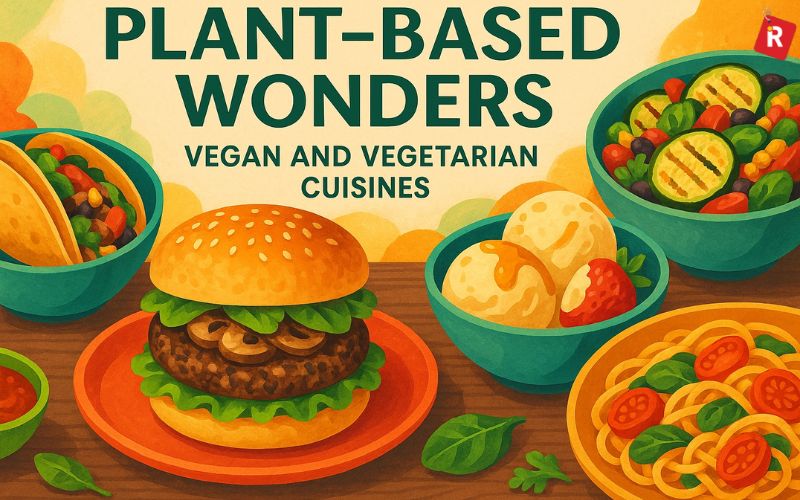
Plant-based food in 2025 has moved beyond being a passing trend. It has become a way of living for many people. More diners are now asking for dishes that are kind to the planet and to health. Chefs are taking this seriously. They are proving that plant-based food can be full of taste and not about giving up flavor. The focus is on new ideas and fresh ingredients.
This change is making eating out more exciting. People see that plant-based food can be simple, colorful, and full of flavor. It is now a strong part of modern food culture and not a side option. In many places, menus now have creative plant-based choices like:
- Vegan burgers – Made with beans, lentils, mushrooms, and spices. These burgers are juicy and filling.
- Plant milk desserts – Smooth ice creams and puddings made from almond or oat milk. They taste rich and sweet.
- Vegetarian twists on global classics – Dishes like pasta with plant-based sauces or tacos filled with grilled vegetables.
4. Sustainability on the Menu
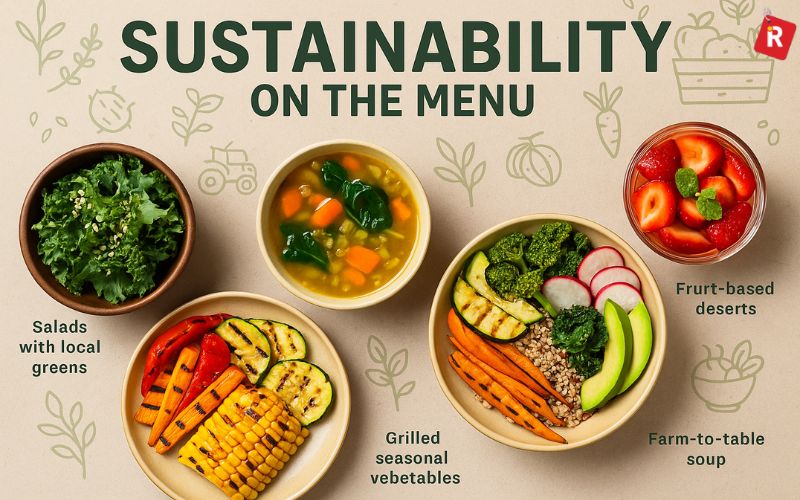
Sustainable dining in 2025 is shaping how people eat. Diners are paying attention to where their food comes from. More people now choose dishes made with local and seasonal produce. Chefs are planning menus that cut down food waste. They are careful about using every part of a fruit or vegetable. The focus is on organic farming and natural ingredients. When food is grown with care, it tastes fresh and full of life.
This way of dining supports farmers and reduces waste. It makes every meal healthy, clean, and full of respect for the land. Many restaurants are serving simple but thoughtful dishes such as:
- Salads with local greens – Fresh leaves and herbs picked from nearby farms.
- Grilled seasonal vegetables – Cooked with light spices to bring out their natural flavor.
- Whole grain bowls – Made with millet, barley, or quinoa mixed with vegetables.
- Fruit-based desserts – Using fresh fruits of the season instead of heavy creams.
- Farm-to-table soups – Made with fresh vegetables that change with the season.
5. Interactive Food Experiences

In 2025, dining is becoming more active and fun. Interactive meals are now a big part of how people enjoy food. It is no longer about sitting and waiting for a dish to arrive. Diners want to be part of the cooking. DIY food tables are seen in many new restaurants. People can choose their own toppings and build their own plates. Live grills are also popular. Guests cook meats, seafood, or vegetables on a small grill placed at the table. Chef’s table dinners are another trend. Here, a small group sits near the kitchen. The chef cooks in front of them and explains each step.
These ideas make the meal more than just food. It becomes an experience. It is fun, personal, and easy to remember. Eating out in 2025 is a mix of cooking and dining together. It lets people slow down, talk, and enjoy every part of the meal.
Know more: Top 7 Food Safety Practices Every Restaurant Should Follow
6. Desserts Around the World You Cannot Miss

Desserts in 2025 are full of variety. People are looking beyond the usual choices. Sweet dishes from around the world are now easy to find. Each dessert brings a taste of its home country. These dishes are made with simple but special ingredients. They give a perfect ending to any meal.
These desserts are now part of the menus in many places. They bring new flavors and textures. Every bite feels like a trip to another country. Many of the popular options this year come from different cuisines, such as:
- Japanese Mochi: Soft and chewy rice cakes. They are lightly sweet and very smooth.
- Italian Cannoli: Crisp pastry tubes filled with sweet cream. Often topped with nuts or chocolate.
- Turkish Baklava: Layers of thin pastry with nuts and honey. It is rich and flaky.
- Korean Bingsu: Shaved ice served with fresh fruits, syrups, or sweet red beans.
- French Mille-Feuille: Thin layers of puff pastry with cream in between. Light and elegant.
7. Sip the World – Beverage Pairings

In 2025, food and drinks are coming together in a new way. Pairing drinks with food has become an important part of dining. A good drink can bring out the taste of a dish. It makes the whole meal feel complete. Restaurants are now helping people pick the right match.
These combinations bring balance to every bite. They also make the dining experience more interesting. Drinks in 2025 are not just an extra. They are now a part of the flavor story. Some of the popular pairings seen on tables are:
- Japanese cuisine: Sushi and ramen with light sake or green tea.
- Middle Eastern cuisine: Mezze and grilled kebabs with craft beer or fresh mint drinks.
- Plant-based cuisine: Vegan bowls and salads with kombucha or fresh cold-pressed juices.
- Indian cuisine: Spicy curries and rich dishes with spiced teas or light lassi.
- Italian cuisine: Pasta and pizzas with red wine or sparkling water.
Tips on How to Explore These Cuisines in 2025
- Food festivals in 2025 are a good place to begin for anyone who wants to try new food. These events bring many choices together in one place. People can taste small portions and learn about new flavours. It is an easy way to explore without feeling lost.
- Pop-up restaurants and food trucks are also becoming common. They serve dishes that are fresh and creative. Many of them offer food from around the world. It is a fun way to taste different cuisines without going to a big restaurant.
- Cooking classes are now online as well. Anyone can join from home and learn to make a dish step by step. This is a simple way to bring new tastes into daily life.
It is best to start small. Choosing one cuisine each month makes the journey easy and exciting. It keeps the experience fun and never too heavy.
Check more: Types of Liquor Licenses: Which One Do You Need for Your Business?
10 Low-Budget Cafe Interior Design Tips to Follow
Explore Different Types of Cafes: A Guide to the Coolest Café Concepts Around
Closing Thought!
Food in 2025 is full of bold flavours. It is a year when people are ready to explore. They are no longer happy with eating the same food every day. There is a need to step out and try something new. Every meal is becoming an adventure. People now see food as a way to travel without leaving home. A dish can bring the taste of a new country. It can bring colours and spices that are different from what they know. Trying something new is not just about eating. It is about learning and feeling new things.
Restaurants are offering more choices than ever. Menus have dishes from around the world. From street food to fine dining, there is something for everyone. In 2025, a plate can tell a story. It can take someone to a new place. This year is a journey for the tongue. It is an open door for those who love food and want to taste life in a new way.

After a tough workout, the body needs the right fuel to recover. Protein is essential for repairing muscles, while carbohydrates help restore energy levels. Many people choose eggs because they are high in protein, quick to cook, and quite filling. Eggs have become a go-to option for post-workout meals because they are both convenient and effective. However, not everyone can or wants to eat eggs every day. Some people have allergies, others follow a vegan lifestyle, and many simply want more variety in their meals. For all these reasons, it is helpful to know about other options that can work just as well.
There are many egg-free foods that are rich in protein, delicious, and easy to prepare. These alternatives make it possible to recover properly after exercise without relying on eggs. Eating within 30 to 60 minutes after a workout is ideal for supporting muscle repair and replenishing energy. This list of nine options offers nutritious, satisfying meals that can fit into any routine, helping the body recover and stay strong without getting stuck in the same habit.
Read more: 12 Delicious High-Protein Foods to Eat Daily for a Healthier You
6 Benefits of Drinking Black Coffee
Why Some People Avoid Eggs
Not everyone chooses eggs as part of their post-workout routine, and the reasons vary widely. Some individuals have allergies that make eggs unsafe to consume, forcing them to look for equally nutritious alternatives. Others follow a vegan lifestyle, avoiding all animal products, including eggs, and instead opting for plant-based sources of protein and energy. Many people simply want more variety in their meals, as eating the same food every day can become monotonous and uninspiring.
Here are three reasons why someone might skip eggs:
- Allergies: Eggs are a common allergen, and for those affected, they’re completely off the menu.
- Vegan choices: Those committed to a plant-based diet avoid eggs as part of their ethical or health-driven choices.
- Need for variety: Even without restrictions, some prefer exploring other flavors and nutrients to keep their meals interesting and balanced.
These alternatives provide satisfying, nutritious options for everyone.
No Eggs? No Problem — Crack These Options Instead
Below are 9 simple, high-protein egg alternatives. Each comes with benefits and a quick meal idea to try.
- Greek Yogurt Power Bowl: Greek yogurt is rich in protein and probiotics. It also has some carbs. Top it with berries, honey, and nuts for a complete meal. It’s creamy, refreshing, and easy to eat after the gym.
- Cottage Cheese (Paneer) Perfection: Paneer or cottage cheese is full of casein, a slow-digesting protein. It keeps you full longer. You can eat it raw with spices or sauté it with vegetables. Add some whole-grain bread for carbs.
- Tofu Scramble Supreme: Tofu is a popular vegan protein. It’s soft, mild, and easy to season. Make a tofu scramble with turmeric, spinach, and peppers. It looks and feels like scrambled eggs but is completely plant-based.
- Quinoa & Chickpea Salad: Quinoa is a complete plant protein. Chickpeas add even more protein and fiber. Together, they make a hearty salad. Add olive oil, lemon juice, and herbs for flavor.
- Protein Smoothie with Plant or Whey Protein: A smoothie is fast and portable. Blend protein powder with banana, oats, and milk or a plant-based alternative. You can also add peanut butter or spinach for extra nutrients.
- Nut Butter & Banana Toast: Whole-grain toast with peanut or almond butter is simple but effective. Bananas add carbs and potassium. This meal is perfect if you’re short on time.
- Lentil & Veggie Stew: Lentils are high in protein and iron. Cook them with carrots, spinach, and tomatoes for a warm, comforting meal. This is a good option when you want something filling.
- Seitan Stir-Fry: Seitan is made from wheat gluten. It has a chewy texture and is very high in protein. Stir-fry it with soy sauce, garlic, and broccoli for a satisfying dish.
- Tempeh Wrap: Tempeh is a fermented soy product. It’s firm and nutty in flavor. Slice it and add to a whole-wheat wrap with lettuce, tomato, and a bit of hummus. It’s rich in protein and also good for your gut.
Know more: 6 Unexpected Benefits of Eating Jackfruit (Kathal) – Nature’s Spiky Surprise!
Quick Fixes vs. Meal Prep: Which Works Best for You?
Time plays a big role in post-workout meal choices. For those with packed schedules, quick and easy options are the way to go. Smoothies, yogurt bowls, or nut butter toast offer the right mix of protein and carbs without taking more than a few minutes to prepare. On the other hand, if there’s extra time available, a warm lentil stew, a stir-fry with tofu or seitan, or a fresh quinoa salad can offer more depth and satisfaction. Planning ahead can make a big difference during busy weekdays.
- Quick fixes: Smoothies, toast, or Greek yogurt are fast and effective.
- Hearty meals: Stir-fries, stews, and salads are great when time allows.
- Weekend prep: Cook in advance and store meals for the week ahead.
Protein Boosters You Didn’t See Coming
Small additions to a meal can make a big nutritional difference, especially after a workout. For those looking to increase their protein intake without much effort, there are plenty of simple options. Hemp seeds, for example, are rich in protein and healthy fats and can be sprinkled over salads, yogurt, or even toast. Sunflower seeds and roasted soybeans also offer a crunchy texture along with valuable nutrients. Edamame, whether steamed or lightly seasoned, works well as a side dish or mixed into a bowl. Even a handful of almonds, walnuts, or cashews can boost protein while adding a satisfying bite.
These small, easy-to-use ingredients not only enhance the flavor and texture of meals but also contribute extra protein and healthy fats, supporting muscle recovery and overall health without much preparation or cooking required.
Also check: These 7 Foods Can Help You Cool Your Stomach in Summer
How to Pair Indian Food with the Right Alcohol: A Desi Guide to Perfect
Health Benefits of Quinoa: A Superfood for Every Diet
Closing Thoughts
Post-workout meals play a key role in recovery and building strength. Choosing the right food helps repair muscles and restore energy. For those who prefer to avoid eggs, there are plenty of satisfying alternatives that still deliver high protein and great taste. The nine options shared here are simple to prepare, packed with nutrients, and versatile enough for any routine.
It’s worth experimenting with these choices to discover what suits personal taste and lifestyle best. There’s no need to stick to just one option—combining different meals through the week can keep things interesting and balanced. These egg-free ideas prove that recovery meals can be both healthy and enjoyable. Which of these would you try after your next workout? Everyone has a favorite—what’s yours?
Copyright © 2009 - 2025 Restaurant India.













